Symbol Technologies RA1202 UHF Narrowband Radio Module User Manual Omnii Hand Held Computer
Symbol Technologies Inc UHF Narrowband Radio Module Omnii Hand Held Computer
Contents
- 1. User Manual
- 2. User Manual 1of2
- 3. User Manual 2of2
- 4. Regulatory Warranty Guide
User Manual 2of2
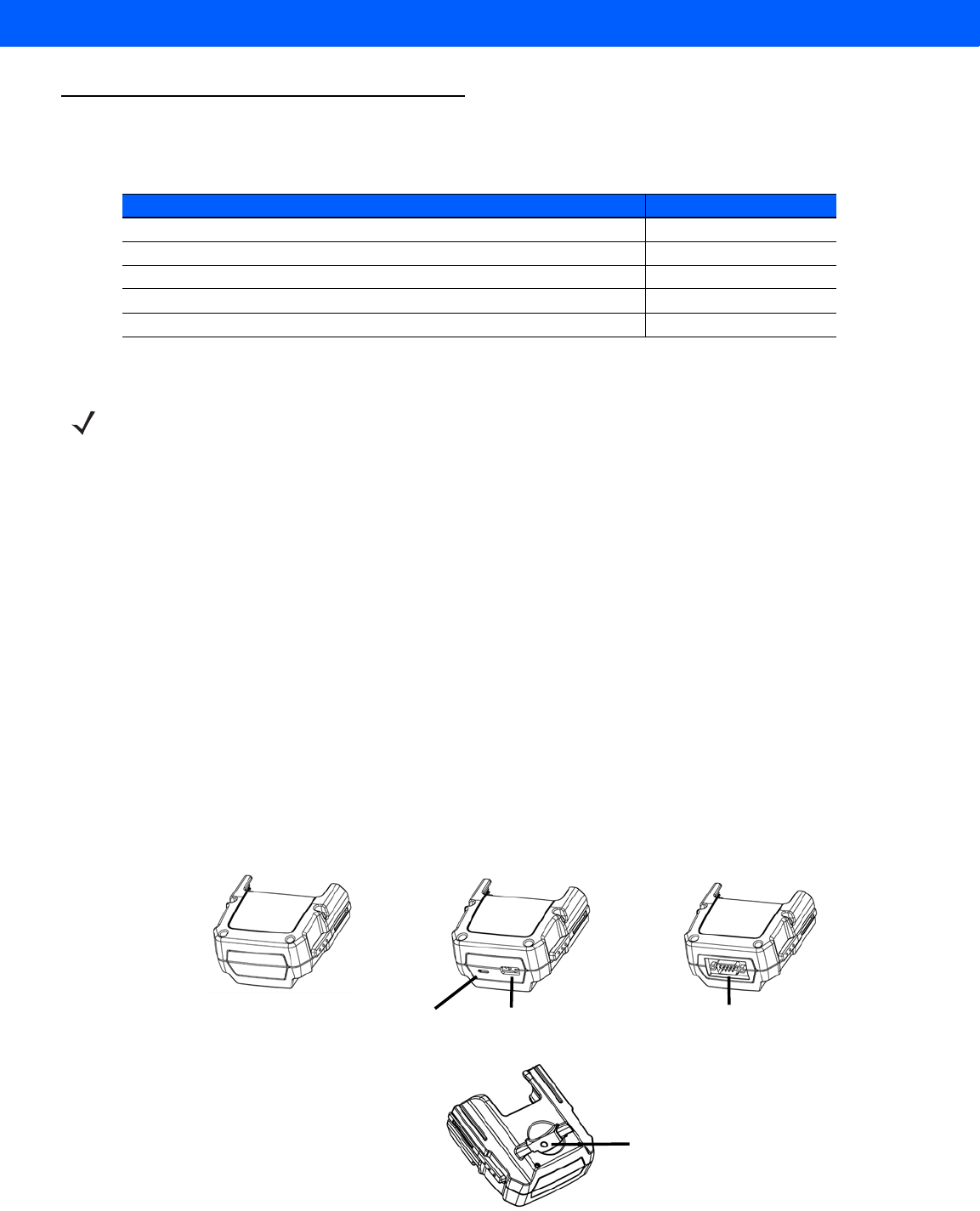
Accessories 4 - 5
Power Accessories
The following accessories can be ordered for your Omnii:
Snap Modules
Snap Modules are mobile power chargers for the Omnii. They are compatible with the AC wall adaptor
(Model ST1050 or ST1050-AR) and the Vehicle Power Outlet Adaptor (Model ST3113).
Three types of Snap Modules are available:
•Model ST4000 (Charger only variant): powers and charges the hand-held.
•Model ST4001 (USB variant): powers and charges the hand-held. It provides communications via USB
1.1/2.0 Host and USB 2.0 Client connectors and provides a DC IN port. When attached to the Omnii, it
allows ActiveSync or Windows Mobile Device Center connectivity with your PC, and the use of a USB
device such as a USB memory key or supported peripheral.
•Model ST4005 (Serial variant): provides a powered DE9M serial connector. It powers and charges the
Omnii, and provides serial communications to tethered devices. The DE9M connector is capable of speeds
up to 115,200 bps. Pin 9 is reserved for 5V power out and is defaulted to off. To enable power to this port,
in your Omnii desktop, go to Control Panel>Scanners, which opens the Scanner Settings menus. In the
Ports menu, select on for the Power parameter under the COM6 port.
Figure 4-5
Snap Module Ports
Description Model Number
AC Wall Adaptor ST1050 or ST1050-AR
Vehicle Power Outlet Adaptor ST3113
Snap Module – Charger Only ST4000
Snap Module – USB Host/Client plus Charger ST4001
Snap Module – DE9M powered serial plus Charger ST4005
NOTE The Snap Modules are shipped with their own quick start guide (Omnii Snap Modules Quick Start
Guide, PN 8000220). The guide should be reviewed for additional information and updates.
ST4000 (Charger) ST4001 (USB) ST4005 (Serial)
No ports Powered DE9M Serial port
(9 pin, 5VDC, 1A max)
Type A (Host) USB port
(5 VDC, 500 mA max)
Micro-B port
DC IN port (12V, 2.5 A)
Back of Snap Modules
Draft #4 for review
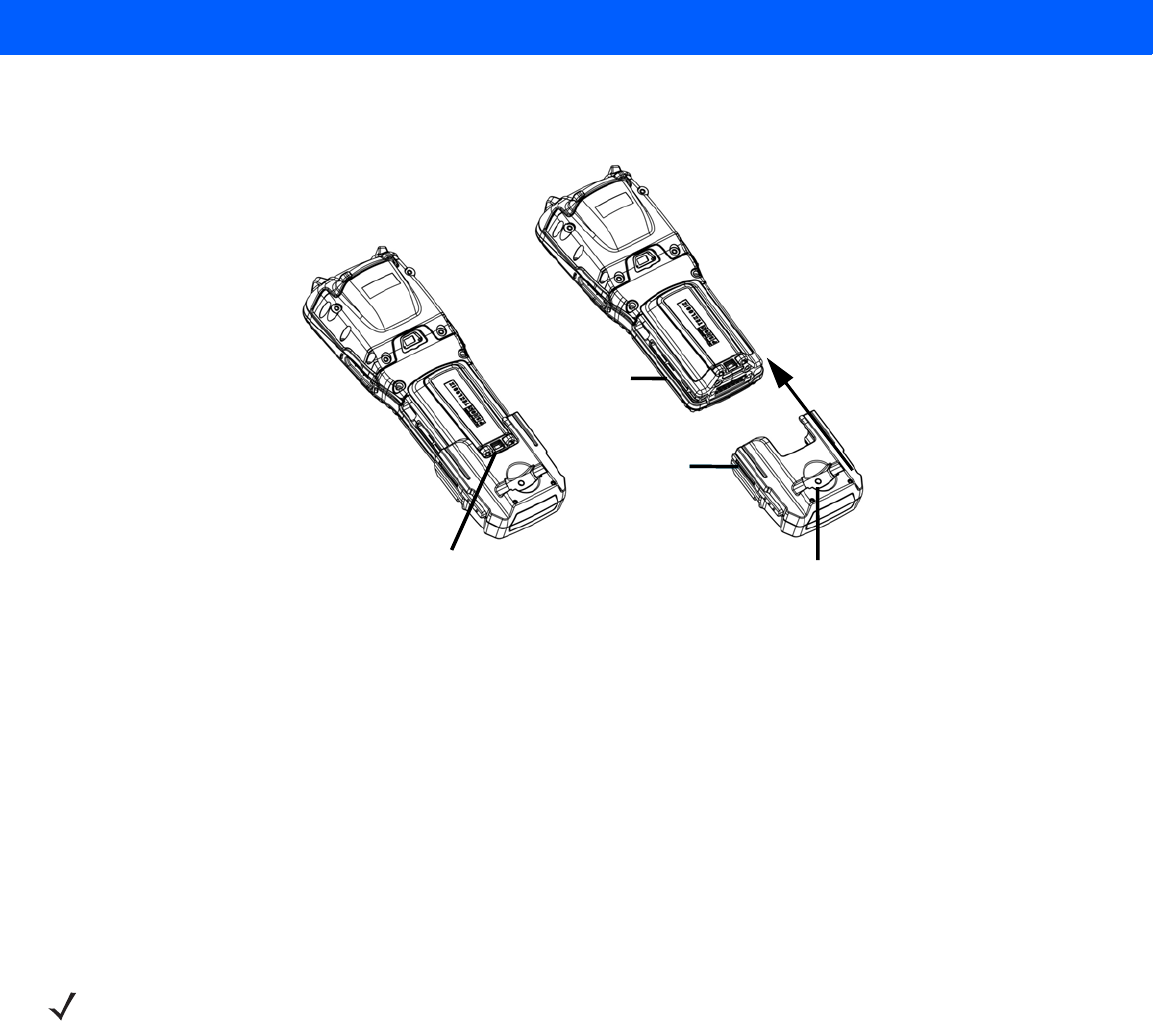
4 - 6 Omnii Hand-Held Computer with Windows CE 6.0 User Guide
Figure 4-6
Snap Module Installation
To attach the Snap Module charger to the Omnii:
• Make sure that the charger connector and the Omnii docking connector are free of dust or any other debris
before connecting them.
• A slot in the side rail on each side of the hand-held accommodates the locking clips of the charger. To
attach the charger, align it with the base of the hand-held and gently slide up until the locking clips snap
into place (Refer to Figure 4-6 Snap Module Installation on page 4-6).
• To remove the charger, press down on the base of the clip arms to release them from the Omnii side rails
and slide the adaptor off.
• Connect the charger to an AC or DC power source using the appropriate regional plug or cable. Then
connect the charger DC plug into the Snap Module DC jack. You can also attach an ST4001 or ST4005
Snap Module to the Omnii and use the Omnii battery to power USB or serial peripherals, for enhanced
mobility.
AC Wall Adaptor - Models ST1050 and ST1050-AR
The AC wall adaptor available for your docking station or Snap Module allows you to operate your hand-held
using AC power while charging the battery inserted in the unit.
The ST1050 is shipped with adaptor plugs suitable for use in the following regions: United Kingdom, Australia,
Europe and North America.
• Choose the adaptor plug that is suitable for use in your country. Slide the adaptor plug into the Universal
AC power supply, snapping it into place. These two pieces, coupled together, are referred to as an AC wall
adaptor.
• Insert the DC plug into the docking station or Snap Module jack.
• Plug the pronged end into an AC outlet.
DC IN port
Locking clip
Side rail
Hand strap slot
NOTE If you are using a hand strap, there is no need to remove it before installing the Snap Module,
since the Omnii hand strap slot will still be accessible.
Draft #4 for review
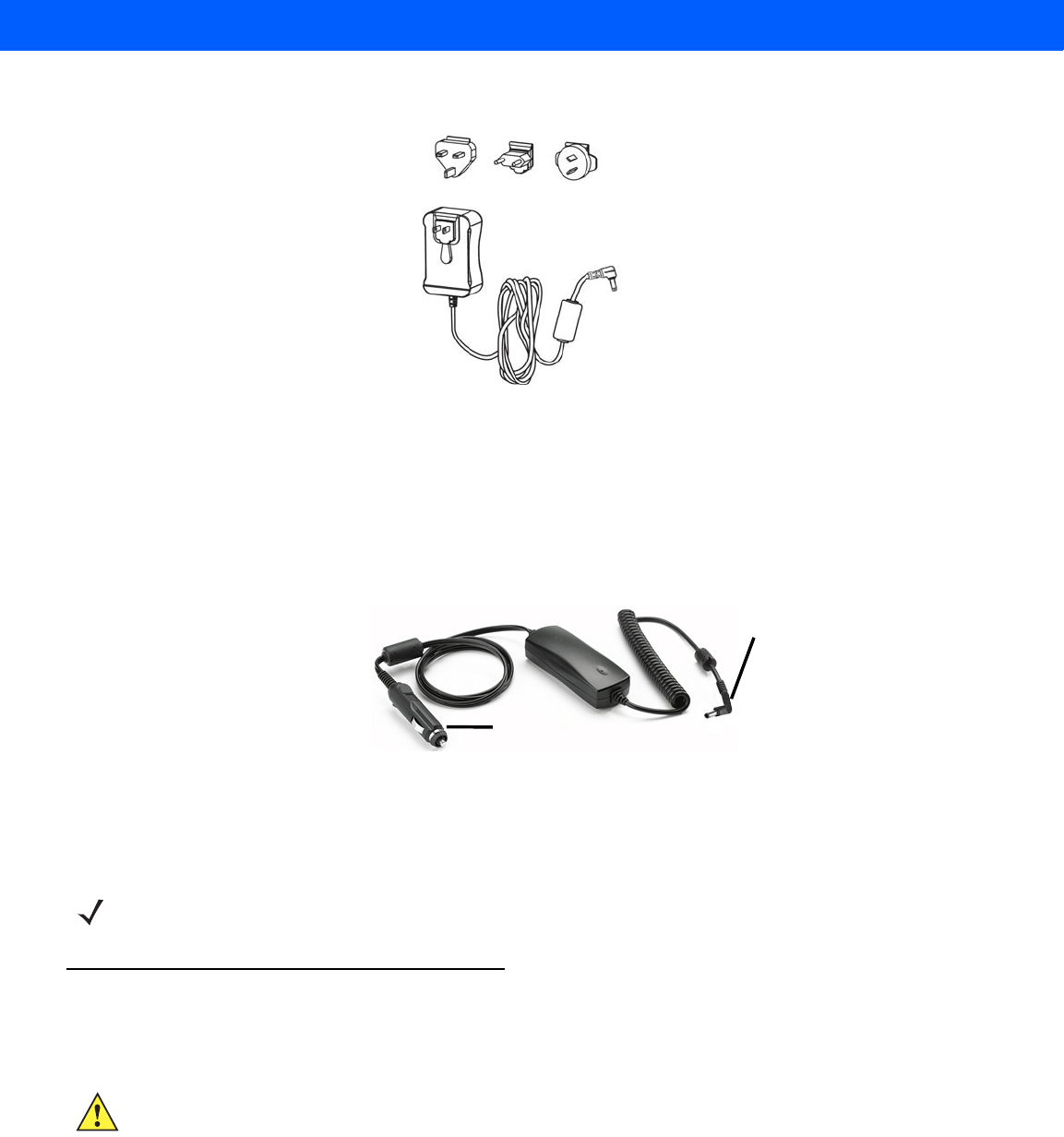
Accessories 4 - 7
Figure 4-7
ST1050 AC Wall Adaptor and plugs
The ST1050-AR wall adapter is kitted with an AC plug that is suitable for use in Argentina.
Vehicle Power Outlet Adaptor - Model ST3113
The Vehicle Power Outlet Adaptor allows you to power your hand-held and recharge your battery using power
drawn from your vehicle’s automotive power outlet when used in conjunction with a Snap Module.
Figure 4-8
ST3113 Vehicle Power Outlet Adaptor
• Attach a Snap Module to the base of the hand-held. Refer to Snap Modules on page 4-5 if you require
further details.
• Insert the DC power plug on the Vehicle Power Outlet Adaptor into the DC IN port on the Snap Module.
• Insert the Vehicle Power Outlet Adaptor plug into automotive power outlet in your vehicle.
Chargers and Docking Stations: General Information
Important Charger Safety Instructions
Charging the Battery
The Omnii Hand-Held Computer operates with lithium-ion battery pack Model ST3003. Preparing the unit for
operation requires that the battery pack be charged and installed in the hand-held.
DC power plug
AC power supply
Adaptor plugs
DC power plug
Adaptor plug
NOTE Battery charging continues whether the hand-held is switched on or off.
IMPORTANT Before charging a battery with a desktop docking station, it is critical that you review
the safety guidelines in the Omnii Hand-Held Computer Regulatory & Warranty
Guide (PN 8000191) and the Omnii Hand-Held Accessories Regulatory &
Warranty Guide (PN 8000205).
Draft #4 for review
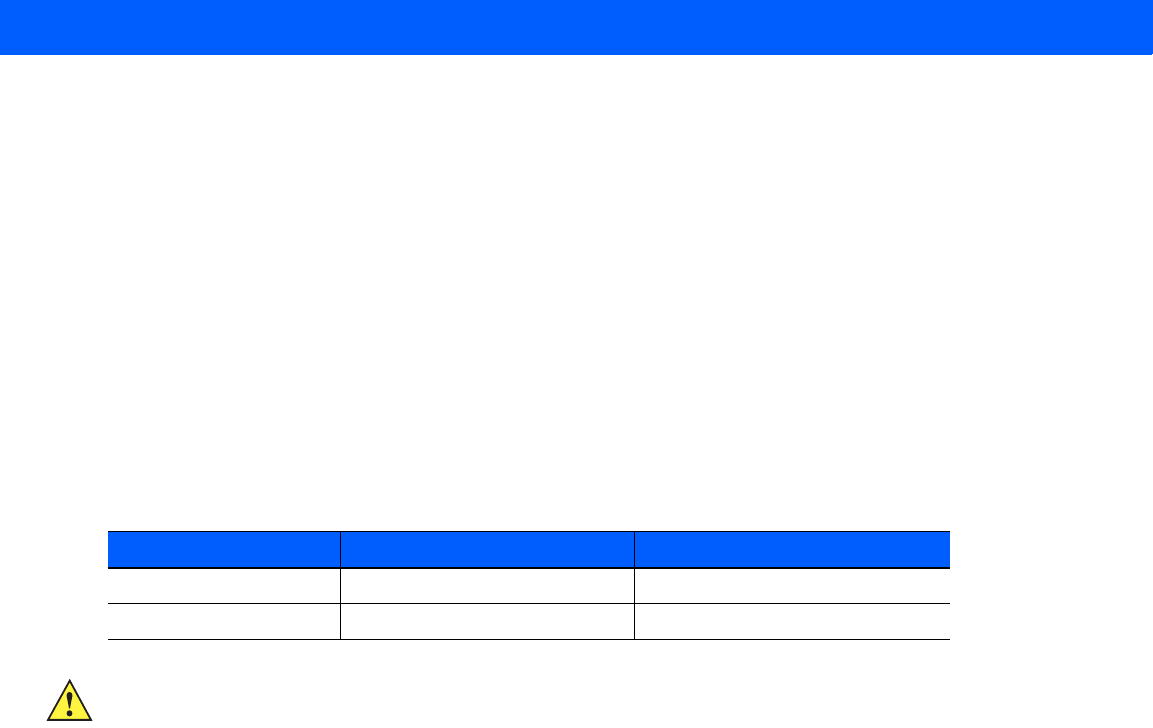
4 - 8 Omnii Hand-Held Computer with Windows CE 6.0 User Guide
Batteries shipped from the factory are charged to approximately 40% of capacity. Lithium-ion battery packs
must be fully charged before use. These batteries can be charged with a variety of chargers and docking
stations. Currently the following are available:
• The Snap Module is a mobile adaptor for the Omnii. Three models are available — see Snap Modules on
page 4-5.
• The AC Wall Adaptor operates as an AC power source and also charges the battery installed in the unit —
see AC Wall Adaptor - Models ST1050 and ST1050-AR on page 4-6.
• The Vehicle Power Outlet Adaptor powers the Omnii and recharges the battery using power drawn from
your vehicle’s automotive power outlet — see Vehicle Power Outlet Adaptor - Model ST3113 on page 4-7.
• The Desktop Docking Stations operate as both chargers and docking stations. Operating as a charger,
both the battery installed in the Omnii and a spare battery can be charged. Priority is given to charging the
hand-held's battery. See Desktop Docking Stations - Models ST4002 and ST4003 on page 4-9.
Normally it takes 3 to 4 hours to charge a battery. The Omnii intelligent charging system protects the battery
from over-charging by terminating the charge process when the battery is at maximum capacity.
Installation — Chargers and Docking Stations
When installing a charger or docking station, consider the following guidelines.
• Keep chargers and docking stations away from excessive dirt, dust, water and other liquids, and
contaminants.
• Chargers will not charge batteries outside an ambient temperature range of 0°C to 40°C (32°F to 104°F). It
is recommended that the charger or docking station be operated at room temperature — between 18°C
and 25°C (64°F to 77°F) for maximum performance.
After unpacking your unit:
• Visually inspect the charger for possible damage.
• Install the IEC power cord (if applicable) and apply power.
Operator Controls
The Omnii docking stations and chargers have no operator controls.
Power Consumption Considerations
Check to ensure the mains circuit supplying chargers and/or docking stations is adequate for the load, espe-
cially if several chargers and docking stations are being powered from the same circuit.
% Charge Completed During Sleep Mode While Operating
100% 4 hrs. 8 hrs.
75% 2 hrs. 6 hrs.
IMPORTANT To avoid damaging the battery, chargers will not begin the charge process until the
battery temperature is between 0°C to 40°C (32°F to 104°F).
Draft #4 for review
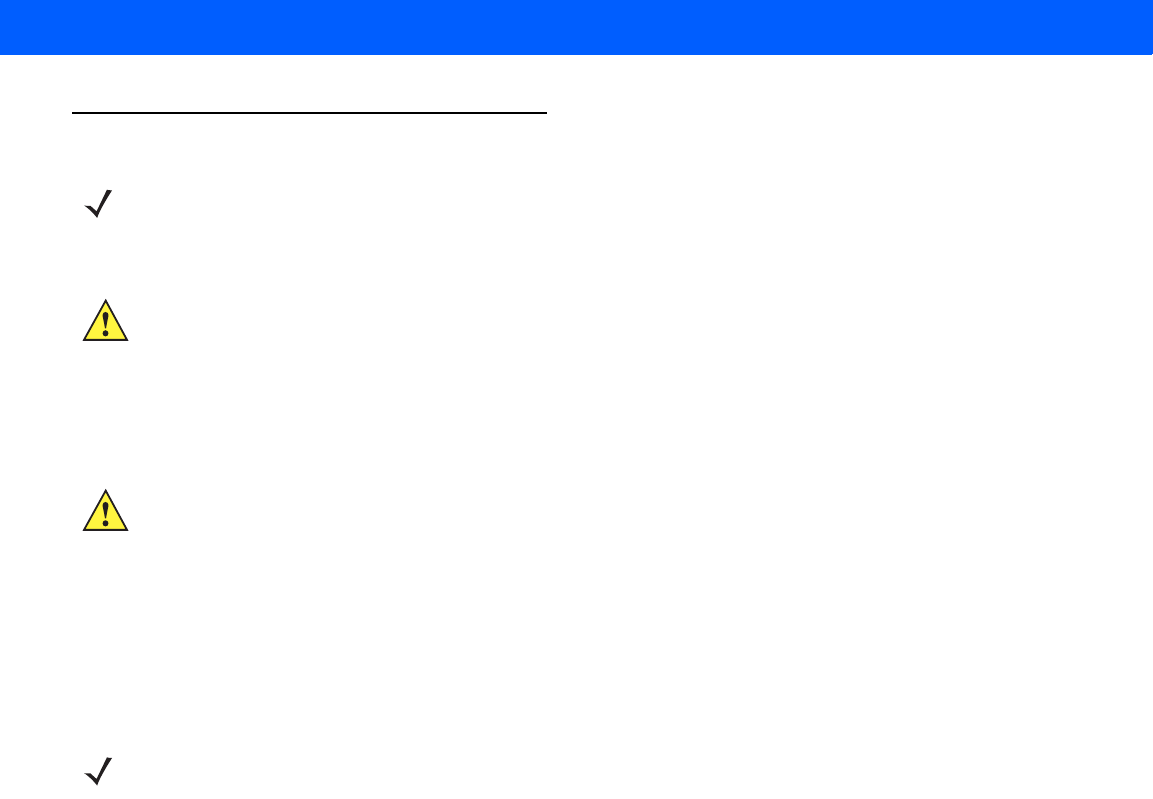
Accessories 4 - 9
Desktop Docking Stations - Models ST4002 and ST4003
The Omnii can be inserted into two desktop docking stations which are designed to charge the battery installed
in the hand-held along with a spare battery pack: Models ST4002 and ST4003.
The ST4002 and ST4003 desktop docking stations feature:
• Fast charging of the internal battery.
• Fast charging of the spare battery pack.
• A Host USB port to connect peripherals such as a printer, keyboard, etc.
• A Client USB port to connect the docking station to a PC.
The ST4003 desktop docking station additionally provides:
• A DE9M serial port (unpowered) and an RJ45 10Base-T Ethernet interface. Both these interfaces are com-
patible with the USB to Ethernet/serial drivers included in the Omnii (see Figure 4-10 Back of ST4003
Desktop Docking Station on page 4-10).
Specialized versions of the desktop docking station are available for Argentina and Korea. For Argen-
tina, model number ST4002-AR is packaged with a wall adaptor and a suitable, regional AR plug. For
Korea, model number ST4002-KR is packaged with a wall adaptor and a KR plug.
IMPORTANT The desktop docking station is shipped with its own quick start guide (ST4002 and ST4003
Desktop Docking Stations Quick Start Guide, PN 8000203). It is critical that it be reviewed
for additional information and updates.
IMPORTANT These docking stations can only be used to charge Motorola approved lithium-ion batteries.
NOTE The ST4002 desktop dock can be upgraded to include the DE9M and RJ45 interfaces by using
the ST4100 Xmod (Expansion Module).
Draft #4 for review
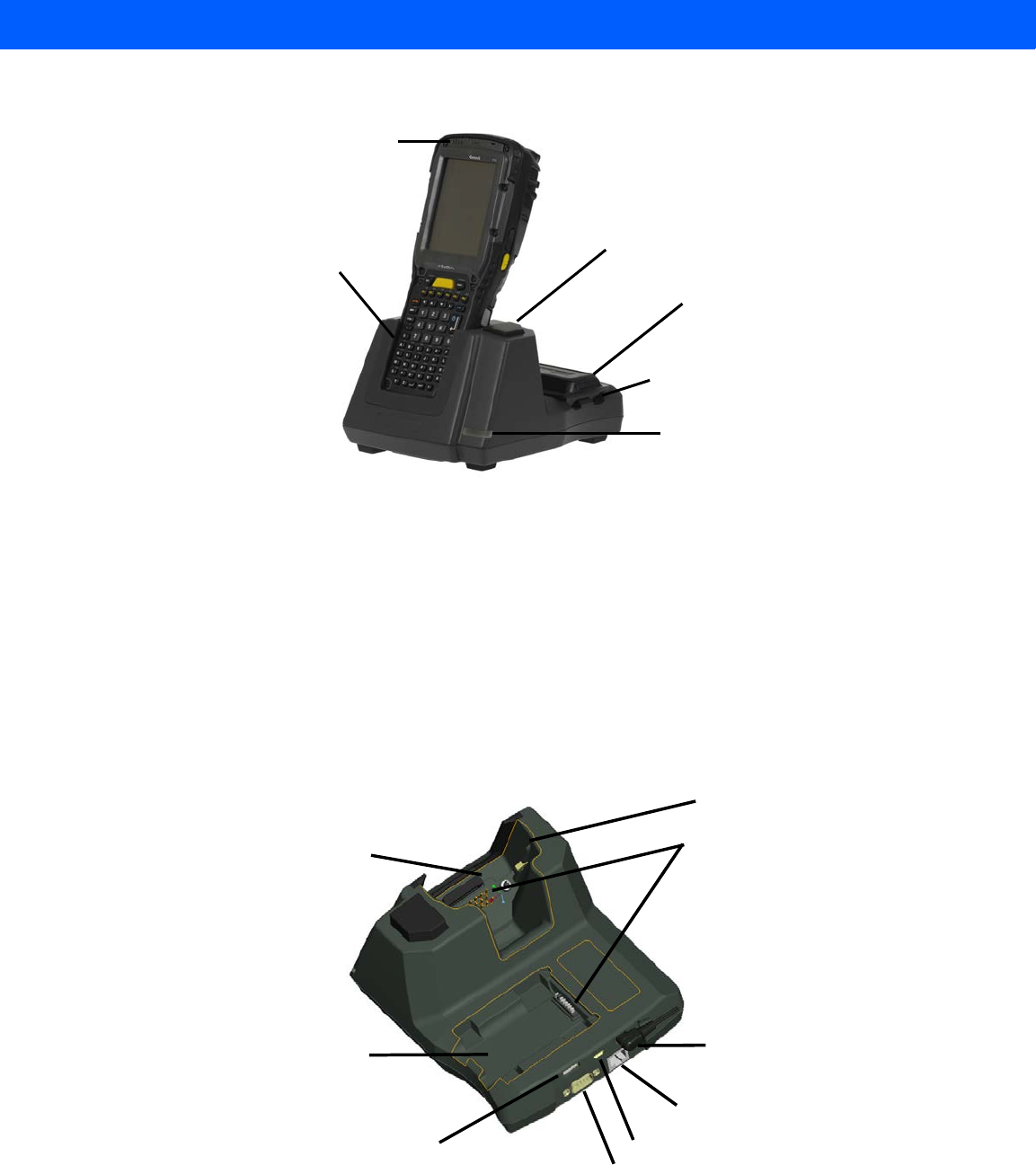
4 - 10 Omnii Hand-Held Computer with Windows CE 6.0 User Guide
Figure 4-9
Desktop Docking Station - Models ST4002 and ST4003
The desktop docking station storage temperature is -30°C to +60°C (-22°F to 140°F). Operating temperature
and humidity are: 5 - 95% non-condensing and 0°C to 40°C (32°F to 104°F).
The desktop docking station uses careful charge algorithms designed to maximize battery life while ensuring
the shortest possible charge time. See Battery Details on page 2-1 for more information regarding battery
capacity, charge times and battery life. See Charging the Spare Battery on page 4-11 for spare battery
charge information.
Figure 4-10
Back of ST4003 Desktop Docking Station
Omnii charging bay
Spare battery LED
(Indicates charge status of
a spare battery inserted
in the rear charging bay of
the docking station.)
Release button
Spare battery
Spare battery charging bay
Omnii charge indicator
LED (far left)
(Indicates charge status of
internal Omnii battery.)
charging bay
DC IN port
Spare battery
Host USB port Client USB port
RJ45 Ethernet port
DE9M serial port
Connector pins
Locking arm
charging bay
Omnii
Draft #4 for review
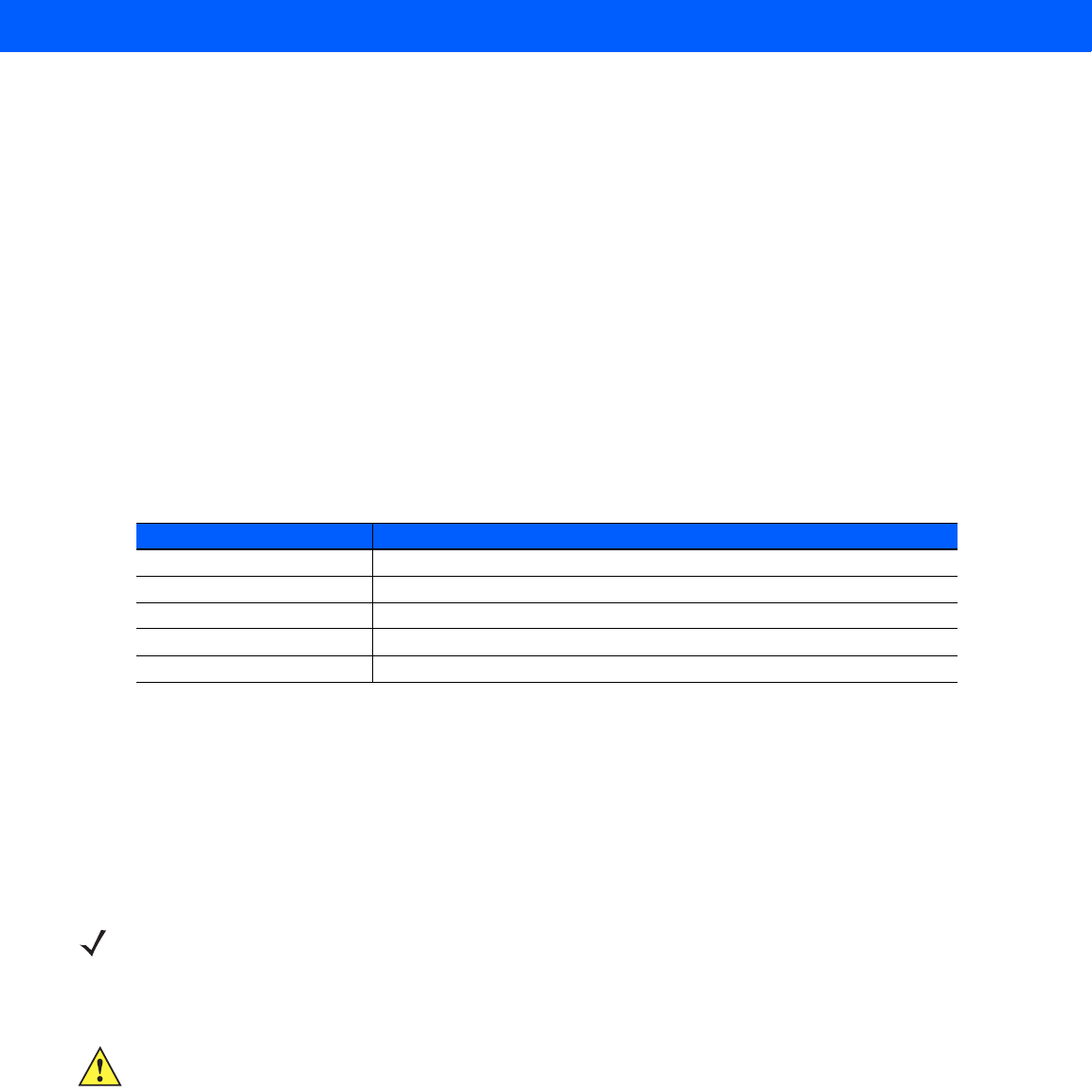
Accessories 4 - 11
Charging a Battery Installed in the Omnii
• Insert the DC power cable to the DC IN port on the desktop docking station. Plug the pronged end of the
cable into an AC outlet.
• Slide the hand-held into the docking station, making certain that the hand-held is securely seated on the
docking station connector pins and engages the locking arms of the docking station. When the Omnii is
switched on, a message is displayed briefly on the screen indicating that the unit is properly installed in the
station and the docking station icon is displayed in the taskbar.
The LED on the Omnii lights up indicating that the unit has external power and battery charging will begin. It is
safe to leave the unit in the desktop docking station while it is not in use — the battery will not be overcharged.
Indicators
The front-mounted LED on the desktop docking station indicates the spare battery charge status. The LED on
the Omnii is active even when the hand-held is inserted in a docking station (and in suspend mode) so that the
charge status of the battery can be detected easily.
Operation
Charging the Omnii Battery
The desktop docking station supplies DC power to enable the Omnii internal fast charger.
When installed in the dock, the Omnii battery charge LED will illuminate to indicate the unit has external power
and can charge the internal battery. The Omnii charge indication follows the same convention as the charger's
spare battery indicator (Figure 4-9 Desktop Docking Station - Models ST4002 and ST4003 on page 4-10).
Charging the Spare Battery
• Install the battery in the battery charging bay (rear slot of the desktop docking station). Place the battery
contacts down to mate with the connector, and pivot the battery into place in the battery charging bay.
• The desktop docking station spare battery LED lights up immediately. During charge the LED will be
flashing green.
• When the battery has finished charging, the LED turns solid green.
• The charge stops when the battery is fully charged and the LED remains green.
A full charge will take 3 to 4 hours for a 5000 mAh battery. This may take up to 8 hours if the hand-held is also
docked and charging.
Charge LED Behaviour Function
OFF No battery detected
Solid Green Battery charging complete
Flashing Green Charge in progress
Flashing Yellow Battery is not charging due to out-of-temperature conditions
Solid Red Battery is not charging due to out-of-temperature conditions
NOTE Battery charging continues whether the Omnii is switched on or off.
IMPORTANT Do not store spare batteries in a charger for more than 72 hours. Doing so may damage
the battery or reduce its charge capacity.
Draft #4 for review

4 - 12 Omnii Hand-Held Computer with Windows CE 6.0 User Guide
Cleaning the Desktop Docking Station
• Use only mild detergent or soapy water on a slightly damp cloth to clean the desktop docking station. Avoid
abrasive cleaners, solvents or strong chemicals for cleaning. The plastic case is susceptible to harsh
chemicals. The plastic is partially soluble in oils, mineral spirits and gasoline. The plastic slowly decom-
poses in strong alkaline solutions.
Troubleshooting
The indicators, applications, and drivers required to use and monitor the desktop docking station as a dock (as
opposed to a charger) are installed on the Omnii — no applications are present on the docking station itself.
Docking station does not seem to power on.
• When first connected to the DC power supply, the charger LED should flash a sequence of red, yellow, and
green.
• If not, the charger is defective and requires service.
The Omnii charge indicator LED stays off.
When the Omnii is docked into a powered desktop docking station and the Omnii charge indicator LED stays
off, there could be a problem with the hand-held or with the docking station. Use a hand-held with a properly
functioning charge indicator to isolate the problem.
The Omnii charge indicator LED is red.
If the Omnii charge indicator is red when the hand-held is docked:
• Remove the Omnii and disconnect the adaptor DC power cable.
• Wait at least 20 seconds, and then plug the cable in again.
• If the Omnii indicator still shows a fault, the hand-held requires service.
Spare battery LED is red with a battery installed.
• Try inserting a battery that is known to be working with another charger.
• If the charge slot LED continues to show red with the known working battery, the charger is defective and
requires service.
• Your Motorola battery and desktop docking station are carefully designed for safety and capacity perfor-
mance. If the battery or charger are not Motorola approved products, or the safety mechanism is faulty, the
spare charge slot LED or the Omnii LED will display red.
Spare battery LED does not turn on when a battery is installed.
• Inspect the charge slot contacts for damage (are they bent, flattened, twisted or broken?).
• Reinstall the battery and check that it is fully seated in the slot.
• Try inserting a battery that you know to be working into the charger slot.
IMPORTANT Do not immerse the unit in water. Dampen a soft cloth with mild detergent to wipe the
unit clean.
NOTE The desktop docking station charge LED only shows the status of the spare battery.
Draft #4 for review
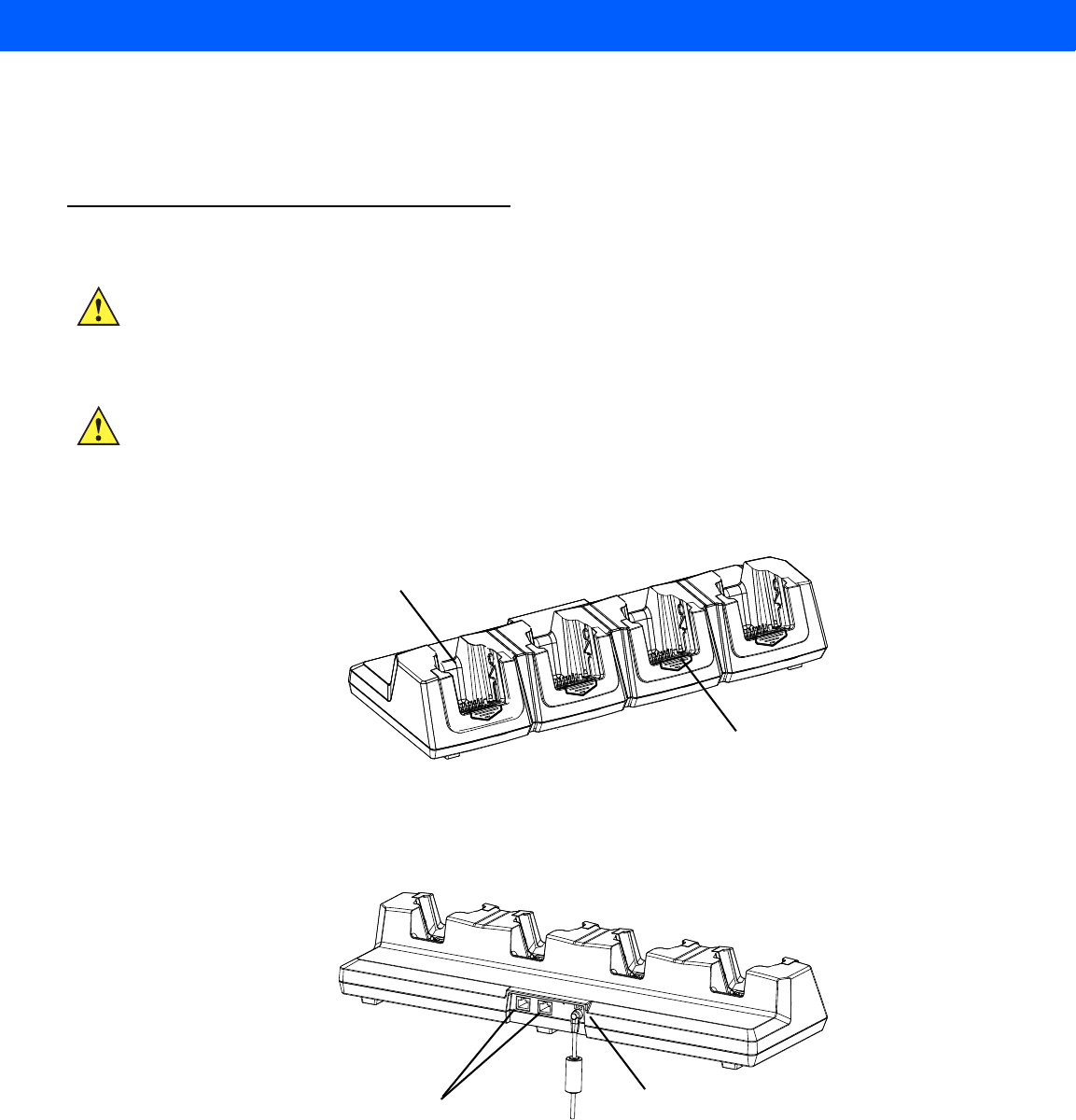
Accessories 4 - 13
• Disconnect and reconnect the DC adaptor, and check that the spare battery LED indicator flashes at
power-up.
• If the charge slot fails to charge the known working battery, it is defective and requires service.
Quad Docking Station – Model No. ST4004
Figure 4-11
Front view
Figure 4-12
Rear view
The ST4004 Quad Docking Station is designed to accept up to four Omnii hand-held computers. The docking
station powers the units and their internal battery charger. The docking station also connects up to four of the
hand-held computers to a 10/100 Base-T Ethernet network and allows for Ethernet data transfer. An additional
Ethernet interface is available for connecting more docking stations downstream, up to 4 on the same network.
Operator Controls
The ST4004 has no operator controls or power switch.
IMPORTANT The quad docking station is shipped with its own quick start guide — Omnii ST4004 Quad
Docking Station Quick Start Guide (PN 8000222). It is critical that it be reviewed for addi-
tional information and updates.
IMPORTANT When ordering a charger, you must also order an IEC-320/IEC-60320 C13 power cord
separately.
Docking connectors (4)
Charging bays (4)
RJ45 Ethernet ports DC IN connector
Draft #4 for review
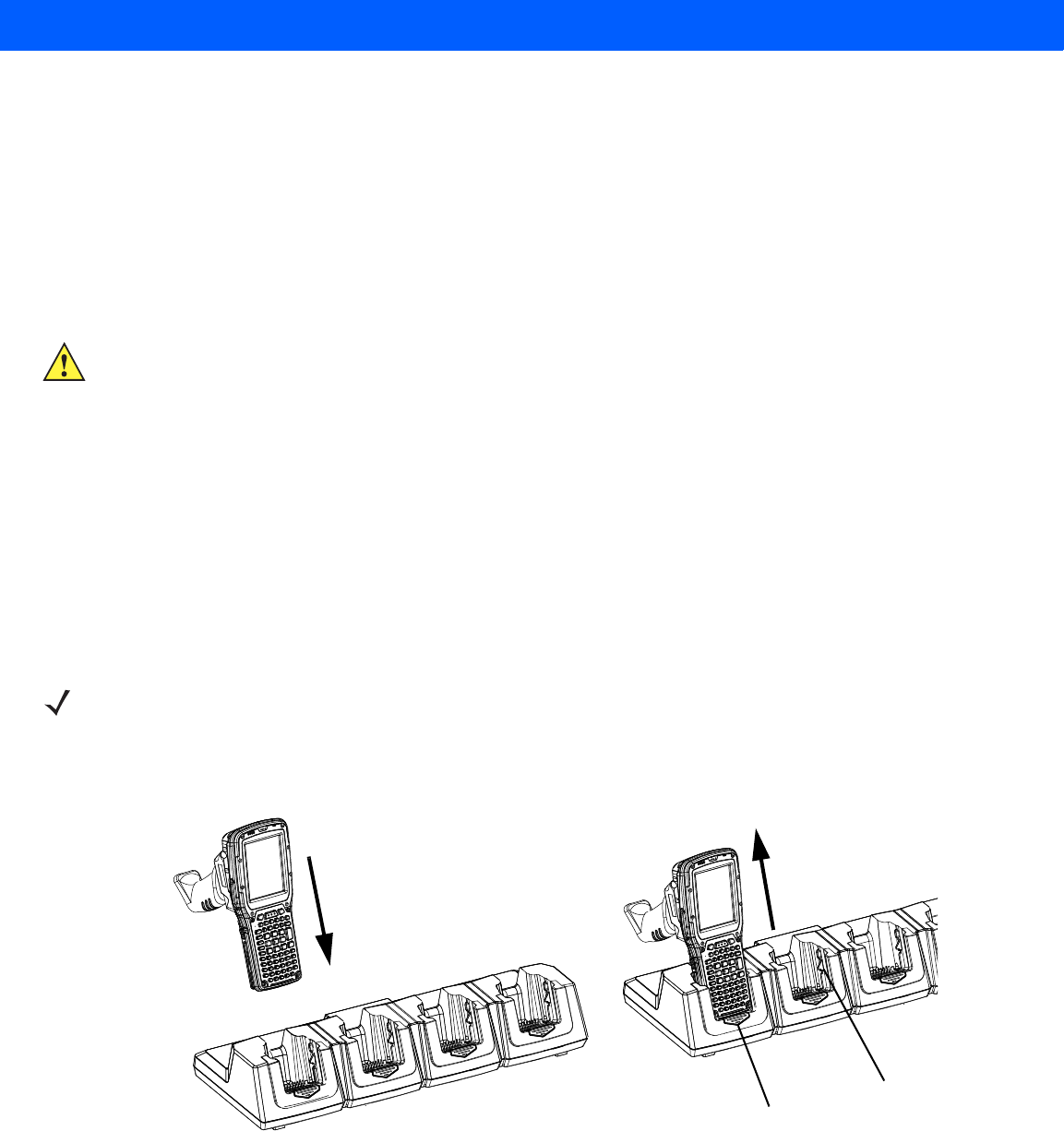
4 - 14 Omnii Hand-Held Computer with Windows CE 6.0 User Guide
Indicators
The quad docking station is equipped with Ethernet activity and link LEDs (see Figure 4-14 Ethernet network
connection on page 4-15).
Quad Docking Station Operation
Charging the Omnii Battery
• Insert the DC power plug into the ST4004 rear DC IN connector (see Figure 4-14 Ethernet network
connection on page 4-15).
The ST4004 supplies DC power to enable the Omnii internal fast charger. Normally, a full charge of the battery
will take from 3 to 4 hours.
• Insert up to four Omnii computers into the docking station charging bays, pressing down gently but firmly to
seat them securely.
• During the charge, the Omnii LED slow flashes green.
• When the battery finishes charging, the LED turns solid green.
• To remove the Omnii, push down on the release mechanism on the front face of the docking bay. The
hand-held will detach from the docking bay release arms and can be pulled up and out.
Figure 4-13
Insertion and removal of Omnii computers
Installation
Place the charger in an area that is free from excessive dirt, dust, water and other liquids, and contaminants.
The ambient temperature must be in the range 0° C and 40° C (32° F to 104° F). The docking station will not
charge batteries outside of this temperature range. For maximum performance, it is recommended that the
charger be operated at room temperature — a temperature range between 18°C to 25°C (64°F to 77°F).
IMPORTANT Use IEC-320 C13 power cords approved by Motorola, with the ground pin connected to a
proper earth-grounded receptacle. Check with a qualified electrician if you are uncertain
of your receptacle grounding.
NOTE Battery charging continues whether the Omnii is switched on or off.
Release mechanism
Release arm
Draft #4 for review
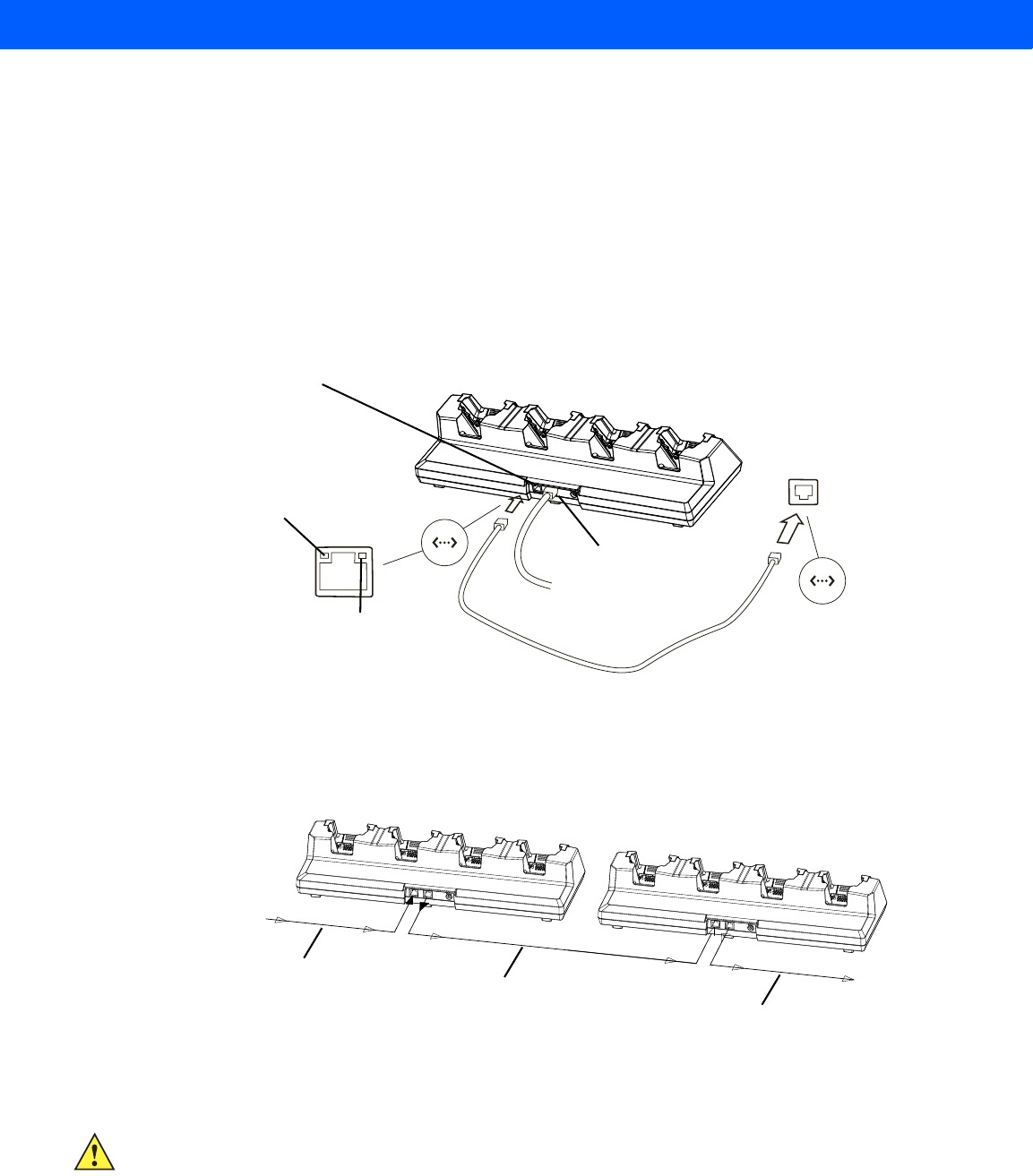
Accessories 4 - 15
Connecting to the Ethernet Network
Network Access
The Omnii automatically detects insertion into the docking station and loads the appropriate drivers to commu-
nicate with the network. To connect more docking stations downstream (up to 4 on the same network), use the
Ethernet cable supplied with your quad docking station as the daisy chain cable (see Figure 4-15 Daisy chain
configuration on page 4-15).
Figure 4-14
Ethernet network connection
Figure 4-15
Daisy chain configuration
Cleaning the ST4004
Use only mild detergent or soapy water on a slightly damp cloth to clean the ST4004. Avoid abrasive cleaners,
solvents or strong chemicals for cleaning. The plastic case is susceptible to harsh chemicals. The plastic is
partially soluble in oils, mineral spirits and gasoline. The plastic slowly decomposes in strong alkaline solutions.
Left-side RJ45 port
10 or 100 Base-T
(Ethernet connector to network)
Link LED
(solid amber)
Activity LED
(flashing green)
Right-side RJ45 port
(Ethernet connector to
other docks)
Ethernet connector
Maximum of four ST4004 Quad Docking Stations on one network cable
Ethernet network cable Daisy chain cable
Daisy chain cable
IMPORTANT Do not immerse the unit in water. Dampen a soft cloth with mild detergent to wipe the
unit clean.
Draft #4 for review
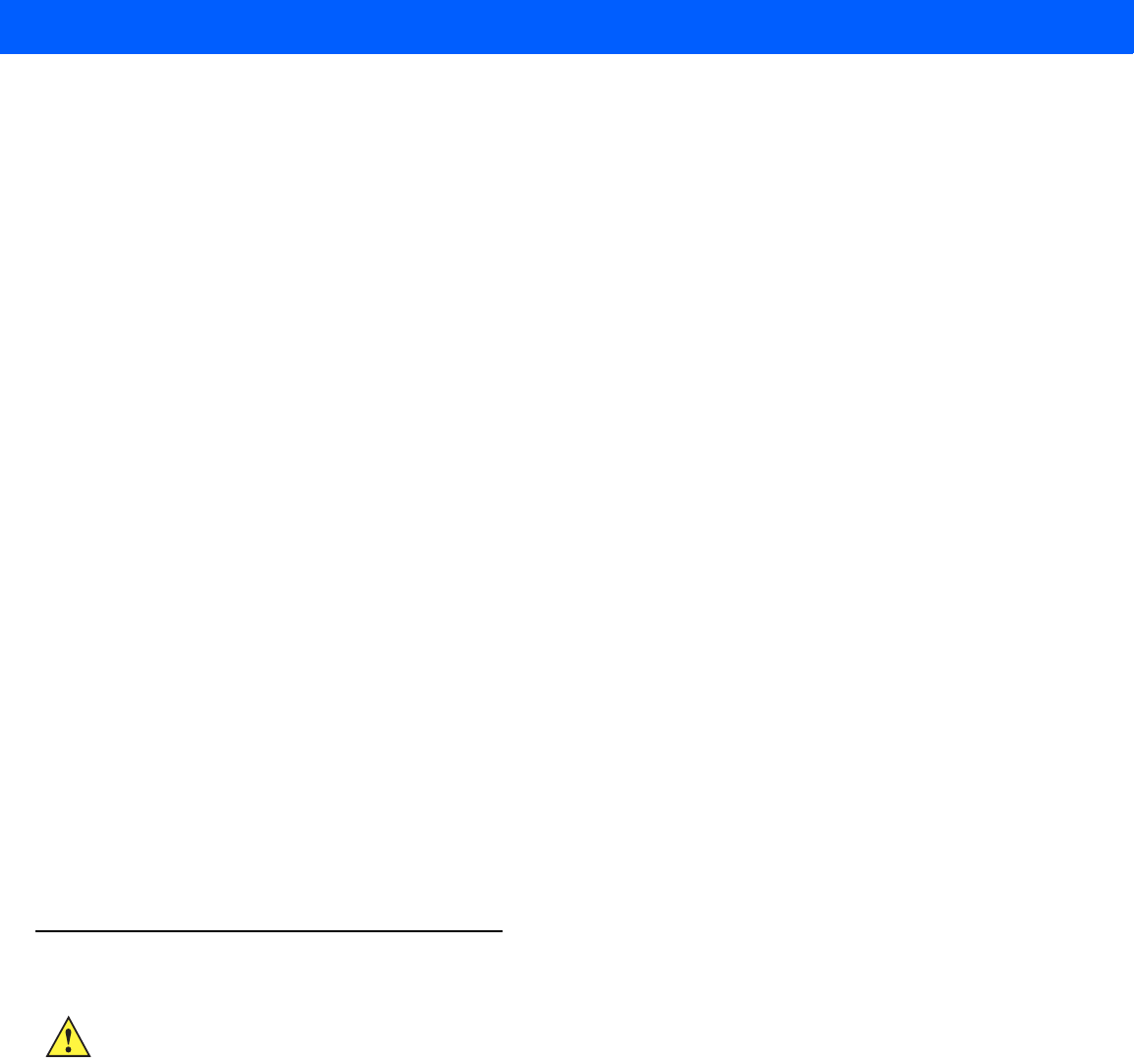
4 - 16 Omnii Hand-Held Computer with Windows CE 6.0 User Guide
Troubleshooting
The Omnii Charge Indicator LED Stays Off
When the Omnii is docked in a powered ST4004 and the hand-held’s charge indicator LED stays off, there may
be a problem with the Omnii or with the docking station. Make sure a battery is installed in the Omnii, otherwise
use an Omnii with a properly functioning charge indicator to isolate the problem.
Power LED Does Not Light Up
• Remove all Omnii units, and unplug the docking station.
• Connect another device to the mains outlet to ensure there is power.
• Remove the IEC mains power cable from the charger, and check it for damage.
• Reconnect the mains cable in the charger and mains outlet.
The Omnii Charge LED Flashes Yellow
A flashing yellow Omnii charge LED (the left-most LED on the hand-held) indicates that the battery is not within
the allowable charging temperature range – 0° C and 40° C (32° F to 104° F). Allow the battery to come to an
acceptable range before reinserting the Omnii in the docking station.
The Omnii Charge Indicator LED is Red
If the Omnii charge indicator is red when the Omnii is in any of the four bays, the quad dock cannot read the
battery, is in charging timeout, or it is not a Motorola battery.
• Remove the computers and disconnect the adaptor DC power cable.
• Wait at least 20 seconds, and then plug the cable in again.
• If the Omnii indicator still shows a fault, the Omnii requires service.
Powered Adaptor LED Stays Off
• Check the AC cable. Replace with the same type if the cable is suspect.
• If the adaptor LED stays OFF, the adaptor is defective and requires service.
Vehicle Cradles - Models ST1000 and ST1002
The Omnii vehicle cradles are highly ruggedized, single station docks. Although they provide quick insertion
and removal, the cradles hold the Omnii securely even when operated in high vibration environments (such as
vehicles not equipped with suspensions).
The Omnii vehicle cradle is available in two models:
• Model ST1000 - Unpowered cradle.
• Model ST1002 - Powered cradle with communications port. A DE9M serial port (powered) and two USB
Host interfaces.
IMPORTANT The vehicle cradles are shipped with their own quick start guide — Omnii Vehicle Cradles
Quick Start Guide (PN 8000221). It is critical that it be reviewed for additional information
and updates.
Draft #4 for review
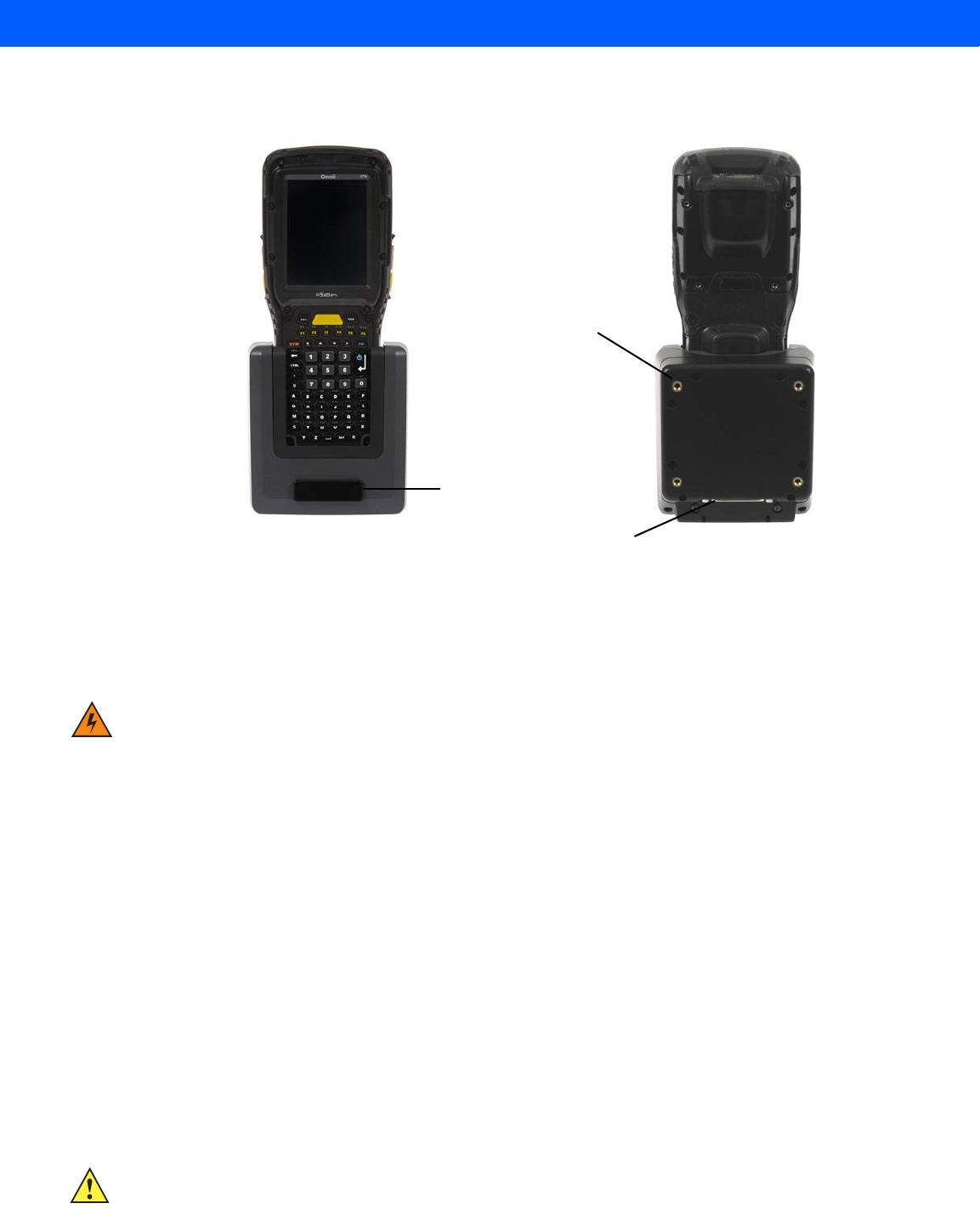
Accessories 4 - 17
Figure 4-16
Front and back of ST1002 with Omnii
Motorola also supplies a range of standard mounts for the hand-held vehicle cradles, and the Omnii vehicle
cradles are compatible with all of them.
Vehicle Cradle Mounting Recommendations
Pedestal mounts are recommended for all fixed mount locations because they offer optimal operator access. In
addition, for safety reasons, only pedestal mounts with fully locking joints should be used in vehicles. Always
adjust the pedestal for the optimum viewing angle, and securely tighten the hex and wing screws.
The most effective way to mount the vehicle cradle is to use brackets with the MT3324 (short arm) or MT3325
(standard arm) kit. The ST1002 requires either the MT3326 or MT3327 bracket; the ST1000 requires the
MT3328 bracket.
Release button
Mounting holes
Power/Communications port
WARNING! Before mounting a vehicle cradle in a vehicle, there are a number of operator safety
issues that require careful attention. An improperly mounted cradle may result in
one or more of the following: operator injury, operator visibility obstruction, operator
distraction and/or poor ease of egress for the operator. Motorola strongly recom-
mends that you seek professional mounting advice from the vehicle manufacturer.
Ensure that you read the ST1002 Vehicle Cradle Installation Instructions document
(PN 1020305), enclosed with the ST1002, for important safety information on con-
necting fuses.
Cable routing within a vehicle cab also requires careful consideration, especially for
devices with loose cables. If you are unable to obtain suitable advice, contact
Motorola for assistance. Note also that for better protection, the equipment should
be mounted inside the vehicle roll cage.
IMPORTANT It is strongly recommended that all forklift mounting solutions use clamp bases rather than
plate bases that require penetrating through the vehicle for installation.
Draft #4 for review
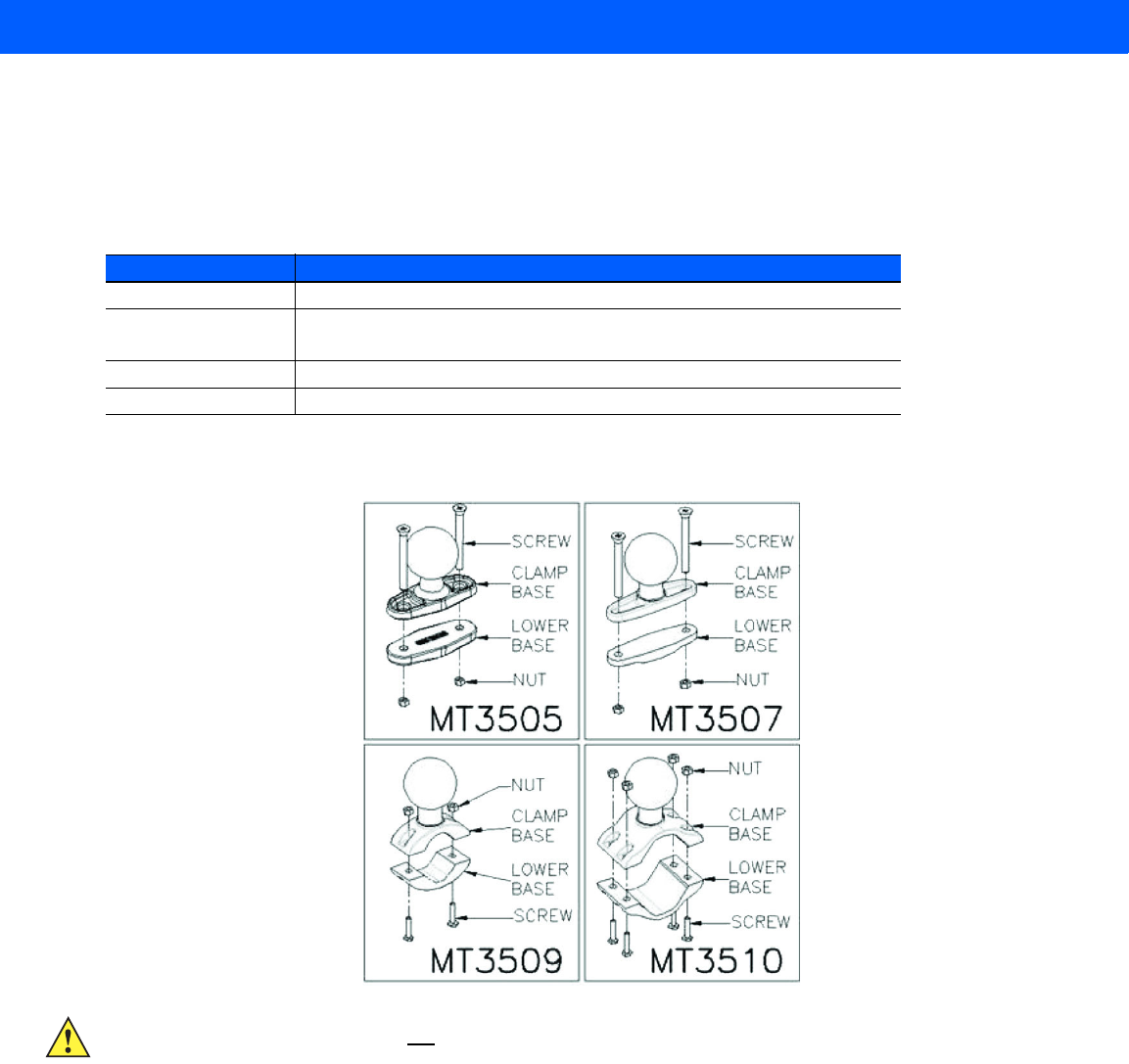
4 - 18 Omnii Hand-Held Computer with Windows CE 6.0 User Guide
A clamp base is required to secure the vehicle cradle/arm assembly to the vehicle. Choose from one of the
following clamp base sizes:
• MT3505
• MT3507
Figure 4-17
Clamp and Rail Bases (Torque to 26 in-lbs)
Model Rail Width
MT3505 Clamp base (for 4" or 12" RAM arm), 2" max. width
MT3507 Number of transmit errorsClamp base (for 4" or 12" RAM arm), 3"
max. width
MT3509 Rail base (for 4" or 12" RAM arm), 1-1/4" to 1-7/8"
MT3510 Rail base (for 4" or 12" RAM arm), 2" to 2 1/2"
IMPORTANT Plate bases are not recommended for forklift mounting solutions. If a plate rather than a
clamp base is used, you will need to penetrate into the structure of the vehicle, a process
requiring additional hardware. The following plate bases are available:
• VESA Plate – MT3501
• Circular Plate – MT3502
Draft #4 for review
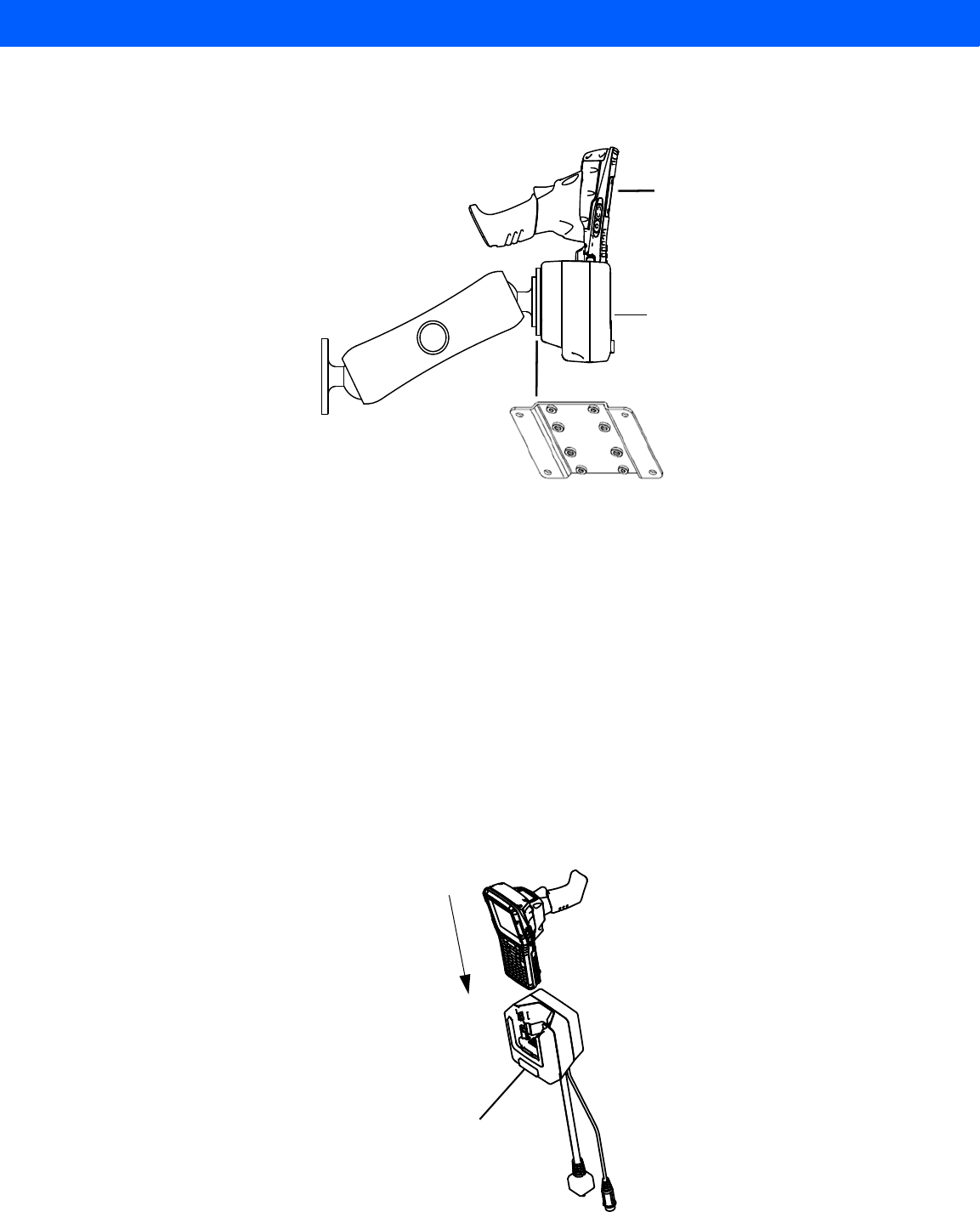
Accessories 4 - 19
Figure 4-18
MT3325 Standard Arm Kit with Omnii Vehicle Cradle Clamp and Rail Bases (Torque to 26 in-lbs)
To accommodate the service loop of the connector cable, leave a 4" clearance at the bottom of the cradle.
Leave a 7" (minimum) clearance at the top of the cradle to allow easy removal of the hand-held. Refer to the
detailed assembly instructions that are packaged with the cradle when selecting a mounting location (Omnii
Vehicle Cradles Quick Start Guide PN 8000221).
Insertion and Removal of Omnii
If your Omnii is equipped with a cover, or the ST6025 Double Loop Hand strap, these accessories need to be
removed before installing the unit in a vehicle cradle. There is no need to remove other hand straps or pistol
grips from the unit.
• Slide the Omnii into the cradle, and press firmly downward until it locks into place. On a vehicle, it’s a good
idea to pull up on the Omnii to be certain that it is secure.
• To remove the Omnii, press the release button on the front of the cradle until it releases.
Figure 4-19
Inserting Omnii into the vehicle cradle
MT3326 Bracket
MT3325 Arm
ST1002 Cradle
(powered)
Omnii
Release
button
Draft #4 for review
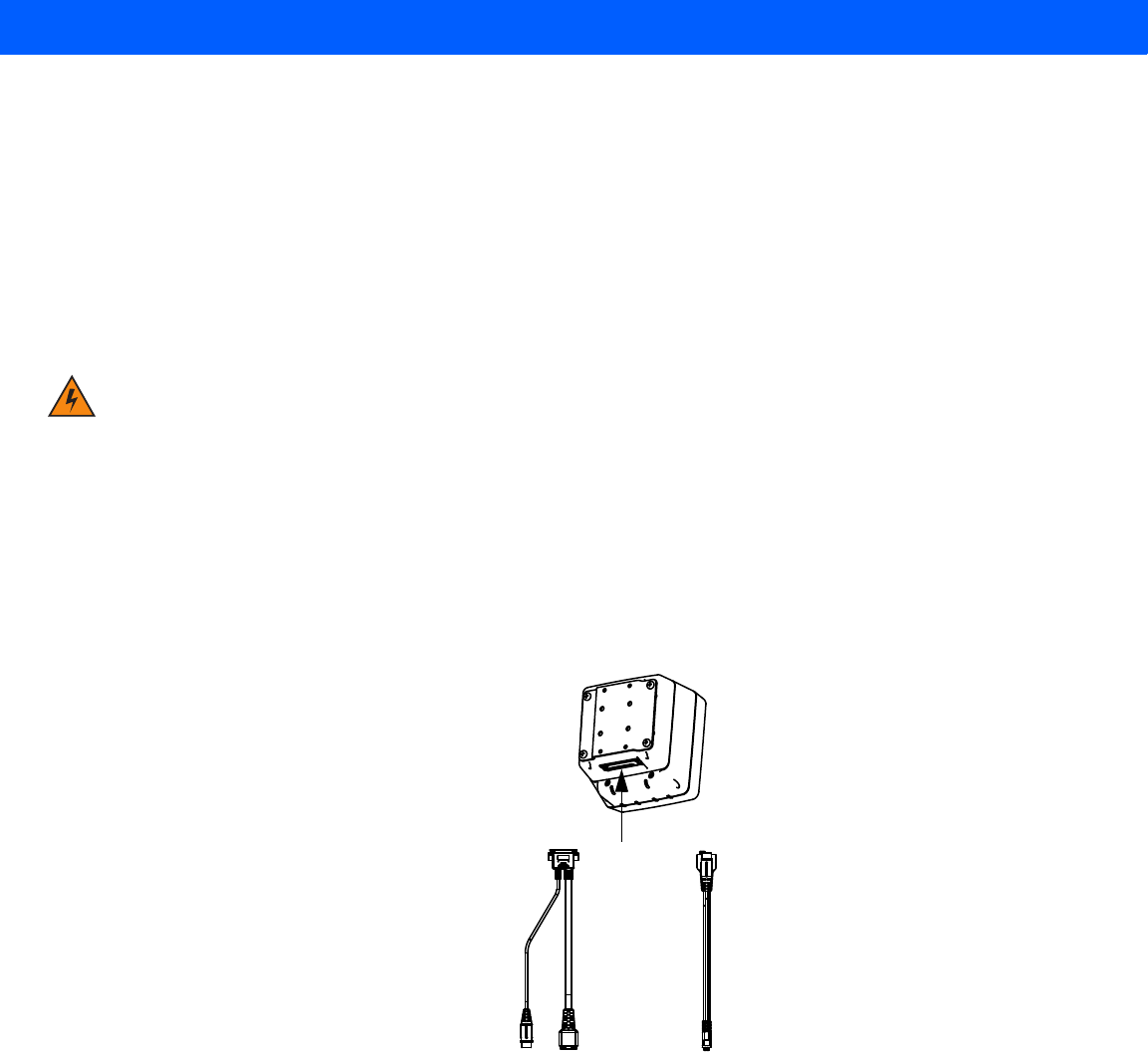
4 - 20 Omnii Hand-Held Computer with Windows CE 6.0 User Guide
Maintaining the Vehicle Cradle
Two latches in the cradle hold the Omnii firmly in place. Although these latches are designed for at least
100,000 insertion and removal cycles, they will wear over time and will no longer lock the Omnii securely in the
cradle. For replacement parts and instructions contact Motorola. Partial disassembly is required.
ST1002 Powered Cradle Installation
The ST1002 cradle is designed to allow the Omnii to be powered by a vehicle battery. The battery installed in
the Omnii is also recharged by the vehicle battery. This option accepts DC power sources over the range 11.5V
to 30V. Voltages above that require the use of the preregulator (Model No. PS1350).
The ST1002 Vehicle Cradle has a 44-pin connector that allows connection with either the CA3001 Vehicle
Cradle Power and Communications Cable (DE9M serial port, 2 USB Host interfaces, and power cable) or the
power-only CA3000 Vehicle Cradle Power Cable. For connector pinouts and a cable connections diagram, see
Cable Connectors for Vehicle Cradle Model ST1002 on page A-3.
Figure 4-20
Connecting to vehicle power
For a diagram of a power with communications setup, see Figure 4-21 Connecting ST1002 to vehicle power
and communications in a typical setup on page 4-22.
The Omnii charging LED (see Battery Charge Status LED on page 2-9) indicates that external power is avail-
able, and it also indicates the charging status of the internal battery.
Wiring Guidelines
Before installing the cables between the cradle and other devices, consider the following:
• Ensure that drilling holes will not damage the vehicle or its wiring.
• Protect cable runs from pinching, overheating and physical damage.
• Use grommets to protect cables that pass through metal.
WARNING! Applying a voltage greater than that specified, or reversing polarity, may result in
permanent damage to the cradle power option and will void the product warranty.
Operating an Omnii XT15f Arctic unit in operating temperatures from -30°C to
+50°C, requires the use of the power preregulator Model No. PS1370.
CA3001 Vehicle Cradle Power
and Communications Cable
CA3000 Vehicle Cradle
Power Cable
Draft #4 for review

Accessories 4 - 21
• Use plastic straps and tie-downs to secure cables and connectors in their desired location, away from
areas where they may get snagged or pulled.
• Keep cables away from heat sources, grease, battery acid and other potential hazards.
• Keep cables away from control pedals and other moving parts that may damage the cables or interfere
with the operation of the vehicle.
Installation in High Voltage Vehicles
Due to the hazardous voltages present on these vehicles, it is necessary to ensure that the powered cradle
power supply cable connector is not accessible to the vehicle operator, and does not get exposed to water or
other liquids. Exposing an accessible power connector to water or other liquids could create a hazardous
situation resulting in serious injury or death. Avoiding this hazard can be accomplished in the following
way.
• Use the PS1350 pre-regulator or, for freezer applications (-30°C), the PS1370 pre-regulator.
• Ensure the power connector is wrapped securely with a waterproof electrical tape and installed in a dry
location on the vehicle, away from the vehicle operator’s reach (perhaps under a vehicle dash or in a
sealed housing).
• Cover the power connector with a waterproof heat shrink material (see Extreme Wet Environments on
page 4-21 for additional details).
All other installation requirements outlined in this document should also be followed for High Voltage vehicles
to insure safe installation and operation of the powered cradle.
Extreme Wet Environments
For extreme wet environments, or environments where it is difficult to restrict vehicle operator access to the
power connector, Motorola offers a waterproof heat shrink kit (PN 1030022). The kit contains 3 pieces of water-
proof, high shrink ratio heat shrink tubing which can be used to encapsulate the entire connector assembly. If
using this kit, please ensure that you order sufficient material to cover installation and service, remembering
that heat shrink is one-time use, and must be replaced if it is removed from the connector for any reason.
Wiring Vehicle Power and Communications to the Cradle
An optional 1.8 meter (6 foot) extension power cable (PN 13985-301 with motion detect or 13985-302) is avail-
able for your powered vehicle cradle. This cable should be wired to a filtered, fused (maximum 4A) accessory
supply on the vehicle. The power cradle draws no more than 4A (less if the accessory supply is greater than
12V). Any additional wiring, connectors or disconnects used should be rated for at least 10A. Installation of the
19440-XXX fuse assembly using a 4A 250V fuse installed is mandatory, except when using a CA3002 vehicle
power cable. The 13985-XXX cables are not used with the CA3002. The 4A fuse is already included in the
CA3002 vehicle connector assembly.
The red lead of the power cable attaches to the positive vehicle supply. The black lead connects to the nega-
tive supply — this should be connected to a proper terminal block and not to the vehicle body.
WARNING! Voltages exceeding 30VDC are considered hazardous. Installation of powered
cradles in vehicles that operate above 30VDC require special consideration, as
listed below.
NOTE When connecting PN 13985-301 (Screen Blanking version), ensure that the screen blanking
wires (clearly labelled) and the power wires (red/black leads) are reliably secured away from
each other, or are separated with reliably secured certified insulation. A minimum 2.8mm dis-
tance, or 0.4mm distance through insulation, is required for the separation.
Draft #4 for review
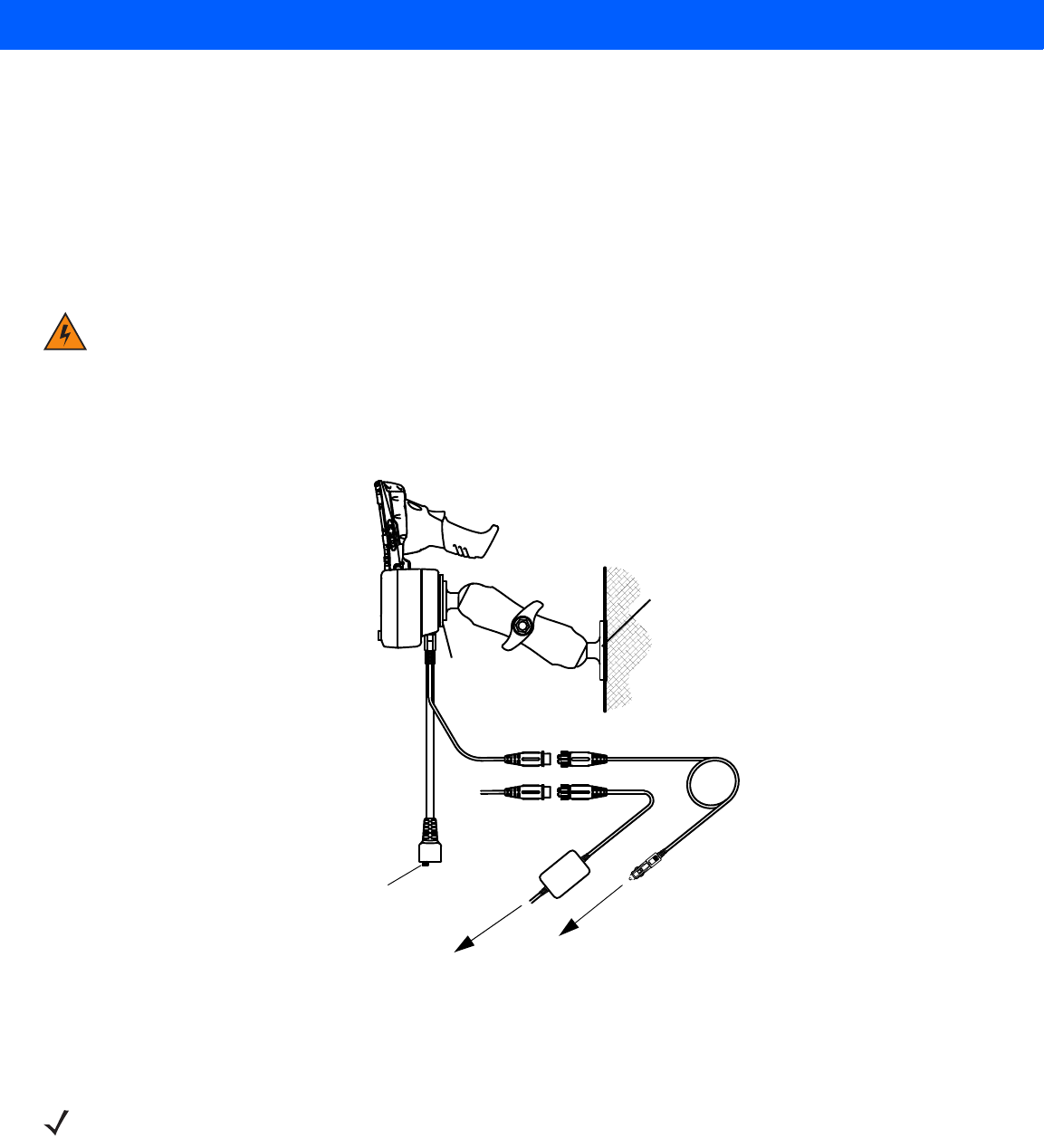
4 - 22 Omnii Hand-Held Computer with Windows CE 6.0 User Guide
You may have the option of connecting power before or after the key switch. It is preferable to wire the power
cradle after the key switch — that is, it cannot be turned on without the key on. However, if the operator
switches the key off repeatedly for long periods during a shift, it may make more sense to wire the cradle
before the switch.
Keep in mind that the Omnii will continue to operate with or without vehicle power as long as its battery has
sufficient charge. If an unfused power source must be used, a fuse assembly (PN 19440-300) must be added
to the extension power cable (the fuse and instructions are supplied with the cable). Use only a 4A fast blow
UL approved fuse in the fuse assembly (PN 9016622).
Figure 4-21
Connecting ST1002 to vehicle power and communications in a typical setup
WARNING! 11.5–30 Vdc input only, suitable for road vehicles. A pre-regulator is required for use
on forklifts. For such installations Motorola recommends using the PS1350 (15-90
VDC) pre-regulator or, for freezer applications, the PS1370 pre-regulator.
PS1350
PS1350
Pre-regulator
Vehicle power
Forklift power
OR CA3002 Vehicle Power
Outlet (CLA) Adaptor
OR
Omnii
ST1002
CA3001 Cable
MT3326
Mounting Bracket
MT3325
Arm/Ball Kit MT3502 Circular Plate
USB and Serial access*
* Note: The serial port is 5 VDC, 1 A maximum power out and is defaulted to off.
To enable power to this port, in your Omnii desktop, go to Control Panel>Scanners, which opens
NOTE For the CA3002 Vehicle Power Outlet (CLA) Adaptor, replace with same fuse type and rating.
Draft #4 for review
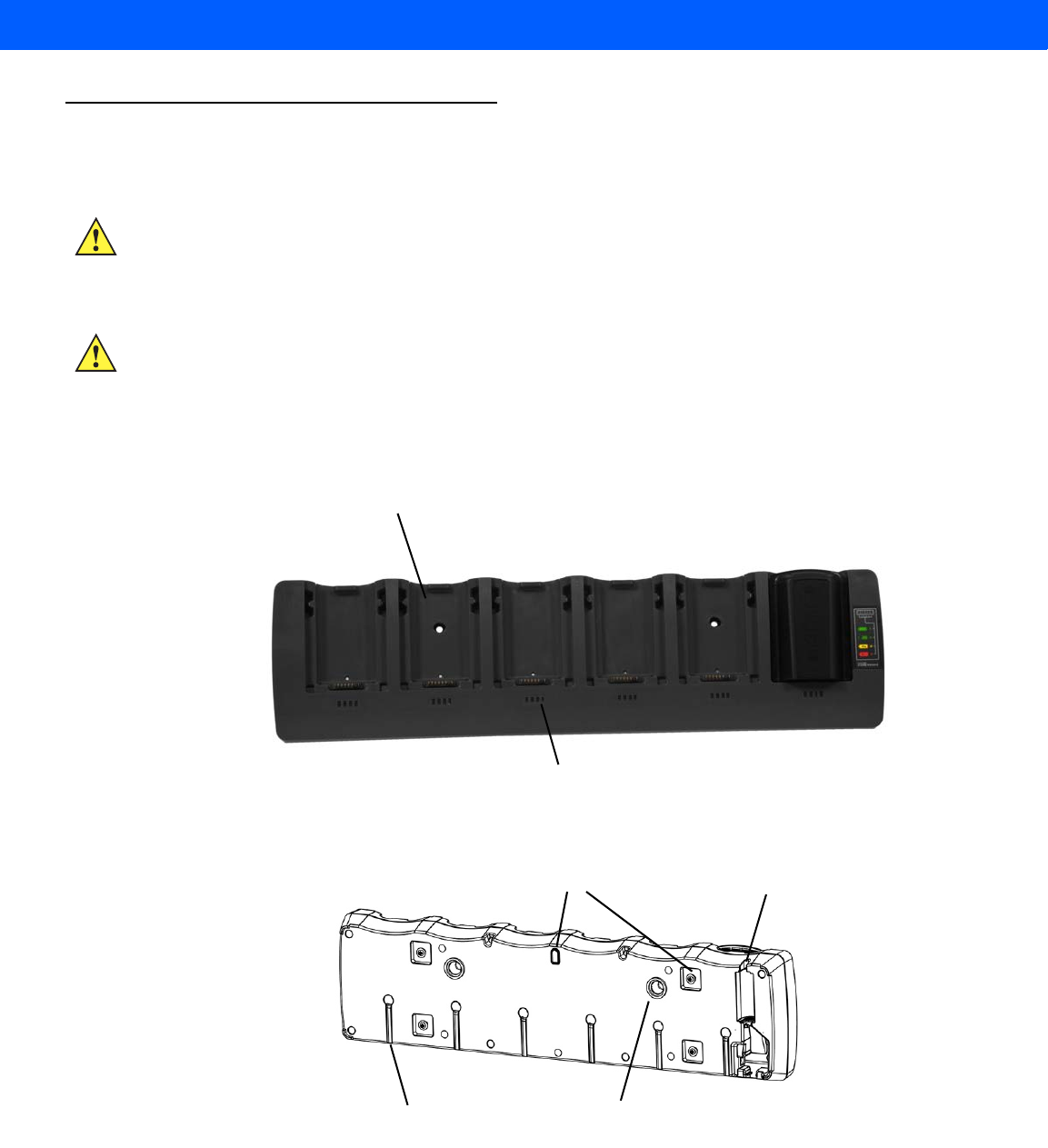
Accessories 4 - 23
Battery Charger (6-Slot) - Model ST3006
The ST3006 is designed to charge up to six Omnii lithium-ion batteries at one time.
Figure 4-22
ST3006 Battery Charger
Installation
The charger can be wall mounted using the wall mount kit (MT2031) or it can be operated on a flat surface.
Install the charger in an area that is free from excessive dirt, dust and contaminants. The ambient temperature
must be in the range 5°C to 39°C (41°F to 102°F). The charger will not charge batteries outside of this temper-
IMPORTANT The battery charger is shipped with its own quick start guide — ST3006 6-Slot Battery
Charger Quick Start Guide (PN 8000204). It is critical that it be reviewed for additional
information and updates.
IMPORTANT When ordering a charger, you must also order an IEC-320/IEC-60320 C13 power cord
separately.
DC IN connector
Rubber feet (5)
Charging bay (6)
TOP
BOTTOM
Drain holes (6) Bracket mounting holes (2)
Charger indicator LEDs (4 per bay)
Draft #4 for review
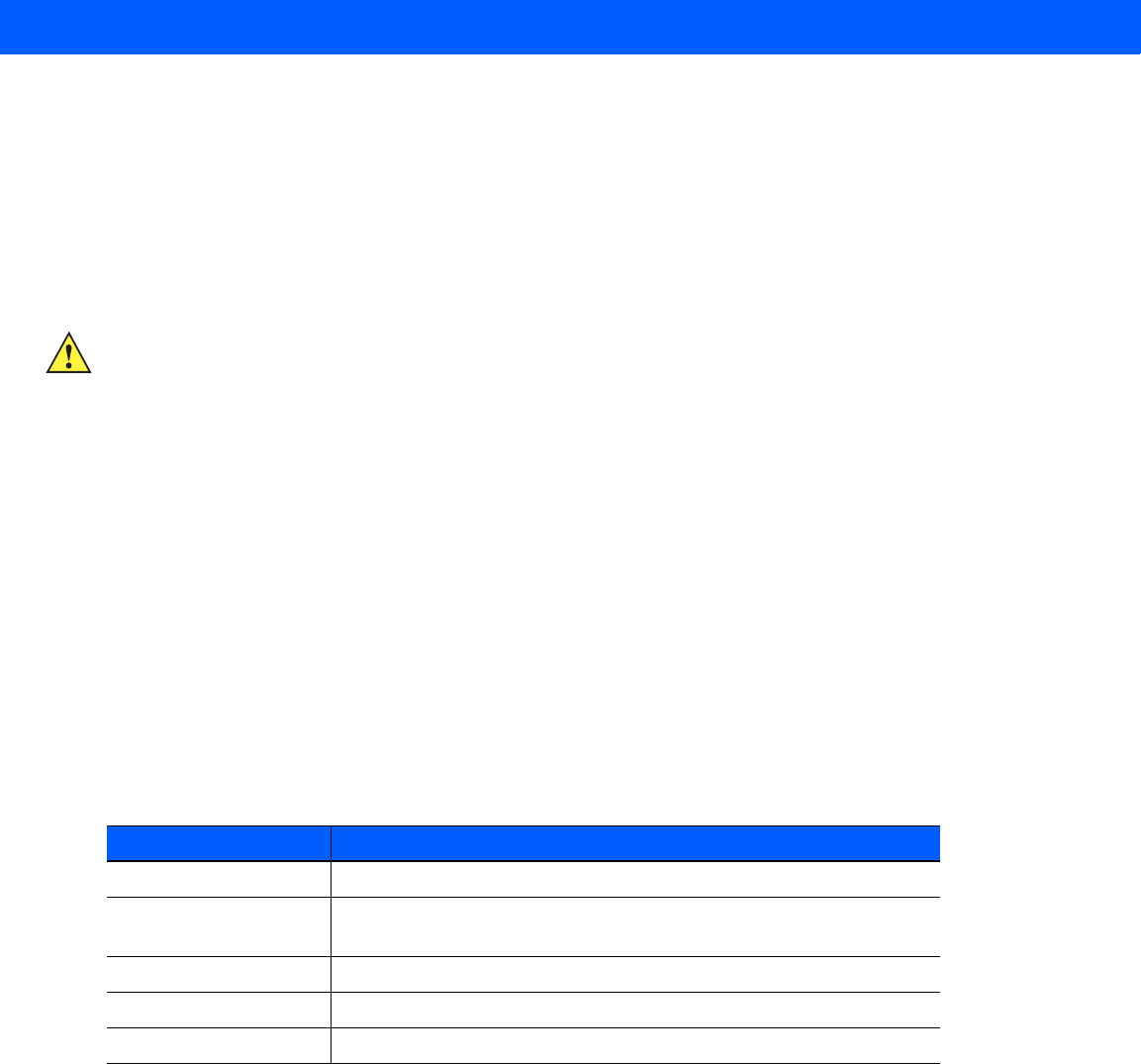
4 - 24 Omnii Hand-Held Computer with Windows CE 6.0 User Guide
ature range. For maximum performance, it is recommended that the charger be operated at room temperature
— a temperature range between 18°C to 25°C (64°F to 77°F).
The charger can consume up to 6 A at 120 VAC, 3A at 240 VAC. Check to ensure the mains circuit supplying
the charger is adequate for this loading (especially if several chargers are being powered from the same
circuit). After unpacking the unit:
• Visually check the charger for damage.
• Install the IEC power cord and apply power.
All charge indicators flash momentarily at power up to indicate that the charger is ready for operation.
If you choose to wall mount the charger, detailed installation instructions are included in the Omnii 6-Slot
Battery Charger ST3006 Quick Start Guide (PN 8000204) included with the charger kit. Be sure to locate the
charger in an area where there is no risk of injury to persons walking in the vicinity.
Operator Controls
The gang charger does not have operator controls or a power switch. There is no dedicated indicator light to
show that the charger is powered, but the charge slot LEDs will light up briefly when first applying power.
Charge Indicators
Each battery charge slot is equipped with four LEDs to indicate the charge status of the battery. When the
Omnii batteries are inserted in the charger, the colour and behaviour of the LEDs associated with the charging
bays in use indicate the status of the charge.
Charging Batteries
• Install the battery with the battery contacts facing the charger. Slide the battery between the guide rails
until it lightly latches in place.
The 4-LED bar for the battery bay shows 25% charger per LED. A flashing green LED shows charging is under
way. The LED directly below the slot in which a battery is inserted lights up immediately. If the battery tempera-
ture is outside 0°C to 40°C (32°F to 104°F), the LED flashes yellow until the temperature is acceptable. A fully
discharged battery will normally take 4.5 hours to charge. At full capacity, it turns solid green.
When the battery is fully charged, the charger stops applying power; the battery cannot be overcharged if left in
the charger slot.
IMPORTANT Use IEC-320 C13 power cords approved by Motorola, with the ground pin connected to a
proper earth-grounded receptacle. Check with a qualified electrician if you are uncertain
of your receptacle grounding.
Charge LED Behaviour Function
OFF No battery detected.
Solid Green Battery charging complete. Each LED represents 25% battery
capacity.
Flashing Green Charge in progress. Each LED represents 25% battery capacity.
Flashing Yellow Battery is not charging due to out-of-temperature conditions.
Solid Red Unable to read battery, charging timeout, or non Motorola battery.
Draft #4 for review

Accessories 4 - 25
Troubleshooting
Improper Battery Storage
Storing batteries in the gang charger for extended periods (more than a week or two) is not recommended.
Lithium-ion batteries lose capacity if they are maintained at full charge for long periods of time. See the battery
handling recommendations in The Battery on page 1-4.
Power Self-test LEDs Don’t Light Up
The charge slot LEDs will light up briefly when first applying power indicating the self-test mode. When
applying power to the unit, all the LEDs will light up. Yellow will show up in the 25% LED for each bay; green for
other LEDs. Then bay #1 will blink a binary representation of the firmware version (V09 = 1001). If the self-test
is not evident:
• Remove all batteries, and unplug the charger.
• Connect another device to the mains outlet to ensure there is power.
• Remove the IEC mains power cable from the charger, and check it for damage.
• Reconnect the mains cable in the charger and mains outlet.
Indicator Does Not Light When Battery Installed
• Remove the battery, and clean the contacts on the battery and the charge slot.
• Reinstall the battery, and check that it is fully seated in the slot.
• Inspect the charge slot contacts for damage (are they bent, flattened, twisted or broken).
• Try inserting a battery that you know to be working in the charger slot.
• Reconnect the mains power cable, and check that the slot indicator flashes at power up.
Draft #4 for review
Draft #4 for review
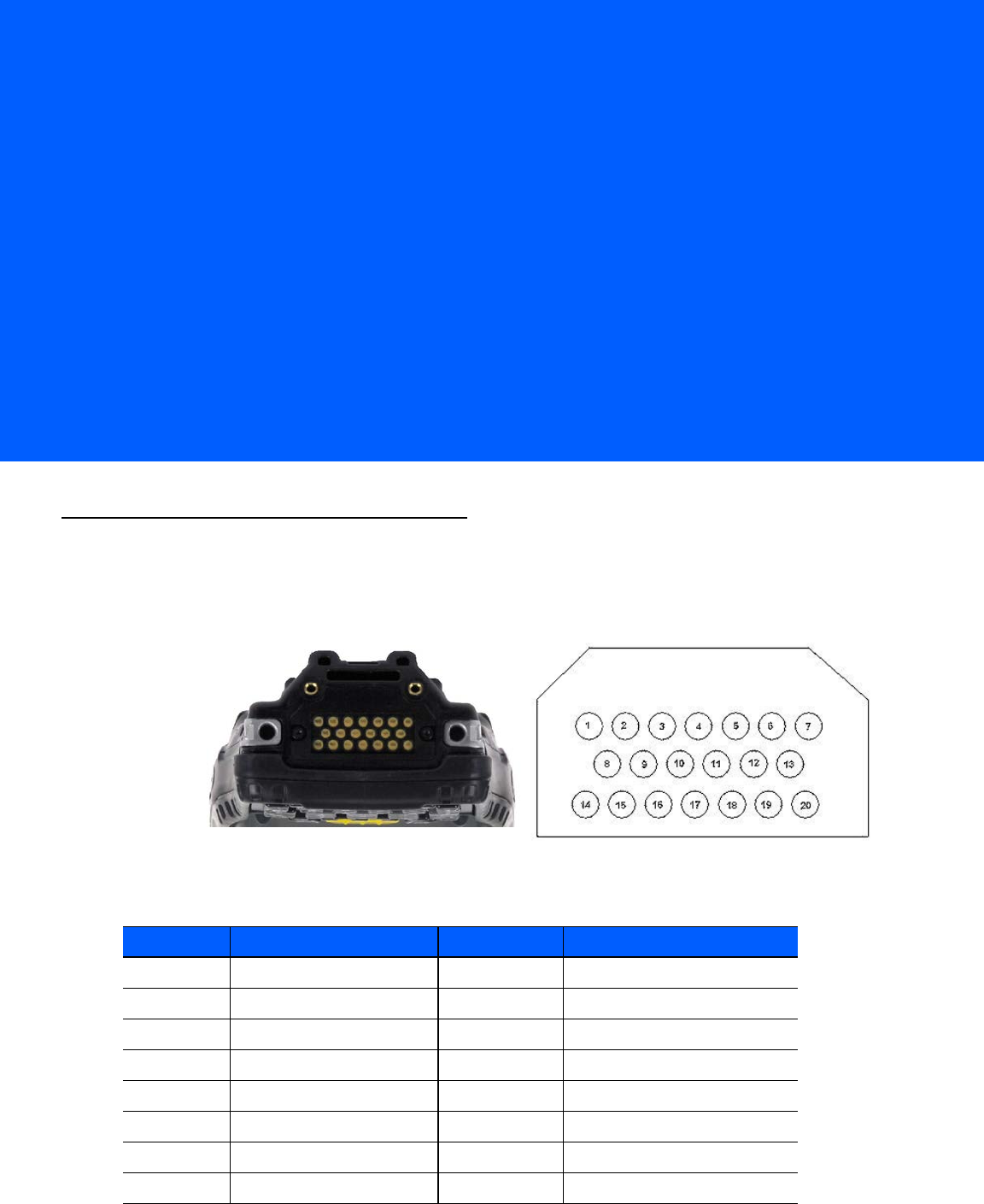
APPENDIX A PORT PINOUTS
APort Pinouts
Omnii Docking Connector
The docking interface on the base of the Omnii is custom-designed to dock with a device via an array of
spring-mounted pins.
The following are the pin assignments of the interface.
Pin # Signal Pin # Signal
1 GROUND 11 USB_OTG_P
2 DC_IN 12 USB_OTG_M
3 DOCK_LOW_PWR 13 CHARGE_IN
4 GROUND 14 GROUND
5 USB_OTG_VBUS 15 DC_IN
6 CHARGE_IN 16 UART_RX
7 GROUND 17 GROUND
8DC_IN 18 UART_TX
Draft #4 for review
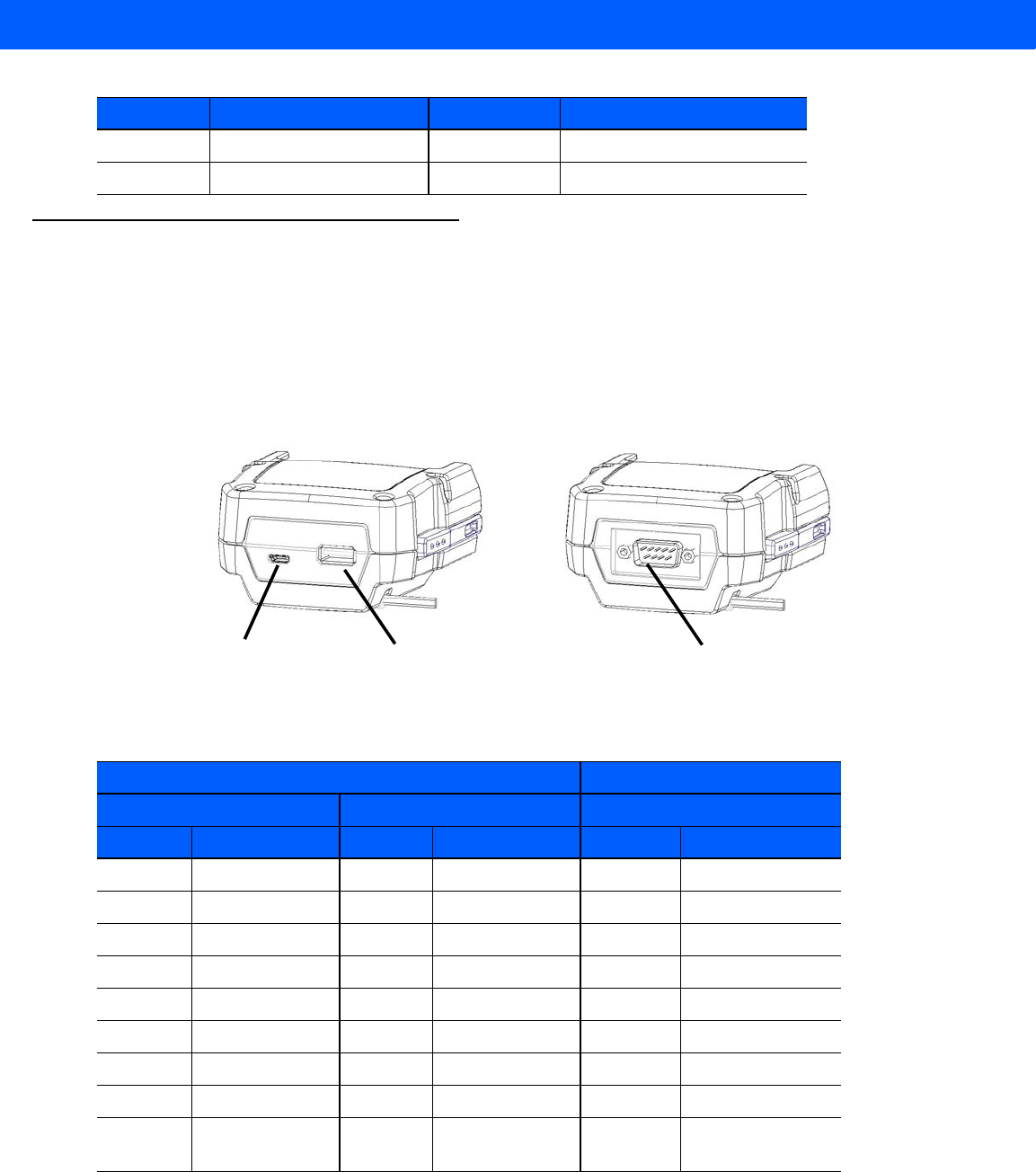
A - 2 Omnii Hand-Held Computer with Windows CE 6.0 User Guide
Snap Modules Connectors
•Model ST4000 (Charger only variant): power and charge.
•Model ST4001 (USB Host/Client variant): power, charge, communications via USB 1.1/2.0 Host and USB
2.0 Client connectors, DC IN port.
•Model ST4005 (DE9M Serial variant): powered DE9M serial connector, power, charge, serial communica-
tions. Pin 9 is reserved for 5V 1A max power out and is defaulted to off.
The following are the pin assignments of the interfaces.
9 USBH_P 19 CHARGE_DATA
10 USBH_M 20 GROUND
Pin # Signal Pin # Signal
ST4001 ST4005
USB Micro B Connector USB Type A Connector DE9M Serial Connector
Pin # Signal Pin # Signal Pin # Signal
1 VBus 1 VBus 1 DCD
2D- 2D- 2 RXD
3D+ 3D+ 3 TXD
4 ID 4 GROUND 4 DTR
5 GROUND 5 SHIELD 5 GROUND
6 SHIELD 6 DSR
7RTS
8CTS
9 5Vdc 1A power
out
ST4001 ST4005
USB Type A connector
USB Micro B connector
(USB host)
(USB device/ActiveSync) Powered DE9M serial port
Draft #4 for review
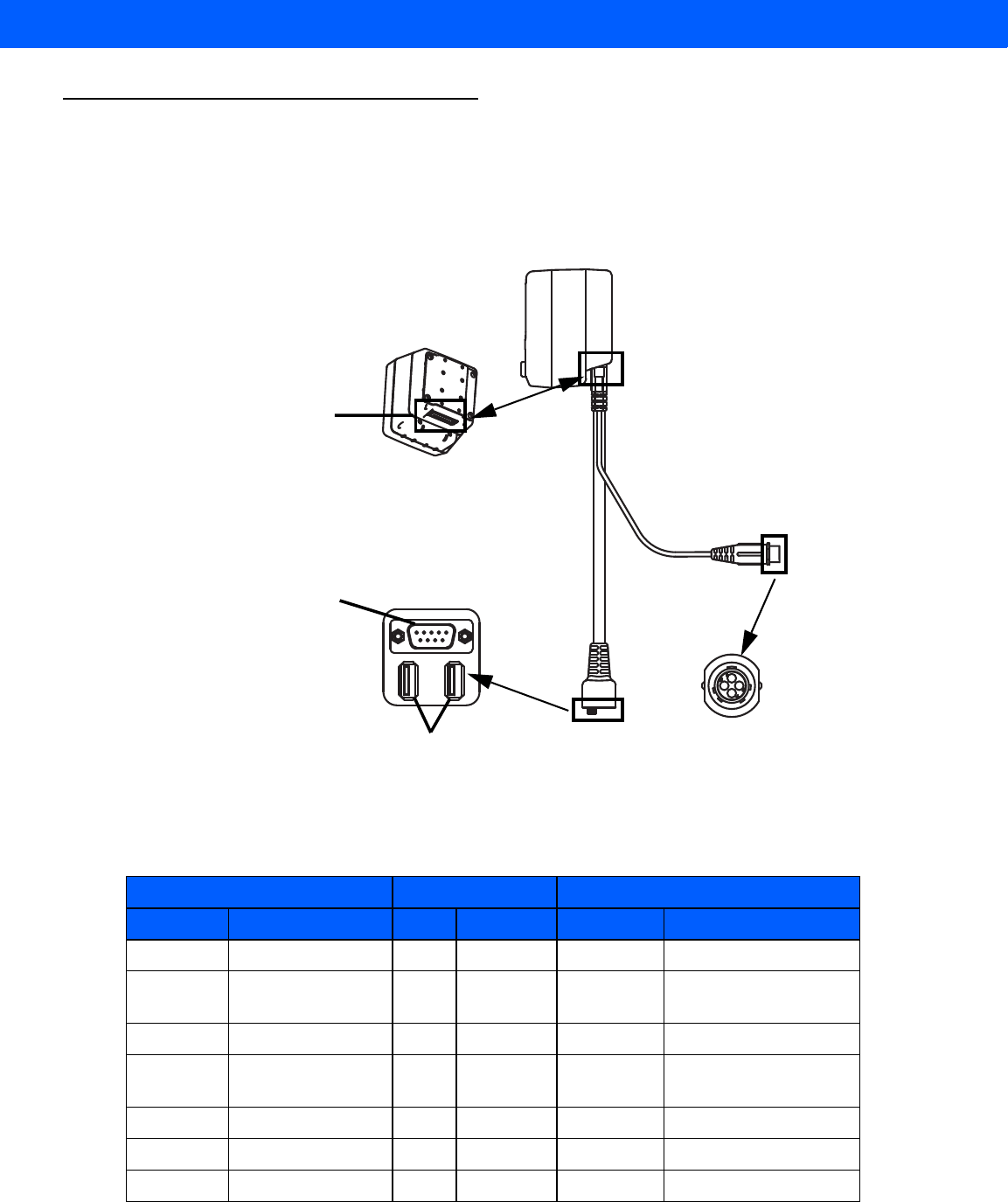
Port Pinouts A - 3
Cable Connectors for Vehicle Cradle Model ST1002
• The ST1002 Vehicle Cradle has a 44-pin connector that allows connection with either the CA3001 Vehicle
Cradle Power and Communications Cable (DE9M serial port, 2 USB Host interfaces, and power cable) or
the power-only CA3000 Vehicle Cradle Power Cable. For installation details, see ST1002 Powered Cradle
Installation on page 4-20.
The following are the pin assignments of the interfaces.
DE9M Serial USB Type A Power
Pin # Signal Pin # Signal Pin # Signal
1 DCD 1 VBus 1 VIN (11.5 to 30Vdc)
2 RXD 2 D- 2 GND (not chassis
ground)
3 TXD 3 D+ 3 MOTION DETECT
4DTR 4DGROUN
D 4 MOTION DETECT
RETURN (not ground)
5 GROUND
6DSR
7RTS
44-pin connector
CA3001 Vehicle Cradle Power and
Communications Cable
ST1002 Vehicle Cradle
USB Type A connectors
(USB host)
DE9M serial port
Power connector
Draft #4 for review
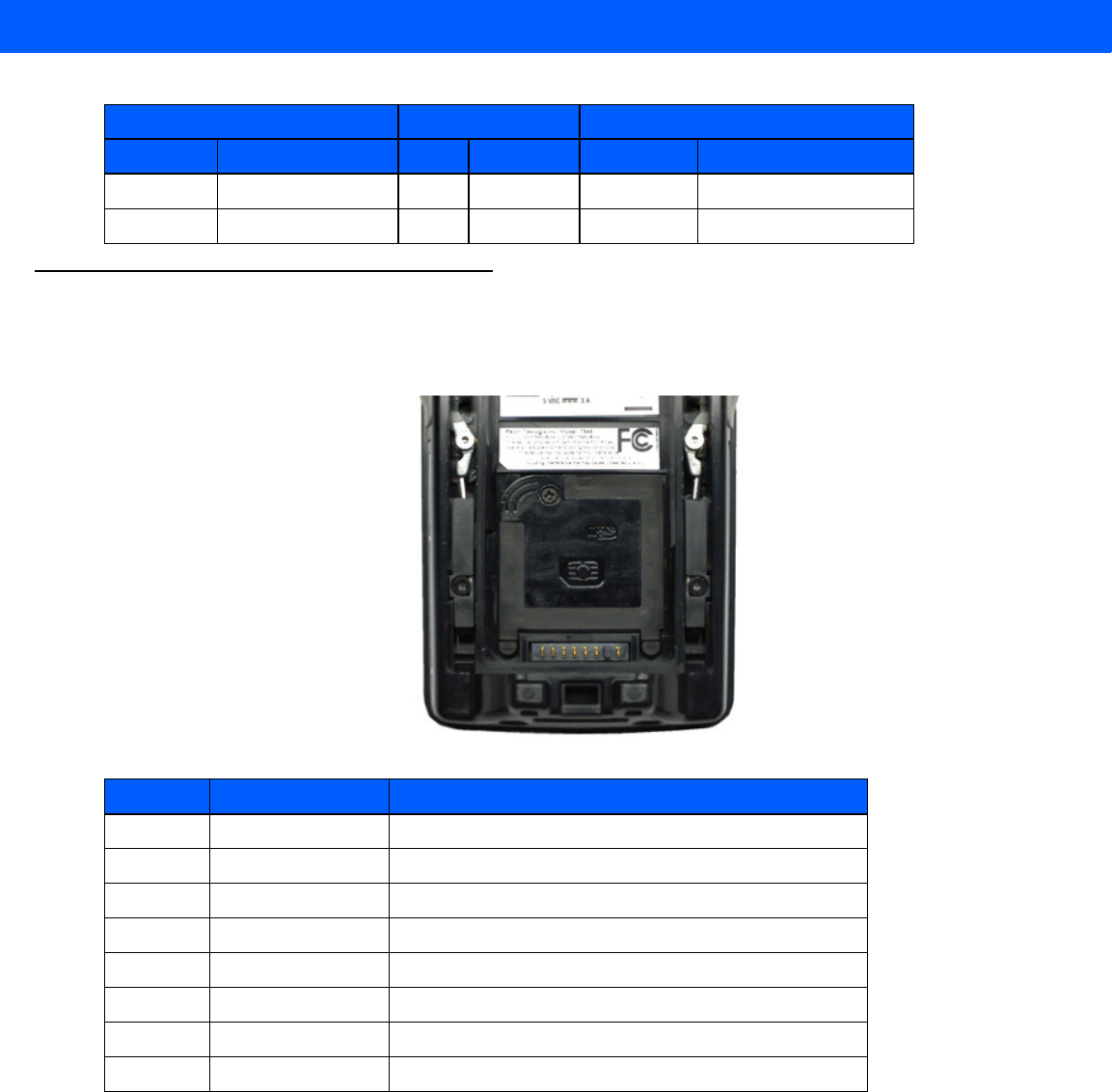
A - 4 Omnii Hand-Held Computer with Windows CE 6.0 User Guide
Omnii Battery Contacts
Figure A-1
Battery Contact Pinout
8CTS
9 5Vdc 1A power out
DE9M Serial USB Type A Power
Pin # Signal Pin # Signal Pin # Signal
Pin # Signal Name Description
1 BATT+ Positive lead of battery.
- Plastic Rip - provides mechanical polarity.
2 BATT+ Positive lead of battery.
3 BATT-CLK SMBus data clock.
4 BATT-ID Connected to GND in the battery.
5 BATT-DATA SMBus bi-directional data line.
6 GND Negative lead of battery.
7 GND Negative lead of battery.
7 6 5 4 3 2 1
Draft #4 for review

APPENDIX B IMAGER & CAMERA SETTINGS
BImager & Camera Settings
Introduction
The Imagers applet is used to create, modify, delete, and activate imager settings. The principal uses of the
application are to decode barcodes and to capture images. This imager services application is used for
cameras and imagers to configure linear (1D), stacked linear, matrix (true 2D) and postal barcodes.
ADemonstration Application is provided to demonstrate how the imager works. Refer to Demo on page 2-21
for details.
Required Applets
In order to configure imaging, the Manage Triggers applet must be present in the Control Panel, along with the
Imagers applet.
Presets
There are two methods that can be used to configure an imager using the Imagers applet:
• Use a predefined preset.
• Create a custom preset based on a predefined preset.
NOTE The Imagers icon is only displayed when the appropriate imager is installed in your Omnii. If there
is an imager installed but this icon is not present, additional software (ICS) may need to be
installed.
To enable a newly-installed imager, press and hold down the [FN] key and the [Enter/Power]
key simultaneously for a minimum of three seconds.
IMPORTANT It is strongly recommended that a predefined preset is used whenever possible. Each
predefined preset contains a coherent group of settings that are known to work together
in the intended environment. In almost all situations, at least one of the predefined
presets results in a satisfactory outcome.
Draft #4 for review

B - 2 Omnii Hand-Held Computer with Windows CE 6.0 User Guide
A preset is a group of exposure and image correction settings. Each preset configures the imager for a specific
purpose such as barcode decoding or image capture.
Presets also allow easier and faster configuration of the imager after power-on or resume from suspend.
The predefined presets are generic and satisfy most user requirements. A custom preset can be created for a
specific user application, such as: include only specified barcodes, read only a specified number of barcodes
or for reading unusual media.
Every preset belongs to a preset type. The following preset types are available:
• Imaging for photo capture.
• Imaging for barcode decoding.
• Symbology selection.
At any time, only one preset of each type can be designated as the user-selected active preset.
Predefined Presets
Predefined presets are built into the imaging software and cannot be changed. The predefined presets allow
you to use the imager to perform specified tasks without having to understand and set numerous variables. In
almost all cases these predefined presets are sufficient.
Barcode Predefined Presets (Barcoding Menu)
These presets encompass the majority of the most popular barcodes and their subtypes. The barcode
decoding symbology predefined presets define which barcodes can be decoded. The barcode decoding
camera predefined presets determine how the barcode images are captured.
Barcode Decoding Symbology Predefined Presets
The following presets select groups of similar barcodes for decoding.
My Default
This preset uses the Symbology Settings menu to define the preset. For details about the Symbology Settings
menu, refer to Barcoding Menu – Configuring Symbologies on page B-12.
Factory Default
This preset enables the decoding of frequently used barcodes.
All
This preset enables the decoding of all barcodes that the imager can decode.
Linear
This preset enables the decoding of all the 1D symbologies that the imager can decode.
Linear and PDF417
This preset enables the decoding of all the 1D and PDF symbologies that the imager can decode.
Matrix
This preset enables the decoding of all 2D symbologies that the imager can decode.
NOTE It is recommended that the default preset be used whenever possible.
Draft #4 for review
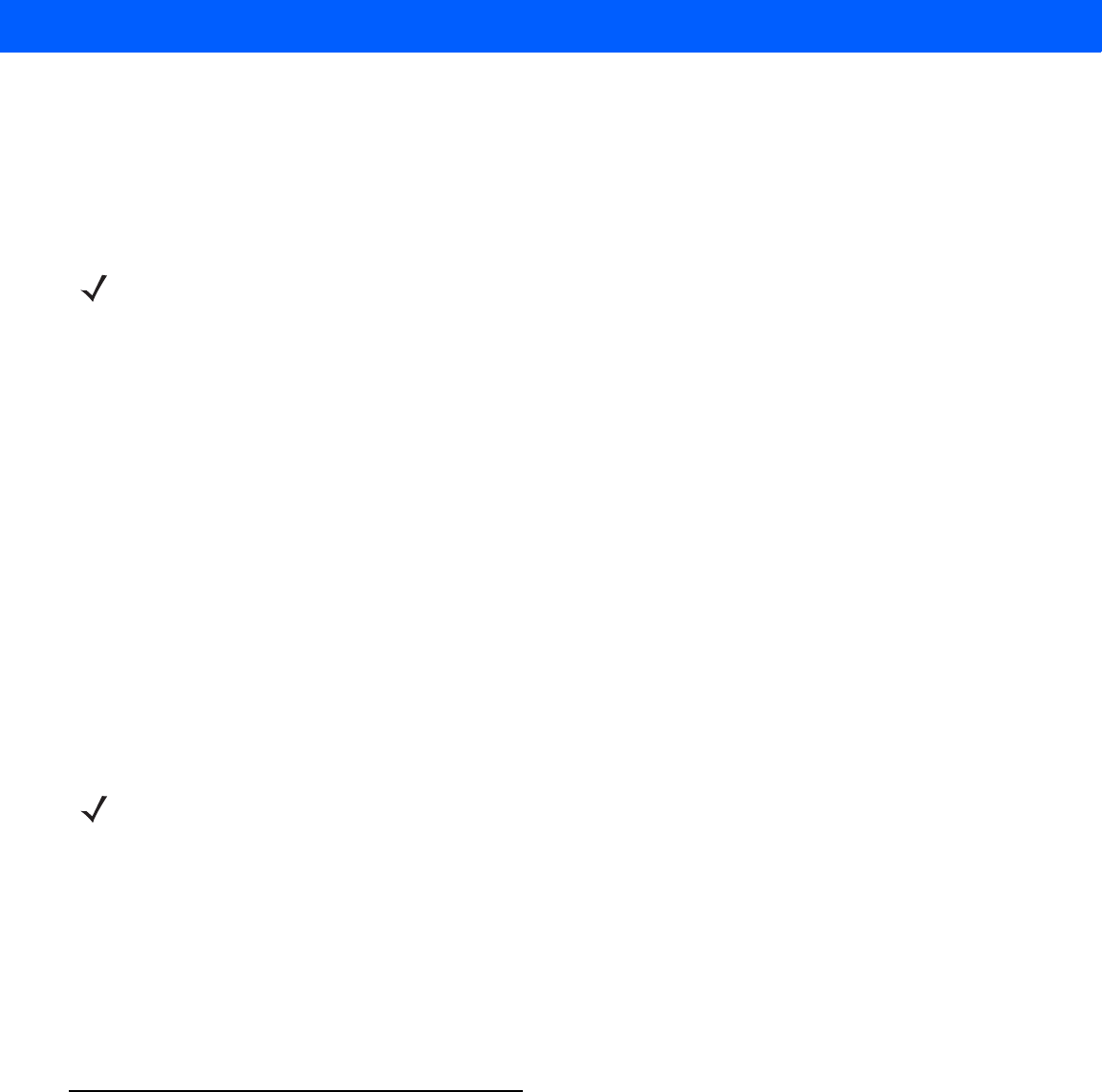
Imager & Camera Settings B - 3
Postal
This preset enables the decoding of all the postal symbologies that the imager can decode.
Barcode Decoding Camera Predefined Presets
The following presets enable successful barcode image capture in almost all conditions.
Default
This preset works in a wide range of conditions. It is optimized for a normal office lighting (about 300 Lux).
Low Light
This preset is designed for very dark conditions such as inside a warehouse where the lights are kept low, or
inside an unlit truck. This preset increases either the exposure time or the gain.
Low Power
This preset minimizes the use of the flash so as to conserve the battery power on the hand-held.
Glossy Surface
This preset minimizes the use of the flash so as to reduce reflection. This preset is used to read barcodes that
are behind glass, or inside the plastic window of an envelope.
Image Capture Predefined Presets (Imaging Menu)
The following presets enable successful image capture in almost all conditions.
Default
This preset works in a wide range of conditions. It is optimized for a normal office lighting (about 300 Lux).
Motion
This preset uses a shorter exposure time so as to freeze motion.
Low Light Near
This preset is designed for dark conditions, it uses a longer exposure time and includes the flash.
Using the Imagers Applet
Configuring the Image Capture Presets (Imaging Menu)
To configure the image capture presets, open the dialog box as follows:
•Tap on Start>Settings>Control Panel.
• Tap on the Imagers icon, and if it’s not already selected, tap on the Imaging tab.
NOTE It is recommended that the default preset be used whenever possible.
NOTE It is recommended that the default preset be used whenever possible.
Draft #4 for review
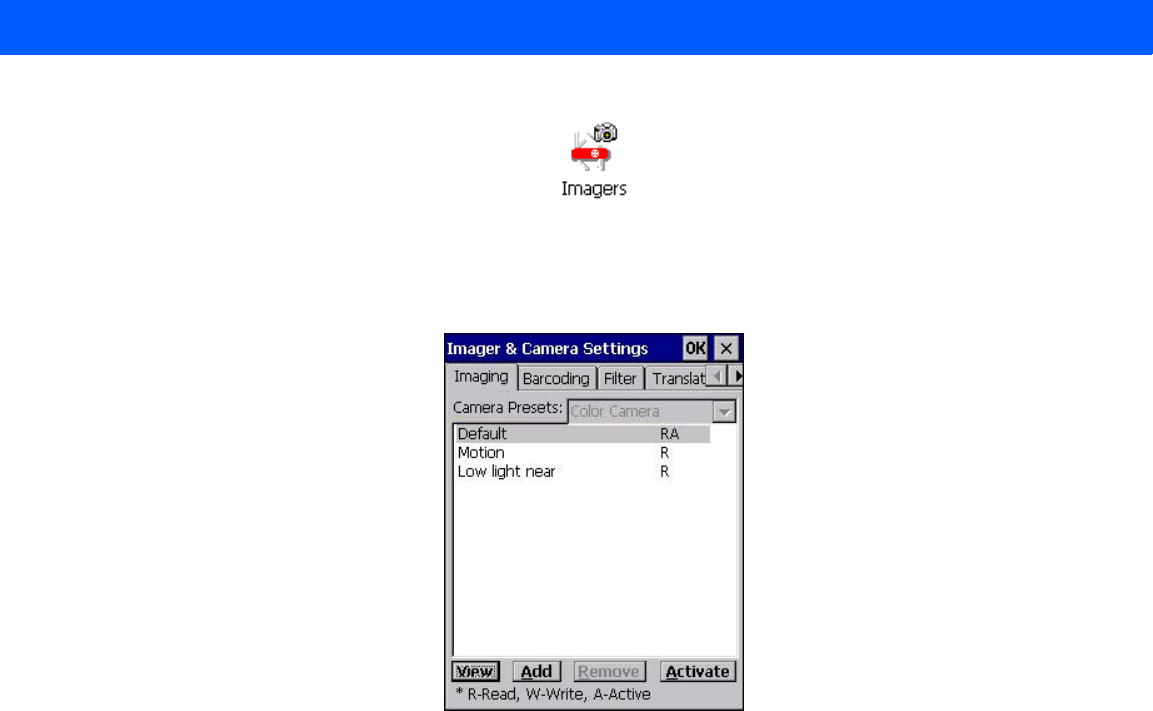
B - 4 Omnii Hand-Held Computer with Windows CE 6.0 User Guide
The following screen is displayed.
Figure B-1
Imaging Menu
This window lists all the presets, both predefined and custom. Presets are identified as follows:
• Predefined presets are marked as R read-only.
• Custom presets are marked as RW read and write.
• One preset — either predefined or custom — is marked as A active.
Selecting a Camera
To select a camera:
• Tap on the Camera Presets drop-down menu to view the camera options.
• Choose a camera — specifically, Front Imager which is located at the top of the unit.
Setting the Active Preset
An active preset has an A to the right. To set an active preset:
• Highlight the preset, and tap on the Activate button.
Viewing a Preset
To view the parameter settings in a preset:
• Highlight a preset, and double-tap on the View button.
The associated preset window is displayed.
Draft #4 for review
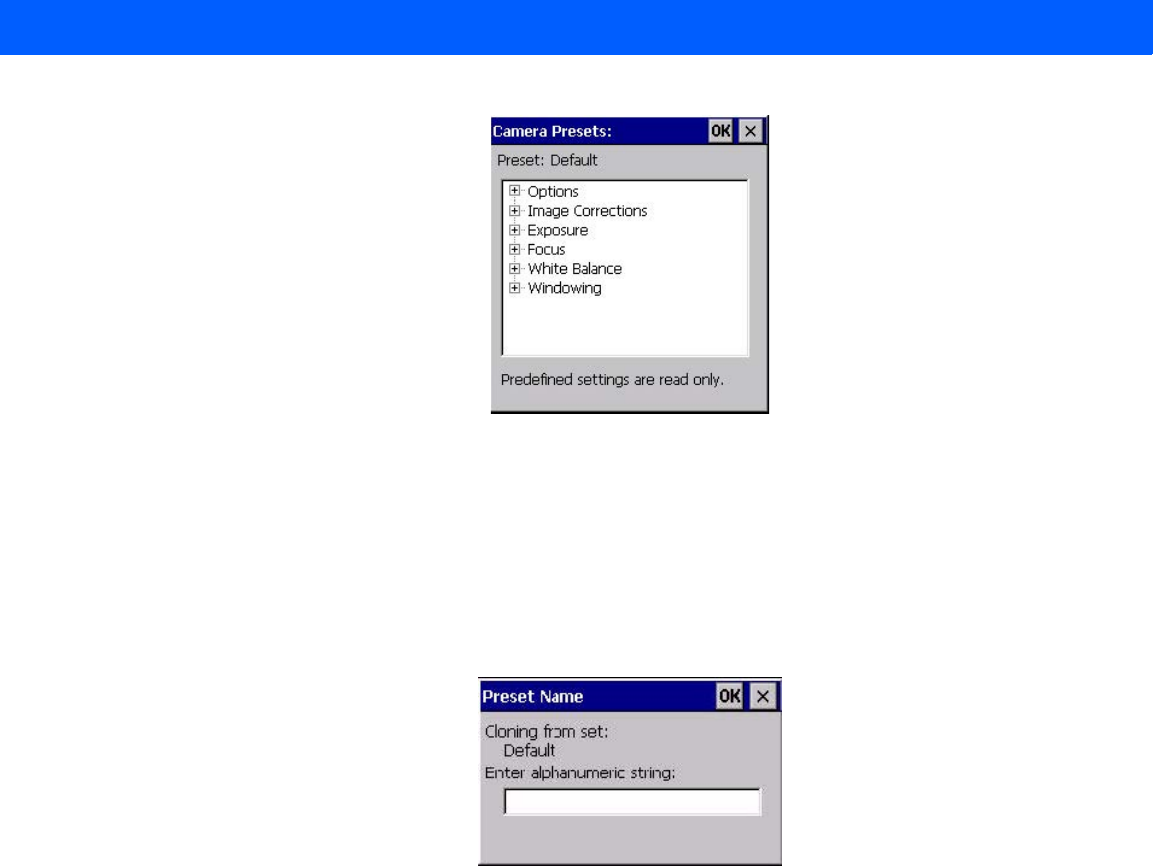
Imager & Camera Settings B - 5
• Tap on the + sign to expand the lists so that you can view the parameter settings.
Creating a Custom Preset
A new custom preset is created by modifying a preset — either a predefined preset or an existing custom
preset. To create a custom preset:
• Highlight a preset, and tap on the Add button.
A screen like the sample below is displayed.
• Type the name of the new preset in the dialog box.
•Tap on OK to save your changes.
The preset list is displayed; the new custom preset appears at the end of the list. It is marked as read
and write.
Modifying a Custom Preset
The parameter values in a custom preset can be modified. It is recommended that very few changes be made
to a custom preset. To ensure that it will work reliably, it should be as close as possible to the original prede-
fined preset. To change a parameter value:
• Highlight the custom preset, and double-tap on the Edit button.
Draft #4 for review
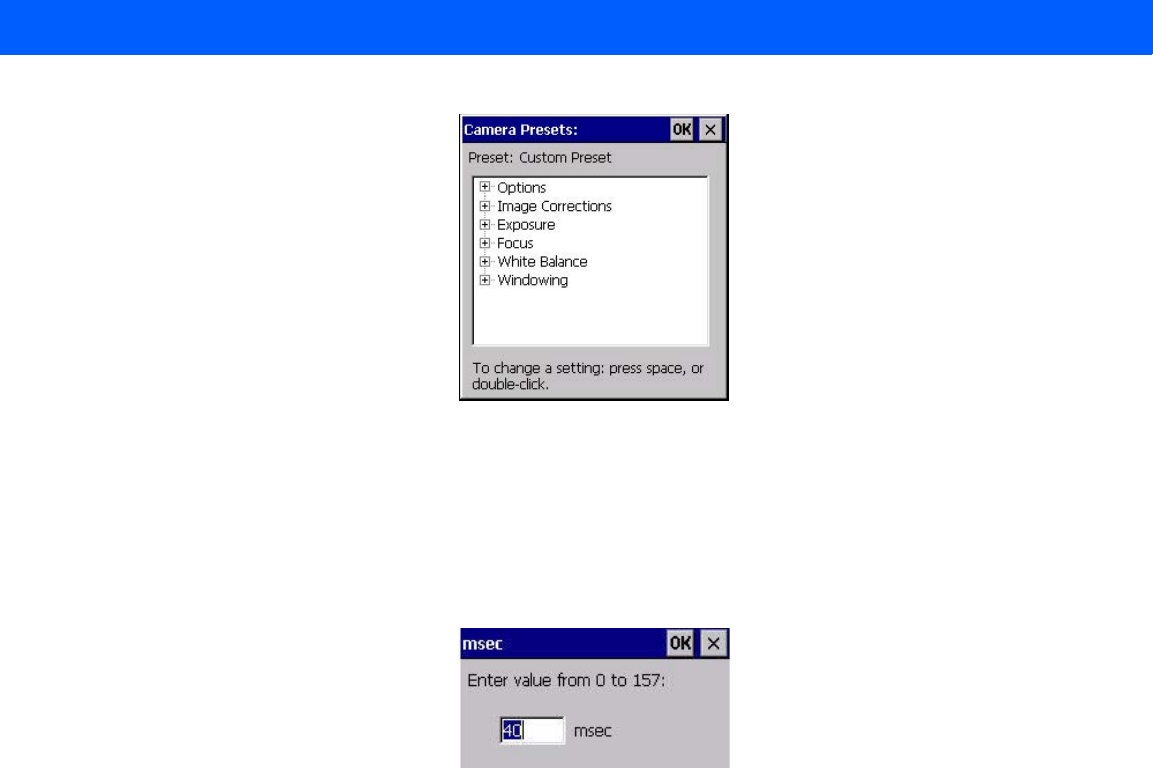
B - 6 Omnii Hand-Held Computer with Windows CE 6.0 User Guide
• Tap on the + symbols to expand the lists so that you can view the parameter settings.
• Scroll through the parameter list until you reach the parameter that you want to change.
• For a parameter that can take a range of values:
- Highlight the parameter, and then press the [SPACE] key or double-click on the parameter.
- An associated dialog box containing the valid range of values for the parameter and the current setting
like the sample screen following is displayed.
- Type a value in the field provided.
• For a parameter that toggles between two values such as on or off and enabled or disabled:
- Highlight the parameter and then press the [SPACE] key, or double-click on the parameter. Either
method toggles between the two available values.
• When you’ve completed your edits, tap on OK.
The parameter list is displayed; the new value for the changed parameter is shown.
•Tap on OK to exit to the preset list and save the changes.
Removing a Custom Preset
• Highlight the custom preset you want to delete, and tap on the Remove button.
A window is displayed warning you that you are about to remove a preset.
•Tap on Yes to remove the preset or No to cancel the operation.
Configuring the Barcode Decoding Camera Presets (Barcoding Menu)
To configure the barcode decoding camera presets:
•Tap on Start>Settings>Control Panel>Imagers.
• Tap on the Barcoding tab.
Draft #4 for review
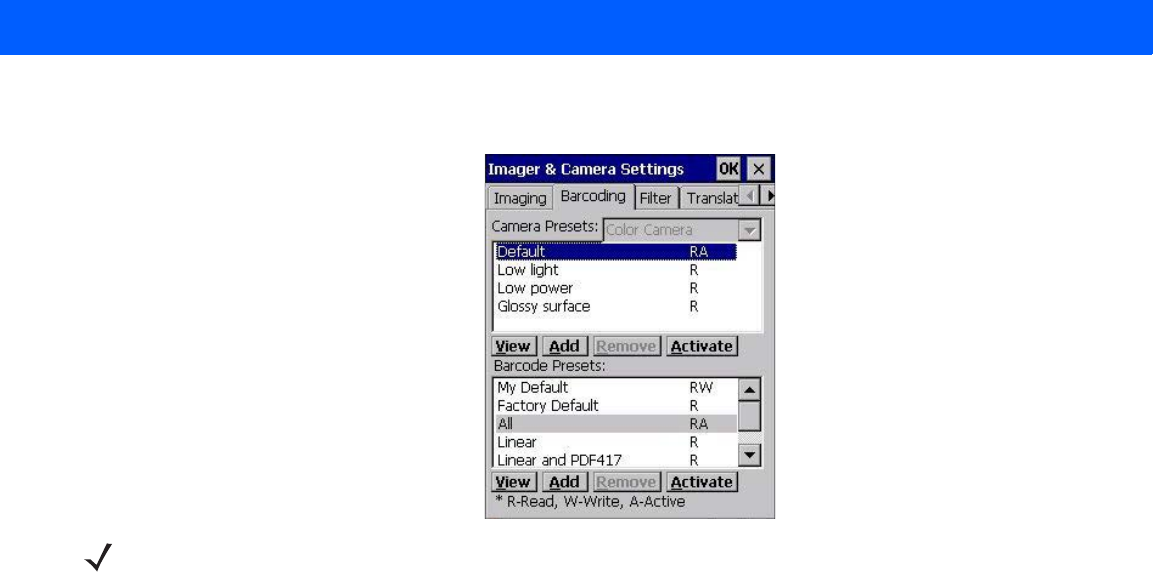
Imager & Camera Settings B - 7
Figure B-2
Camera Presets
This window lists all the presets, both predefined and the custom. Presets are identified as follows:
• Predefined presets are marked as read-only. For a description, review Predefined Presets on page B-2.
• Predefined presets are marked as R read-only.
• Custom presets are marked as RW read and write.
• One preset — either predefined or custom — is marked as A active.
Selecting a Camera
To select a camera:
• Tap on the Camera Presets drop-down menu to view the camera options.
• Choose a camera — specifically, Front Imager which is located at the top of the unit.
Setting the Active Preset
An active preset has an A to the right; in Figure B-3 Viewing Barcode Decoding Symbologies on page B-10,
the active preset is Default. To set an active preset:
• Highlight the preset, and tap on the Activate button.
Viewing a Preset
To view the parameter settings in a preset:
• Highlight a preset, and double-tap on the View button.
The associated preset window is displayed.
NOTE The top portion of the window displays the barcode decoding camera presets.
Draft #4 for review
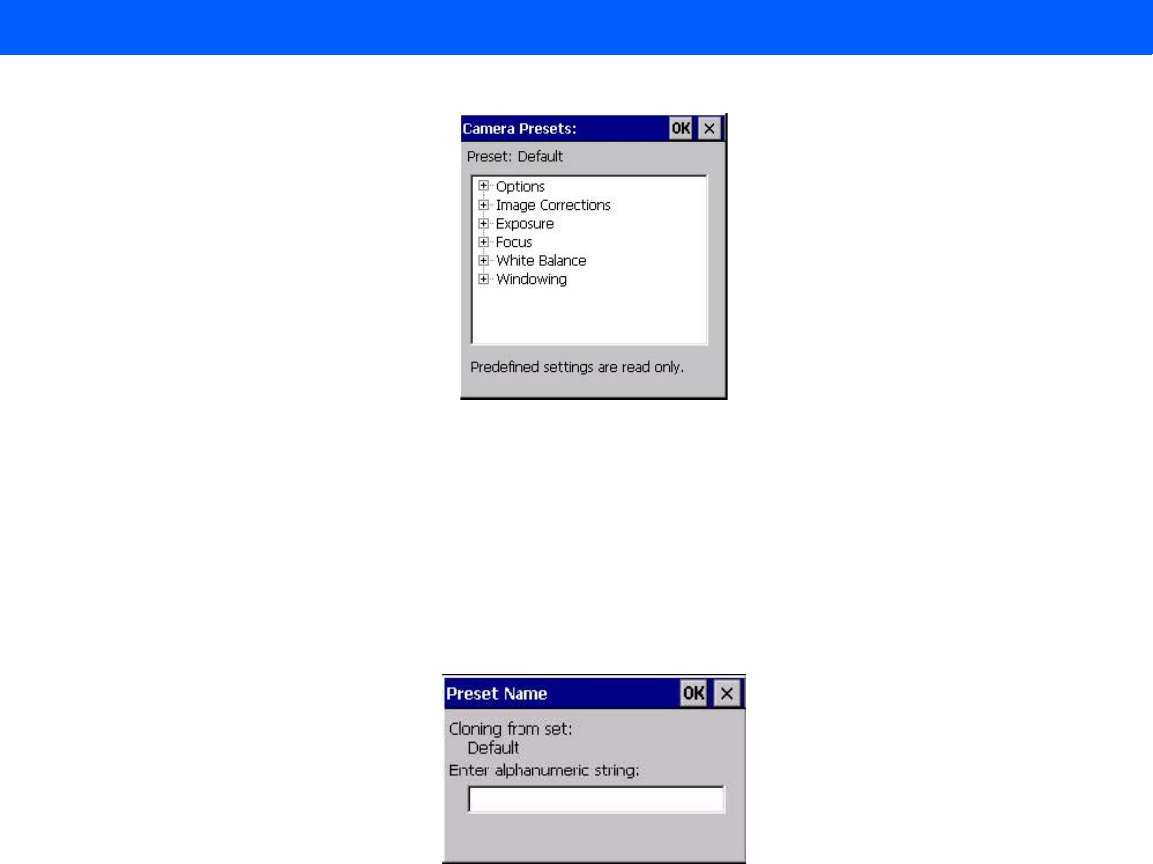
B - 8 Omnii Hand-Held Computer with Windows CE 6.0 User Guide
• Tap on the + sign to expand one of the lists so that you can view the parameter settings.
Creating a Custom Preset
A new custom preset is created by modifying a preset — either a predefined preset or an existing custom
preset. To create a custom preset:
• Highlight a preset, and tap on the Add button.
A screen like the sample following is displayed.
• Type the name of the new preset in the dialog box.
•Tap on OK to save your changes.
The preset list is displayed; the new custom preset appears at the end of the list. It is marked as read
and write.
Modifying a Custom Preset
The parameter values in a custom preset can be modified. It is recommended that very few changes be made
to a custom preset. To ensure that it will work reliably, it should be as close as possible to the original prede-
fined preset. To change a parameter value:
• Highlight the custom preset, and double-tap on the Edit button.
Draft #4 for review
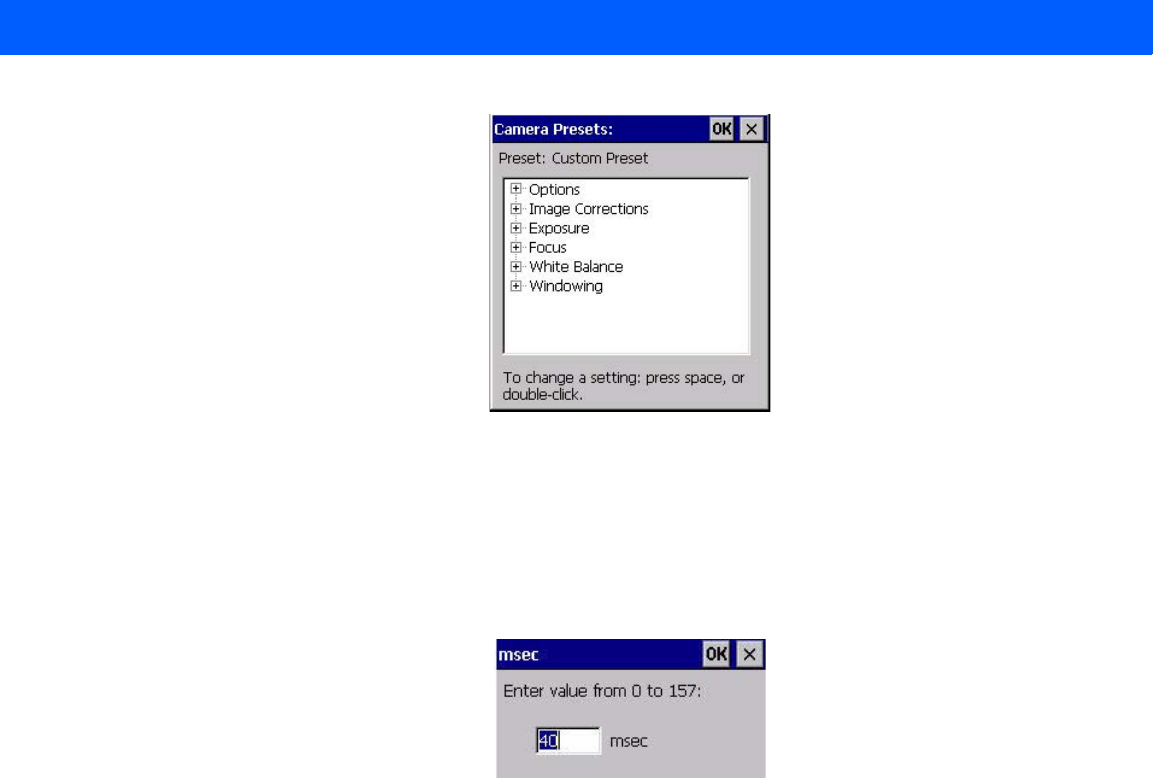
Imager & Camera Settings B - 9
• Tap on the + symbols to expand the lists and view the parameter settings.
• Scroll through the parameter list until you reach the parameter that you want to change.
• For a parameter that can take a range of values:
- Highlight the parameter, and then press the [SPACE] key or double-click the parameter.
- An associated dialog box containing the valid range of values for the parameter and the current setting
like the sample screen following is displayed.
- Type a value in the field provided.
• For a parameter that toggles between two values such as on or off and enabled or disabled:
- Highlight the parameter and then press the [SPACE] key, or double-click on the parameter. Either
method toggles between the two available values.
• When you’ve completed your edits, tap on OK.
The parameter list is displayed; the new value for the changed parameter is shown.
•Tap on OK to exit to the preset list and save the changes.
Removing a Custom Preset
• Highlight the custom preset you want to delete, and tap on the Remove button.
A window is displayed warning you that you are about to remove a preset.
•Tap on Yes to remove the preset or No to cancel the operation.
Configuring the Barcode Decoding Symbologies (Barcoding Menu)
To configure the barcode decoding camera presets:
•Tap on Start>Settings>Control Panel>Imagers.
Draft #4 for review
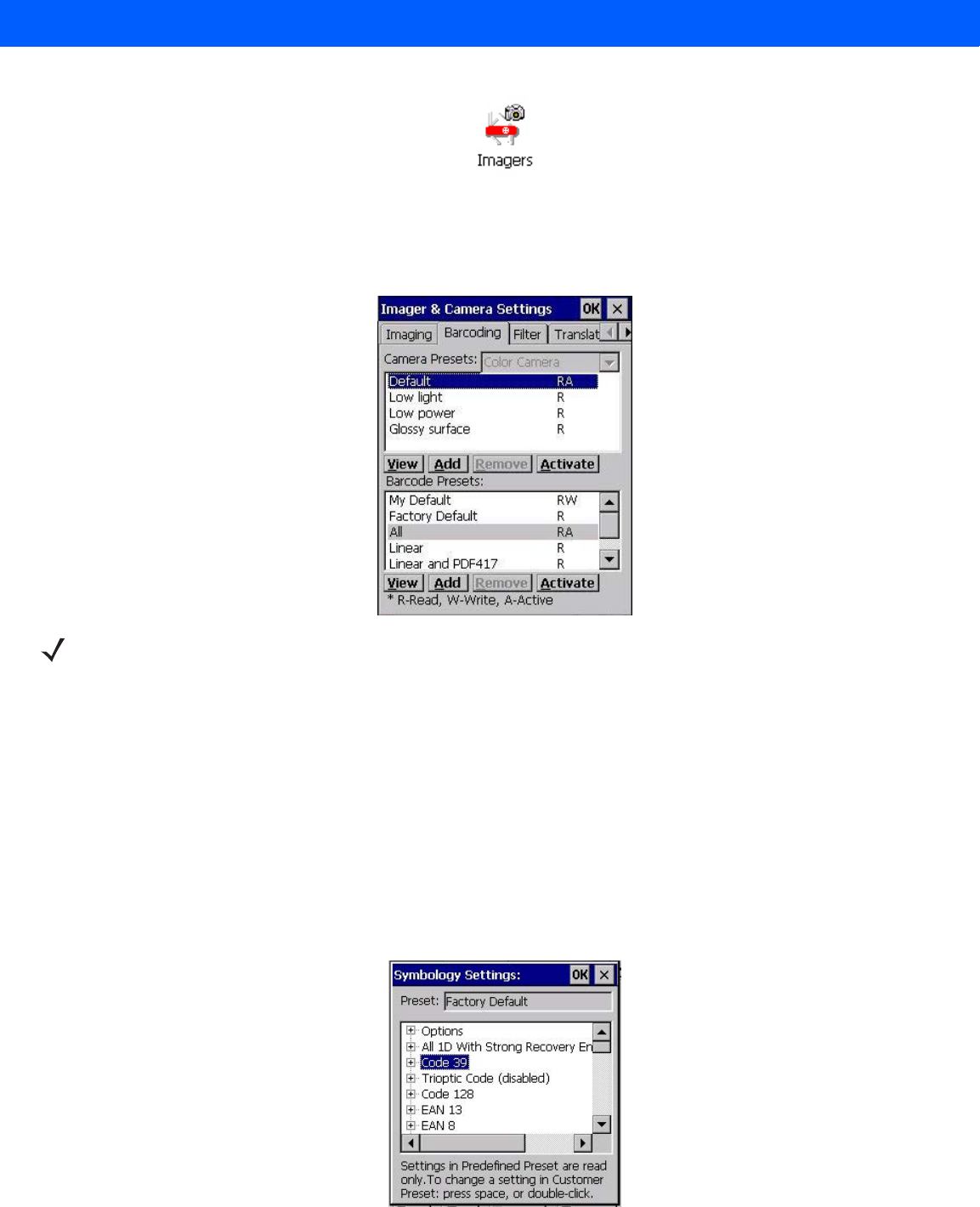
B - 10 Omnii Hand-Held Computer with Windows CE 6.0 User Guide
• Tap on the Barcoding tab.
Figure B-3
Viewing Barcode Decoding Symbologies
Setting the Active Preset
An active preset has an A to the right; in Figure B-3 Viewing Barcode Decoding Symbologies on page B-10,
the active preset is Default. To set an active preset:
• Highlight the preset, and tap on the Activate button.
Viewing a Preset
To view the parameter settings in a preset:
• Highlight a preset, and double-tap on the View button.
The associated preset window is displayed.
NOTE The bottom portion of the window displays the barcode decoding barcode presets.
Draft #4 for review
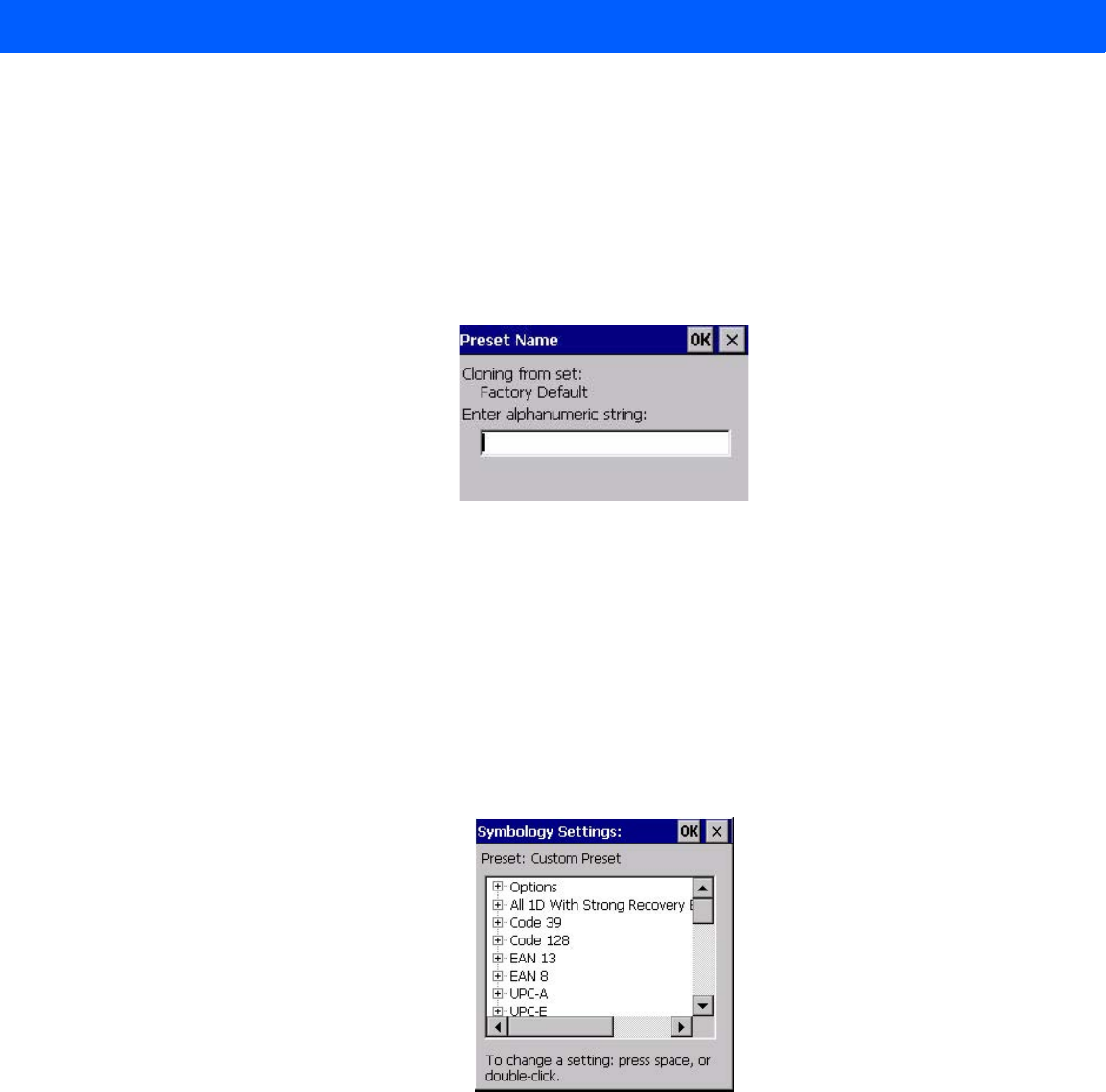
Imager & Camera Settings B - 11
• Tap on the + sign to expand one of the lists so that you can view the parameter settings.
Creating a Custom Preset
A new custom preset is created by modifying a preset — either a predefined preset or an existing custom
preset. To create a custom preset:
• Highlight a preset, and tap on the Add button.
A screen like the sample following is displayed.
• Type the name of the new preset in the dialog box.
•Tap on OK to save your changes.
The preset list is displayed; the new custom preset appears at the end of the list. It is marked as read
and write.
Modifying a Custom Preset
The parameter values in a custom preset can be modified. It is recommended that very few changes be made
to a custom preset. To ensure that it will work reliably, it should be as close as possible to the original prede-
fined preset. To change a parameter value:
• Highlight the custom preset, and double-tap on the Edit button.
• Tap on the + symbols to expand the lists and view the parameter settings.
• Scroll through the parameter list until you reach the parameter that you want to change.
• For a parameter that can take a range of values:
- Highlight the parameter, and then press the [SPACE] key or double-click the parameter.
- An associated dialog box containing the valid range of values for the parameter and the current setting
like the sample screen following is displayed.
Draft #4 for review
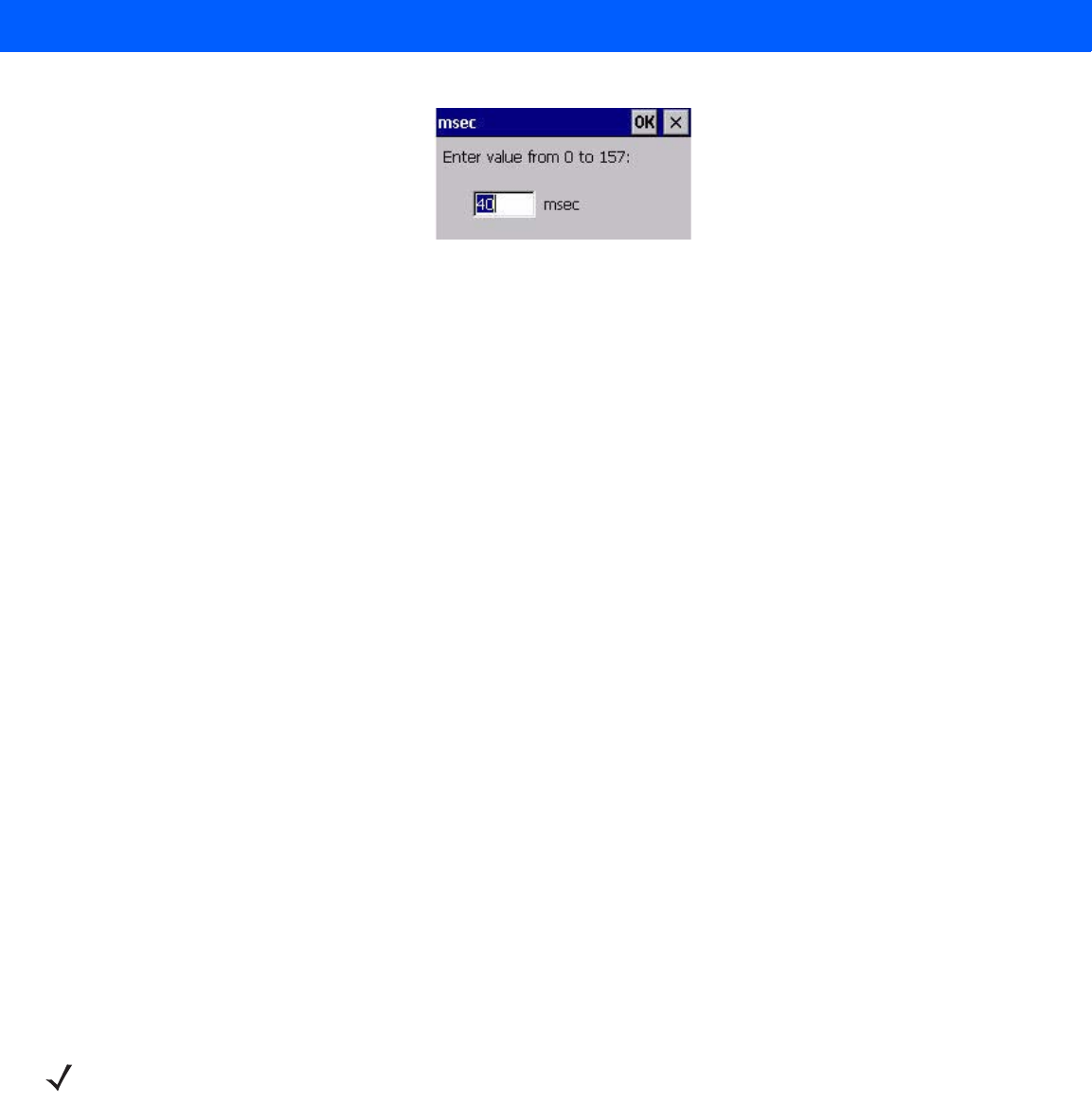
B - 12 Omnii Hand-Held Computer with Windows CE 6.0 User Guide
- Type a value in the field provided.
• For a parameter that toggles between two values such as on or off and enabled or disabled:
- Highlight the parameter and then press the [SPACE] key, or double-click on the parameter. Either
method toggles between the two available values.
• When you’ve completed your edits, tap on OK.
The parameter list is displayed; the new value for the changed parameter is shown.
•Tap on OK to exit to the preset list and save the changes.
Removing a Custom Preset
• Highlight the custom preset you want to delete, and tap on the Remove button.
A window is displayed warning you that you are about to remove a preset.
•Tap on Yes to remove the preset or No to cancel the operation.
Barcoding Menu – Configuring Symbologies
To view the Symbology Settings options:
• Tap on the Barcoding tab, highlight All and then double-tap the View button.
To edit a default preset, you must first activate it:
•Tap on My Default, and tap on the Activate button – an A appears to the right of My Default.
Once the preset is activated, you can enable or disable the barcodes the imager will read.
• Highlight My Default in the Barcoding tab.
• Double-tap on the Edit button.
None of the other barcode decoding predefined presets are changed.
Symbology Settings
Filter Menu – Manipulating Barcode Data
To configure rules for manipulating barcode data:
•Tap on Start>Settings>Control Panel.
• Tap on the Imagers icon, and then tap on the Filter tab.
NOTE For descriptions of the barcode symbologies, review Barcode Symbologies on page B-16.
Draft #4 for review
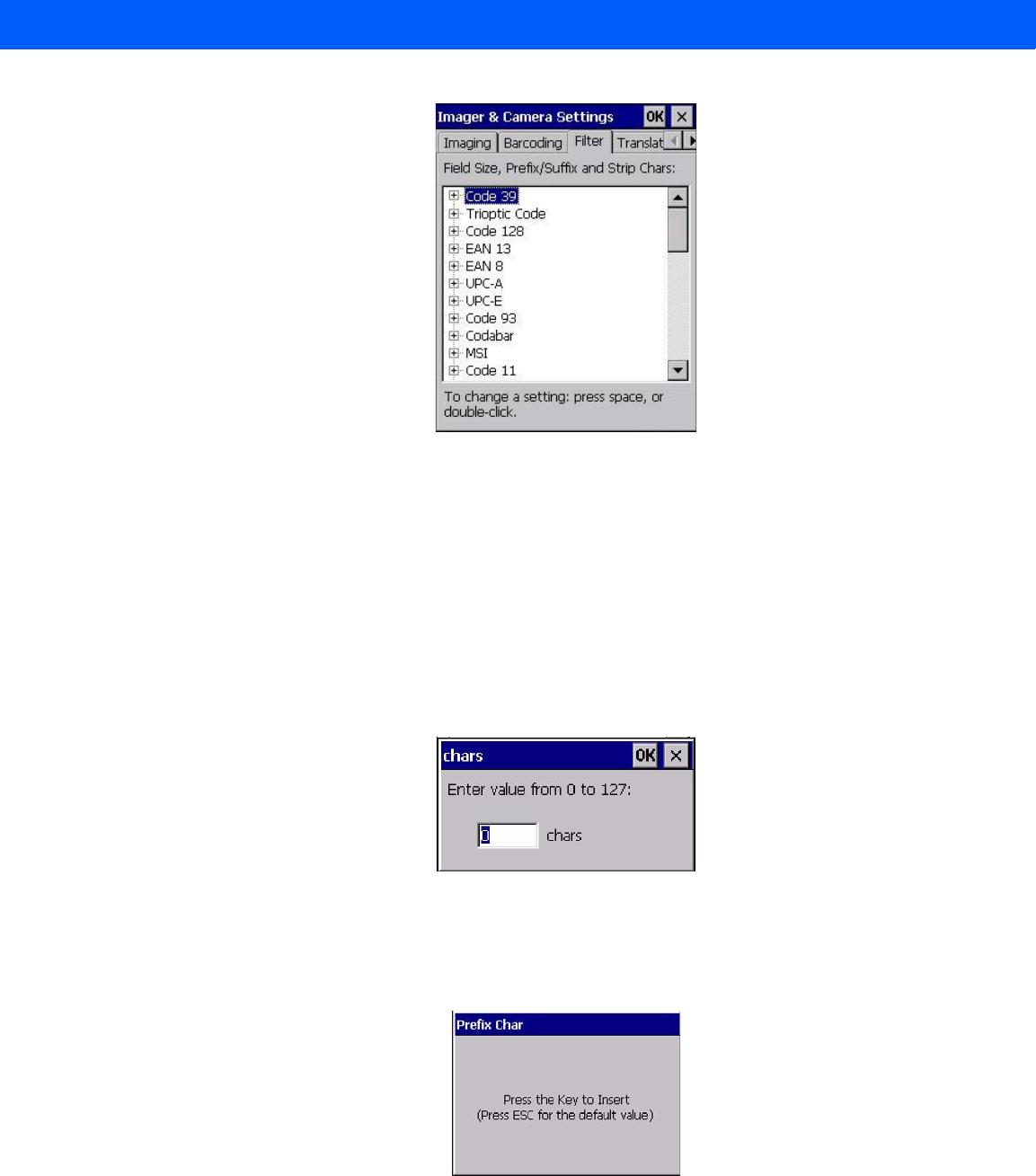
Imager & Camera Settings B - 13
Modifying a Barcode Setting
The rules for manipulating data from selected barcode symbologies can be modified. To change the settings
for a symbology:
• Tap on the + symbols to expand the lists and view the parameter settings.
• Scroll through the parameter list until you reach the parameter that you want to change.
• For a parameter that can take a range of values:
- Highlight the parameter, and then press the [SPACE] key or double-click the parameter.
- An associated dialog box containing the valid range of values for the parameter and the current setting
like the sample screen following is displayed.
- Type a value in the field provided.
• For a parameter that takes a single character:
- Highlight the parameter and then press the [SPACE] key, or double-click the parameter. The following
screen is displayed:
• When you’ve completed your edits, tap on OK.
Draft #4 for review
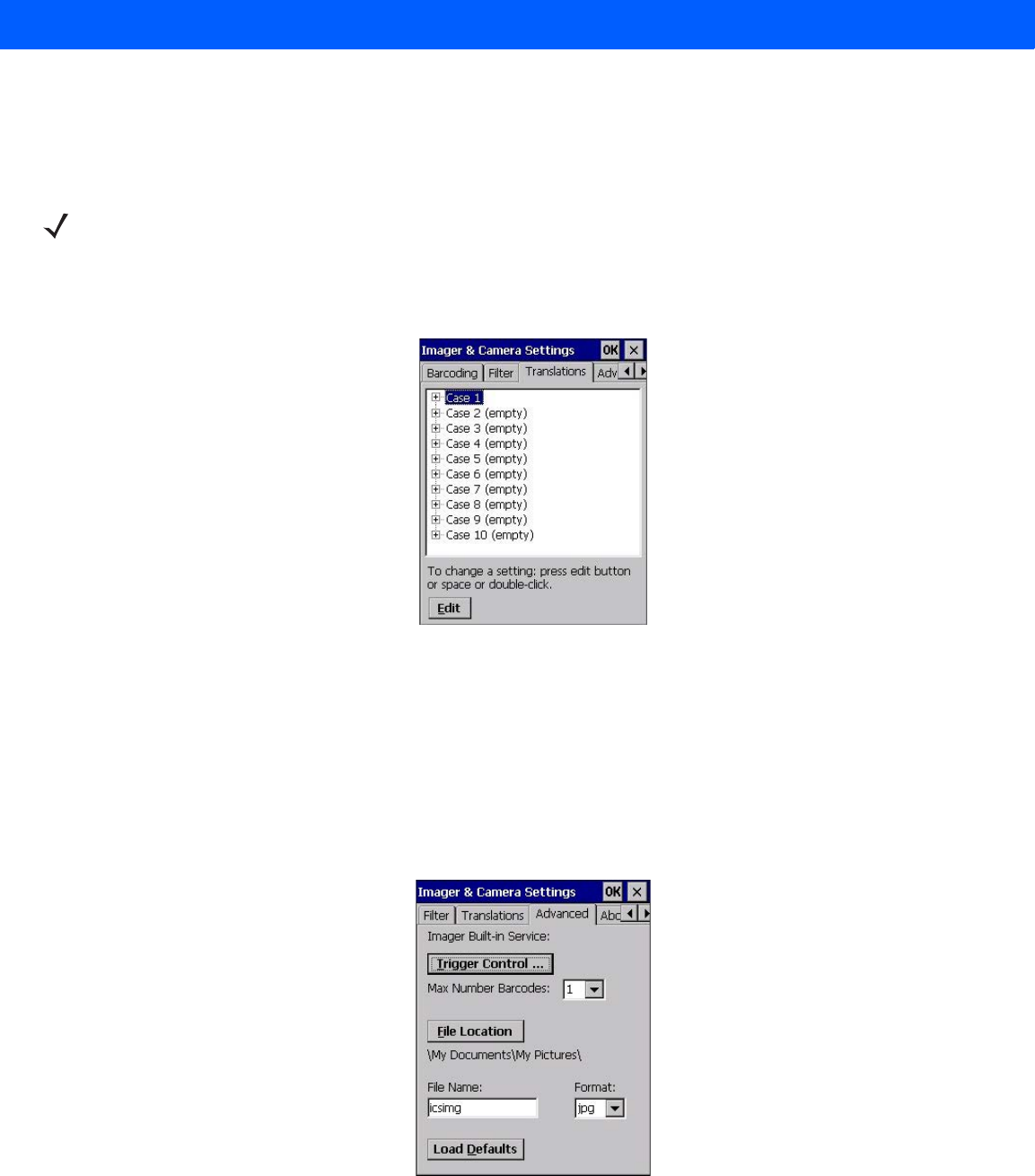
B - 14 Omnii Hand-Held Computer with Windows CE 6.0 User Guide
Translation Menu – Configuring Rules
Translation rules enable the automatic processing of barcode data. Up to 10 cases can be defined, each
consisting of up to 10 sequential rules.
•Tap on Start>Settings>Control Panel.
• Tap on the Imagers icon, and then tap on the Translations tab.
For instructions on adding, editing, and removing translation rules, refer to Translations on page 3-54.
Advanced Menu
File Locations for Captured Images
To configure the location for saved images, open the dialog box as follows:
•Tap on Start>Settings>Control Panel.
• Tap on the Imagers icon, and then tap on the Advanced tab.
To define the location where imager files will be stored:
• Tap on the File Location button.
NOTE Changes made to the translations configuration using the Scanner Control Panel program are syn-
chronized with changes made here. Changes made in either place affect both translation tables.
Draft #4 for review
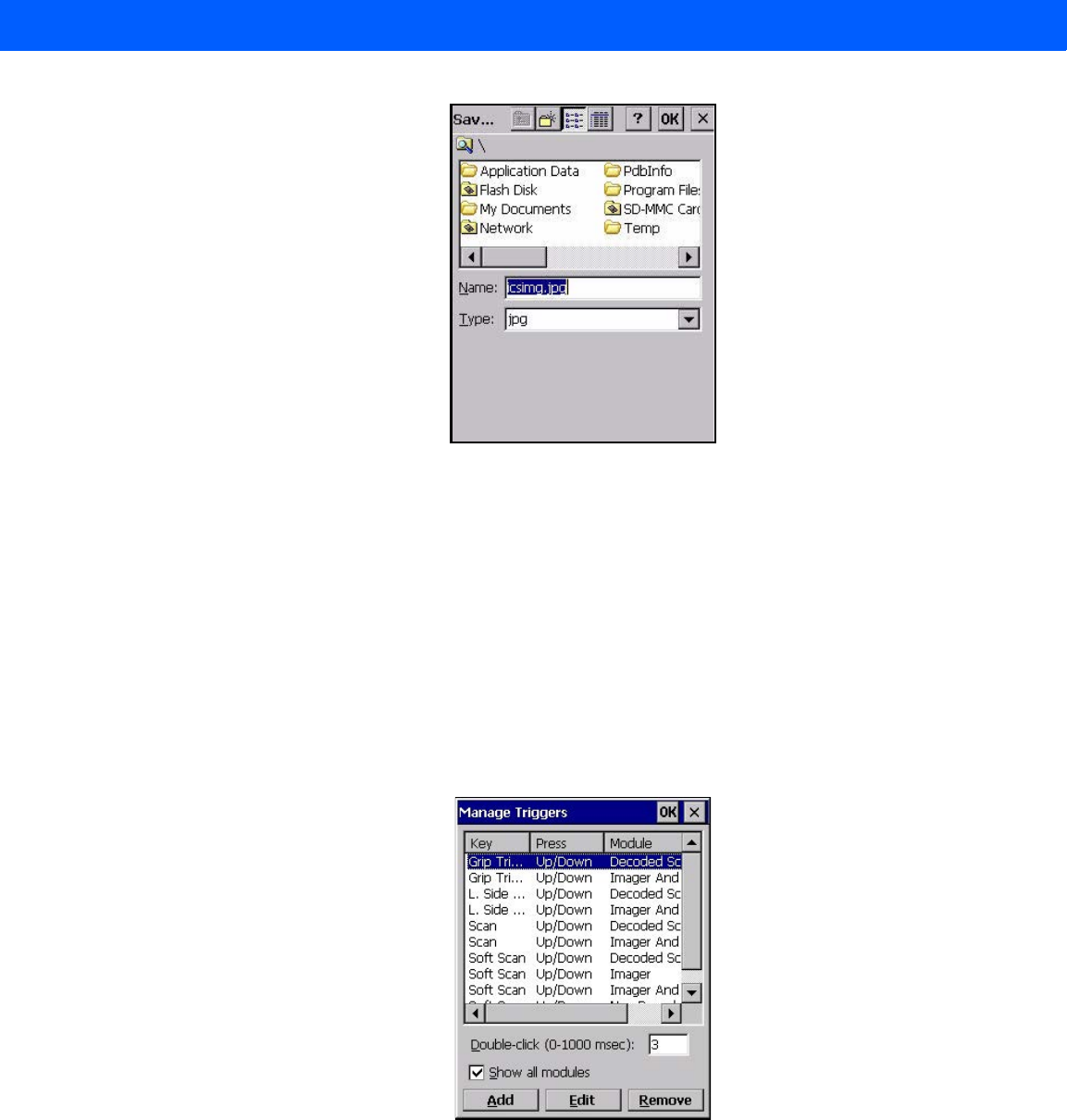
Imager & Camera Settings B - 15
• Type the file Name, choose the Folder and file Type.
• Choose the Location in which your files will be saved.
• When you have completed all the changes, tap on the Save button.
Configuring Triggers
Viewing the Trigger Configuration
The trigger on the Omnii is configured using the Manage Triggers applet. The Imagers applet provides a
shortcut to the Manage Triggers applet.
• In the Advanced tab, tap on the Trigger Control button.
• To view all the triggers and the hardware devices that are configured to use them, tap in the check box next
to Show all modules.
Adding, Editing and Removing Triggers
For instruction about adding, editing and removing triggers, refer to Manage Triggers on page 3-36.
Draft #4 for review
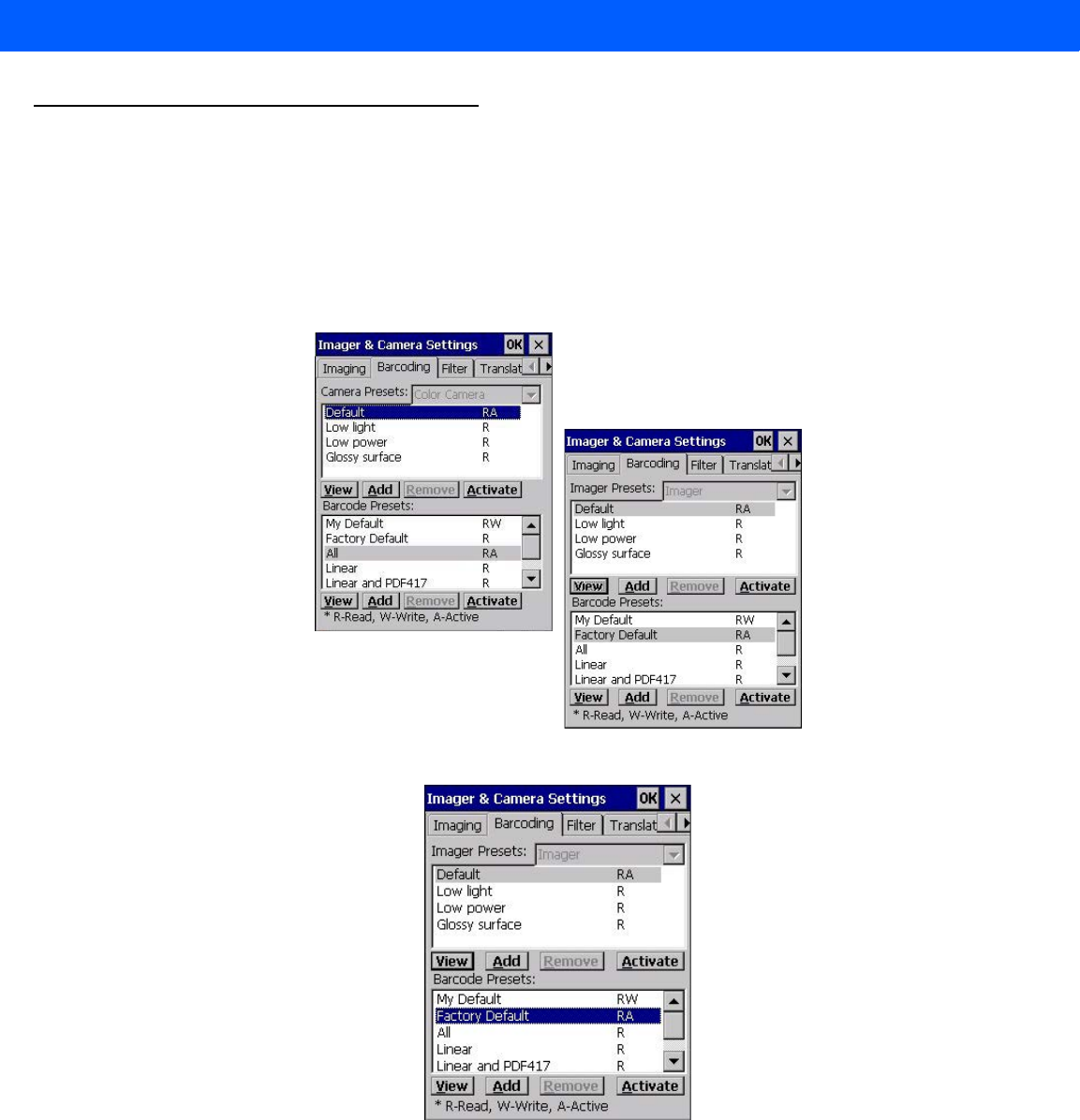
B - 16 Omnii Hand-Held Computer with Windows CE 6.0 User Guide
Barcode Symbologies
There are two sets of barcode symbologies, one for Imager and one for Color Camera. To display the
barcodes available:
• In the Imager & Camera Settings screen, go to the Barcoding tab.
• In the Camera Presets: drop-down menu at the top of the Imager & Camera Settings screen, choose
Imager or Color Camera depending on which set of barcodes you want to work with.
• Go to the Barcode Presets.
• Tap on an Barcode Preset to display the barcode symbologies.
Draft #4 for review
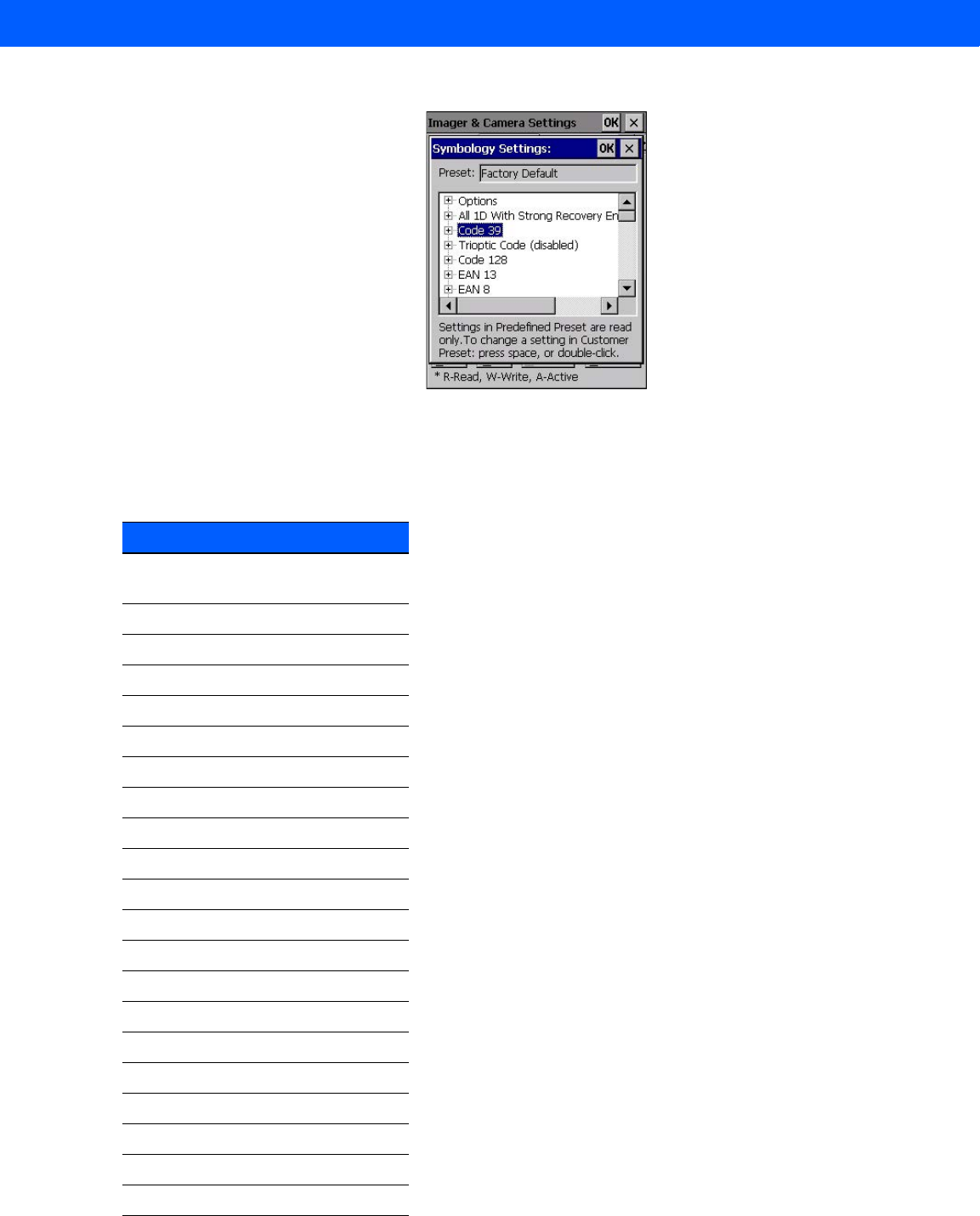
Imager & Camera Settings B - 17
Imager Barcode Symbologies
The barcode symbologies for the Imager are listed in this section.
Imager Barcode Symbologies
All 1D With Strong Recovery
Enabled
Code 39
Code 128
EAN 13
EAN 8
UPC-E
UPC-A
UPC/EAN Sharing Settings
Code 93 (disabled)
MSI Plessey (disabled)
Code 11 (disabled)
Interleaved 2 of 5 (disabled)
Matrix 2 of 5 (disabled)
Discrete 2 f 5 (disabled)
Telepen (disabled)
Gs1 DataBar (disabled)
TLC-39 (disabled)
2D PDF-417
2D micro PDF-417
CodaBlock F (disabled)
CodaBlock A (disabled)
Draft #4 for review

B - 18 Omnii Hand-Held Computer with Windows CE 6.0 User Guide
Color Camera Barcode Symbologies
The barcode symbologies for the Color Camera are listed in this section.
2D Data Matrix
2D QR Code
2D Maxicode (disabled)
2D Aztec (disabled)
Postal: PlanNET (disabled)
Postal: PostNET (disabled)
Postal: China (disabled)
Postal: Japanese (disabled)
Postal: Kix (disabled)
Postal: Royal (disabled)
Gs1
Imager Barcode Symbologies
Color Camera Barcode Symbologies
All 1D With Strong Recovery Enabled
Code 39
Code 128
EAN 13
EAN 8
UPC-E
UPC-A
Code 93 (disabled)
Codabar
Interleaved 2 of 5 (disabled)
Gs1 DataBar (disabled)
Gs1 Composite
2D PDF-417
2D micro PDF-417
2D Data Matrix
2D QR Code
2D Maxicode (disabled)
2D Aztec (disabled)
Postal: PlanNET (disabled)
Postal: PostNET (disabled)
Draft #4 for review

Imager & Camera Settings B - 19
Postal: Australia (disabled)
Postal: Canadian (disabled)
Postal: Japanese (disabled)
Postal: Kix (disabled)
Postal: Korean (disabled)
Postal: Royal (disabled)
Color Camera Barcode Symbologies
Draft #4 for review
Draft #4 for review
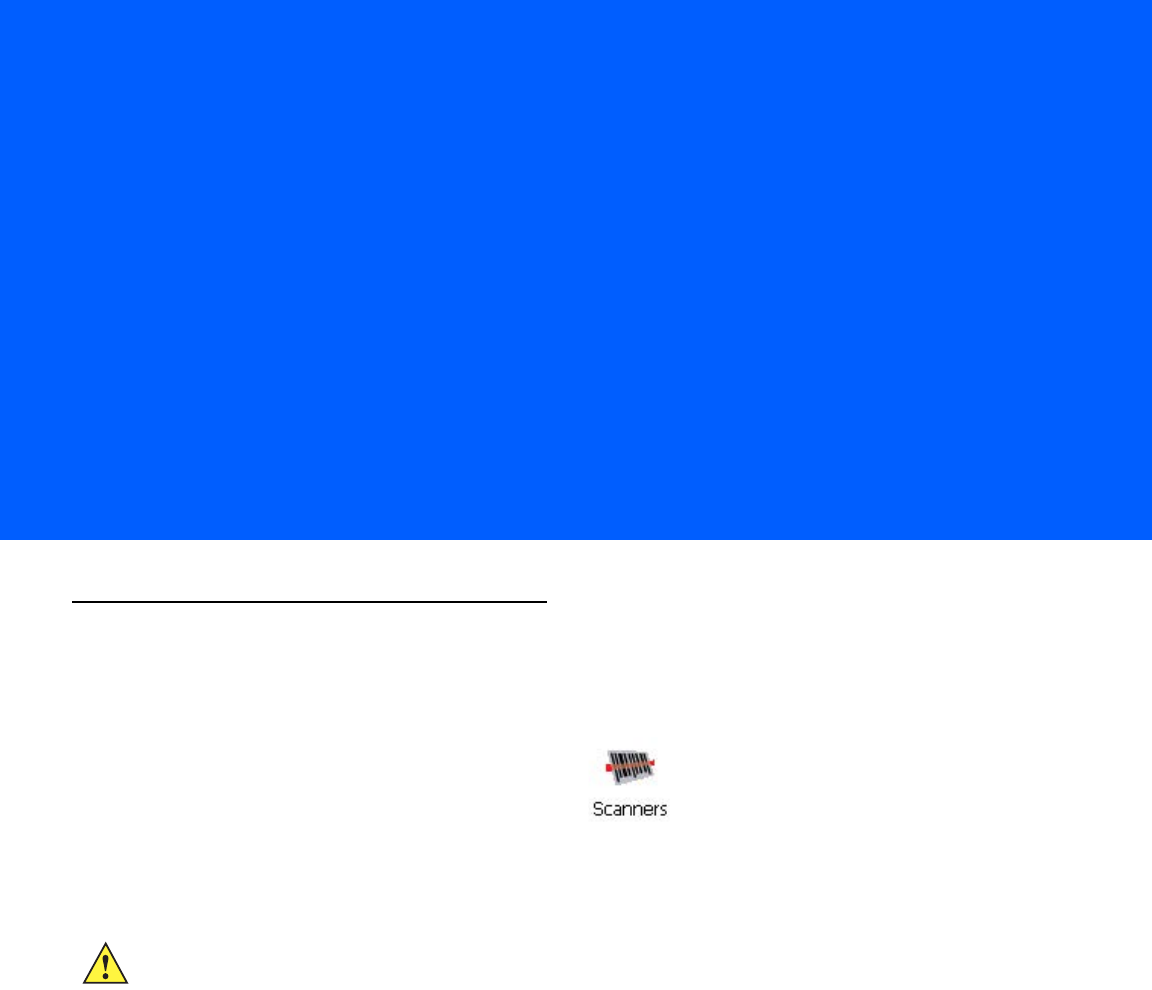
APPENDIX C SCANNER SETTINGS
CScanner Settings
Barcode Settings
The Scanners icon in the Control Panel provides dialog boxes in which you can tailor barcode scanner config-
urations and choose the barcodes your scanner will recognize.
The parameters are preset with the default settings of the decoded scanner installed in the unit. For a listing of
available scanners and their specifications, please refer to Appendix E: Omnii Specifications.
Scanner Options
The drop-down menu to the right of the Scanner option allows you to choose configurations for one of the
following scanner types, depending on what is installed in/on your hand-held: Decoded (internal), Decoded
(HHP), Decoded (Intermec ISCP, and Non-decoded Scanners.
IMPORTANT To enable a newly-installed scanner, press and hold down the [FN] key and the [Power]
key simultaneously for a minimum of three seconds.
For information on configuring the Options, Translations, and Ports settings, see Scan-
ners on page 3-50.
Draft #4 for review
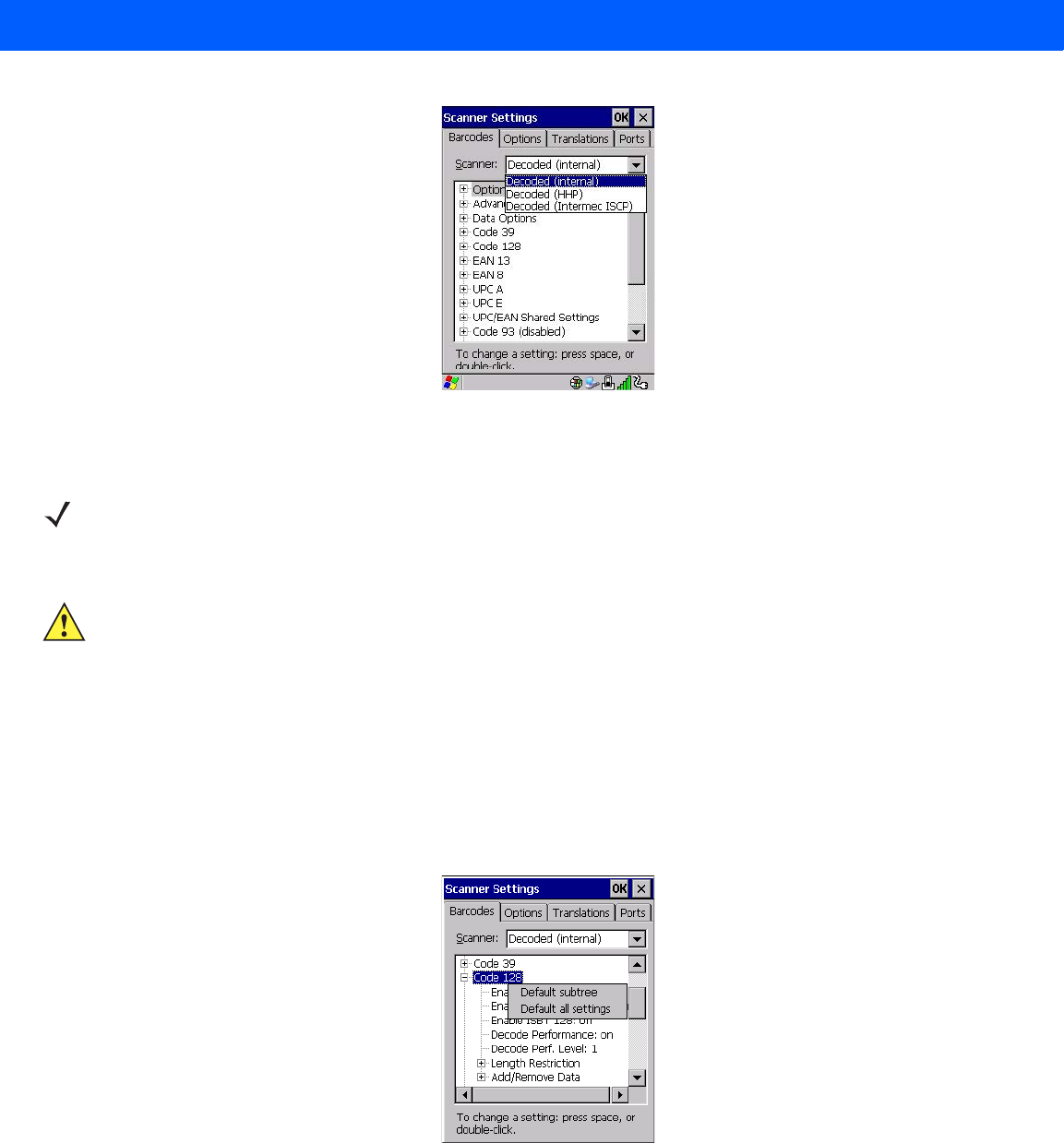
C - 2 Omnii Hand-Held Computer with Windows CE 6.0 User Guide
The symbologies listed change to reflect the scanner you choose and the barcodes it supports. Always defer to
your barcode scanner programming manual when in doubt about the availability or settings for any parameter.
Keep in mind that some barcode types are only available when an internal imaging scanner is installed. All
internal scanners can be configured using these dialog boxes.
Restoring Default Settings
If you want to restore the factory defaults after making changes, the defaults can be applied to a selected
parameter, sub-tree of parameters, or all scanner parameters.
• Press and hold on a symbology (e.g., Code 128) to display a pop up a menu.
• Choose Default subtree to reset only the parameters in the symbology you selected, or choose Default
all settings to reset all scanner parameters to default settings.
To reset a single parameter to its default setting:
• Press and hold on the parameter you want to reset.
NOTE Your Omnii comes preconfigured from the factory for internal scanner types. The type of scanner
installed can be determined from the System icon in the Control Panel, under the System Prop-
erties tab.
IMPORTANT To improve the decode speed and performance, enable (set to on) only those codes that
are required by the application.
Draft #4 for review
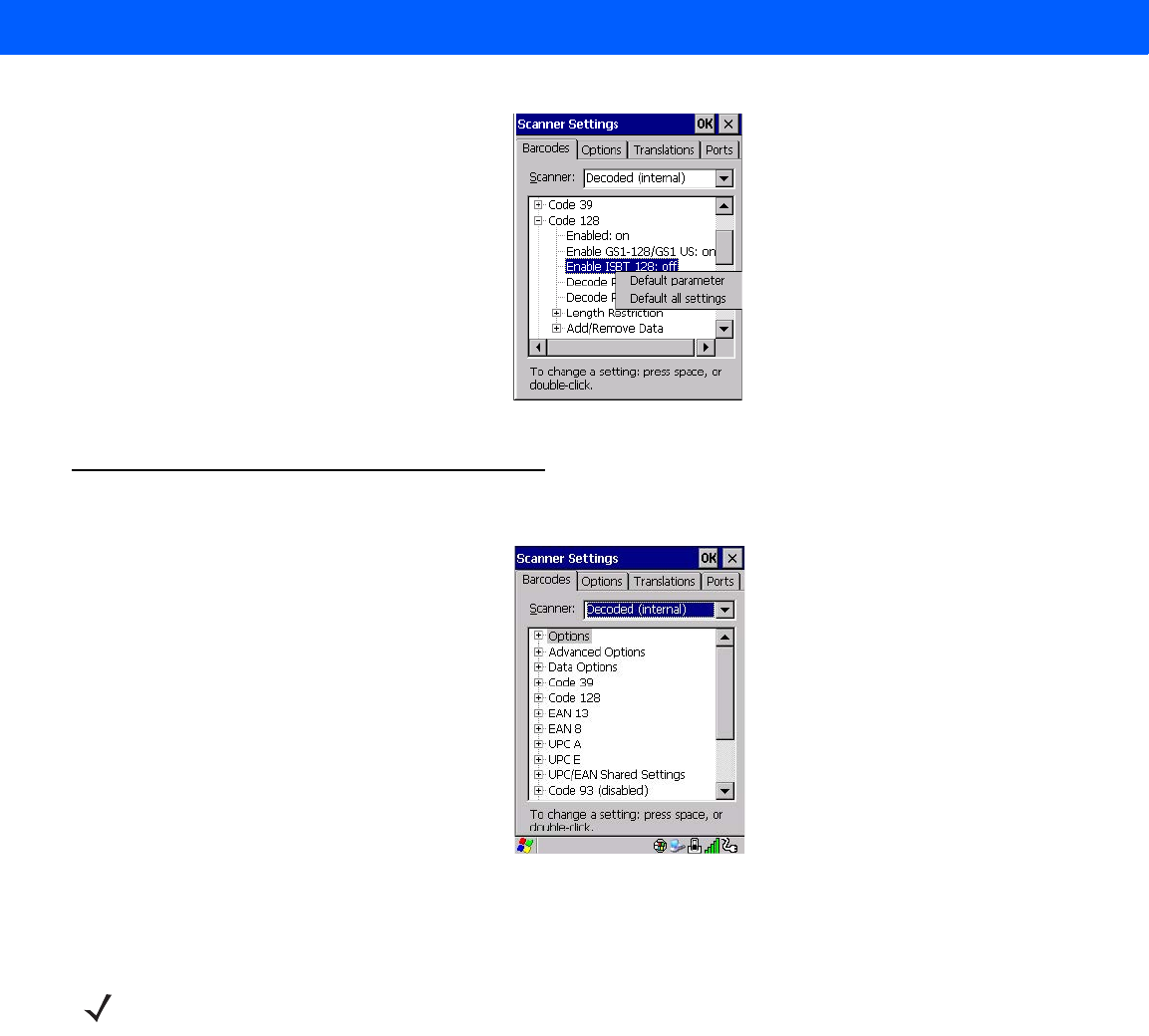
Scanner Settings C - 3
• Choose Default parameter to reset the parameter to the default setting.
Decoded (Internal) Scanners
• Tap on the Scanner drop-down menu, and choose Decoded (internal).
Options
Dot Time (msec)
The value selected for Dot Time (msec) determines (in milliseconds) how long the targeting dot remains on
before the scanner switches to a normal scan sweep. When you double-tap on this parameter, a dialog box is
displayed in which you can enter a value of 0 msec, 200 msec or 400 msec. A value of 0 (zero) disables the
target dot.
Laser On Time
The value assigned to this parameter determines how long the laser will remain on when the scan button or
trigger is pressed.
Double-tapping on this parameter displays a dialog box in which you can enter a value between 5 and 99. The
value is measured in tenths of seconds.
NOTE Some options are available only for specific scanners. Refer to the option names in this section
for scanner model identification.
Draft #4 for review

C - 4 Omnii Hand-Held Computer with Windows CE 6.0 User Guide
Decoded (Internal) Advanced Options
Scan Mode
You can set the method of scanning by setting this parameter to Scan beam only, Aim with Scan: 1 trigger pull,
Aim with Scan: 2 trigger pulls, Aim with Scan on trigger release, and Continuous Scan Mode. Default is Scan
beam only.
Aim Duration
This parameter determines the total time the aiming pattern appears before the scanner laser begins
sweeping. When you double-tap on this parameter, a dialog box is displayed in which you can enter a value
from 0 to 30 (0 to 3 sec.). A value of 0 (zero) disables the aiming-dot.
Minimum Cancel Time
The value assigned to this parameter determines the time delay before the scanner is turned off, once the
scanner trigger or button is released. This gives the scanner a minimum amount of time to complete its current
decode before the scan is cancelled when you quickly trigger on/off.
Power Mode
This parameter is a power-saving option. Tapping on it displays a screen listing two power mode options:
Continuous Power and Low Power.
In Continuous Power mode, the scanner is always on, waiting for a trigger pull or serial communication.
In Low Power mode, the scanner is in a suspend state, drawing minimal power until a trigger pull or serial
communication wakes it. Keep in mind that while this option is more suitable for battery powered applications,
there will be a slight delay while the scanner powers up to scan a barcode.
Low Power Timeout
To extend laser life, you can select the time the scanner remains active following a successful decode. The
scanner wakes from low power mode when a barcode is scanned — a successful decode restores normal
flashing.
This is only used if the unit’s Trigger Mode has been changed to Continuous On. If the unit is used in a fixed
mount this parameter might be used, but not if the unit is used as a hand-held.
When you double-tap on this parameter, a dialog box is displayed in which you can choose a value of 30 sec.,
1 min., 2 min. or 3 min.
Parameter Scanning
Setting this parameter to on enables decoding of parameter barcodes.
Linear Security Level
This parameter allows you to select the security level appropriate for your barcode quality. There are four levels
of decode security for linear code types (e.g., Code 39, Interleaved 2 of 5). Higher security levels should be
selected for decreasing levels of barcode quality. As security levels increase, the scanner decode speed
decreases.
Double-tapping on this parameter displays a dialog box in which you can enter a value from 1 to 4.
Linear security level 1 specifies that the following code types must be successfully read twice before
being decoded:
NOTE This parameter is only used if the Trigger Mode has been set to Continuous On and the Omnii is
mounted in a fixed position; otherwise, Low Power Timeout is not used.
Draft #4 for review
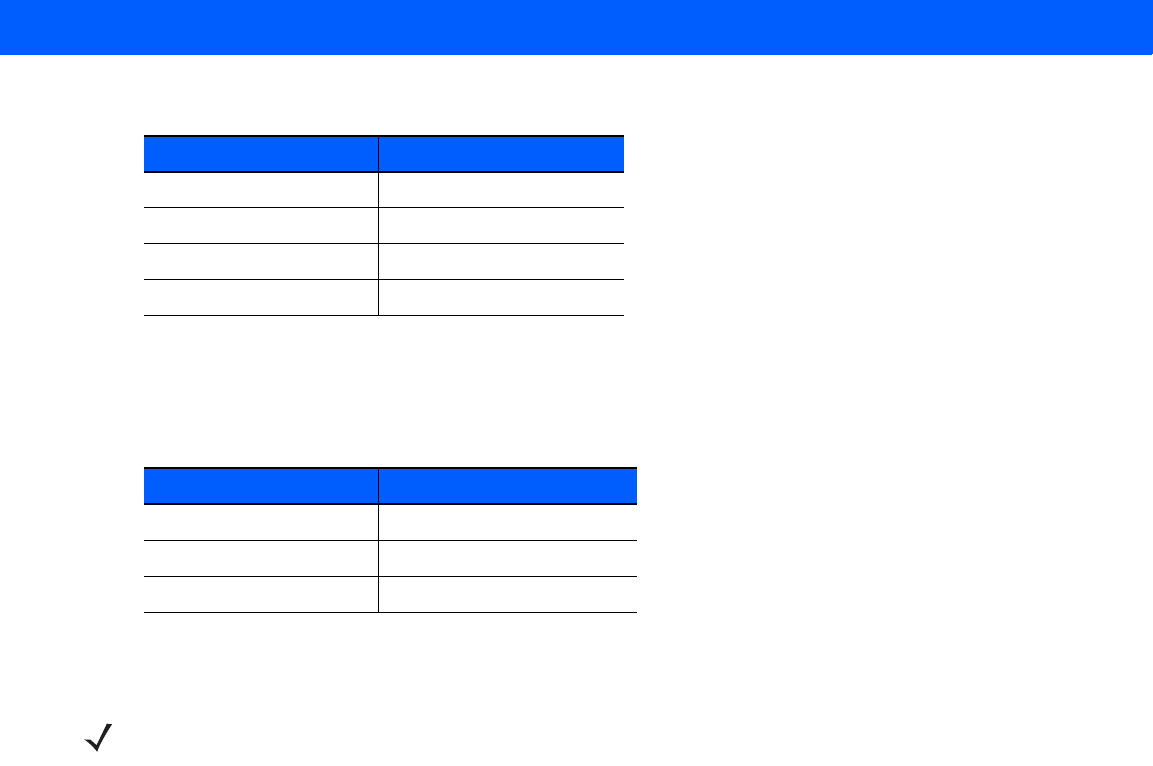
Scanner Settings C - 5
Linear security level 2 specifies that all types of codes must be successfully read twice before being decoded.
Linear security level 3 specifies that code types other than the following must be successfully read twice before
being decoded. The following codes must be read three times:
Linear security level 4 requires that all code types be successfully read three times before being decoded.
Bi-Direction Redundancy
When this parameter is enabled, a barcode must be successfully scanned in both directions (forward and
reverse) before being decoded.
Decoded (Internal) Data Options
Transmit Code ID Char
A code ID character identifies the scanned barcode type. In addition to any single character prefix already
selected, the code ID character is inserted between the prefix and the decoded symbol.
When you double-tap on this parameter, a dialog box is displayed in which you can choose a transmit code:
None, AIM or Symbol.
Scan Data Format
This parameter allows you to change the scan data transmission format.
Double-tapping on Scan Data Format displays the following options from which you can choose a data format:
data (as-is), data [S1], data [S2], data [S1][S2], [P] data, [P] data [S1], [P] data [S2] and [P] data [S1][S2].
Prefix [P], Suffix [S1] and Suffix [S2]
A prefix and/or one or two suffixes may be appended to scan data for use in data editing. When you double-tap
on these parameters, dialog boxes are displayed in which you can enter a value from 0 to 255.
Delete Char Set ECIs
Setting this parameter to on enables the scanner to delete any escape sequences representing Character Set
ECIs (Extended Channel Interpretations [also known as GLIs]) from its buffer before transmission.
Code Type Length
Codabar All
MSI Plessey 4 or less
D 5 of 5 8 or less
I 2 of 5 8 or less
Code Type Length
MSI Plessey 4 or less
D 2 of 5 8 or less
I 2 of 5 8 or less
NOTE This parameter is only valid if a “Linear Security Level” is enabled.
Draft #4 for review
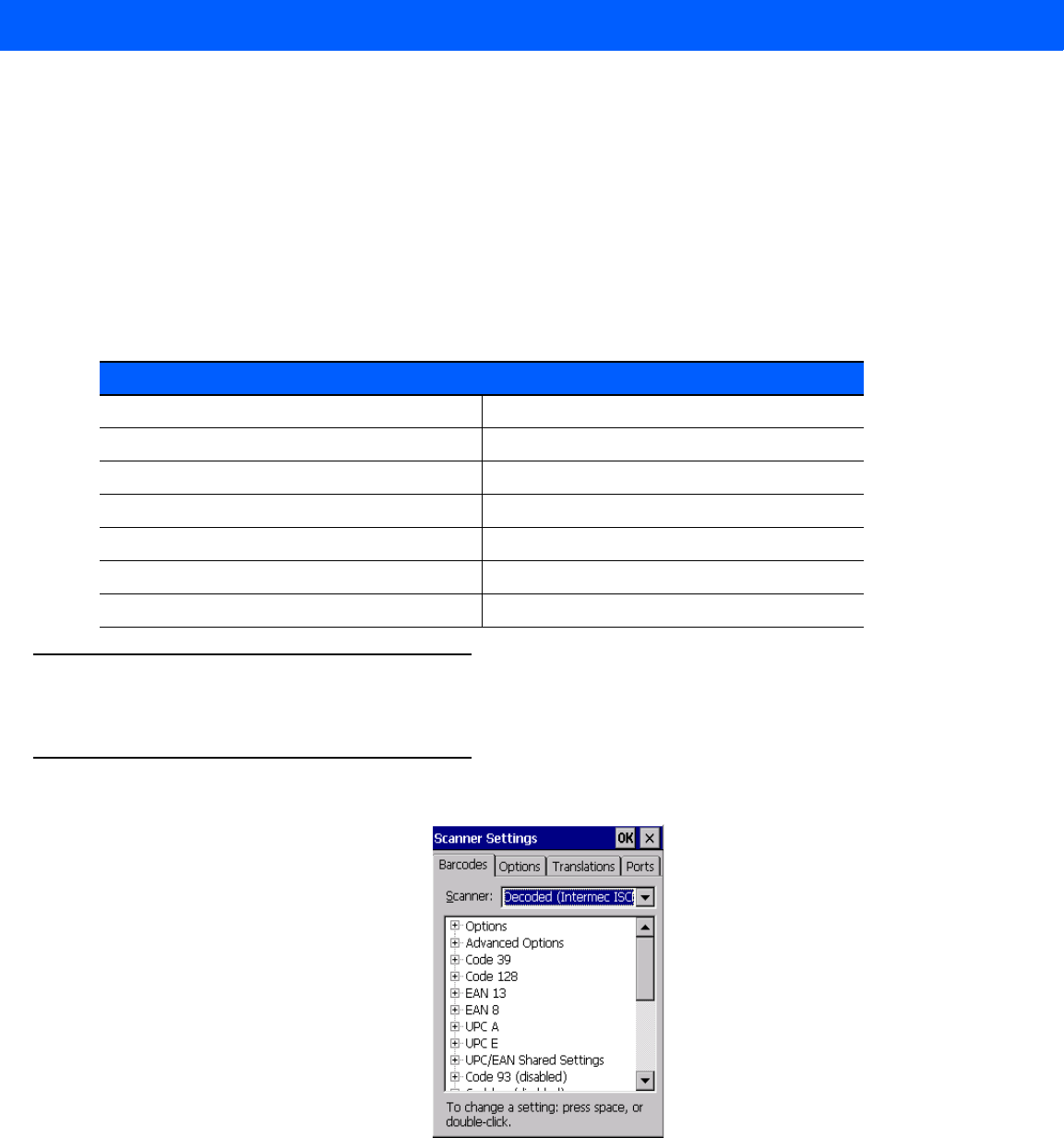
C - 6 Omnii Hand-Held Computer with Windows CE 6.0 User Guide
When this parameter is enabled, the scanner transmits data from PDF417 and MicroPDF417 barcodes
containing Character Set ECIs, even when the ECI Protocol is disabled.
ECI Decoder
Setting this parameter to on enables the scanner to interpret any Extended Channel Interpretations (ECIs)
supported by the scanner. This parameter has no effect on symbols that were not encoded using ECIs.
If this parameter is set to off and a symbol that was encoded using an ECI escape is scanned, the scanner
transmits the ECI escape followed by the uninterpreted data.
The barcode symbologies for the scanner are listed in table following table.
Decoded (HHP)
To configure imagers, please see Appendix B: Imager & Camera Settings.
Decoded (Intermec ISCP)
• Tap on the Scanner drop-down menu, and choose Decoded (Intermec ISCP).
Decoded (ISCP) Options
Laser On Time
The value assigned to this parameter determines how long the laser will remain on when the scan button or
trigger is pressed.
Decoded (Internal) Barcode Symbologies
Code 39 UPC/EAN Shared Settings
Trioptic Code (disabled) Code 93 (disabled)
Code 128 Codabar (disabled)
EAN 13 MSI Plessey (disabled)
EAN 8 Interleaved 2 of 5 (disabled)
UPC-A Discrete 2 f 5 (disabled)
UPC-E Gs1 DataBar (disabled)
Draft #4 for review

Scanner Settings C - 7
Double-tapping on this parameter displays a dialog box in which you can enter a value between 1 and 10
seconds.
Decoded (ISCP) Advanced Options
Continuous Scan Mode
Setting this parameter to on keeps the laser on and continuously decoding as long as the scanner button is
pressed and held down.
Minimum Cancel Time
The value assigned to this parameter determines the time delay before the scanner is turned off, once the
scanner trigger or button is released. This gives the scanner a minimum amount of time to complete its current
decode before the scan is cancelled when you quickly trigger on/off.
Low Power Timeout
To extend laser life, you can select the time the scanner remains active following a successful decode. The
scanner wakes from low power mode when a barcode is scanned — a successful decode restores normal
flashing.
When you double-tap on this parameter, a dialog box is displayed in which you can choose a value of 30 sec,
1 min, 2 min, or 3 min.
Parameter Scanning
Setting this parameter to Enabled allows decoding of parameter barcodes.
Same Read Validate
The data is only transmitted after repeated reads give the same result. The value assigned at this parameter
determines the number of reads required, from 0 to 10 times.
Same Read Timeout
Prevents the same barcode from being read more than once. The value assigned determines after what time
period the scanner will timeout, from 0 to 2550 msec.
Diff Read Timeout
Prevents unwanted reading of other barcodes on the same label. The value assigned determines after what
time period the scanner will timeout, from 0 to 2550 msec.
Add AIM ID Prefix
The AIM ID (Association for Automatic Identification and Mobility) is an international barcode identifier. When
this parameter is enabled, the AIM ID is inserted at the beginning of the decoded barcode.
NOTE This parameter is only used if the Trigger Mode has been set to Continuous On and the unit is
mounted in a fixed position; otherwise, Low Power Timeout is not used.
Draft #4 for review
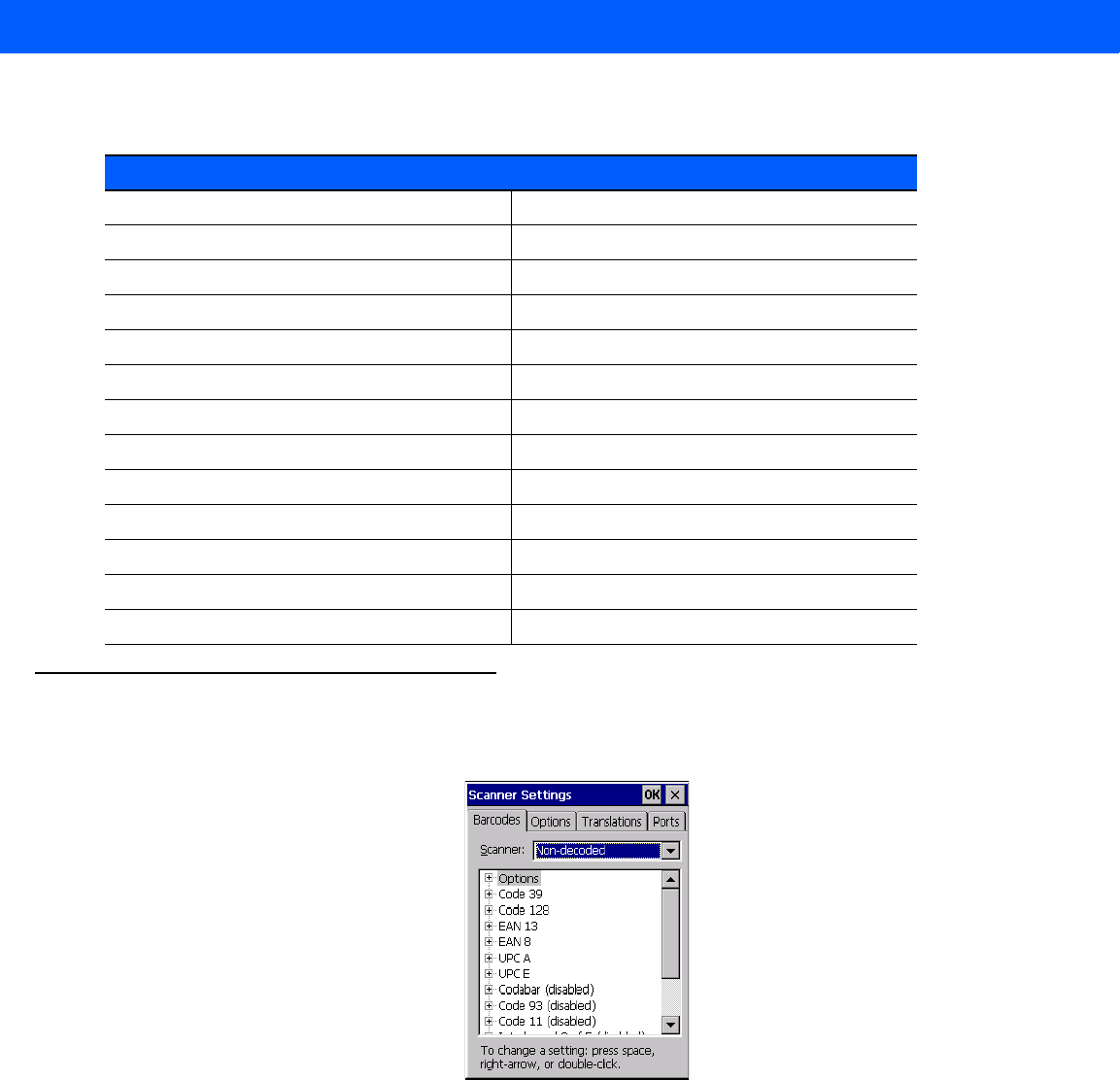
C - 8 Omnii Hand-Held Computer with Windows CE 6.0 User Guide
The barcode symbologies for the scanner are listed in the following table.
Non-Decoded Scanners
Figure C-1
Non-Decoded Scanner Options
• Tap on the Scanner drop-down menu, and choose Non-decoded.
All the available barcode symbologies for this type of scanner can be selected in this tab.
A plus sign (+) to the left of the menu item indicates that a sub-menu of parameters is attached.
• Tap on the + sign to display the sub-menu.
• To change a parameter value, double-tap on the parameter. If you need to type a value, a dialog box is dis-
played in which you can type a new value. If you need to change a yes or no value, double-tapping on the
parameter toggles between yes and no.
Decoded (Intermec ISCP) Barcode Symbologies
Code 39 TLC-39 (disabled)
Code 128 2D PDF-417
EAN 13 2D micro PDF-417
EAN 8 Discrete 2 of 5 (disabled)
UPC-A Telepen (disabled)
UPC-E Gs1 DataBar (disabled)
UPC/EAN Shared Settings Composite
Code 93 (disabled) TLC-39 (disabled)
Codabar (disabled) PDF-417
MSI Plessey (disabled) micro PDF-417 (disabled)
Code 11 (disabled) CodaBlock F (disabled)
Interleaved 2 of 5 (disabled) CodaBlock A (disabled)
Matrix 2 of 5 (disabled)
Draft #4 for review
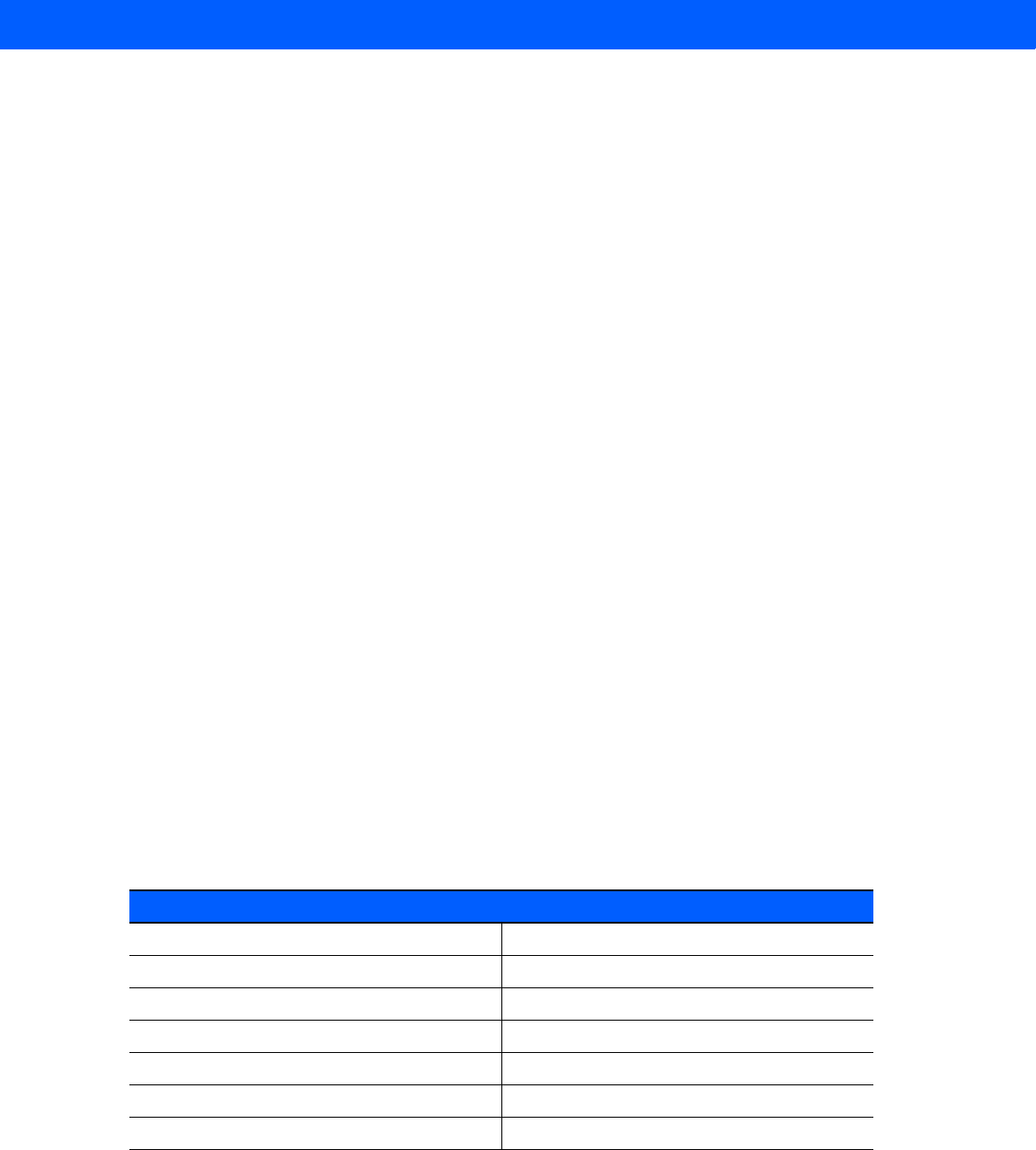
Scanner Settings C - 9
If you’re using the keyboard:
• Highlight the barcode you want to work with, and press the [RIGHT] arrow key to display the sub-menu.
• Use the [UP] and [DOWN] arrow keys to highlight a parameter.
• To change a parameter value, press [SPACE] or the [RIGHT] arrow key. If a field requires text entry, a text
box is displayed in which you can enter the appropriate value.
Options
• Tap on the + sign next to Options to display these parameters.
Dot Time (msec)
The value selected for “Dot Time (msec)” determines (in milliseconds) how long the targeting dot remains on
before the scanner switches to a normal scan sweep. When you double-tap on this parameter, a dialog box is
displayed in which you can enter a value from 0 to 3000. A value of 0(zero) disables the target dot.
Short Code
When enabled, this parameter allows scanning of short I 2 of 5 barcodes (2 characters). When disabled, these
short barcodes are rejected.
Enabling “Short Code” may reduce the robustness of the decoding since the hand-held must decode more
potential barcodes; it is therefore not recommended for general-purpose barcodes with 4 or more characters.
Verify
The value entered for this parameter determines the number of correct additional decodes required after the
initial decode, prior to a barcode being accepted. Higher values significantly increase the time it takes to
decode a barcode but also improve the reliability of the decoded barcode.
Security
This parameter controls the tolerance for decoding edge-to-edge barcodes (Code 93, Code 128, UPC/EAN).
Lower values have a lower tolerance for misreads, but they also increase the time it takes to decode the
barcode. The default value of 30 is generally a good compromise setting.
The barcode symbologies for the scanner are listed in the following table.
Non-Decoded Barcode Symbologies
Code 39 Code 93 (disabled)
Code 128 Code 11 (disabled)
EAN 13 Interleaved 2 of 5 (disabled)
EAN 8 MSI Plessey (disabled)
UPC-A Discrete 2 of 5 (disabled)
UPC-E IATA 2 of 5 (disabled)
Codabar (disabled)
Draft #4 for review
Draft #4 for review

APPENDIX D INTERNAL IMAGER &
SCANNER SPECIFICATIONS
DInternal Imager & Scanner Specifications
This appendix lists specifications for the following internal scanners. For a current list of model numbers and
descriptions for the Omnii scanner pod and back cover kits, please contact your representative or go to
http://www.motorolasolutions.com/US-EN/Product+Lines/Psion/?WT.mc_id=psion_us_p_handheld
SE955 Scanner
Parameter SE955
Configuration Decoded
Scan Rate 104 (± 12) scans/sec (bidirectional)
Scan Angle 47º± 3º default / 35º ± 3º reduced
Voltage 3.0-3.6 V± 10%;
5 V± 10%
Ambient Light: 10,000 ft. candles
Laser Safety IEC 60825
Electrical Safety UL 60950, EN/IEC 60950
EMI/RFI FCC Part 15 Class B, EN 55024/CISPR 22, AS 3548, VCCI
Environmental RoHS Compliant
Draft #4 for review
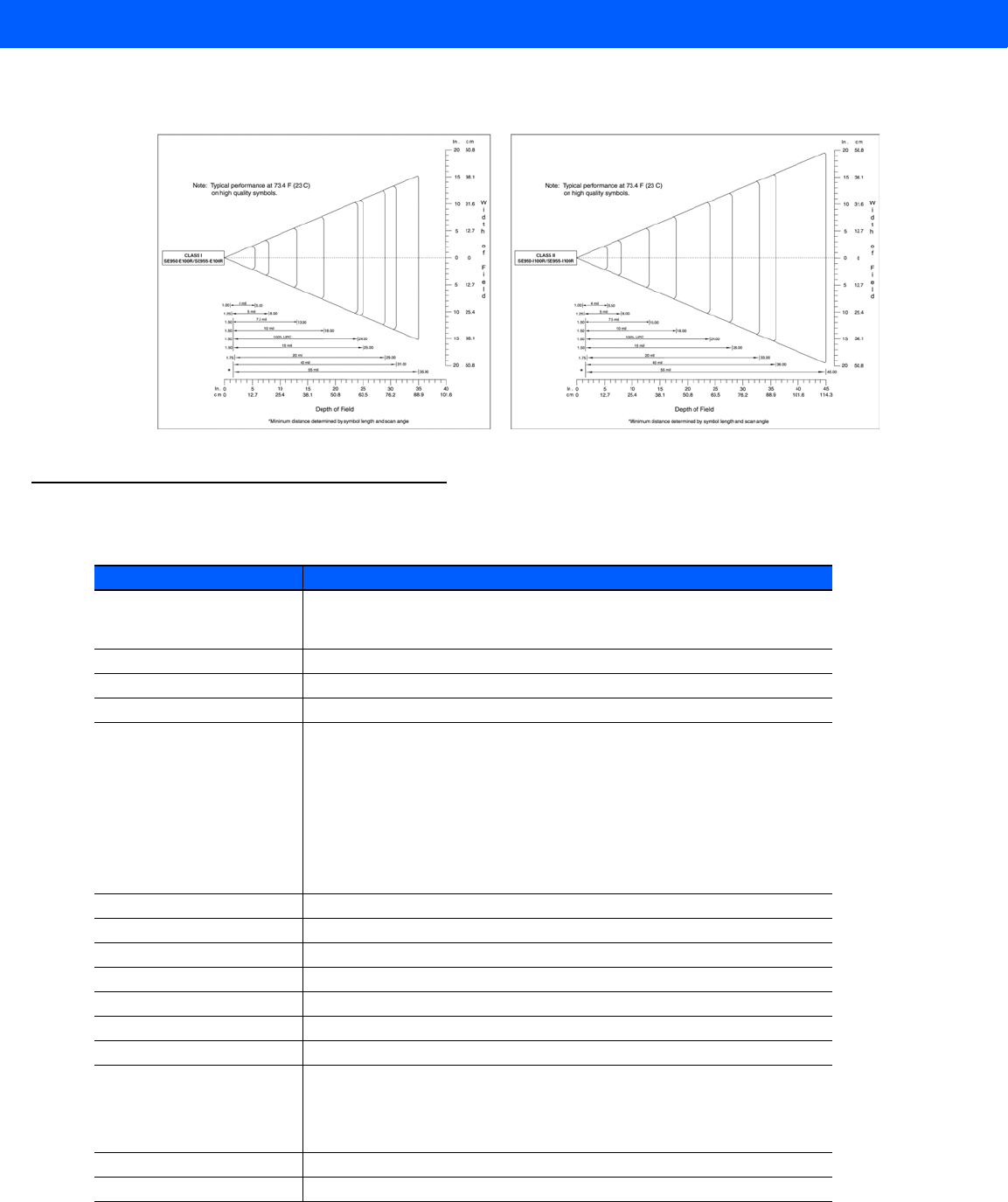
D - 2 Omnii Hand-Held Computer with Windows CE 6.0 User Guide
SE955 Decode Zones
SE965 Scanner
Parameter SE965
Dimensions 0.46 in. H x 0.85 in. W x 0.61 in. D
11.75 mm H x 21.6 mm W x 15.5 mm D
Weight 0.27 oz./7.6 g
Configuration Decoded
Interface SSI Control over TTL Serial on a 12-pin ZIF connector
Scan Angle Wide (default): 47 ° (typical)
Medium: 35° (typical)
Narrow: 10° (typical)
Note: The SE965 scan engine does not require margin on either
side of the barcode to decode. The 47° scan line provides identical
scanning performance to older scan engines with a scan line of 53°.
Skew Tolerance ± 40° from normal
Pitch Tolerance ± 65° from normal
Roll Tolerance ± 35° from vertical
Specular Dead Zone ± 8°
Optical Resolution 0.005 in. minimum element width
Scan Repetition Rate 104 (± 12) scans/sec (bidirectional)
Print Contrast Minimum 25% absolute dark/light reflectance measured at 650 nm
Ambient Lighting Toler-
ance Tolerant to typical artificial indoor and natural outdoor (direct
sunlight) lighting conditions. Fluorescent, Incandescent, Mercury
Vapor, Sodium Vapor, LED5. 450 Ft Candles (4,844 Lux) Sunlight
8000 Ft Candles (86,111 Lux)
Operating Temperature -22° F to 140° F/ -30° C to 60° C
Storage Temperature -40° F to 158° F/ -40° C to 70° C
Draft #4 for review
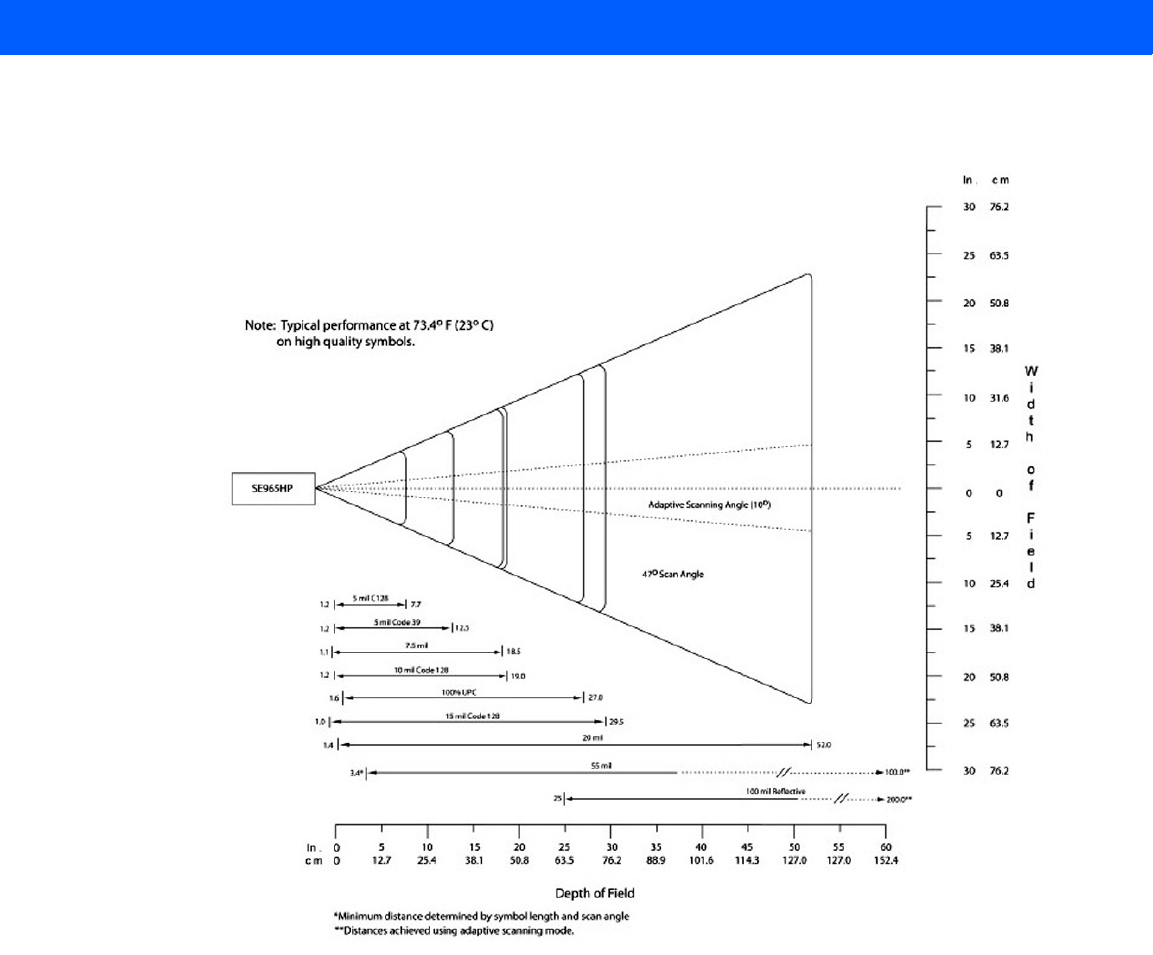
Internal Imager & Scanner Specifications D - 3
SE965 Decode Zones
Draft #4 for review
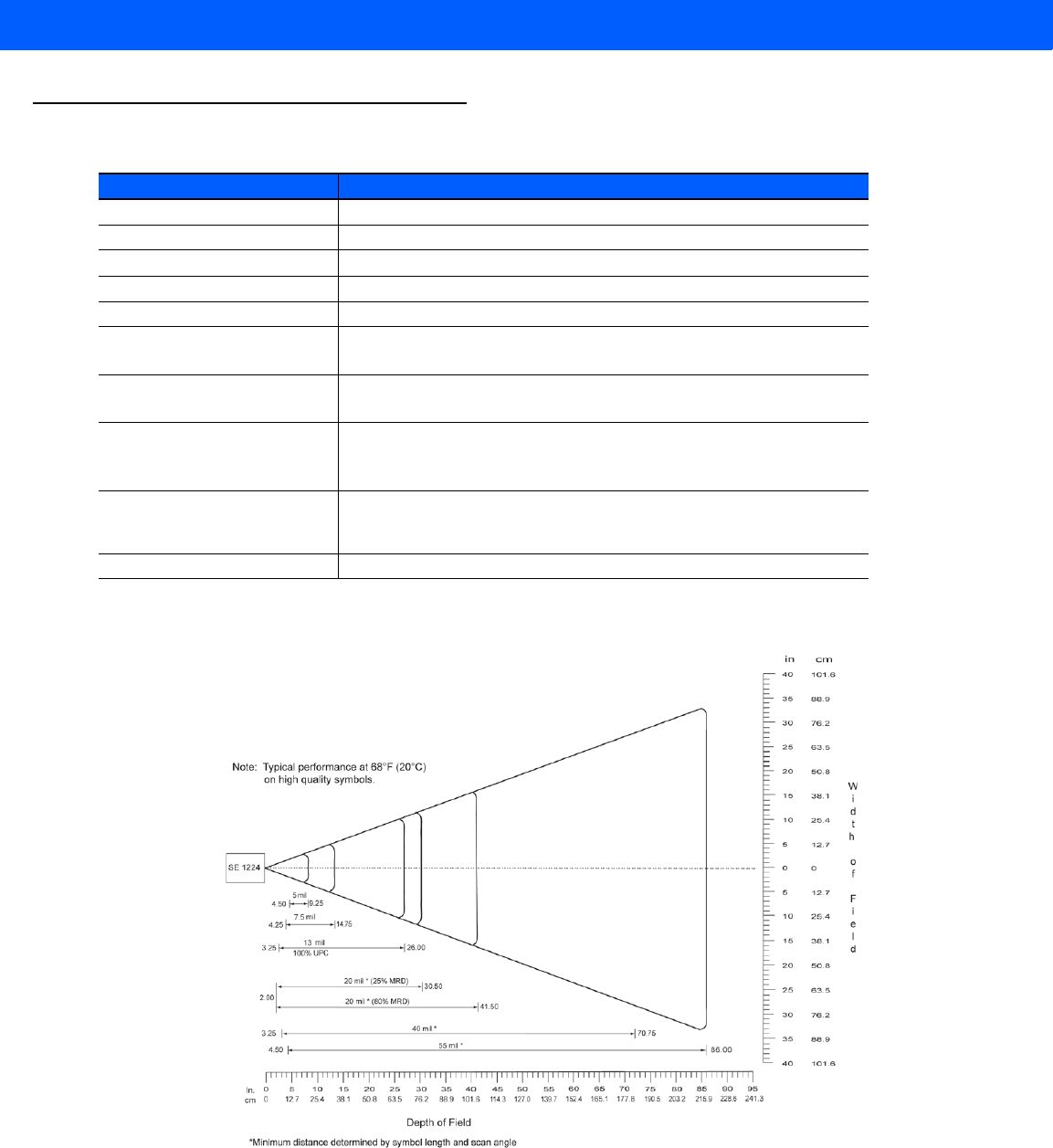
D - 4 Omnii Hand-Held Computer with Windows CE 6.0 User Guide
SE1224HP - High Performance Scanner
SE1224HP Decode Zones
Parameter SE1224HP
Type Laser Class 2
Light Source Visible Laser Diode 650 nm
Scan Rate 35 (± 5) scans/sec (bi-directional)
Scan Angle/Field of View 42º (typical), 30º (narrow)
Scan Patterns Linear
Minimum Print Contrast Minimum 25% absolute dark/light reflectance measured at
650 nm.
Symbologies UPC/EAN, Code 128, UCC/EAN 128, RSS, Code 39, Code 93, I
2 of 5, Discrete 2 of 5, Codabar, MSI.
Programmable Parameters Laser On Time, Aim Duration, Power Mode, Trigger Mode,
Bi-directional Redundancy, Symbology types/lengths,
Data formatting.
Ambient Light Artificial: 450 ft. candles (4844 Lux).
Sunlight: 8000 ft. candles (86112 Lux).
Laser Output Power (peak) 1.35 mW
Draft #4 for review
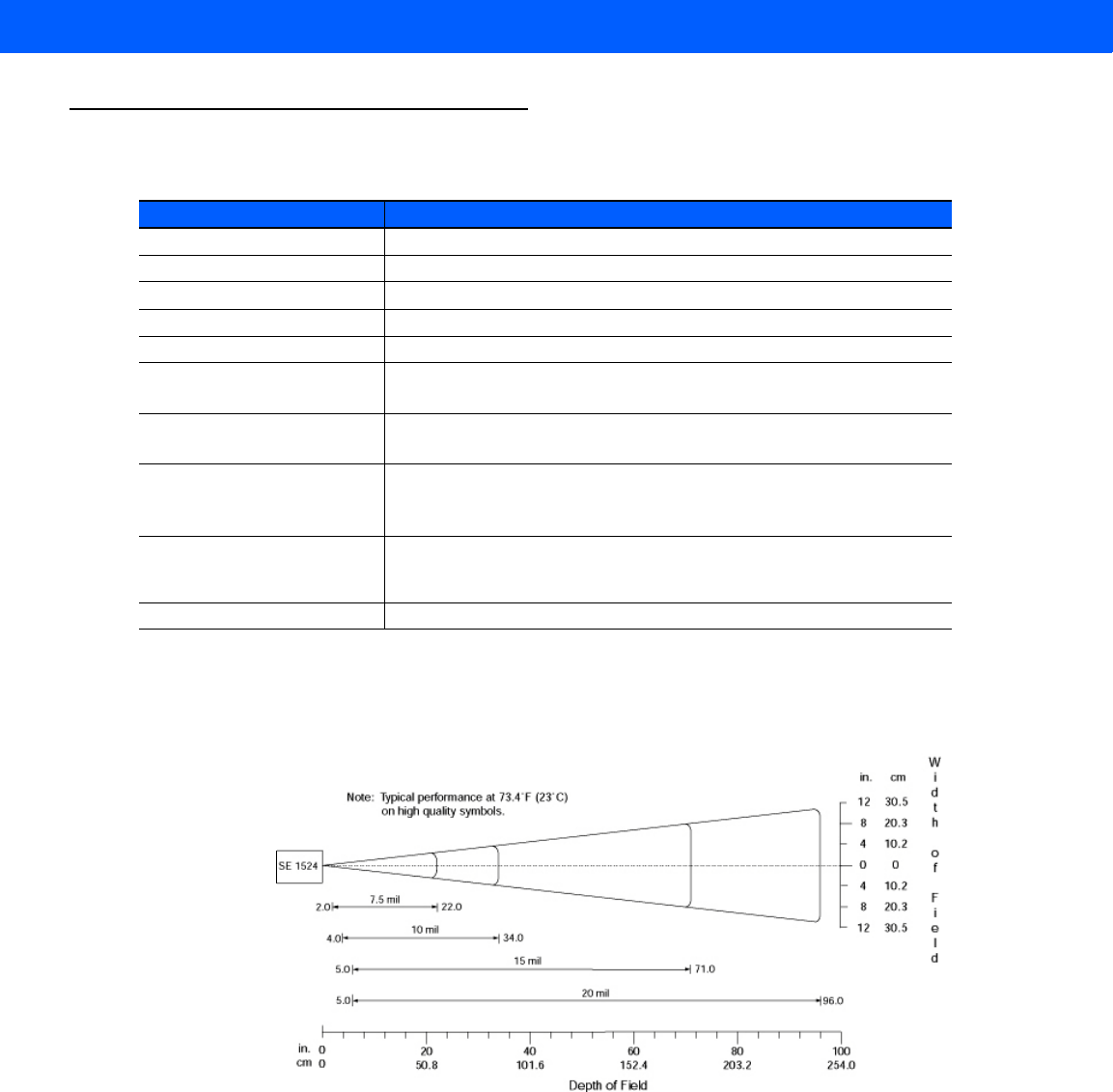
Internal Imager & Scanner Specifications D - 5
SE1524ER – Extended Range Scanner
SE1524ER Decode Zones
SE1524ER Decode Zone A (Short Range, Small Codes)
Parameter Specification
Type Laser Class 2
Light Source Visible Laser Diode 650 nm
Scan Rate 35 (±5) scans/sec (bi-directional).
Scan Angle/Field of View 13.5° ±0.7°
Scan Patterns Linear
Minimum Print Contrast Minimum 25% absolute dark/light reflectance measured at
650 nm.
Symbologies UPC/EAN, Code 128, UCC.EAN128, RSS, Code 39, Code 93, I 2
of 5, Discrete 2 of 5, Codabar, MSI.
Programmable Parameters Laser On Time, Aim Duration, Power Mode, Trigger Mode,
Bi-directional Redundancy, Symbology types/lengths, Data
formatting.
Ambient Light Artificial: 450 ft. candles (4,844 Lux)
Sunlight: 4,000 ft. candles (86,112 Lux).
Laser Output Power (peak) 1.26 mW
Draft #4 for review
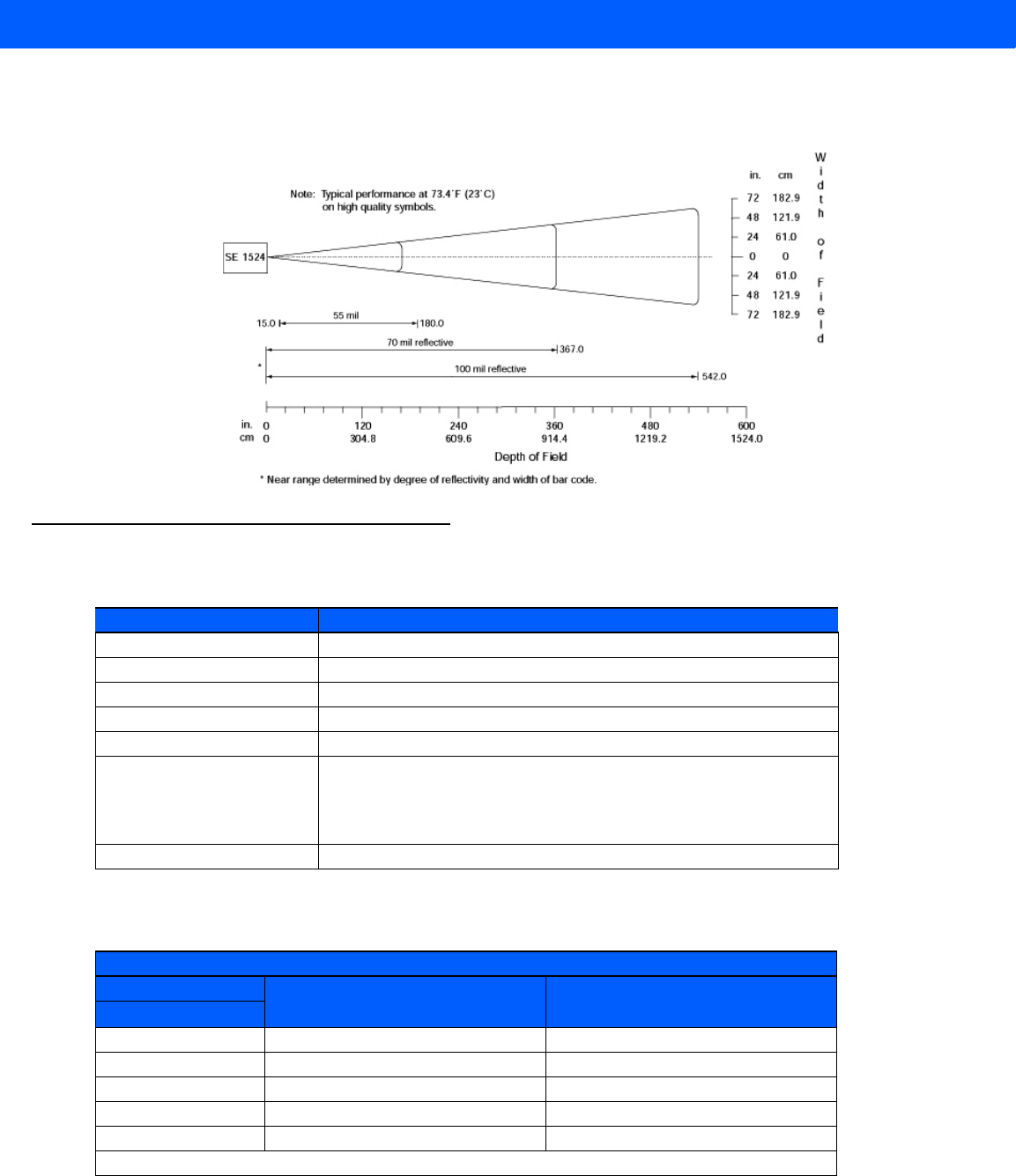
D - 6 Omnii Hand-Held Computer with Windows CE 6.0 User Guide
SE1524ER Decode Zone B (Long Range, Large Codes)
EV15 Imager
EV15 Imager Decode Zone
Parameter Specification
Light Source 617 nm highly visible LED
Scan Angle 40º
Minimum Print Contrast Minimum 25%
Minimum X. Dimension 0.1 mm (4 mils)
Reading Distance Up to 90 cm (35 in)
Symbologies UPC (E&A), EAN, RSS, Code 39, Code 128, UCC/EAN 128,
ISBN, ISBT, Interleaved, Matrix, Industrial and Standard 2 of 5,
Codabar, Code 93/93i, Code 11, MSI, Plessey, Telepen, PDF417,
Micro PDF417
Ambient Light Works in any lighting conditions, from 0 to 100,000 lux
0 Lux to 100,000 Lux
Minimum Range
Inches
Maximum Range
Inches
Mil Size
52.5 7
10 3 14
UPC 2 14.5
20 2.5 22
40 3 35.5
High quality symbols in normal room light.
Draft #4 for review
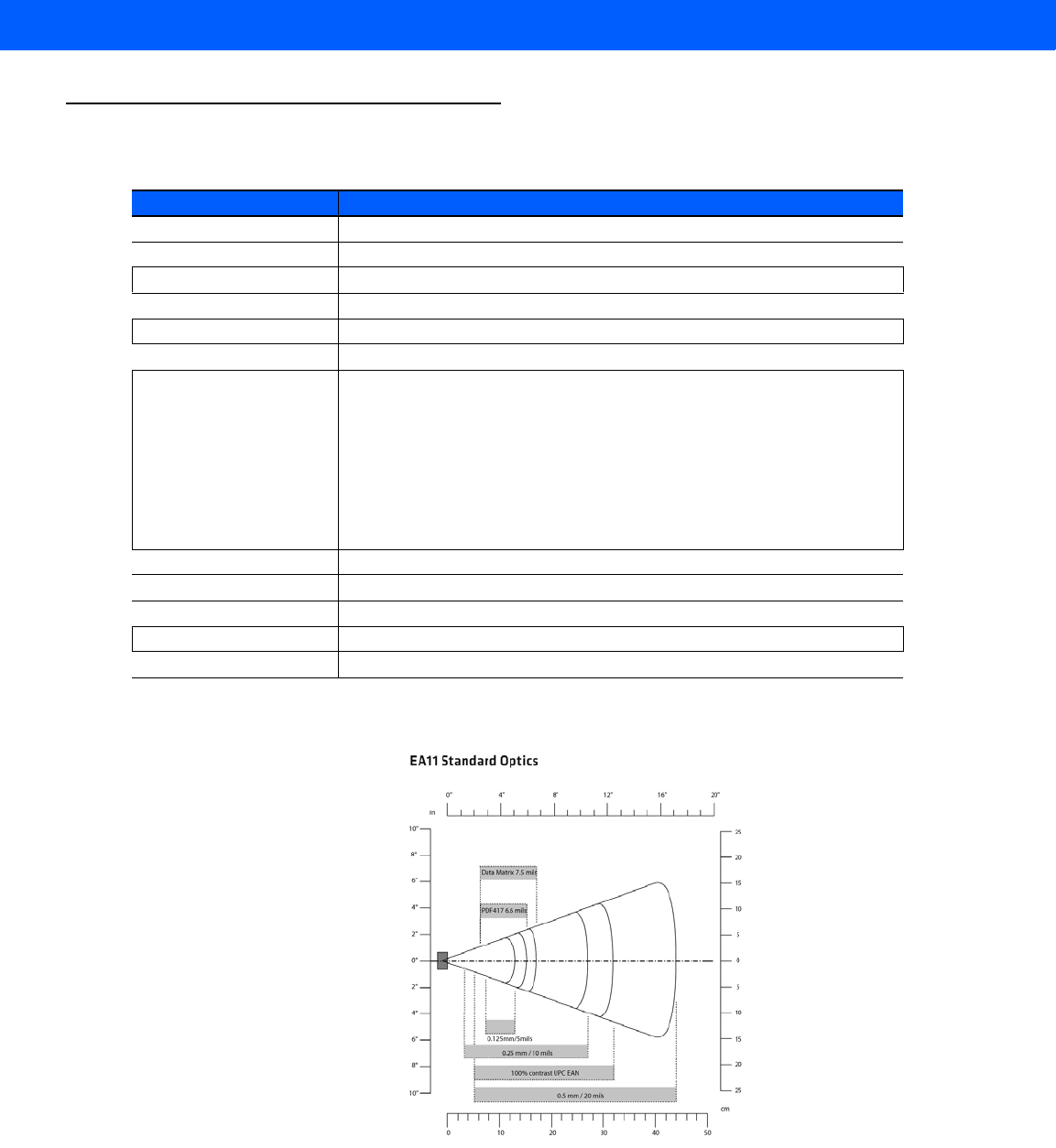
Internal Imager & Scanner Specifications D - 7
EA11 Decoded 2D Imager
EA11 Typical Reading Distances
Parameter Specification
Scan Rate 2D mode: 56 images/s auto adaptive
Linear Emulation Mode 200 scans/s auto adaptive
Scan Angle 38.9° (horizontal), 25.4° (vertical)
Optical Resolution 752 (H) x 480 (V) pixels, 256 gray levels
Print Contrast down to 25%
Versions Standard range
Symbologies - 1D
Symbologies - 2D
EAN/UPC, GS1 Databar (limited expanded & omni-directional), RSS,
Code 39, Code 128, UCC/EAN 128, ISBN, ISBT, Interleaved/Matrix/
Industrial and Standard 2 of 5, Codabar, Code 93/93i, Code 11, MSI,
Plessey, Telepen, postal codes (Australian Post, BPO, Canada Post,
Dutch Post, Japan Post, PostNet, Sweden Post)
Data Matrix, PDF417, Micro PDF 417, Codablock Maxicode, QR,
Aztec GS1 composite codes
Voltage (optics) 3.3V -5% / +10% (typical values)
Operating Current 170mA - 310mA (lighting condition dependent)
Power Saving Mode 2mA
Ambient Light Works in any lighting conditions, from 0 to 100,000 lux
Regulatory Approvals UL, VDE certified, RoHS compliant
Draft #4 for review
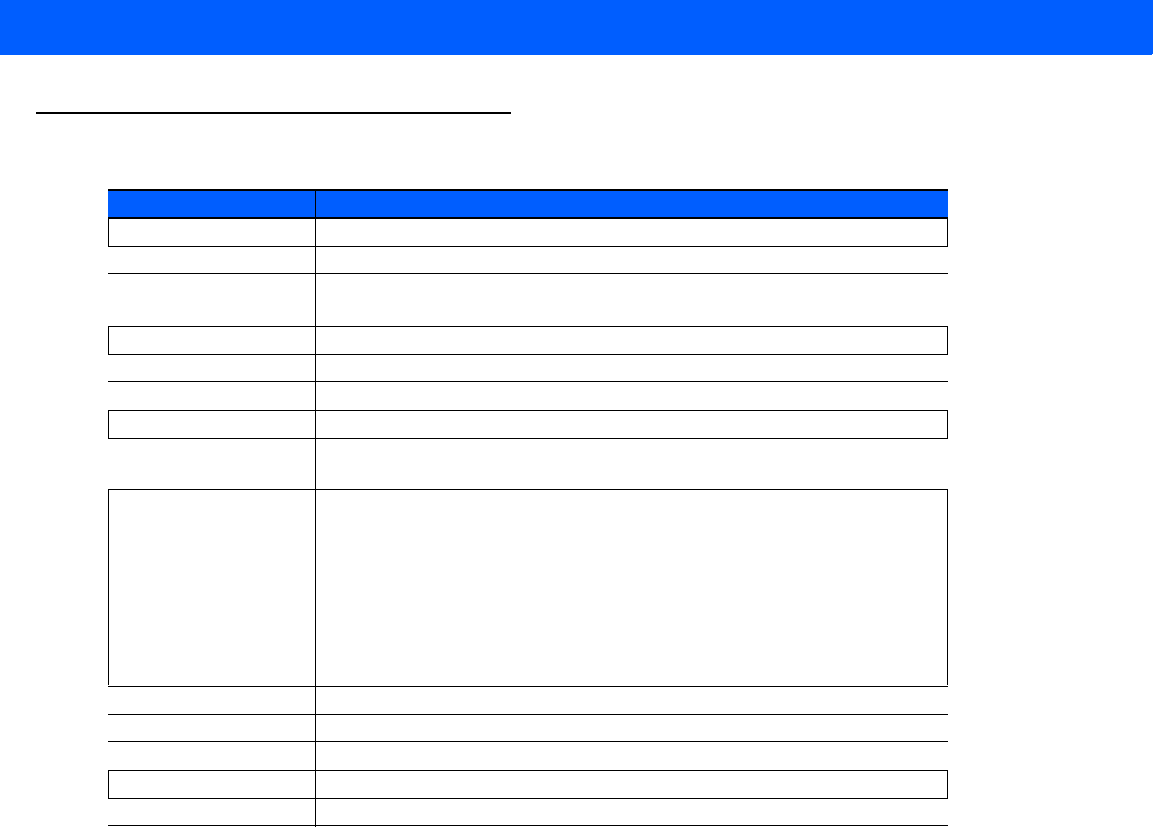
D - 8 Omnii Hand-Held Computer with Windows CE 6.0 User Guide
EA20X Imager
Parameter Specification
Light Source 617nm highly visible LED, 650nm laser framing/aiming
Scan Rate 2D mode: 60 images/s auto adaptive
Linear Emulation
Mode 200 scans/s auto adaptive
Scan Angle 26.0° (horizontal), 16.8° (vertical)
Framing Angles 25.0° (horizontal), 16.0° (vertical)
Optical Resolution 752 (H) x 480 (V) pixels, 256 gray levels
Print Contrast down to 30% on 1D, 35% on 2D
Minimum Resolution 1D symbologies 0.15 mm (6 mil), Stacked (PDF417) 0.17 (6.6 mil) and
2D matrix 0.18 (7mil)
Symbologies - 1D
Symbologies - 2D
EAN/UPC, GS1 Databar (limited expanded & omni-directional), RSS,
Code 39, Code 128, UCC/EAN 128, ISBN, ISBT, Interleaved/Matrix/
Industrial and Standard 2 of 5, Codabar, Code 93/93i, Code 11, MSI,
Plessey, Telepen, postal codes (Australian Post, BPO, Canada Post,
Dutch Post, Japan Post, PostNet, Sweden Post)
Data Matrix, PDF417, Micro PDF 417, Codablock Maxicode, QR,
Aztec GS1 composite codes
Voltage 3.3V± 5%
Operating Current 410mA @ 3.3V scanning with power save
Power Saving Mode 7mA
Ambient Light From 0 to 100,000 lux
Regulatory Approvals UL, cUL, VDE certified, RoHS compliant, Class 2 Laser
Draft #4 for review
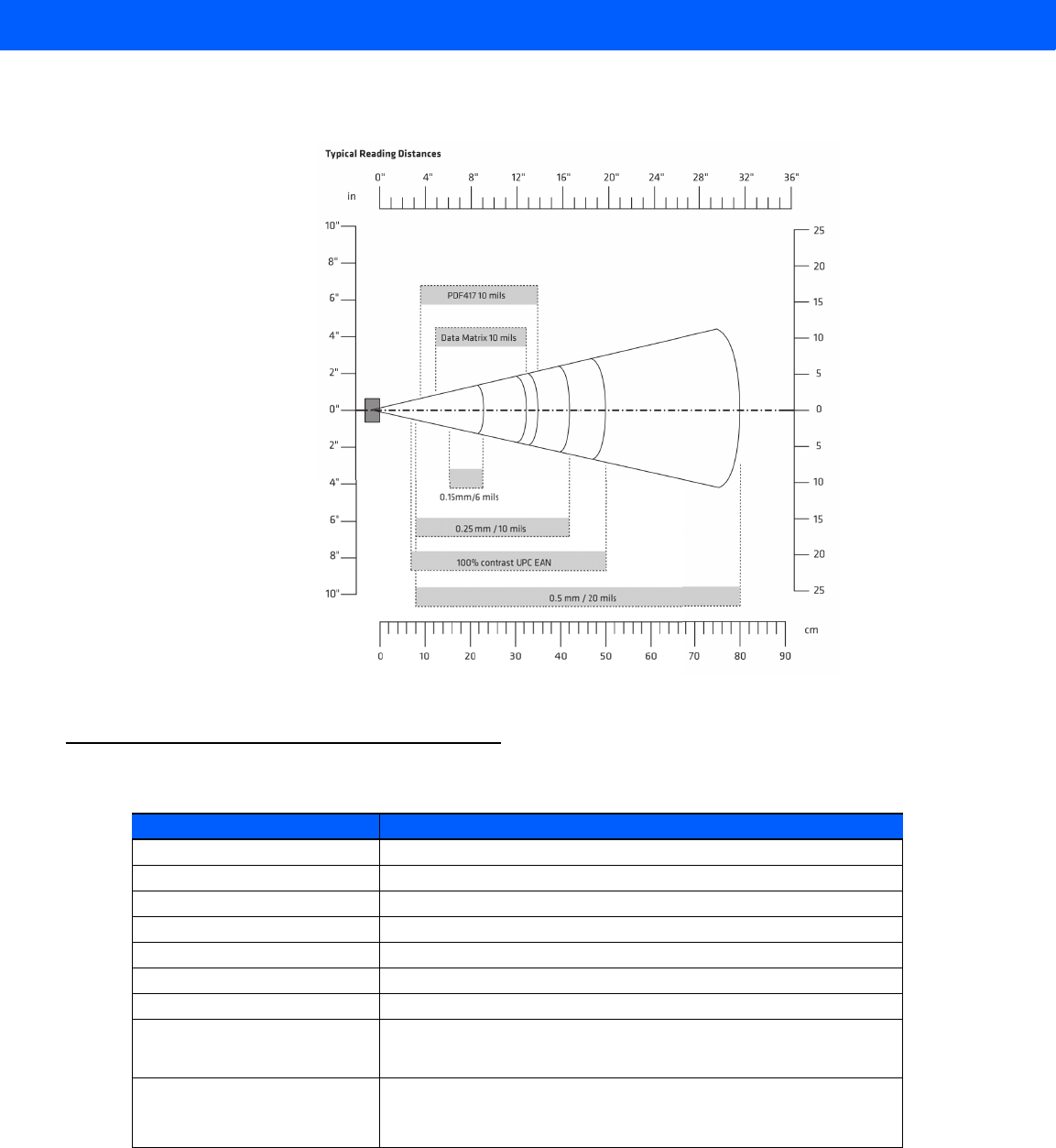
Internal Imager & Scanner Specifications D - 9
EA20X Typical Reading Distances
HHP 5080SR Imager/Decoder
Parameter Specification
Focal Point - SR 7 inches (17.8 cm) from lens plate
Image Sensor 752 x 480 CMOS sensor
Motion Tolerance 4 inches per second
Rotational Sensitivity 360°
Viewing Angle ±40°
Ambient Light Total darkness to 100,000 lux (full sunlight)
Illumination LEDs 626 nm ± 30 nm
Aiming LEDs: 526 nm ± 30 nm
Laser: 650 nm ± 10 nm
Input Voltage - Imager
Input Voltage - HHP 5080
3.3 VDC ± 5% (23°C)
3.0 VDC to 5.5 VDC (23°C)
Draft #4 for review
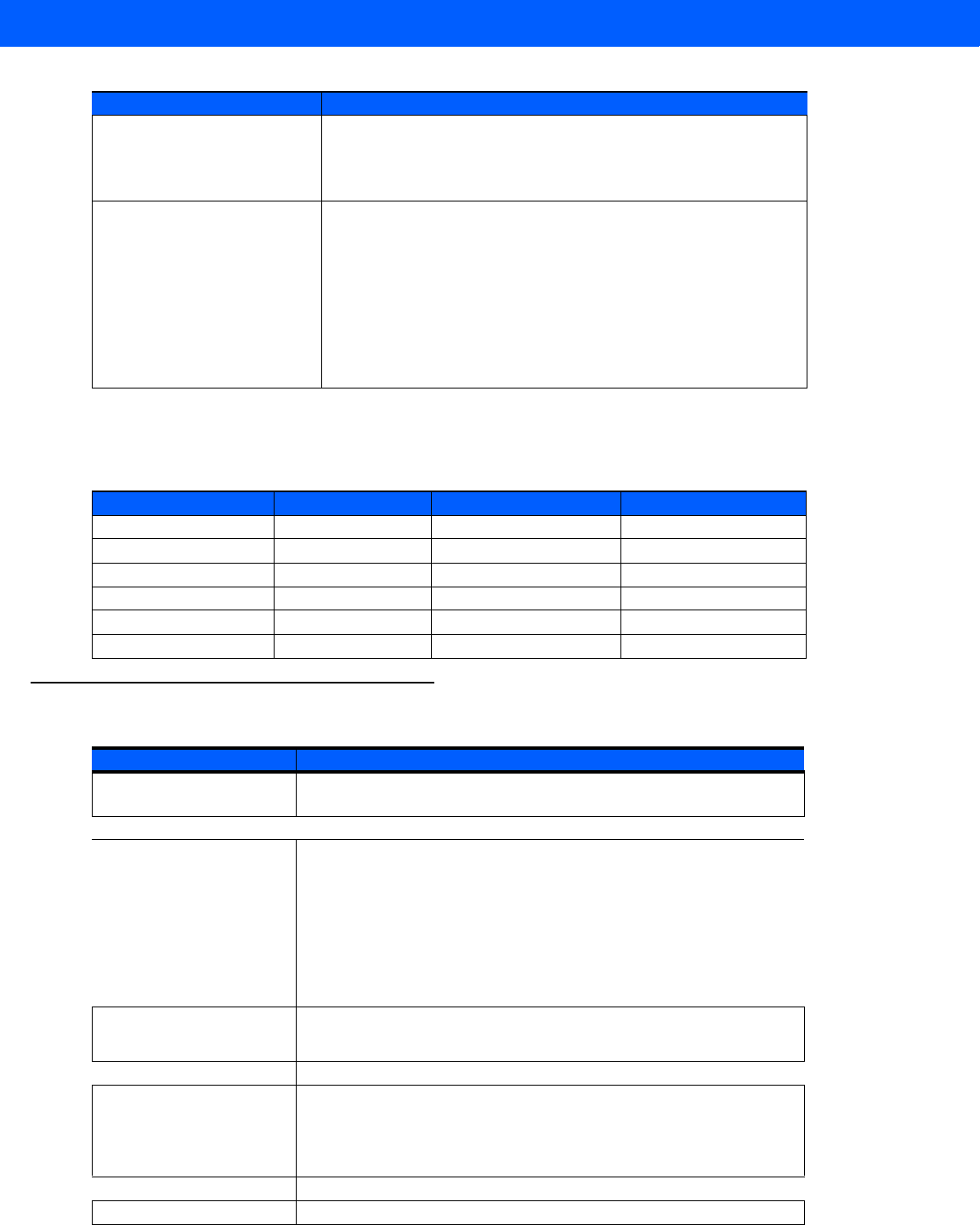
D - 10 Omnii Hand-Held Computer with Windows CE 6.0 User Guide
HHP 5080SR Working Range
Data is characterized at 23°C (73.4°F) and 0 lux ambient light.
SE4500SR – Standard Range Imager
Current Draw - Imager
Current Draw - HHP 5080
Max. Operating Current: 100 mA; Standby Current: 100 µA
Average Current (Interlaced Mode): 510 mA;
Standby Current: 120 µA; Peak: 600 mA
Symbologies:
2 Dimensional
Linear
Postal
PDF417, MicroPDF417, MaxiCode, Data Matrix, QR Code,
Aztec, Aztec Mesa, Code 49, UCC Composite
Code 39, Code 128, Codabar, UPC, EAN, Interleaved 2 of 5,
Reduced Space Symbology, Code 93, Codablock
Postnet (US), Planet Code, BPO 4 State, Canadian Post,
Japanese Post, KIX (Netherlands) Post
Parameter Specification
Symbology Size (mil) Near Far
Linear 8.3 (.020cm) 3.5 in. (8.9cm) 7.6 in. (19.3cm)
PDF417 10 (.025cm) 3.1 in. (7.9cm) 9 in. (22.9cm)
UPC 13 (.033cm) 2.1 in. (5.3cm) 13.2 in. (33.5cm)
Data Matrix 15 (.038cm) 2.3 in. (5.8cm) 10.2 in. (25.9cm)
QR 15 (.038cm) 3.1 in. (7.9cm) 8.8 in. (22.4cm)
MaxiCode 35 (.089cm) 2.0 in. (5.1cm) 13.0 in. (33cm)
Parameter Specification
Power Requirements -
Input Voltage 3.3 V ± 0.3 V at 23° C
Operating Mode Supply Currents (3.3VDC at 23° C):
Low Power
Idle
Image Acquisition
Illumination Enabled
Maximum Operating
Current
500 µA
18 mA
80 mA
200 mA
250 mA (aiming on during exposure, illumination enabled)
Maximum Sensor Power
Supply Noise* (at 23° C) 100 mVp-p (3.3 V, 10 Hz - 100 kHz) for decoding
30 mVp-p (3.3 V, 10 Hz - 100 kHz) for image capture
Optical Resolution 5.0 mil (Code 39), 6.7 mil (PDF417)
Specular Dead Zone:
Illumination On
Illumination Off
Up to 20º depending on target distance and substrate glossiness
None
Skew Tolerance ± 60º
Pitch Angle ± 60º
Draft #4 for review
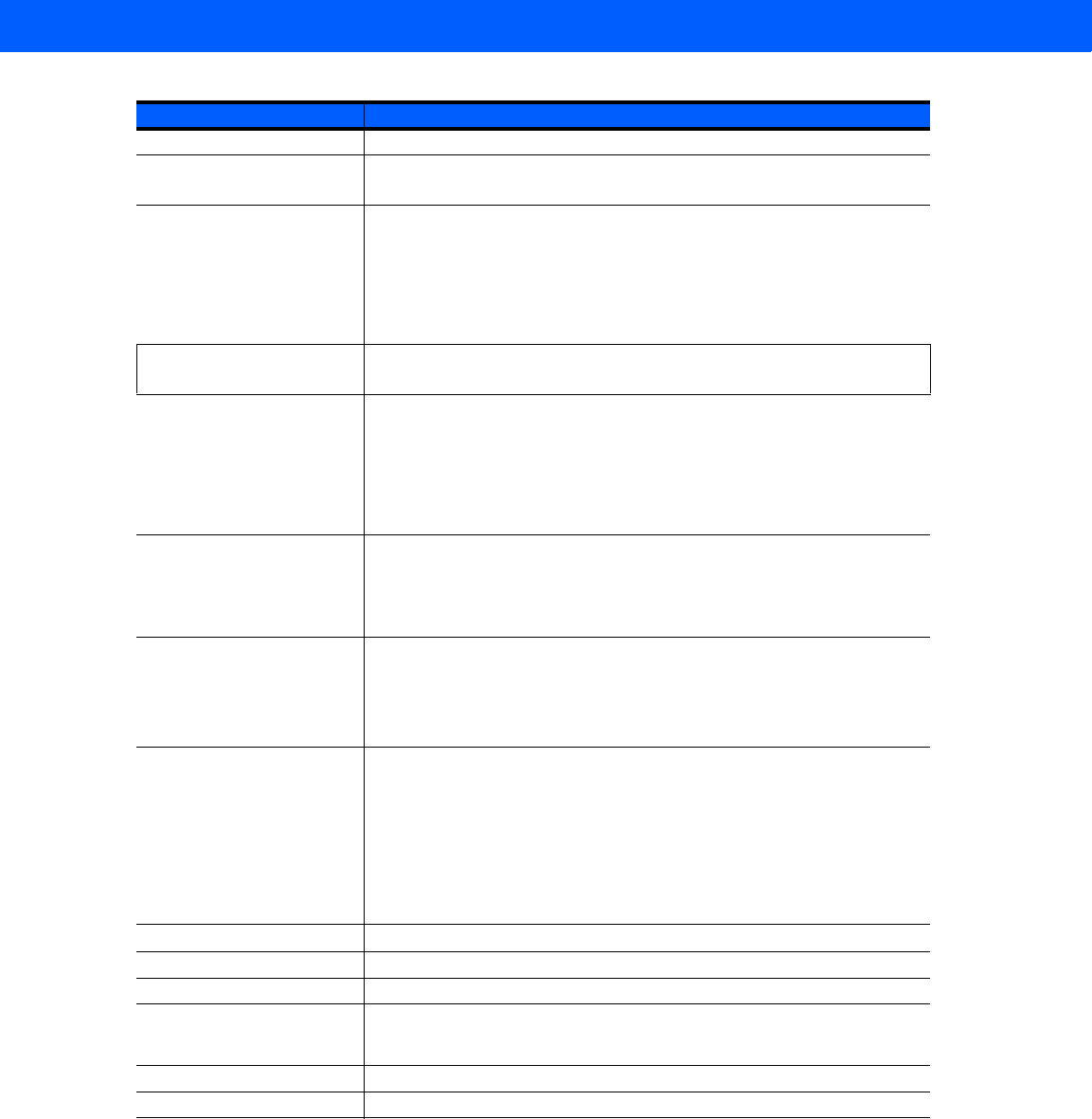
Internal Imager & Scanner Specifications D - 11
Roll 360º
Ambient Light Immunity
(Sunlight) 9000 ft. candles (96,900 lux)
Imaging Sensor:
Image Resolution
Grey Scale
Field of View (FOV)
752 H x 480 V pixels (Wide VGA)
256 levels (8 bits per pixel)
SE4500-SR: 39.6º horizontal, 25.7º vertical
Focusing Distance from
Front of Engine (SR) 8 in. / 20.3 cm
Aiming Element:
Visible Laser Diode (VLD)
Central Dot Optical Power
Pattern Angle
655 ± 10 nm
0.6 mW (typical)
40º horizontal, 30º vertical
Illumination System:
LEDs
Pattern Angle
625 ± 5 nm (dominant wavelength)
60º x 40º at 80% center intensity
Shock 2000 G ± 5% applied via any mounting surface at -30º and 55º C
for a period of 0.85 ± 0.05 msec
2500 G ± 5% applied via any mounting surface at 23º C for a
period of 0.85 ± 0.05 msec
Vibration Unpowered SE4500 withstands a random vibration along each of
the X, Y, and Z axes for a period of one hour per axis (6 G rms),
defined as follows:
20 to 80 Hz Ramp up at 0.04 G2/Hz at 3 dB/octave
80 to 350 Hz 0.04 G2/Hz
350 Hz to 2 kHzRamp down at 0.04 G2/Hz at 3 dB/octave
ESD ± 2 kV @ connector
Laser Safety Class CDRH / IEC Class 2
LED Class IEC Class 1M
Maximum Engine Dimen-
sions 11.8 mm H x 21.50 mm W x 16.3 mm D
0.46 in. H x 0.85 in.W x 0.64 in. D
Weight 8.0 grams (0.28 oz)
Electrical Interface 21 pin 0.3 mm pitch ZIF connector
Parameter Specification
Draft #4 for review
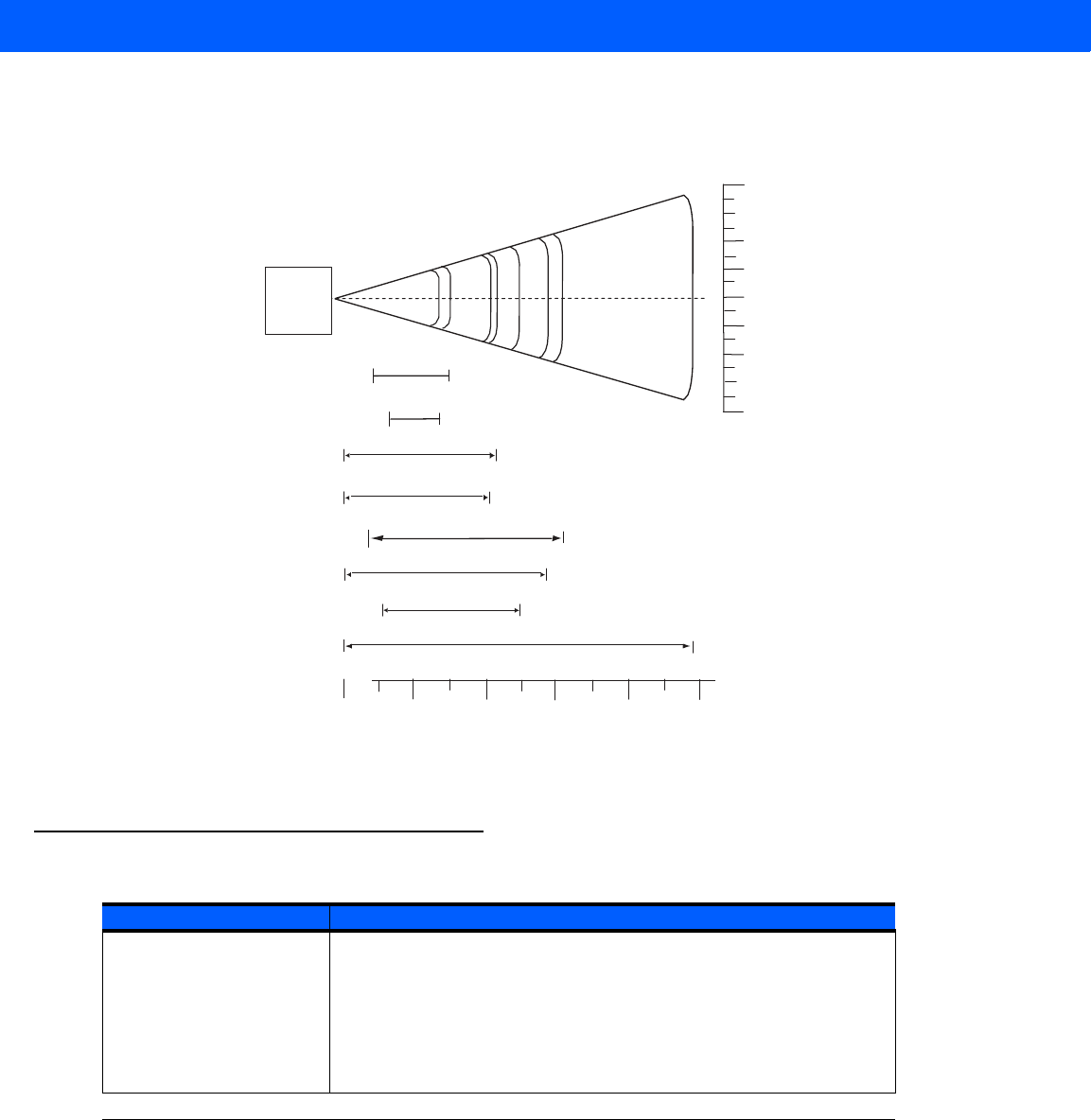
D - 12 Omnii Hand-Held Computer with Windows CE 6.0 User Guide
SE4500SR Decode Zone
SE4600LR – Long Range Imager
In. 0
5
10
15
20 25
cm 012.7 25.4 38.1 50.8 63.5
7.5
7.1
15.5
SE4500-SR
in.
9
4.5
0
cm
22.9 W
i
d
11.4
t
h
o
0
f
2.1
5mil
Code
39
F
4.5 11.4
i
e
6.67
mil PDF417
3.4
7.5
mil
Code 39
*
10.6
l
922.9 d
*
10
mil PDF417 10.1
1.6
13
mil
(100% UPC)
*
15
mil PDF417 14.7
2.8
15
mil
Data
Matrix
12.4
20
mil
Code 39
*
Depth
of
Field
24.7
Parameter Specification
Input Voltages
VCC
VCC_INTFC
VCC_ILLUM
VCC_SENSOR
3.3 V ±10%, 75 mA max
1.8 V ±10% or 3.3 V ±10%, 30 mA max
3.0 V - 8.4 V, 800 mA
3.3 V ±10%, 70 mA max
VCC=VCC_SENSOR=VCC_INTFC =3.3 V VCC_ILLUM=5.0 V
Draft #4 for review

Internal Imager & Scanner Specifications D - 13
Operating Mode Supply
Currents (Average)
Low Power
Idle
Aim enabled, no illumina-
tion or image acquisition
Image Acquisition
Illumination Enabled
Illumination and Aim
Enabled
Low Power
750 µA
750 µA
20 mA
70 mA
80 mA
550 mA
600 mA
Maximum Sensor Power
Supply Noise*
(VCC_SENSOR)
40 mV p-p (10 Hz - 50 KHz) and
100 mV p-p (50KHz - 100 KHz) for bar code decoding
30 mV p-p (10 Hz - 100 KHz) for image capture
Optical Resolution Near sensor: 5 mil (Code 39), 10 mil (Data Matrix)
Far sensor: 15 mil (Code 39), 35 mil (Data Matrix)
Specular Dead Zone:
Illumination On
Illumination Off
Up to 20º depending on target distance and substrate glossiness
None
Skew Tolerance ± 60º
Pitch Angle ± 60º
Roll 360º
Ambient Light Immunity
(Sunlight) 9000 ft. candles (96,900 lux)
Imaging Sensor:
Image Resolution
Grey Scale
Field of View (FOV)
752 H x 480 V pixels (wide VGA)
256 levels (8 bits per pixel)
SE4600LR Far System: 11.6º horizontal, 7.4º vertical
SE4600LR Near System: 13º horizontal, 8.3º vertical
Aiming Element:
Visible Laser Diode (VLD)
Aiming Dot Optical Power
655 ±5 nm (dominant wavelength)
0.6 mW (typical)
Illumination System:
LEDs
Pattern Angle
625 ± 5 nm (dominant wavelength)
16º horizontal x 11.5º vertical
Shock 2000 G ± 5% in the direction of any of the six principal axes applied
via the mounting surface at -20º and 55º C for a period of 0.85 ±
0.1 msec
2500 G ± 5% in the direction of any of the six principal axes applied
via the mounting surface at 23º C for a period of 0.70 ± 0.07 msec
Parameter Specification
Draft #4 for review
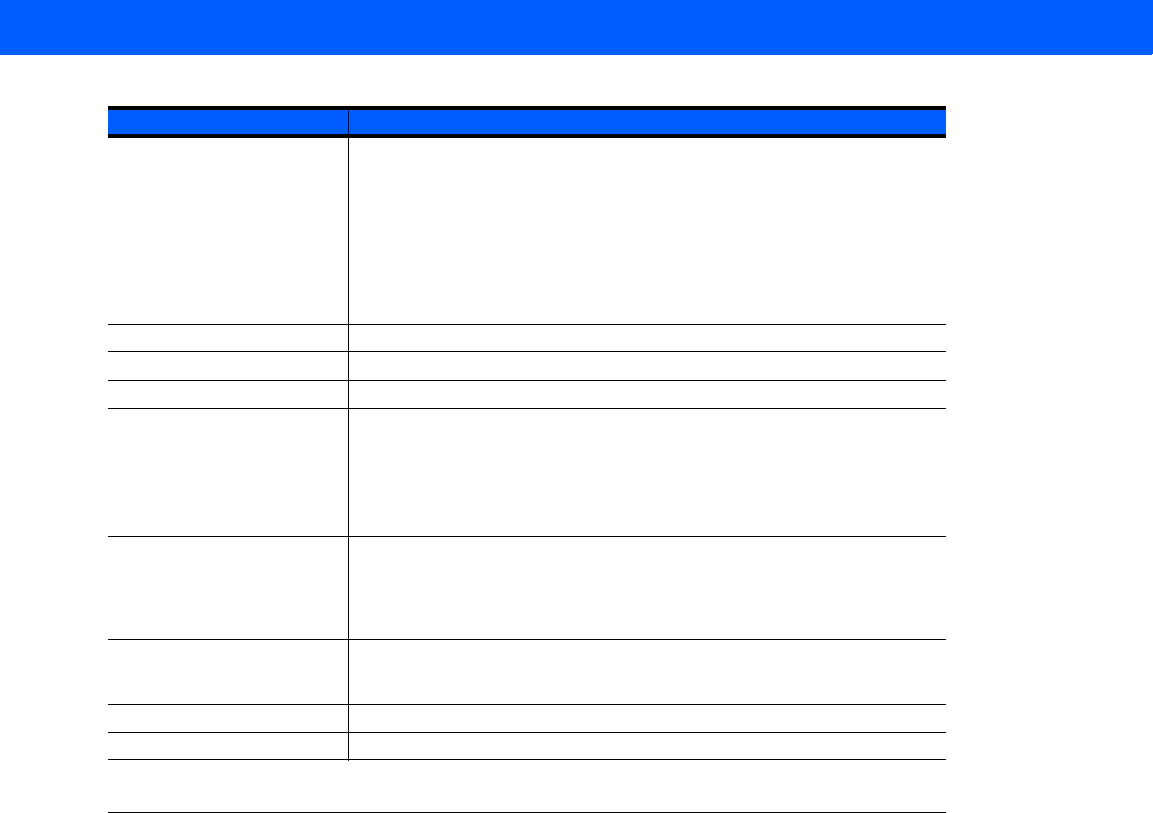
D - 14 Omnii Hand-Held Computer with Windows CE 6.0 User Guide
Vibration Unpowered SE4600LR withstands a random vibration along each
of the X, Y, and Z axes for a period of one hour per axis (6 G rms),
defined as follows:
20 to 80 HzRamp up at 0.04 G2/Hz at 3 dB/octave
80 to 350 Hz 0.04 G2/Hz
350 Hz to 2 kHz Ramp down at 0.04 G2/Hz at 3 dB/octave
ESD ± 2 kV @ connector
Laser Safety Class CDRH / IEC Class 2
LED Class IEC Class
Temperature:
Operating
Storage
-20º to 55º C (-4º to 131º F)
-40º to 70º C (-40º to 158ºF)
(-30º C (22º F) for Omnii XT15f Arctic variant)
Humidity:
Operating)
Storage
95% RH, non-condensing at 55º C
85% RH, non-condensing at 70º C
Maximum Engine Dimen-
sions 38.23 mm W x 19.34 mm H x 27.00 mm D
1.51 in. W x 0.76 in. H x 1.06 in. D
Weight 45 - 52 grams (1.59 - 1.83 oz)
Electrical Interface 27 pin 0.3 mm pitch ZIF connector
NOTE: Environmental and/or tolerance parameters are not cumulative. A thermal analysis is
recommended if the application is subject to an extreme temperature environment.
Parameter Specification
Draft #4 for review
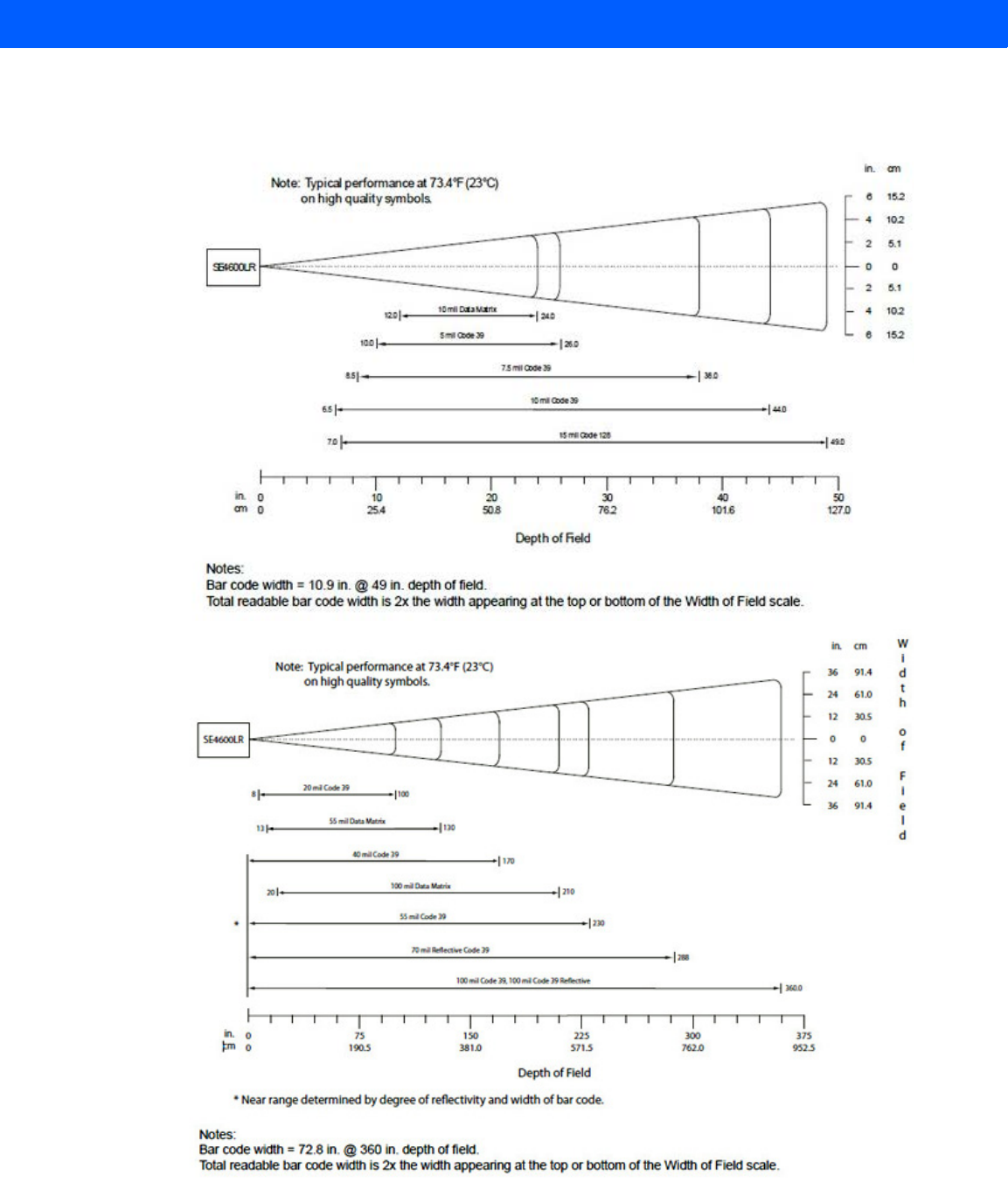
Internal Imager & Scanner Specifications D - 15
SE4600LR Decode Zones
Draft #4 for review
Draft #4 for review

APPENDIX E OMNII SPECIFICATIONS
EOmnii Specifications
The Omnii Hand-Held Computer (Model 7545)
Hardware
Physical Dimensions
• Width: At display: 100 mm (3.94 in)
At docking connector: 45 mm (1.77 in)
• Depth: At display: 44 mm (1.73 in)
At docking connector: 45 mm (1.77 in)
At grip area: 31 mm (1.22 in)
• Weight: Basic unit with battery: 610g (1.34 lb)
With battery, high visibility display, camera, Push-To-Talk speaker, EV15 1D imager: 636g (1.40 lb)
Processor and Memory
• Texas Instruments® Sitara AM37xx, ARM Processor 800 MHz (OMAP3® compatible)
• RAM: 512 MB
• Flash ROM: 1 GB
Operating System
• Microsoft Windows® Embedded CE 6.0
User Interface
• Colour/Touch Display: 9.4 cm (3.7 in) diagonal.
NOTE For Omnii freezer unit hardware specifications, please go to Appendix F: Omnii XT15f Freezer
Variants.
NOTE Performance specifications are nominal and subject to change without notice.
Draft #4 for review

E - 2 Omnii Hand-Held Computer with Windows CE 6.0 User Guide
VGA (640 x 480) Transflective.
High Visibility option: superior sunlight visibility with 165 cd/m2 brightness.
Extreme Duty option: withstands 1.25 Joule impact, superior low temperature operation (to -20° C/-4° F),
with 160 cd/m2 brightness. Better abrasion resistance.
• Keyboards: High reliability keypad ultra-white backlight.
Large selection of both alpha and numeric formats. See:
http://www.motorolasolutions.com/US-EN/Product+Lines/Psion/?WT.mc_id=psion_us_p_handheld
for a list of available configurations.
• Indicators and Controls: Four multi-colour LEDs indicate the status of the battery, application, radio,
and scanner.
• Side Buttons: Volume, Scan, Enter, Vertical Scroll.
• Voice, Audio & Feedback: High volume beeper: 95 dBA.
Integrated Microphone and speaker.
Optional Push-to-Talk speaker.
Walkie-talkie style Push-to-Talk – VoIP over Wi-Fi or WWAN.
Vibration feedback.
Power Management
• Battery Pack: 5000 mAh high capacity Lithium-ion (for battery specifications, see Lithium-ion Smart Battery
5000 mAh (ST3003) on page E-3).
Expansion Ports
• MicroSD slot for Flash expansion (up to 32 GB).
• Multiple Internal Multi-Function Expansion Interfaces with:
- TTL serial
- USB host
- GPI0
Camera (optional)
•Colour.
• 3 Megapixel.
• Autofocus.
• 4x digital zoom.
• Dual LED flash.
• Video capable.
Enhanced Features
• 3 axis accelerometer.
•GPS.
•Compass.
Draft #4 for review
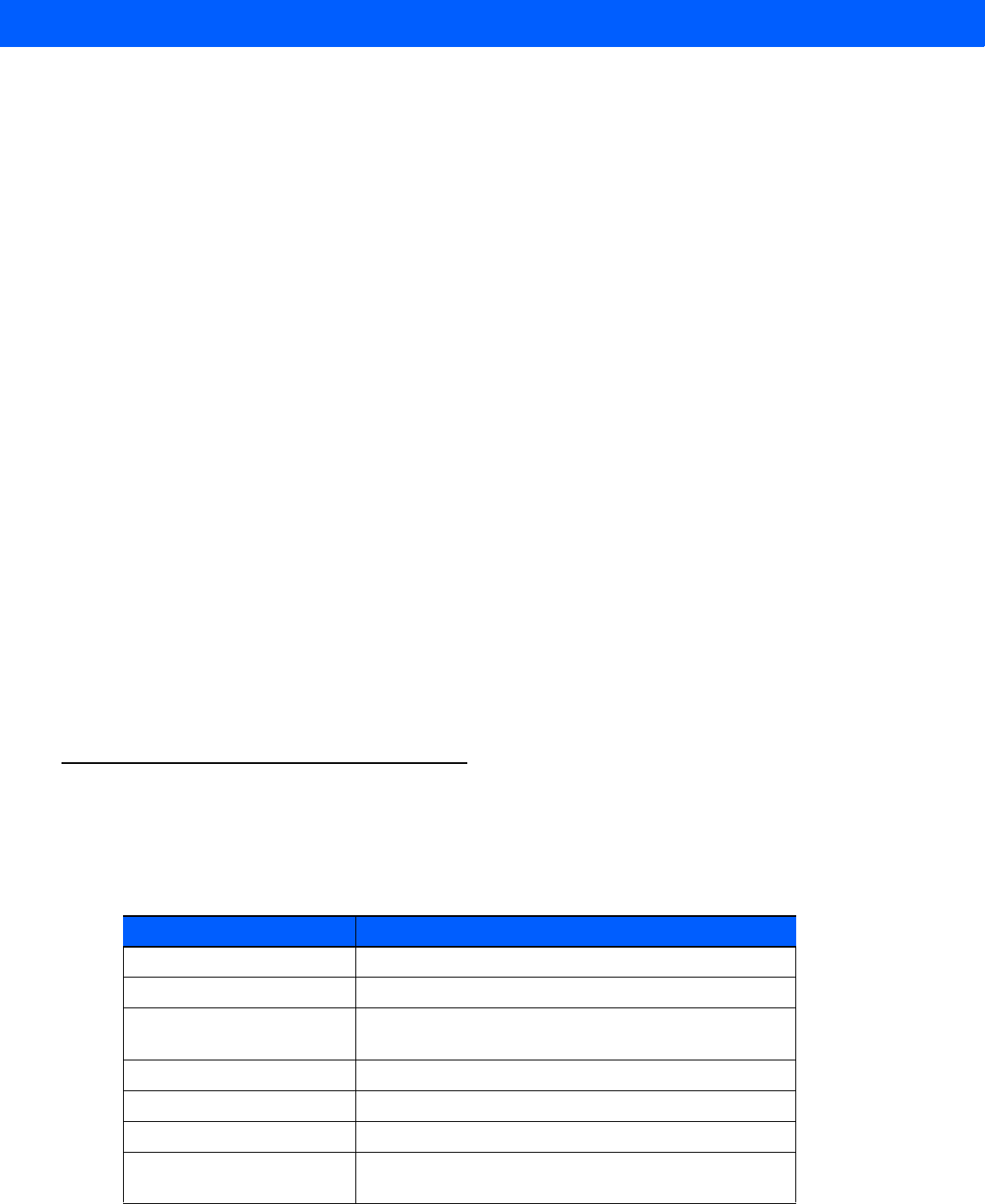
Omnii Specifications E - 3
Environmental
• Operating Temperature: -20°C to +50°C (-4°F to +122°F)
• Storage Temperature: -40°C to +60°C (-40°F to +140°F)
• Humidity: 5% to 95% RH non-condensing.
• ESD: +/- 8 kV contact, +/- 15 kV air discharge.
• Omnii RT15 Drop Durability:
1.5 m (5 ft.), 26 drops to polished concrete (powered on, with accessories); multiple 1.8 m (6 ft.) drops to
polished concrete.
Rain And Dust Resistance:
IEC 60529, classification IP65.
• Omnii XT15 Drop Durability:
1.7 m (5.6 ft.), 26 drops to polished concrete (powered on, with accessories); multiple 2.0 m (6.5 ft.) drops
to polished concrete.
Rain And Dust Resistance:
IEC 60529, classification IP67.
Regulatory Approvals
• Worldwide Safety, EMC, RF, Laser approvals
• CE Mark
• E Mark (vehicle cradles)
• RoHS compliant
• WEEE compliant
• REACH compliant
Lithium-ion Smart Battery 5000 mAh (ST3003)
For safety instructions, please see “Lithium-ion Battery Safety Precautions” in the Omnii Hand-Held Computer
Regulatory & Warranty Guide (PN 8000191).
Parameter Specification
Model Number ST3003
Chemistry lithium-ion (Li-Ion)
Capacity 5000 mAh nominal at 1000 mA discharge 20°C to 3.0 V
(min)
Voltage 3.7 V nominal (2.75 V min. to 4.2 V max.)
Cell Configuration 1 S2P (2 parallel connected cells)
Max. Charge Voltage 4.2 V +/- 1%
Recommended Charge
Termination Timeout 5.0 hr - charging must stop.
Draft #4 for review

E - 4 Omnii Hand-Held Computer with Windows CE 6.0 User Guide
Wireless Radios
Cinterion MC75i GSM/GPRS/EDGE Radio
Charge Temperature 0°C to +40°C (32°F to +104°F)
Discharge Temperature -20°C to +50°C (-4°F to +122°F)
Storage Temperature -20°C to +50°C (-4°F to +122ºF). Storage at elevated
temperatures not recommended.
25°C (77ºF) — recommended storage temperature.
Cycle Life 300 cycles minimum with no degradation below 70% of
nominal capacity based on 0.5C charge / 0.5C discharge
rates (to 3.0 V) @ 23°C (73.4ºF).
Parameter Specification
Parameter Specification
Manufacturer Cinterion, Model MC75i
Form Factor Quad-Band GSM 850/900/1800/1900 MHz
EDGE (E-GPRS) multi-slot class 12
GPRS multi-slot class 12
GSM release 99
Output Power Class 4 (2 W) for EGSM850
Class 4 (2 W) for EGSM900
Class 1 (1 W) for GSM1800
Class 1 (1 W) for GSM1900
Control via AT
Commands Hayes, 3GPP TS 27.007 and 27.005
Supply Voltage Range 3.2 to 4.3 V
EDGE Data Transmis-
sion EDGE class 12: max 236.8 kbps (downlink)
Mobile station class B
Modulation and coding scheme MCS 1-9
GPRS Data Transmis-
sion GPRS class 12
Mobile station class B
PBCCH support
Coding schemes CS 1-4
CSD Data Transmission Up to 14.4 kbps, V.110
Non-transparent mode
SMS Point-to-point MO and MT
Text and PDU mode
Draft #4 for review

Omnii Specifications E - 5
Cinterion PH8-P GSM/GPRS/EDGE/UMTS/HSPA+ Radio
Voice Triple-rate codec for HR, FR, and EFR
Adaptive multi-rate AMR
Basic hands-free operation
Echo cancellation
Noise reduction
Interfaces Hirose U.FL-R-SMT 50 ohm antenna connector
Antenna solder pad
Molex 80-pin board-to-board connector:
Power supply
Audio: 2x analog, 1x digital
Serial interface (ITU-T V.24 protocol)
SIM card interface 3 V, 1.8 V
Parameter Specification
Parameter Specifications
General
Frequency bands GSM/GPRS/EDGE: Quad band, 850/900/1800/1900MHz
UMTS/HSPA+: Five band, 800/850/900/1900/2100MHz
GSM class Small MS
Output power (according to
Release 99) Class 4 (+33dBm ± 2dB) for EGSM850
Class 4 (+33dBm ± 2dB) for EGSM900
Class 1 (+30dBm ± 2dB) for GSM1800
Class 1 (+30dBm ± 2dB) for GSM1900
Class E2 (+27dBm ± 3dB) for GSM 850 8-PSK
Class E2 (+27dBm ± 3dB) for GSM 900 8-PSK
Class E2 (+26dBm +3 /-4dB) for GSM 1800 8-PSK
Class E2 (+26dBm +3 /-4dB) for GSM 1900 8-PSK
Class 3 (+24dBm +1/-3dB) for UMTS 2100, WCDMA FDD Bd I
Class 3 (+24dBm +1/-3dB) for UMTS 1900,WCDMA FDD Bd II
Class 3 (+24dBm +1/-3dB) for UMTS 900, WCDMA FDD Bd VIII
Class 3 (+24dBm +1/-3dB) for UMTS 850, WCDMA FDD Bd V
Class 3 (+24dBm +1/-3dB) for UMTS 800, WCDMA FDD Bd VI
HSPA features
3GPP Release 6, 7 DL 14.4Mbps, UL 5.7Mbps
UE CAT. [1-6], 11, 12 supported
Compressed mode (CM) supported according to 3GPP TS25.212
Draft #4 for review
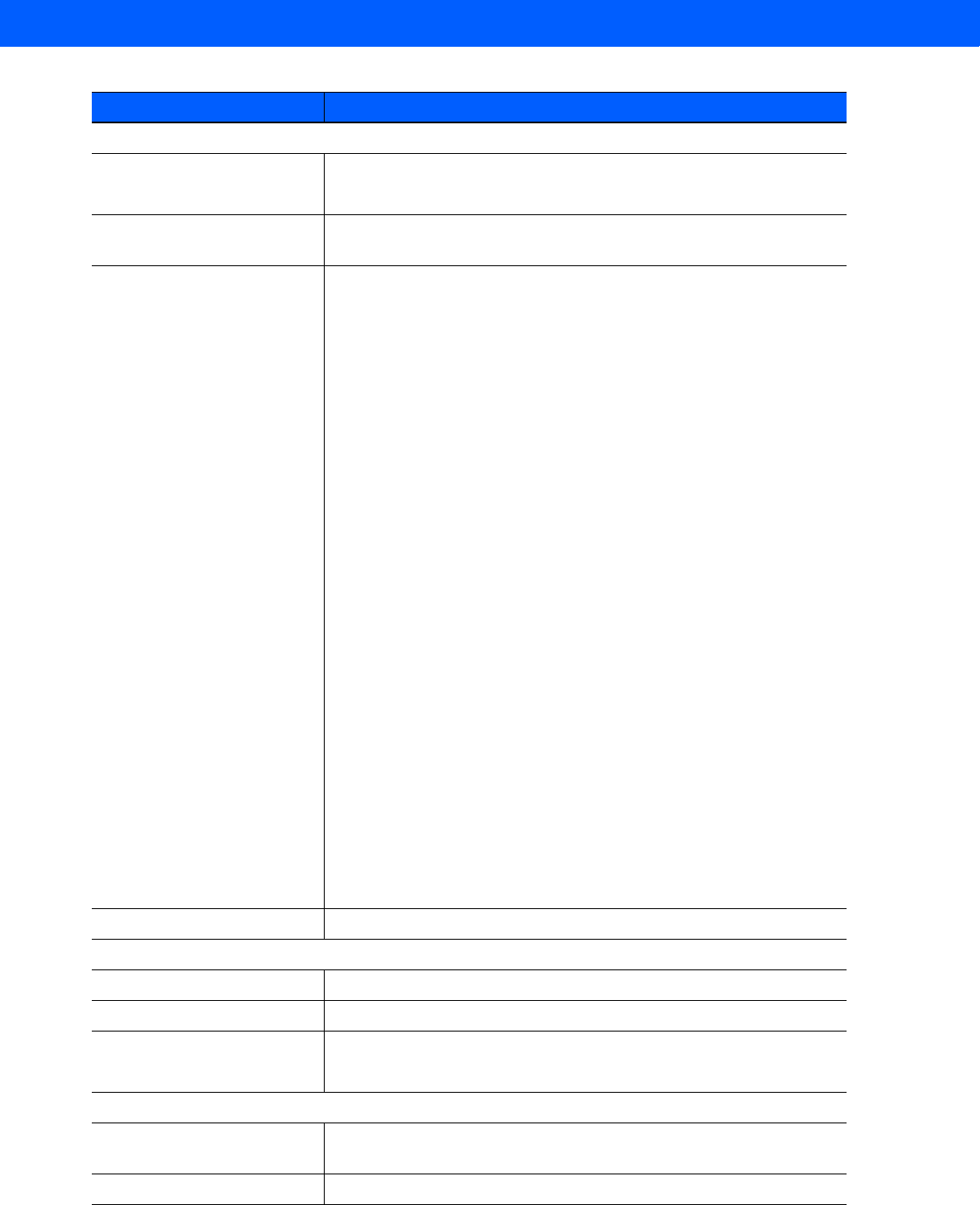
E - 6 Omnii Hand-Held Computer with Windows CE 6.0 User Guide
UMTS features
3GPP Release 4 PS data rate - 384 kbps DL / 384 kbps UL
CS data rate - 64 kbps DL / 64 kbps UL
GSM/GPRS/EGPRS
features
Data transfer GPRS:
• Multislot Class 10
• Full PBCCH support
• Mobile Station Class B
• Coding Scheme 1 - 4
EGPRS:
• Multislot Class 10
• EDGE E2 power class for 8 PSK
• Downlink coding schemes - CS 1-4, MCS 1-9
• Uplink coding schemes - CS 1-4, MCS 1-9
• SRB loopback and test mode B
• 8-bit, 11-bit RACH
• PBCCH support
• 1 phase/2 phase access procedures
• Link adaptation and IR
• NACC, extended UL TBF
• Mobile Station Class B
CSD:
• V.110, RLP, non-transparent
• 14.4kbps
• USSD
SMS Point-to-point MT and MO
GPS features
Protocol NMEA
Modes Assisted GPS (control plane AGPS, E911)
General Power saving modes
GPS tracking in parallel to 2G/3G diversity operation
Software
AT commands Hayes, 3GPP TS 27.007 and 27.005, and proprietary Cinterion
Wireless Modules commands
SIM Application Toolkit SAT Release 99
Parameter Specifications
Draft #4 for review
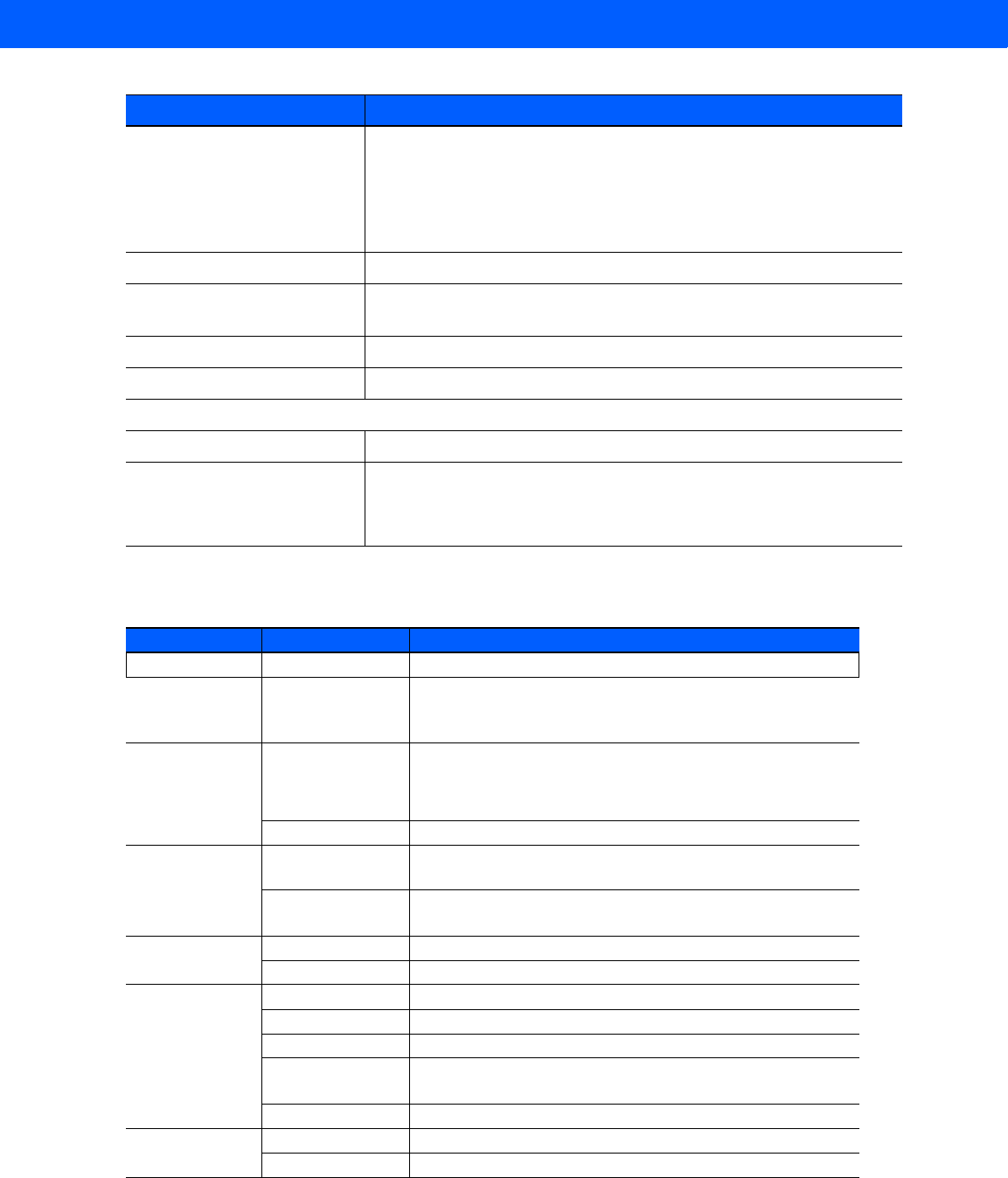
Omnii Specifications E - 7
Model RA2070 802.11a/b/g/n Radio
Audio Audio speech codecs
GSM: AMR, EFR, FR, HR
3GPP: AMR
Speakerphone operation, echo cancellation, noise suppression
Interfaces
Antenna 50Ohms. Main GSM/UMTS antenna, UMTS diversity antenna, GPS
antenna (active/passive)
USB USB 2.0 High Speed (480Mbit/s) device interface
UICC interface Supported chip cards: UICC/SIM/USIM 3V, 1.8V
Special features
Phonebook SIM and phone
Antenna SAIC (Single Antenna Interference Cancellation) / DARP (Downlink
Advanced Receiver Performance)
RX diversity type 3i
Parameter Specifications
Parameter Sub-parameter Specification
Manufacturer Model RA2070 (Murata, LBEH1Z9PFC)
Form Factor Embedded surface mount module, 11.4 x 9.4 mm
* This is a combo module containing both Wi-Fi
802.11a/b/g/n and Bluetooth V2.1+EDR radio
Antenna Port 802.11b/g/n U.FL jack. Non-diversity.
Multiplexed between 802.11b/g/n (2.4GHz) and Bluetooth
radio
802.11a/n U.FL jack. Non-diversity.
Antenna Type 802.11b/g/n PCB substrate patch antenna. Covers 2400-2484 MHz @
<2.5:1 VSWR
802.11a/n PCB substrate patch antenna. Covers 5150-5860 MHz @
<2.5:1 VSWR
Antenna Gain 802.11b/g/n 1.9 dBi
802.11a/n 1.9 dBi
Transmit Power 802.11b +18 dBm typical, +19.5 dBm max
802.11g +13 dBm typical, +14.5 dBm max
802.11a +12 dBm typical, +13.5 dBm max
802.11n (2.4
GHz) +12 dBm typical, +13.5 dBm max
802.11n (5 GHz) +12 dBm typical, +13.5 dBm max
Frequency
Range 802.11b/g/n 2400-2483.5 MHz
802.11a/n 5150-5350 MHz, 5480-5720 MHz and 5725-5845 MHz
Draft #4 for review
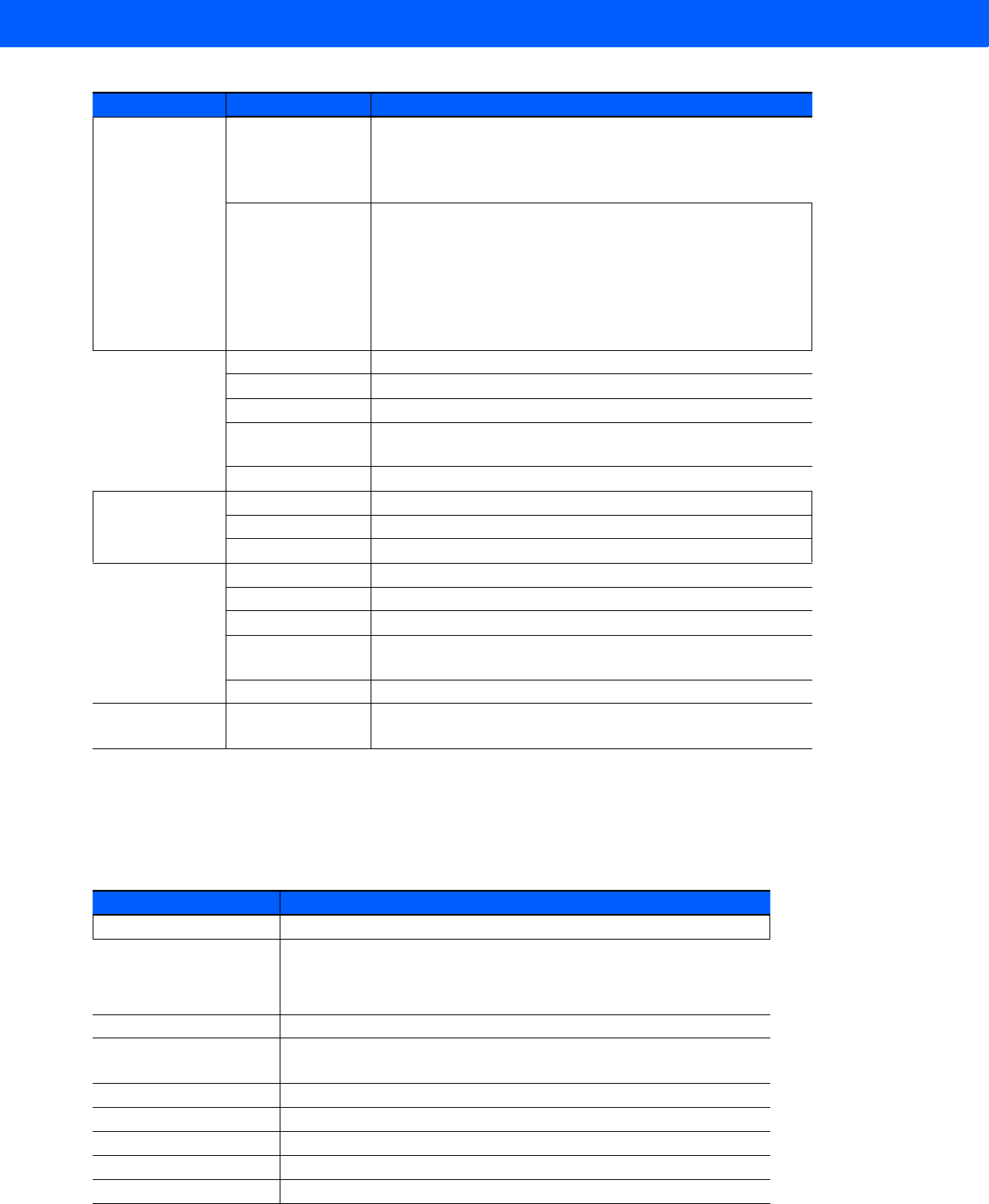
E - 8 Omnii Hand-Held Computer with Windows CE 6.0 User Guide
Bluetooth Radio
Channels 802.11b/g/n 1 to 13.
Up to 13 channels (depending on country).
Only 3 channels are non-overlapping.
802.11a/n 36, 40, 44, 48, 52, 56, 60, 64
100, 104, 108, 112, 116, 120, 124, 128, 132, 136, 140
149, 153, 157, 161, 165
Up to 24 channels (depending on country).
All channels are non-overlapping.
RX Sensitivity 802.11b -78 dBm @ 11 Mbps
802.11g -67 dBm @ 54 Mbps
802.11a -67 dBm @ 54 Mbps
802.11n (2.4
GHz) -66 dBm @ 65 Mbps
802.11n (5 GHz) -66 dBm @ 65 Mbps
Data Rates 802.11b 1, 2, 5.5, 11 Mbps
802.11a/g 6, 9, 12, 18, 24, 36, 48, 54 Mbps
802.11n 6.5, 13, 19.5, 26, 39, 52, 58.5, 65 Mbps
EVM 802.11b 32% max
802.11g -26 dB max
802.11a -26 dB max
802.11n (2.4
GHz) -29 dB max
802.11n (5 GHz) -29 dB max
Bluetooth Coex-
istence TI Wilink6 proprietary WiFi-BT co-existent scheme.
Parameter Sub-parameter Specification
Parameter Specification
Manufacturer Murata, Model LBEH1Z9PFC
Form Factor Embedded surface mount module, 11.4 x 9.4 mm
* This is a combo module containing both Wi-Fi 802.11a/b/g/n
and Bluetooth V2.1+EDR radio
Antenna Port U.FL jack (shared with Wi-Fi 802.11b/g/n radio)
Antenna Type PCB substrate patch antenna. Covers 2400-2484 MHz
@ <2.5:1 VSWR
Antenna Gain 1.9 dBi
Transmit Power 5 dBm typical, 6 dBm max
Frequency Range 2.400-2.4835 GHz
Channels 79
RX Sensitivity -90 dBm typical, -70 dBm max
Draft #4 for review
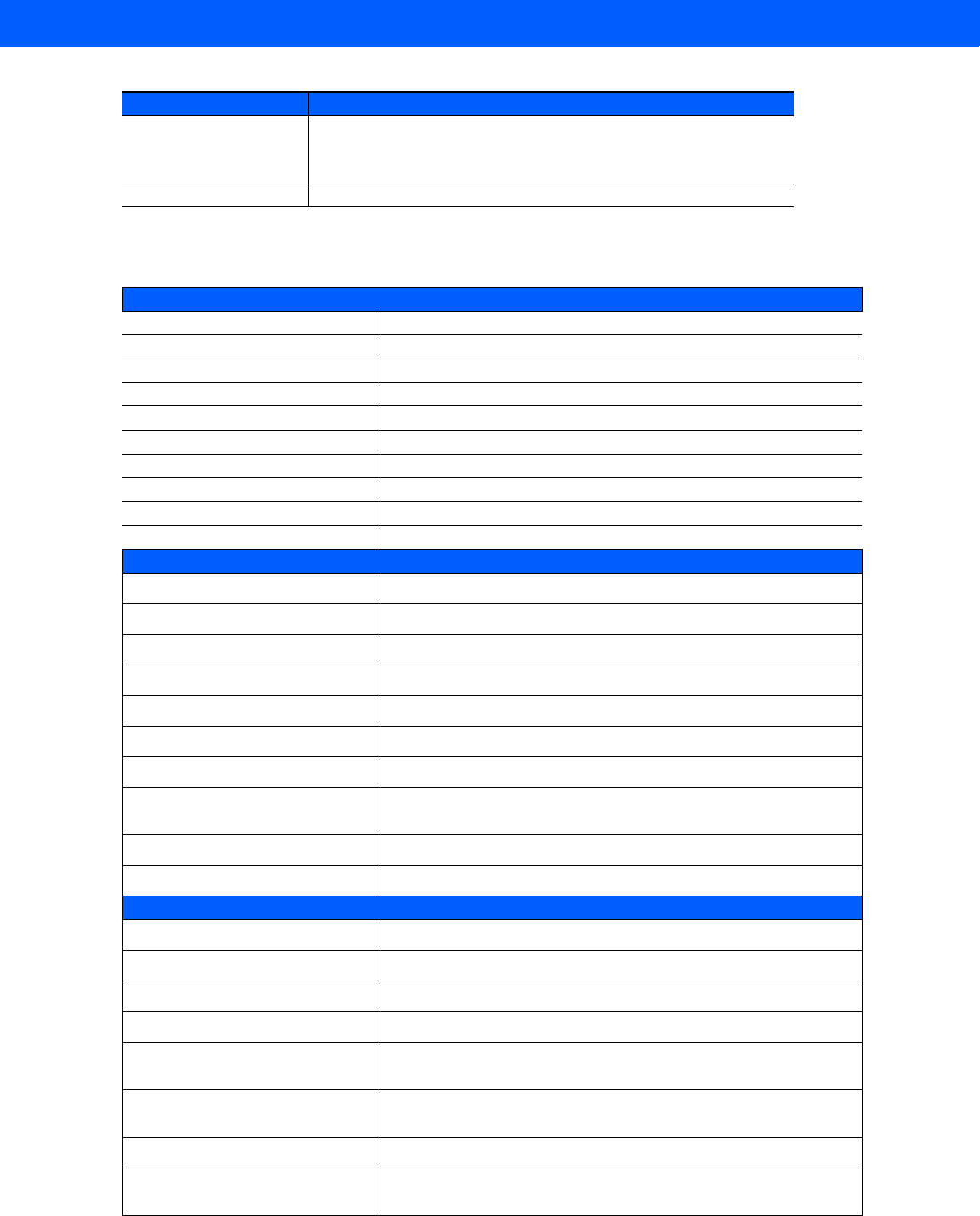
Omnii Specifications E - 9
RA1202 Narrowband Radio
Data Rates V1.2=732.2 kbps and 57.6 kbps asymmetric, 433.9 kbps
symmetric
V2.0=2 & 3 Mbps
802.11 Coexistence TI Wilink6 proprietary WiFi-BT co-existent scheme.
Parameter Specification
General Specifications
Radio Type Half-duplex data only
Dimensions Radio Module: 64 x 53 x 17 mm
Weight Radio module: 58 grams max
FCC Compliance and Approval FCC CFR47 Part 90 and Part 15, Industry Canada RSS-119
ETSI Compliance and Approvals ETSI EN 300-113
Frequency UHF Band I and II (403-435MHz, 435-470 MHz)
Power 3.2V-4.2V, 2.1A typ. during transmit
RF Antenna Interface U.FL connector 50 ohms
RX Sensitivity -90 dBm typical, -70 dBm max
Power and Data Interface 54-Pin Samtec ASP-176298-02
Transmitter
Frequencies 403-435 MHz (non-Canada), 435-470 MHz
Channel Spacing 25 kH, (non-US) 20 kHz (non-US and Canada), 12.5 kHz
Frequency Stability +/- 1 ppm at all operating temperatures
Power Output Low: 0.5W (non-US and Canada), High: 1W
Conducted / Radiated Emissions Comply with EN 55022 Class B, FCC Part 15B Class B
Adjacent Channel Power < -60 dBc
Digital Protocol Psion proprietary protocol
Transmitter Intermodulation
Attenuation > 40 dB
Transmitter Attack Time Less than 25 ms
Transmitter Release Time Less than 20 ms
Receiver
Frequencies 403-435 MHz (non-Canada), 435-470 MHz
Channel Spacing 25 kHz (non-US), 20 kHz (non-US), 12.5 kHz
Frequency Stability +/- 1 ppm at operating temperatures
Digital Sensitivity 1% BER: -110 dBm
Intermodulation Response
Rejection -42 dBm
Adjacent Channel Selectivity 70 dB @ 20 and 25 kHz
60 dB @ 12.5 kHz
Spurious Rejection > 73 dB
Conducted Spurious Emissions
(ETSI) - 57 dBm in standby
Draft #4 for review
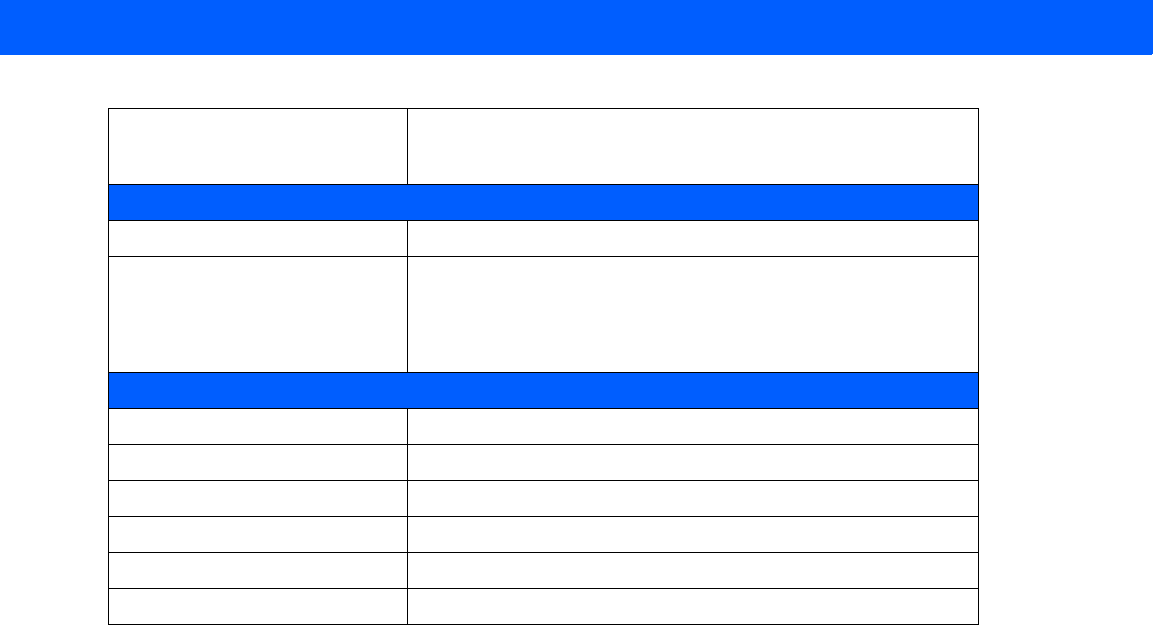
E - 10 Omnii Hand-Held Computer with Windows CE 6.0 User Guide
Co-channel Rejection 1 2 - 0 dB for 12.5 kHz @ 4800 and 9600 bps
8 - 0 dB for 20-25 kHz @ 9600 bps
12 - 0 dB for 20-25 kHz @ 19200 bps
Backwards Compatibility
Tx/Rx Switching Time Tx/Rx switching time less than 8 ms
Modulation Meets Psion proprietary modulation:
2FSK: 4800 bits/s
2FSK: 9600 bits/s
4FSK: 9600 bits/s
4FSK: 19200 bits/s
Environmental Specifications
Operating Temperature -30. C / +70. C
Storage Temperature -40. C / +60. C
Thermal Shock Per MIL-STD-810G -30C to +50C in freezer compliant host
Humidity 5% to 96% R.H. (non-condensing) in compliant host
ESD +/- 8 kV contact, +/- 15 kV air in compliant host
Environmental Compliance REACH, WEEE, RoHS 2, China RoHS
Draft #4 for review

APPENDIX F OMNII XT15F FREEZER
VARIANTS
FOmnii XT15f Freezer Variants
The Omnii XT15f Hand-Held Computer (Model 7545XT)
The Omnii XT15f is a modular, industrial hand-held computer suitable for cold chain and extreme weather envi-
ronments. These units are equipped with heating hardware to prevent condensation from developing on or
inside the Omnii.
Two variants are available – the Chiller and the Arctic. The Chiller model is condensing-resistant, and the
Arctic model is condensing-free. This variant is equipped with a heated scanner window and a standard 5000
mAh battery (model number ST3003). An optional freezer battery - model number ST3002 - (not used with
narrowband radio configuration) can be ordered for the Chiller variant. The Omnii Arctic freezer variant is
equipped with an optically bonded heated display module, providing a condensation-free unit. It is only avail-
able with an ST3002 freezer battery (not used with narrowband radio configuration).
Model Variants
• Omnii XT15f Arctic Hand-Held Computer (extremely rugged, condensing-free) - Model 7545XT. This
model features a multi-core heater control logic board that dynamically heats the scan window and
LCD display.
• Omnii XT15f Chiller Hand-Held Computer (extremely rugged, condensing-resistant) - Model 7545XT. This
model features a single core heater control logic board dynamically heats the scan window.
NOTE Performance specifications are nominal and subject to change without notice.
NOTE The Omnii Hand-Held Computer is a body worn device, and to maintain compliance with the FCC
RF exposure guidelines, use a Motorola approved carrying case. Use of non-approved accesso-
ries may violate FCC RF exposure guidelines.
Draft #4 for review
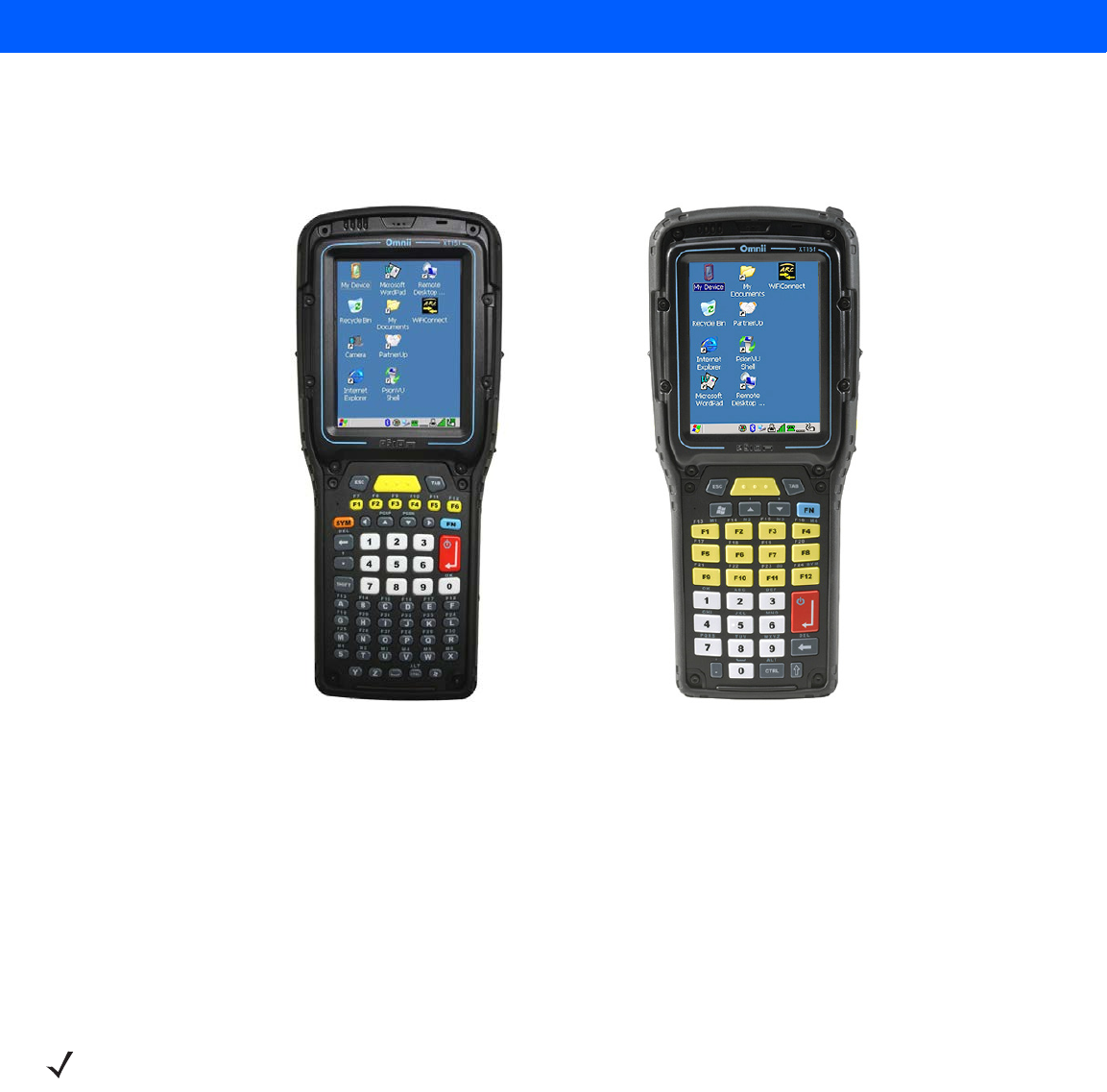
F - 2 Omnii Hand-Held Computer with Windows CE 6.0 User Guide
Figure F-1
Omnii XT15f Freezer Variants
Hardware Specifications
Physical Dimensions
• Length: 226 mm (8.89 in)
• Width: At display: 98 mm (3.86 in)
• Depth: At display: 82 mm (3.2 in))
At grip area: 31 mm (1.22 in)
• Weight: 34 g (1.8 lb) with SE965HP laser, ST3002 battery (not used with narrowband radio configuration),
and pistol grip
Barcode Scanner Options
• SE965HP 1D standard range laser
• SE1524-ER 1D extended range laser
• SE4600LR 2D Long Range Imager
Display
• 3.7” VGA (640 x 480) Transflective Color/Touch Display
Alphanumeric Numeric
NOTE Both Arctic and Freezer variants include a heated scan window for Frost Free Scanning (FFS).
Draft #4 for review

Omnii XT15f Freezer Variants F - 3
Chiller Variant:
• Extreme Duty, designed for rugged environments with improved impact resistance (1.25 Joule
impact), better abrasion resistance, superior low temperature operation (to -20ºC / -4ºF), with
160 cd/m2 brightness.
Arctic Variant:
• Extreme Duty is designed for rugged environments with improved impact resistance (1.25 Joule
impact), better abrasion resistance, superior low temperature operation (to -30ºC / -22ºF), with
160 cd/m2 brightness.
• The optically bonded display module prevents the build-up of condensation/fogging in-between the display
and the touchscreen.
• The display heater is responsible for maintaining a acceptable refresh rate in extreme cold environments.
Keyboard
• Both variants include specially designed keyboards that resist freezing due to ice build-up in condensing
environments.
• 58-key full alphanumeric with 6 single-push Function keys.
• 34-key numeric with 12 single-push Function keys.
Power Management
• Chiller Battery Pack: 5000 mAh high capacity Lithium-ion. For battery specifications, see Lithium-ion Smart
Battery 5000 mAh (ST3003) for Omnii Chiller Model on page F-5.
Optional 5300mAh high capacity smart freezer battery.
• Arctic Battery Pack: 5300 mAh high-capacity Lithium-ion smart freezer battery designed for improved per-
formance in low temperature application. For specifications, see Lithium-ion Smart Battery 5300 mAh
(ST3002) for Omnii Arctic Model on page F-6.
Environmental
Chiller Variant:
• Operating Temperature: -20°C to +50°C (-4°F to +122°F)
• Storage Temperature:-40°C to +60°C (-40°F to +140°F)
• Humidity: 5% to 95% non-condensing (condensation-resistant)
• Rain/Dust: IP65, IP67, IEC 60759
• Drop Rating: Multiple 2 m (6.5 ft) drops to polished concrete
• ESD: +/- 8 kV contact, +/- 15 kV air discharge.
Arctic Variant:
• Operating Temperature: -30°C to +50°C (-22°F to +122°F)
WARNING! Powered cradles are designed to allow the Omnii to be powered by a vehicle bat-
tery. The battery installed in the Omnii is also recharged by the vehicle battery. This
option accepts DC power sources over the range 11.5V to 30V.
For Omnii XT15f Chiller units, voltages above that require the use of the power pre-
regulator Model No. PS1350. However, Omnii XT15f Arctic units operating in
temperatures from -30°C to +50°C, require the use of the power preregulator Model
No. PS1370.
For detailed information, see ST1002 Powered Cradle Installation on page 4-20.
Draft #4 for review
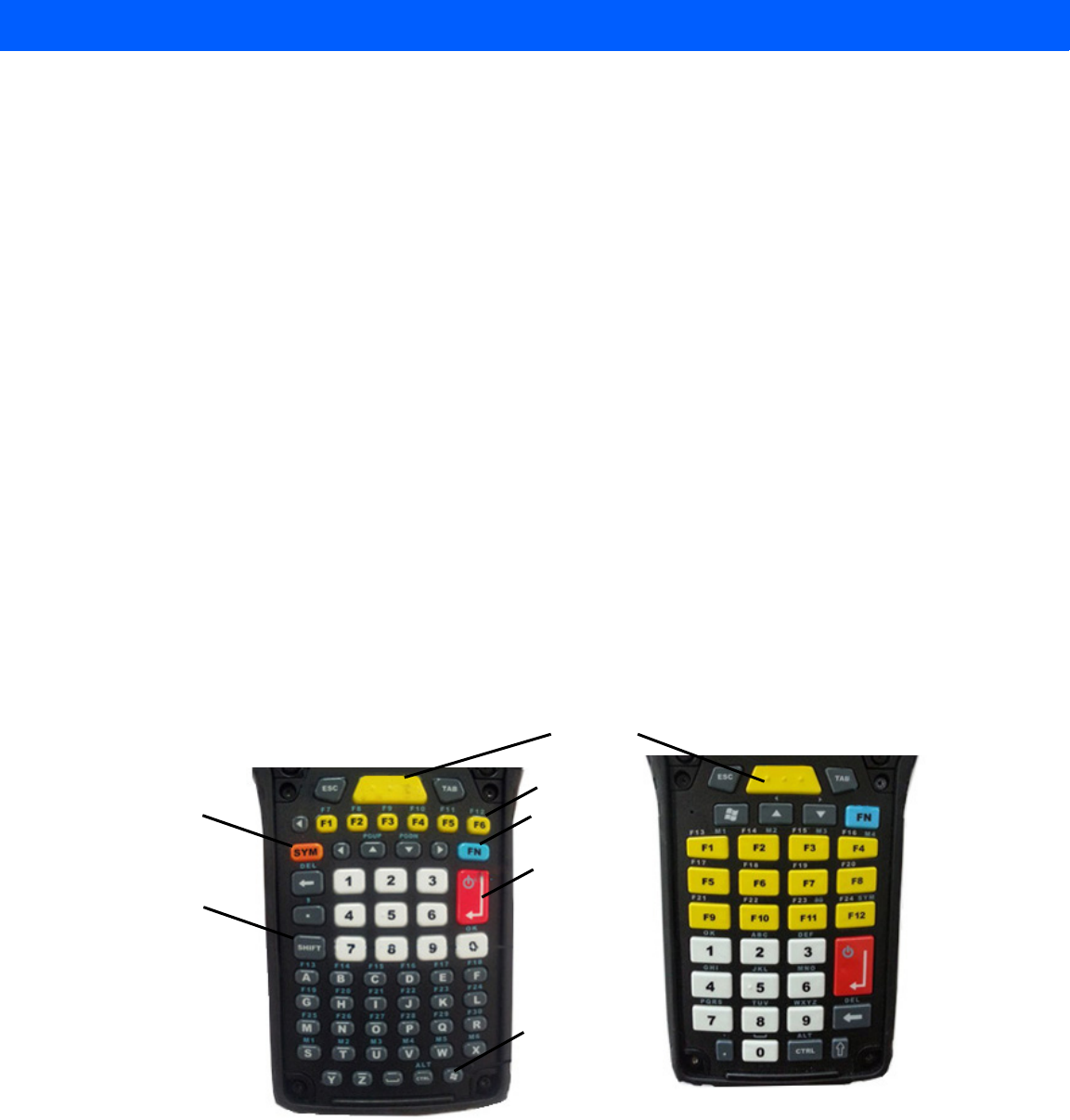
F - 4 Omnii Hand-Held Computer with Windows CE 6.0 User Guide
• Storage Temperature: -40°C to +60°C (-40°F to +140°F)
• Humidity: Condensing (condensation-free using internal heaters)
• Rain/Dust: IP65, IP67, IEC 60759
• Drop Rating: Multiple 2 m (6.5 ft) drops to polished concrete
• ESD: +/- 8 kV contact, +/- 15 kV air discharge.
Regulatory Approvals
• Worldwide Safety, EMC, RF, Laser approvals
• CE Mark
• E Mark (vehicle cradles)
• RoHS compliant
• WEEE compliant
• REACH compliant
The Freezer Keyboards
Two keyboard layouts are available for the Chiller and Arctic hand-held units. Both variants include specially
designed keyboards that resist freezing due to ice build-up in condensing environments.
Figure F-2
Freezer Keyboard Layouts
34-Key Numeric Keyboard
58-Key Full Alpha Numeric Keyboard
[FN] Modifier key
[SYM] key
[SHIFT]
[SCAN] Key
[Enter/Power]
[Windows] key
Modifier key key
[FN] Keys
Draft #4 for review
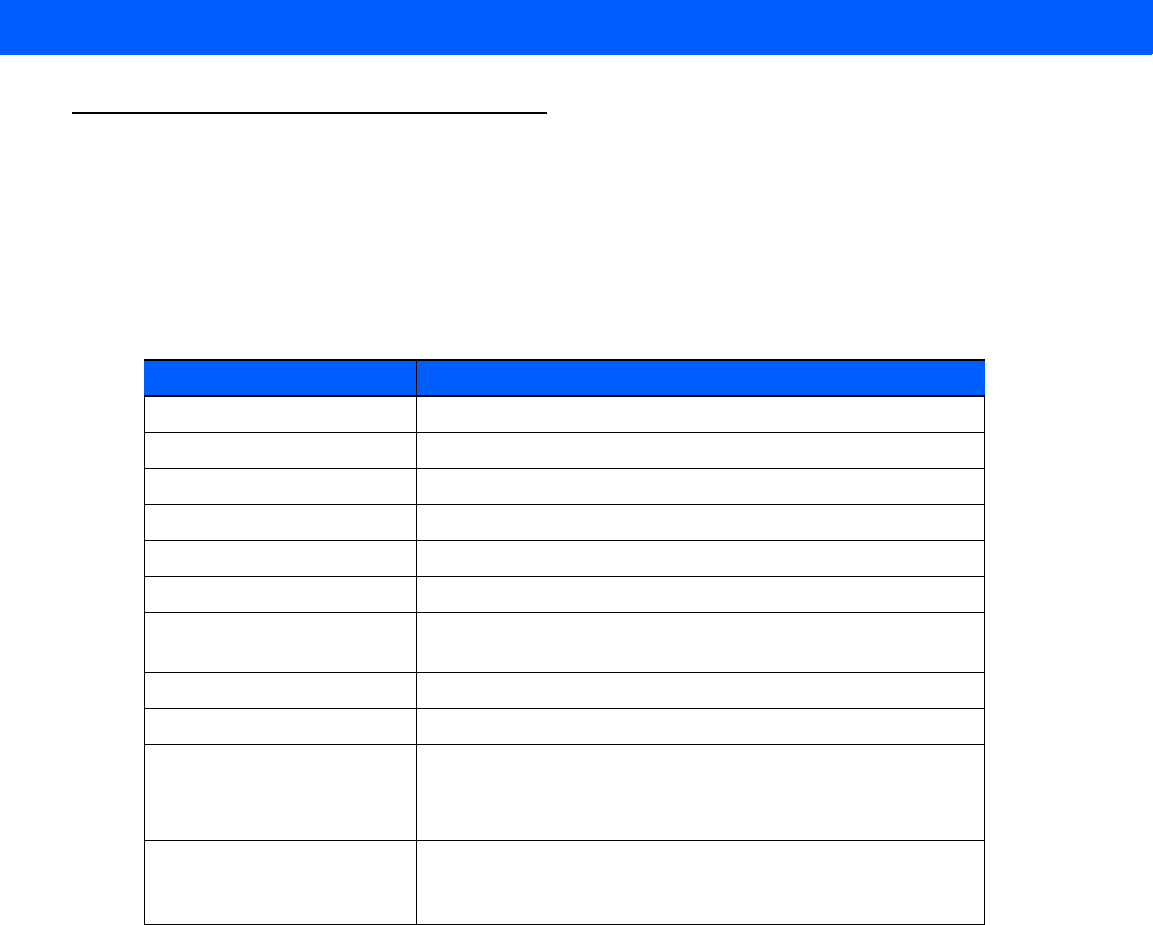
Omnii XT15f Freezer Variants F - 5
Lithium-ion Smart Battery 5000 mAh (ST3003) for Omnii Chiller Model
The Omnii Chiller model is shipped with the standard ST3003 Lithium-ion Smart Battery. The ST3002 Arctic
Battery (not used with narrowband radio configuration) is available as an option. For more information about
this battery, see Lithium-ion Smart Battery 5300 mAh (ST3002) for Omnii Arctic Model on page F-6.
For safety instructions, please see “Lithium-ion Battery Safety Precautions” in the Omnii Hand-Held Computer
Regulatory & Warranty Guide (PN 8000191).
Parameter Specification
Model Number ST3003
Chemistry Lithium-ion (Li-Ion)
Capacity 5000 mAh nominal at 1000 mA discharge 20°C to 3.0 V (min)
Voltage 3.7 V nominal (2.75 V min. to 4.2 V max.)
Cell Configuration 1 S2P (2 parallel connected cells)
Max. Charge Voltage 4.2 V +/- 1%
Recommended Charge
Termination Timeout 5.0 hr - charging must stop.
Charge Temperature 0°C to +40°C (32°F to +104°F)
Discharge Temperature -20°C to +50°C (-4°F to +122°F)
Storage Temperature -20°C to +50°C (-4°F to +122ºF). Storage at elevated tempera-
tures not recommended.
25°C (77ºF) — recommended storage temperature.
Cycle Life 300 cycles minimum with no degradation below 70% of
nominal capacity based on 0.5C charge / 0.5C discharge rates
(to 3.0 V) @ 23°C (73.4ºF).
Draft #4 for review
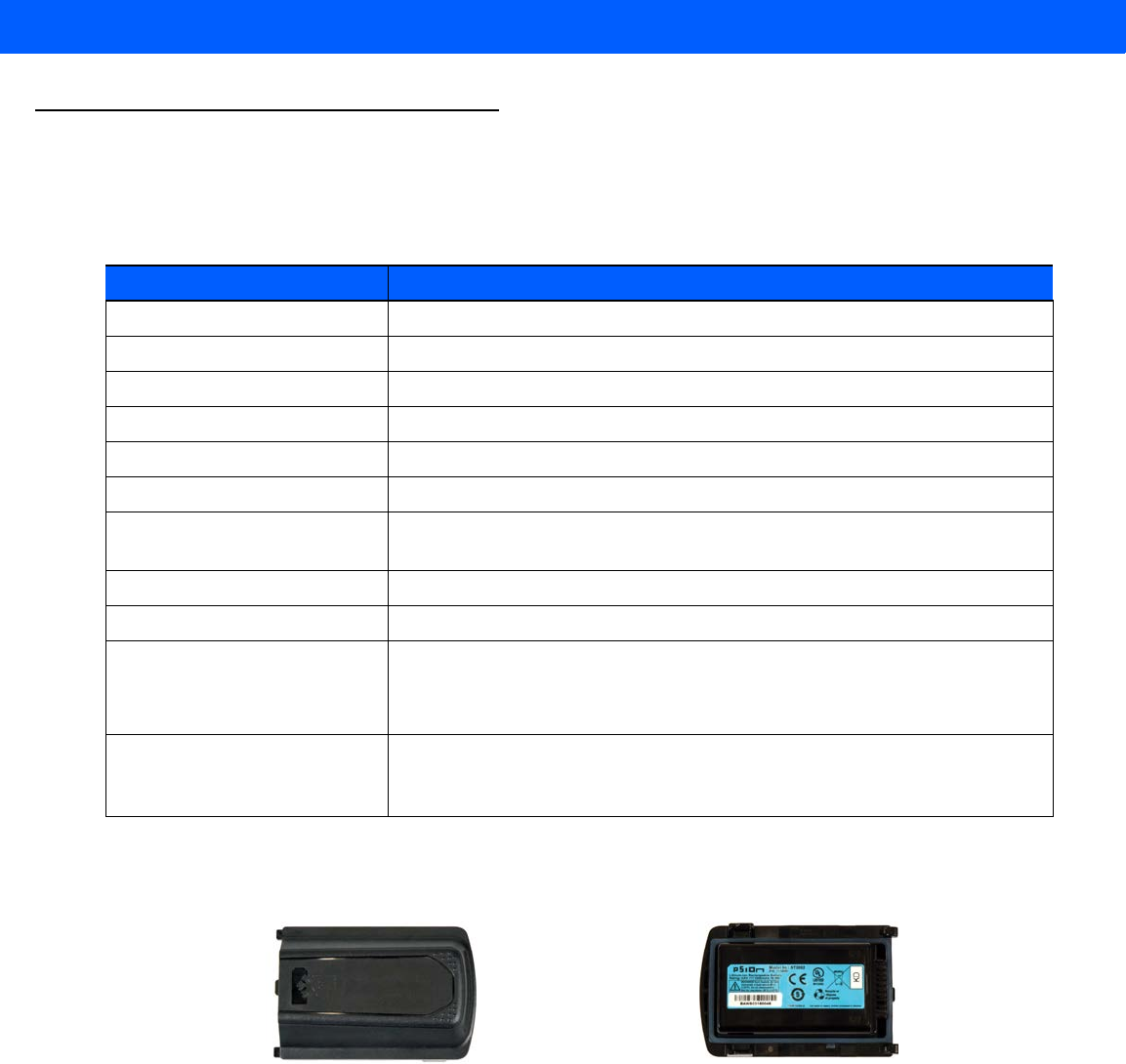
F - 6 Omnii Hand-Held Computer with Windows CE 6.0 User Guide
Lithium-ion Smart Battery 5300 mAh (ST3002) for Omnii Arctic Model
The Omnii Arctic model is shipped with the ST3002 Lithium-ion Smart Battery (not used with narrowband radio
configuration). For safety instructions, please see “Lithium-ion Battery Safety Precautions” in the Omnii
Hand-Held Computer Regulatory & Warranty Guide (PN 8000191).
Figure F-3
ST3002 Battery and Safety Label (not used with narrowband radio configuration)
Parameter Specification
Model Number ST3002 (not used with narrowband radio configuration)
Chemistry Lithium-ion (Li-Ion)
Capacity 5300 mAh nominal at 1000 mA. Discharge @ 20°C to 2.75 V (min)
Voltage 3.6 V nominal (2.75 V min. to 4.2 V max.)
Cell Configuration 1 S2P (2 parallel connected cells)
Max. Charge Voltage 4.2 V +/- 1%
Recommended Charge
Termination Timeout 5.0 hr - charging must stop.
Charge Temperature 0°C to +40°C (32°F to +104°F)
Discharge Temperature -30°C to +50°C (-22°F to +122°F)
Storage Temperature -20°C to +50°C (-4°F to +122ºF). Storage at elevated temperatures not
recommended.
25°C (77ºF) — recommended storage temperature.
Cycle Life 300 cycles minimum with no degradation below 70% of nominal
capacity based on 2.5A - 4.20V charge / 2.5A - 2.75V discharge
rates @ 25°C (77ºF).
Draft #4 for review
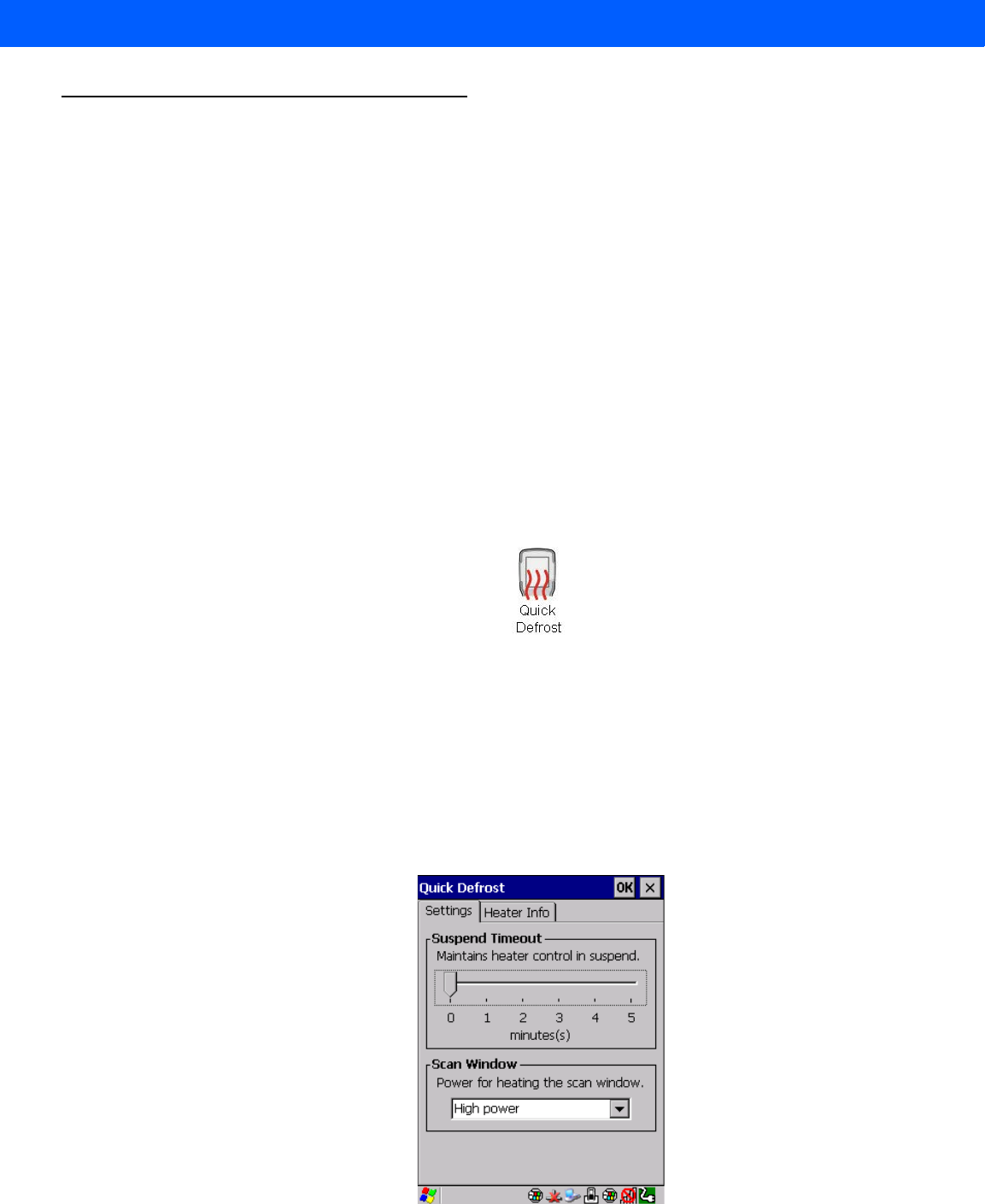
Omnii XT15f Freezer Variants F - 7
Quick Defrost Application
The Omnii XT15f is a freezer capable hand-held computer that has integrated heaters that are designed to
improve the functionality and operation of the hand-held device in extreme cold environments. The Arctic
variant has two heaters; one for the display, and one for the scan window. The Chiller variant has only one
heater, which is located on the scan window. The Quick Defrost application is the nerve center of the
heater-related information. The Settings tab allows the user to configure the suspend time of the heating
system, as well as the scan window power setting. The Heater Info tab provides instantaneous heater informa-
tion for each individual heater and the overall heating system. For environmental specifications for this
computer, see Hardware Specifications on page F-2.
To ensure proper operation of the hand-held device in a freezer environment, the surface temperature is
managed by the heating system to prevent the formation of external/internal condensation on critical modules.
The heating system consists of two heating elements; one for the display and one for the scan window.
Quick Defrost Settings
The individual heaters for the computer modules can be monitored, and the duration of time for them to remain
on during Suspend mode can be configured.
• In the Control Panel, choose the Quick Defrost icon.
Settings
The Quick Defrost application opens in the Settings tab.
Suspend Threshold
•The Suspend Threshold option allows you to maintain heat for a limited time when the computer enters
Suspend mode. Once the threshold is reached, the heater will stay off while the computer is in suspend.
• To set the time, slide the trackbar to the desired time and click OK. Values range from 0 to 5 minutes.
Draft #4 for review
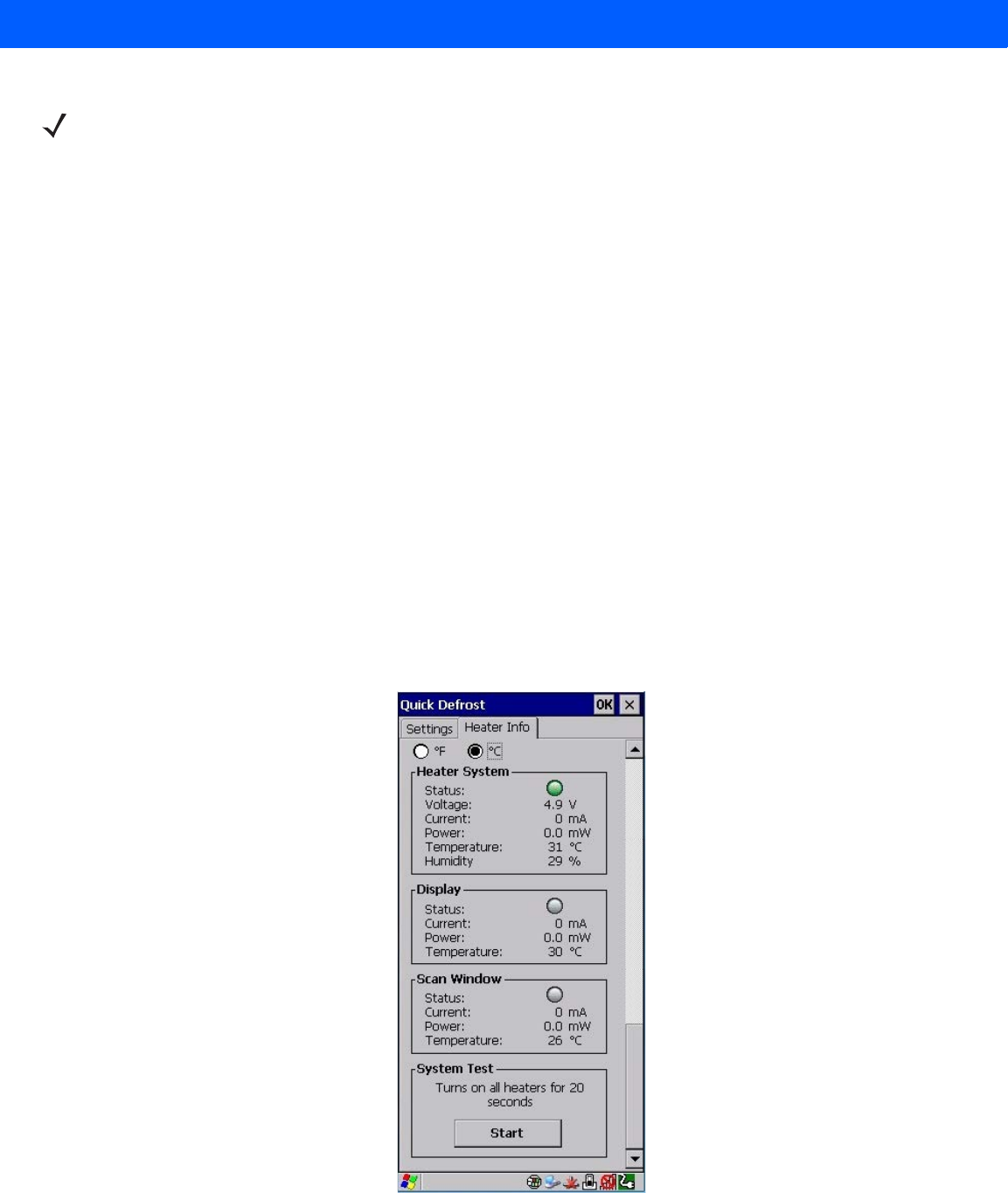
F - 8 Omnii Hand-Held Computer with Windows CE 6.0 User Guide
Scan Window
The Scan Window option allows you set the level of power for the periphery scan window heater. There are two
pull down options:
High power (default): This heating profile has been designed for users that are in and out of the freezer
frequently (with a freezer dwell time of less than 20min). This heating profile keeps a constant positive temper-
ature on the scan window — eliminating any formation of external / internal condensation from frequent transi-
tions. Please note that this heating algorithm provides additional power at the expense of the battery shift life.
Low power: This heating profile has been designed for users that will be spending long durations in the freezer
environment. It is a less aggressive algorithm, compared to the high power mode, that maximizes battery shift
life. It addresses the formation of internal condensation to keep the scan window clear of condensation.
These two scan window power modes can be adjusted on the fly to give the user the needed flexibility for
optimal performance.
Heater Info
•In the Quick Defrost dialog box, open the Heater Info tab. This dialog box allows you to monitor the status
of each heater and test the entire system.
Temperature Selection
You have the option of setting the display temperatures to Celsius or Fahrenheit.
NOTE A longer suspend threshold will reduce your overall battery shift life.
Draft #4 for review
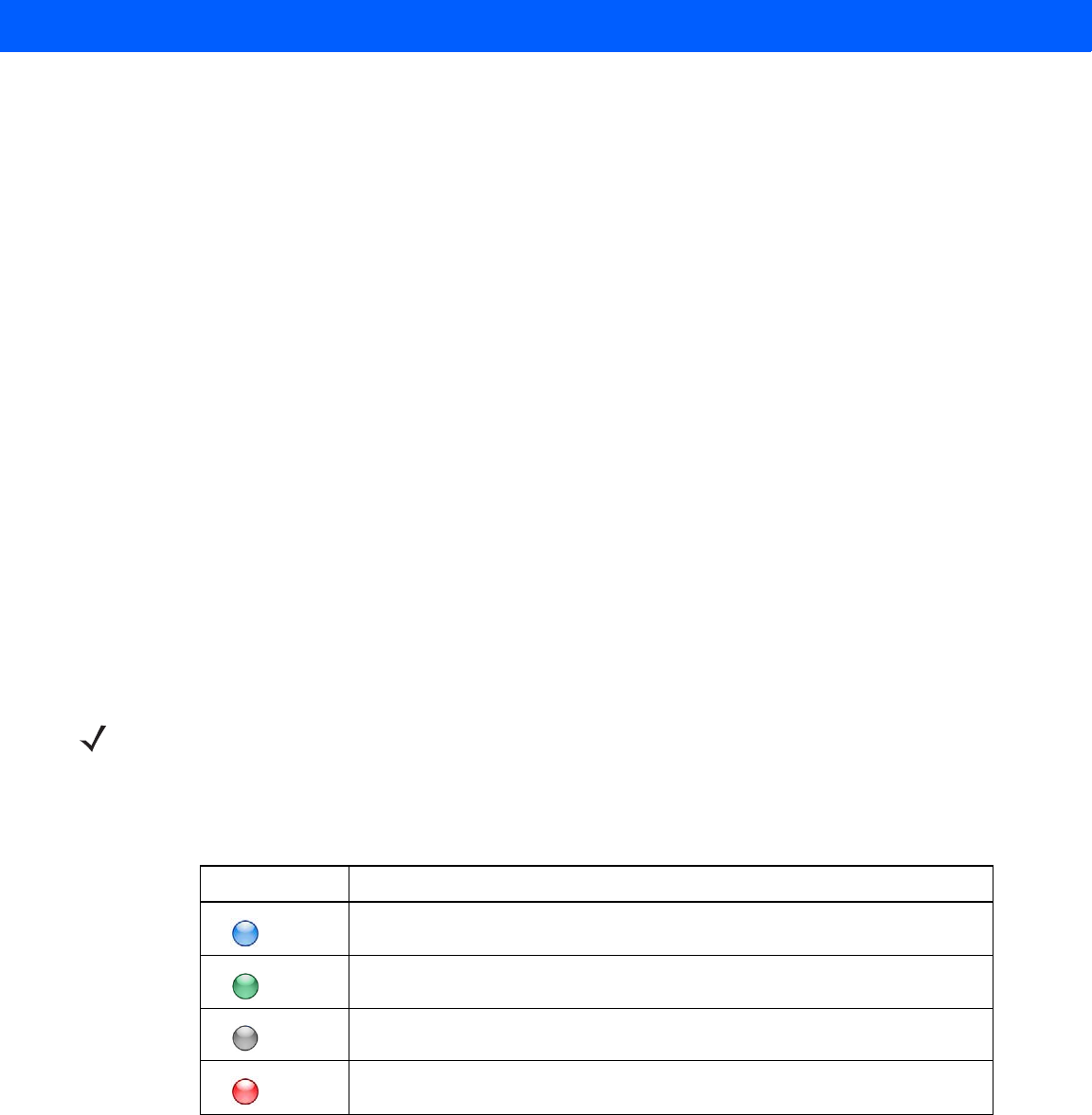
Omnii XT15f Freezer Variants F - 9
Heater System
This section displays information on the heater system.
Status
The LED state for this parameter indicates whether the communication with the Quick Defrost hardware is
successful (green) or unsuccessful (red).
Voltage
This indicates the voltage applied to the heater system.
Current
This shows the total average current used by the heating system.
Power
This represents the total power used by the heating system.
Temperature
This shows the temperature measured inside the unit.
Humidity
This shows the humidity measured inside the unit.
Display and Scan Window Heaters
This section displays information on the individual heaters.
Status
These status indicators report the heating mode for each individual heater.
Current
This indicates the average current drawn at the moment for the individual heater.
Power
This indicates the power used at the moment for each individual heater.
Temperature
Shows the temperature measured near the heating element.
NOTE If the scanner/imager is not connected, the scan window heater will be disabled
(greyed out).
Status LED Heating Element Status
Blue indicates the heating element is operating in full power mode.
Green indicates the heating element is operating in sustaining mode.
Grey indicates the heating element is off.
Red indicates a hardware failure with the heater.
Draft #4 for review
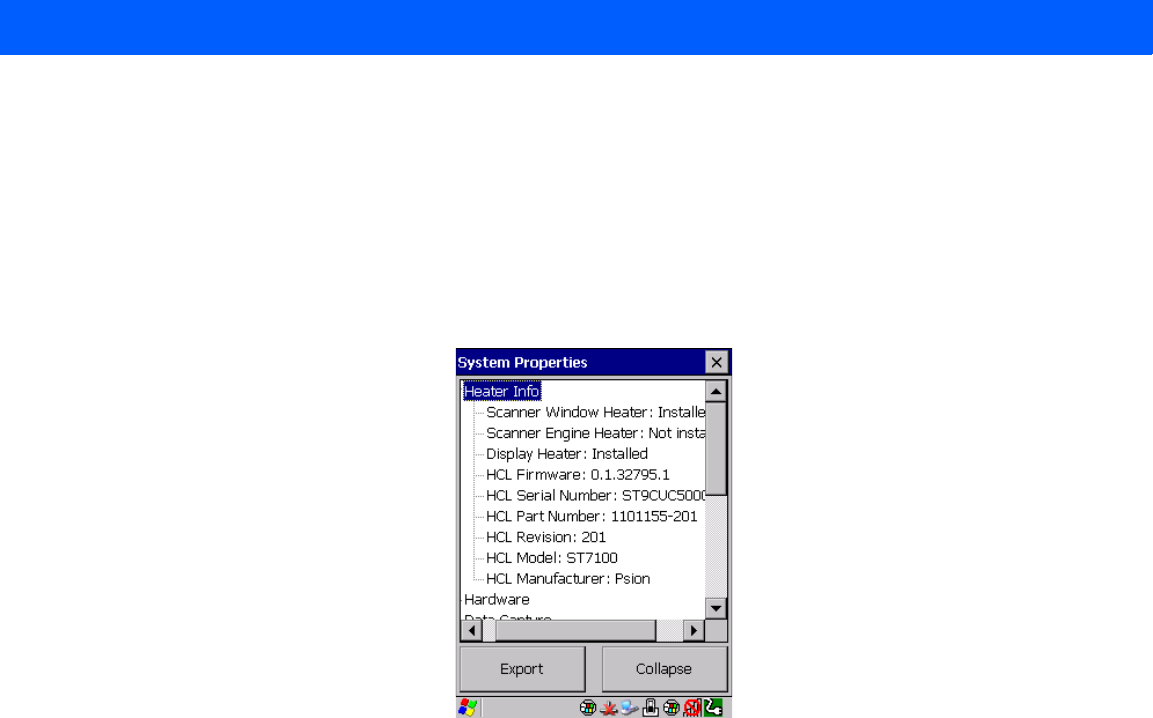
F - 10 Omnii Hand-Held Computer with Windows CE 6.0 User Guide
System Test
The system test feature allows you to test the functionality of all available heaters (for approximately 20
seconds) to make sure that the heating system — heaters and control board — are working properly.
System Properties
In Control Panel>System Properties, the computer’s heater software and hardware components are listed
under Heater Info. The information includes their identification, version or part numbers, and whether they
have been installed.
Draft #4 for review

APPENDIX G WIRELESS WIDE AREA
NETWORK (WWAN) SETTINGS
GWireless Wide Area Network (WWAN) Settings
Wireless WAN
The Omnii is available with one of the following Wireless WAN (WWAN) radio options: the Cinterion MC75i
EDGE and the Cinterion PH8-P HSPA+. An Omnii Hand-Held Computer equipped with a GSM/GPRS radio
has wide area networking capabilities. With either of these radios and a SIM card, you can wirelessly transfer
data, and you use the Omnii voice option to place phone calls.
Taskbar Icons
Wireless WAN icons in the taskbar indicate the status of your wide area network connection. Note that these
icons are only visible when the relative radio is installed in the computer, and the interface is enabled.
The following taskbar icons are used:
• G - GSM/GPRS
• E - GSM/EDGE
•3G - UMTS 3G
• U - UMTS/HSPA+
User interaction is required (e.g. the user is required to enter a PIN).
A non-recoverable (fatal) error has occurred.
The modem status is unknown or the modem is not connected to any network (the signal strength is 0%).
The modem has found a network, and the signal strength is between 1% and 20%.
The modem has found a network, and the signal strength is between 21% and 40%.
The modem has found a network, and the signal strength is between 41% and 60%.
The modem has found a network, and the signal strength is between 61% and 80%.
Draft #4 for review
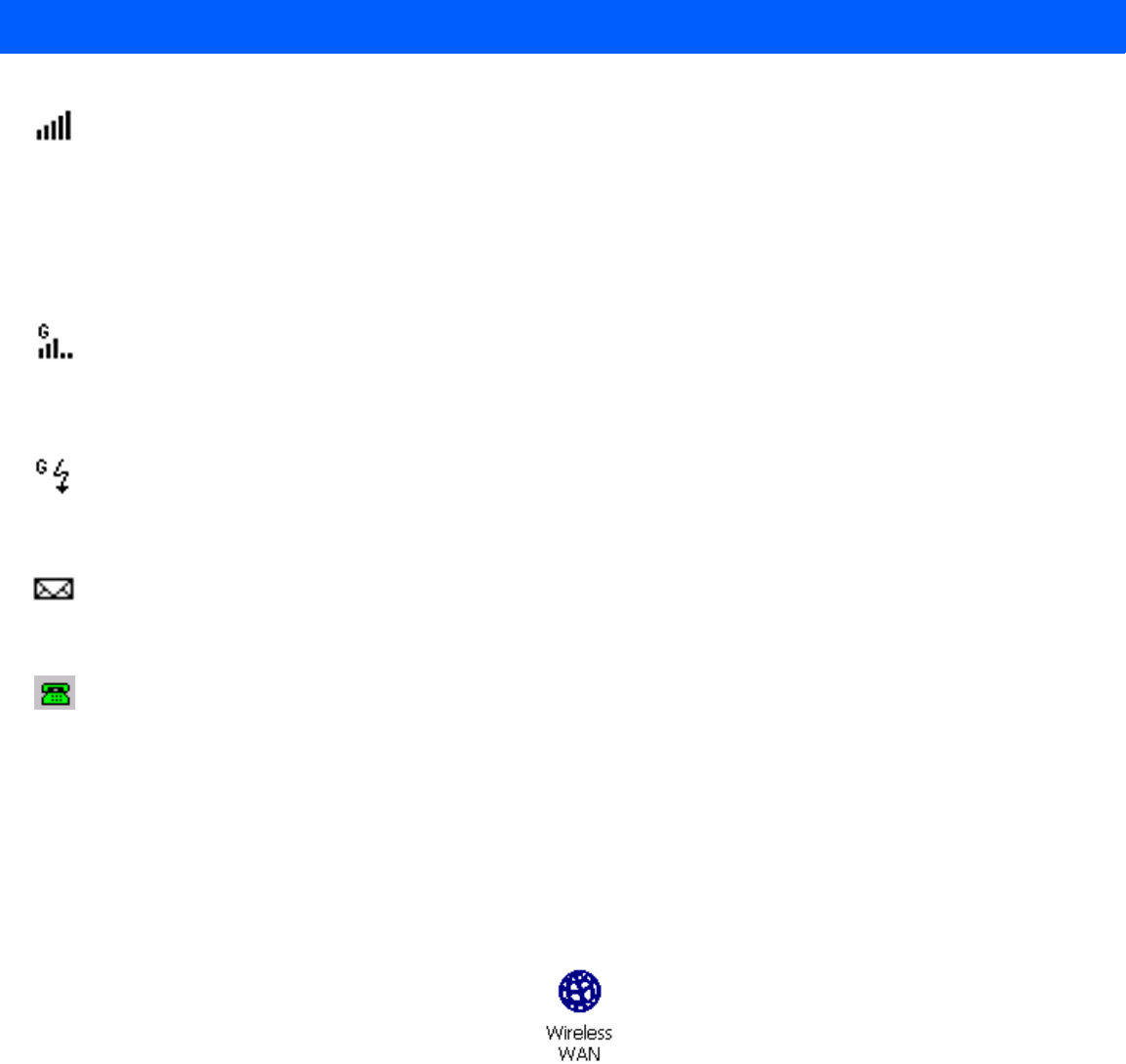
G - 2 Omnii Hand-Held Computer with Windows CE 6.0 User Guide
The modem has found a network, and the signal strength is between 81% and 100%.
Once the modem detects that a packet data service is available, a letter is added to the signal strength icon
indicating the kind of packet data service. Keep in mind that the signal strength icon is displayed without a
letter if packet data service is not available, or if it is available but not yet initialized.
For example:
The modem has found a network, the signal strength is between 41% and 60%, and GSM/GPRS packet
service is available.
The signal strength icon is replaced by a connection indicator icon when a packet data connection is started:
A GPRS packet data connection is active.
In addition to the signal strength or connection indicator a second icon may be shown.
A new SMS (Short Message Service) message has arrived.
The dialer icon is displayed when the Voice option is available (SIM card and GPRS radio are installed). When
you have an active call, this icon flashes yellow, and then green.
Establishing a Packet Data Connection
To display the main Wireless WAN dialog box:
• Double-tap on the Wireless WAN icon in the taskbar.
If the icon is not visible in the taskbar, the radio interface has been shut down or the modem has been
removed:
• In the Control Panel, choose the Wireless WAN icon.
The main Wireless WAN dialog box is displayed.
Draft #4 for review
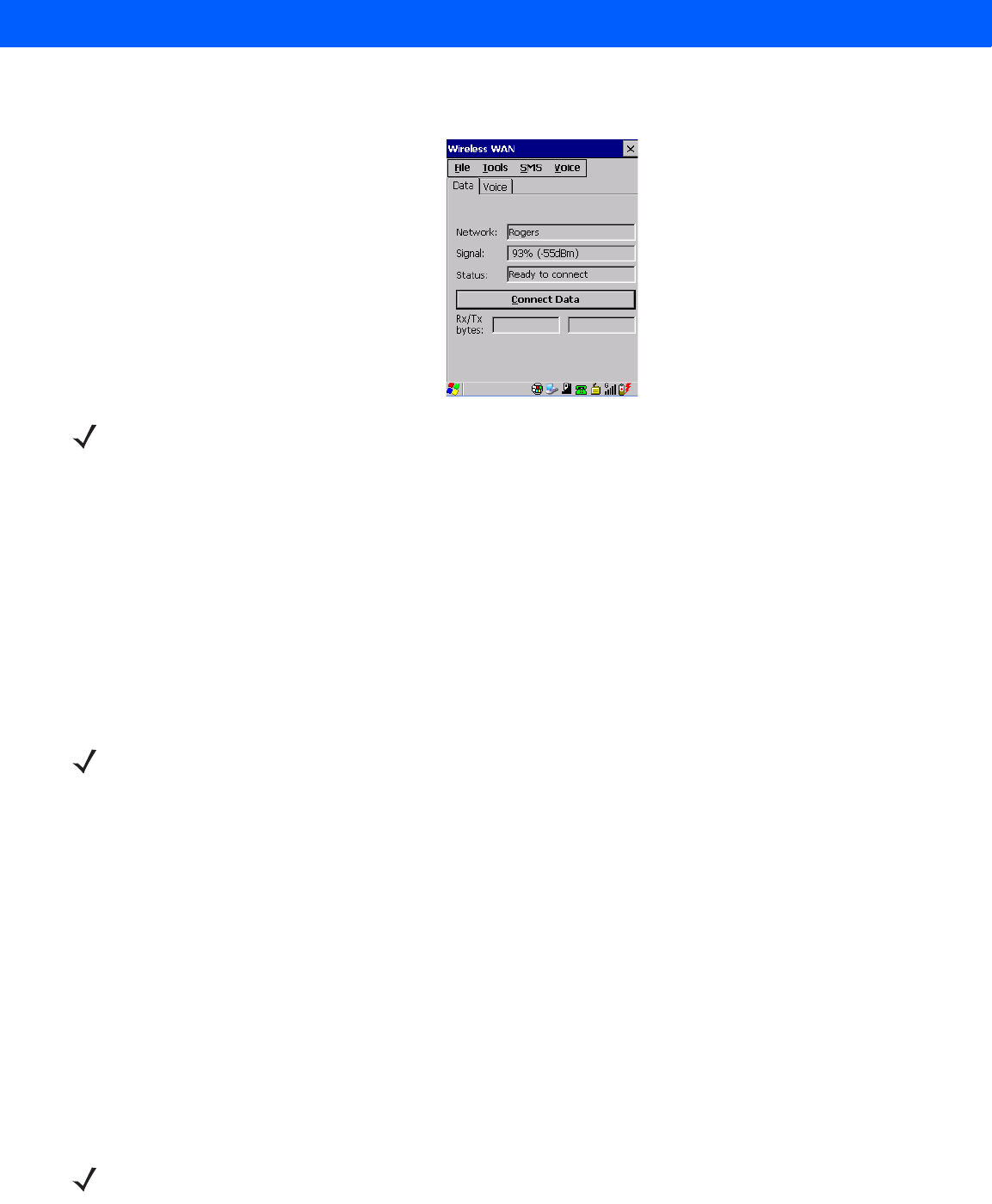
Wireless Wide Area Network (WWAN) Settings G - 3
Figure G-1
Establishing a Connection
When “Ready to connect” is displayed in the Status field, the Connect Data button is enabled.
• Tap on the Connect Data button.
The progress of the connection is tracked in the Status field.
• Connecting.
• PPP link to modem active.
• Authenticating user.
• User authenticated.
• Connected.
When the connection state reaches PPP link to modem active, the taskbar icon changes to indicate an active
connection. The Connect Data button changes to Disconnect.
Disconnecting From a Network
To disconnect from the network:
• Tap the stylus on the Disconnect button, and then on OK.
When the computer’s network connection is severed, the Status field displays “Ready to connect”.
The signal strength is displayed in the main Wireless WAN screen, even while a connection is active. The Rx
bytes and Tx bytes fields estimate the amount of data transmitted and received, respectively.
Shutting Down the Wireless WAN User Interface
While it is not usual to shut down the GSM/GPRS user interface, you can accomplish this by tapping on the
File menu and choosing the Exit command at the bottom of the main Wireless WAN dialog box.
NOTE If you are prompted to enter a PIN, refer to Entering a PIN Number on page G-4 for details.
NOTE Keep in mind that these states may be displayed fairly quickly if the progress of the connection
is rapid.
NOTE Once you’ve shut down the user interface, you can only enable the radio by opening the Control
Panel and tapping on the Wireless WAN icon to display the Wireless WAN dialog box.
Draft #4 for review

G - 4 Omnii Hand-Held Computer with Windows CE 6.0 User Guide
Advanced Information
In most cases, when a GSM/GPRS radio and SIM are installed in your computer, setup is automatic. Follow
the steps outlined under the heading Establishing a Packet Data Connection on page G-2 to make a connec-
tion. The information in this section is for advanced setup purposes.
Entering a PIN Number
If a PIN is required, a PIN entry dialog box is displayed.
• Type your PIN, and press [Enter].
Once the correct PIN or PUK is entered or if none was required, the modem is instructed to perform a GSM
network registration followed by a GPRS attach. The main Wireless WAN dialog box reflects the progress of
the initialization.
• Searching for modem.
• Initializing modem.
• SIM is ready.
• Searching for network.
• Registered on network.
• Searching for GPRS.
• Ready to connect.
If the modem loses the connection to the GSM network, the following states are repeated: Searching for
network, Registered on network, Searching for packet data, and Ready to connect.
Error States
The following temporary error states (i.e., these states may disappear without interaction) may be displayed:
• Emergency calls only.
The modem has found a network but is not allowed to register (e.g. no roaming agreement between net-
works). The modem keeps searching for another network.
• No network found.
A network is not currently available. The modem continues searching for a network.
• Packet data not available.
The current network does not support a packet data service.
• Packet data not allowed.
The modem is not allowed to use the packet data service on the current network (e.g. no GPRS roaming
agreement between network; a roaming agreement for voice may still be in place). It is also possible that
you do not have a subscription for GPRS at all.
The remaining error states are permanent:
• SIM is missing.
The SIM card is missing. After the SIM has been inserted a warm boot may be required.
• SIM failure.
NOTE If you exceed the number of allowable attempts, a PUK entry window is brought to the fore-
ground. You’ll need to enter a new PIN number.
Draft #4 for review
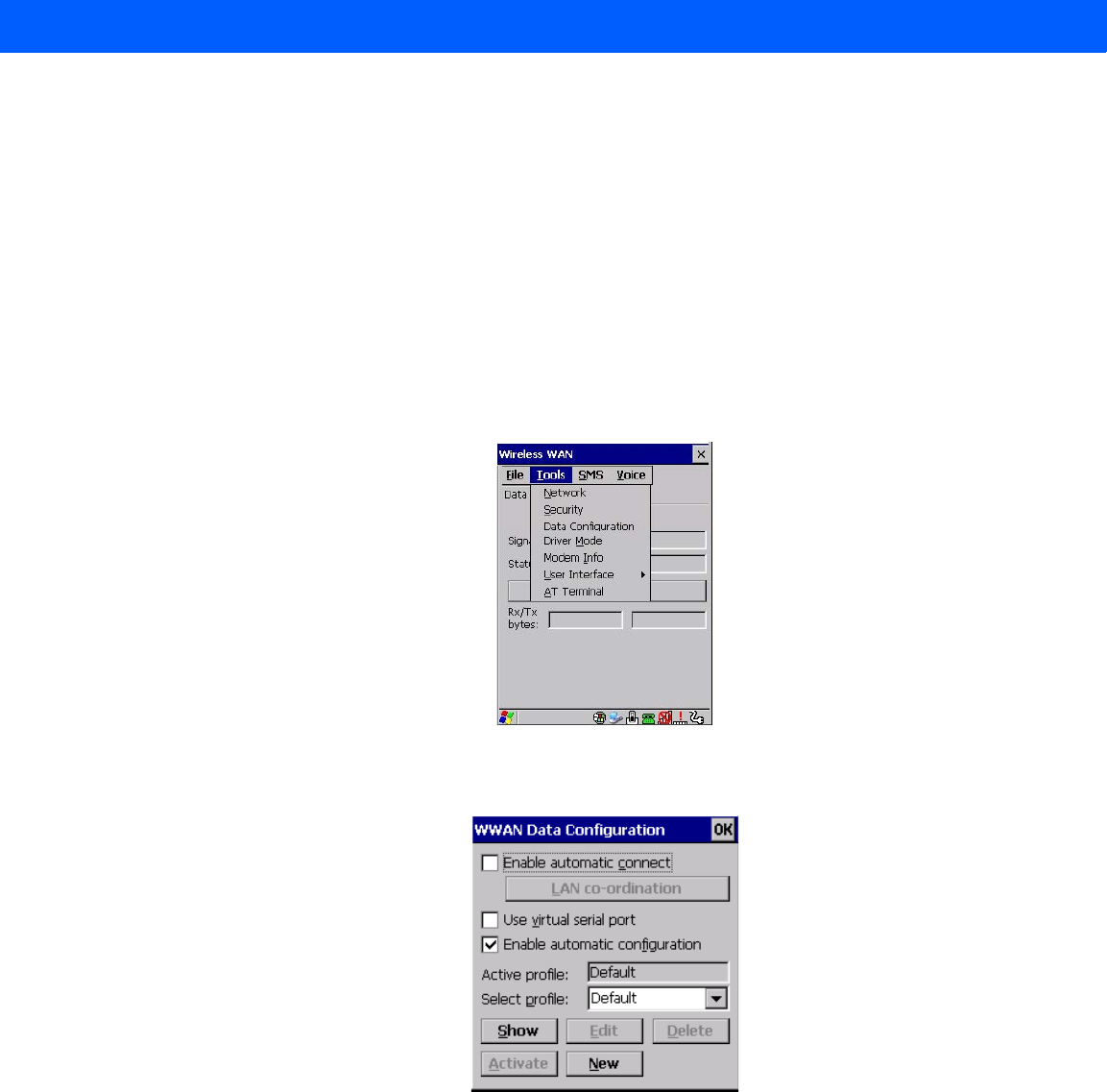
Wireless Wide Area Network (WWAN) Settings G - 5
The SIM card is permanently disabled (e.g. because the wrong PUK has been entered too many times). A
new SIM is needed.
• Modem failure.
The modem did not respond to commands as expected. If a warm boot does not clear this condition, the
modem may need to be replaced.
• NDIS error.
An internal software error has occurred. If a warm boot does not clear this condition, Motorola technical
support may need to investigate further.
Tools Menu
The Tools menu in the main Wireless WAN dialog box offers some additional, advanced setup features.
WWAN Data Configuration
Enable Automatic Connect
If the Enable automatic connect check box is checked (unchecked by default), the Wireless WAN user inter-
face will attempt to establish a GPRS connection whenever GPRS is available (e.g. after resume from suspend
without further user interaction).
To activate the automatic connection mode:
• Tap on the OK button.
While automatic connection mode is enabled, the Connect Data button in the main Wireless LAN dialog
box changes to Disable Auto. To close the currently active connection (if any) and disable the automatic
connection mode:
Draft #4 for review

G - 6 Omnii Hand-Held Computer with Windows CE 6.0 User Guide
•Tap on Disable Auto.
Use Virtual Serial Port
If Use virtual serial port is enabled, packet data connections are established through the virtual serial port of
the WWAN driver rather than through the WWAN driver directly. This check box should only be checked if
certain third-party VPN (Virtual Private Network) clients are used that do not work correctly otherwise. The
default setting is disabled (unchecked).
Enable Automatic Configuration
In most cases, the data connection is configured automatically and no user interaction is required. This is true
even if multiple SIM cards from different operators are used with the same device. The connection parameters
are adjusted automatically when a new SIM card is detected (this may require a warm boot). The connection
parameters are retrieved from a database.
Manual configuration should be necessary only if:
• One or more parameters in the database are incorrect or a new operator is not yet in the database. (The
database should be corrected for subsequent software releases.)
• An operator has assigned individual GPRS user names and passwords.
• A very large site has its own APN. Such connections always have to be configured manually.
• A customer has subscribed for a static IP address. By definition this must be configured manually.
• An operator may use a different APN for certain groups of customers. Since the automatic configuration
can configure only one APN per operator such connections have to be configured manually.
Profiles
In the following section, all the parameters that need to be configured for a connection (such as APN, user
name, password, DNS server addresses etc.) are referred to as a profile. Every profile is identified by an arbi-
trary, unique name. The profile named Default is special in that it is always present and can neither be edited
nor deleted. The Default profile uses parameters from a built-in database. The home network (the network that
issued the SIM) is used for the database look-up. While there can be many configured profiles, only one profile
can be active at any time.
If connection profiles are configured manually, the Enable automatic configuration check box should normally
be unchecked.
In one particular use case, manually configured profiles may be combined with automatic configuration. If
multiple SIM cards are used with the same device, each SIM card being from a different operator and some
or all of them requiring a manually set up profile, automatic configuration may be used to automatically pick
the correct manually configured profile for each SIM card. For this to work, each profile must be configured
while the corresponding SIM card is inserted in the device and initialized (i.e. the status is at least Searching
for network).
IMPORTANT Automatic connection mode should not be used if applications other than the Wireless
WAN user interface (e.g. Connection Manager) are expected to open and close
connections.
If the automatic connection mode is enabled and another application closes the GPRS
connection, the WWAN user interface will immediately try to re-establish the connection.
NOTE The connection setup takes longer through the virtual serial port.
Draft #4 for review
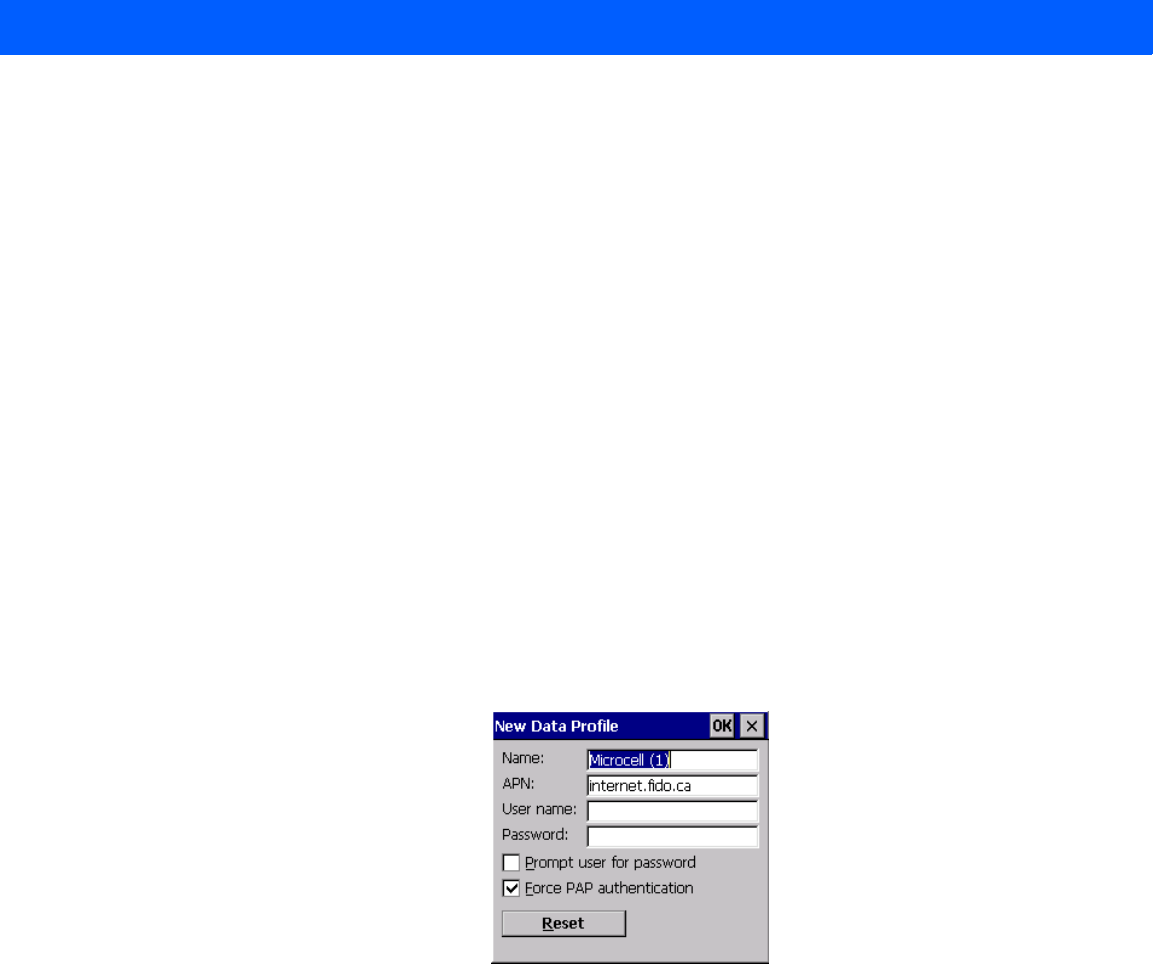
Wireless Wide Area Network (WWAN) Settings G - 7
The Select profile: drop-down list in the data configuration profile selects to which profile a subsequent action
applies. A profile named Default is always present and contains the current parameters from the database. The
following actions are available:
Show
The parameters for the selected profile are displayed when you tap the stylus on this button. For the Default
profile, the publicly known password is shown — otherwise, the password is hidden.
Edit
The parameters of the selected profile can be edited when you choose the Edit button. Keep in mind that you
cannot edit the Default profile.
Delete
The selected profile is deleted. You cannot delete the Default profile.
Activate
When this button is chosen, the selected profile becomes the active profile. Activation is possible only if the
Enable automatic configuration: check box is unchecked.
New
Tapping on the New button allows you to create a new profile.
Figure G-2
Creating a New Profile
The name of the newly created profile must be different from all existing profiles. Also, the name cannot be
Default. When the New Data Profile dialog box is opened, a proposal for a unique name is filled in the corre-
sponding entry field. If a manually configured profile has a secret password and unauthorized access to the
device is a concern even after the SIM PIN has been entered, the password should not be entered in the New
Data Profile dialog box and the Prompt user for password check box should be checked instead. In this case,
you will be prompted for the password each time a connection is initiated (the Connect Data button in the main
Wireless WAN dialog box is selected).
By default the connection uses PAP (Password Authentication Protocol), a simple authentication protocol used
to authenticate a user to a remote access server or Internet Service Provider. However, if your ISP does not
support PAP, tapping in the box to the left of Force PAP authentication disables PAP and directs the connection
to use CHAP (Challenge Handshake Authentication Protocol) instead.
Reset
The Reset button in the New Profile and Edit Profile dialog boxes resets all entry fields to the values they had
when the dialog box was opened.
Draft #4 for review
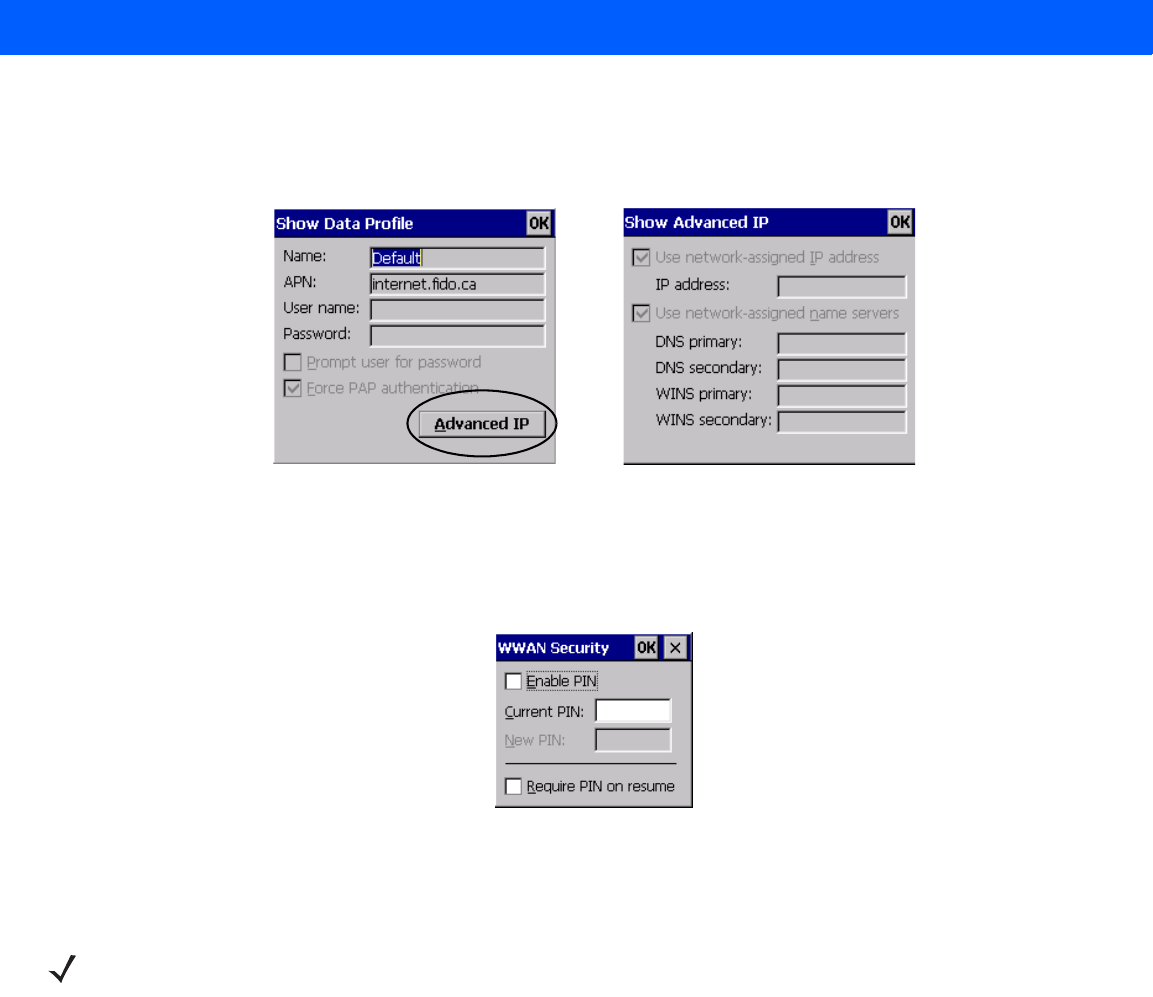
G - 8 Omnii Hand-Held Computer with Windows CE 6.0 User Guide
Advanced IP
Figure G-3
Assigning IP Information
The Advanced IP button in the Show Profile and Edit Profile dialog boxes opens another dialog box that allows
you to configure a static IP address as well providing DNS and WINS fields so that you can specify DNS and
WINS resolvers.
Security Configuration
The Security Configuration dialog box is accessed through the Tools menu. The Security Configuration dialog
box allows you to enable, disable and change the PIN. You will need the current PIN to make any of these
changes. The PIN must be enabled in order to be changed. (If the PIN is disabled, the New PIN entry field is
greyed out.)
The Require PIN on resume check box is independent of the aforementioned settings. By default, this check
box is unchecked. While this option remains unchecked, any PIN entered on startup or through the Security
Configuration dialog box and submitted successfully to the modem is stored in memory for as long as the
device is not rebooted. This stored PIN is then used without further user interaction whenever the modem
requires a PIN (such as resume after suspend or modem removal). The stored PIN is also automatically
entered in the Current PIN text box whenever the Security Configuration dialog box is called up.
If unauthorized access to the device is a concern, the Require PIN on resume check box should be
checked. In this case, the PIN is not stored; whenever a PIN is required, you will be prompted to enter an
appropriate value.
NOTE Keep in mind that some network operators do not allow the SIM PIN to be disabled. A new PIN
must consist of 4 to 8 numeric digits.
Draft #4 for review
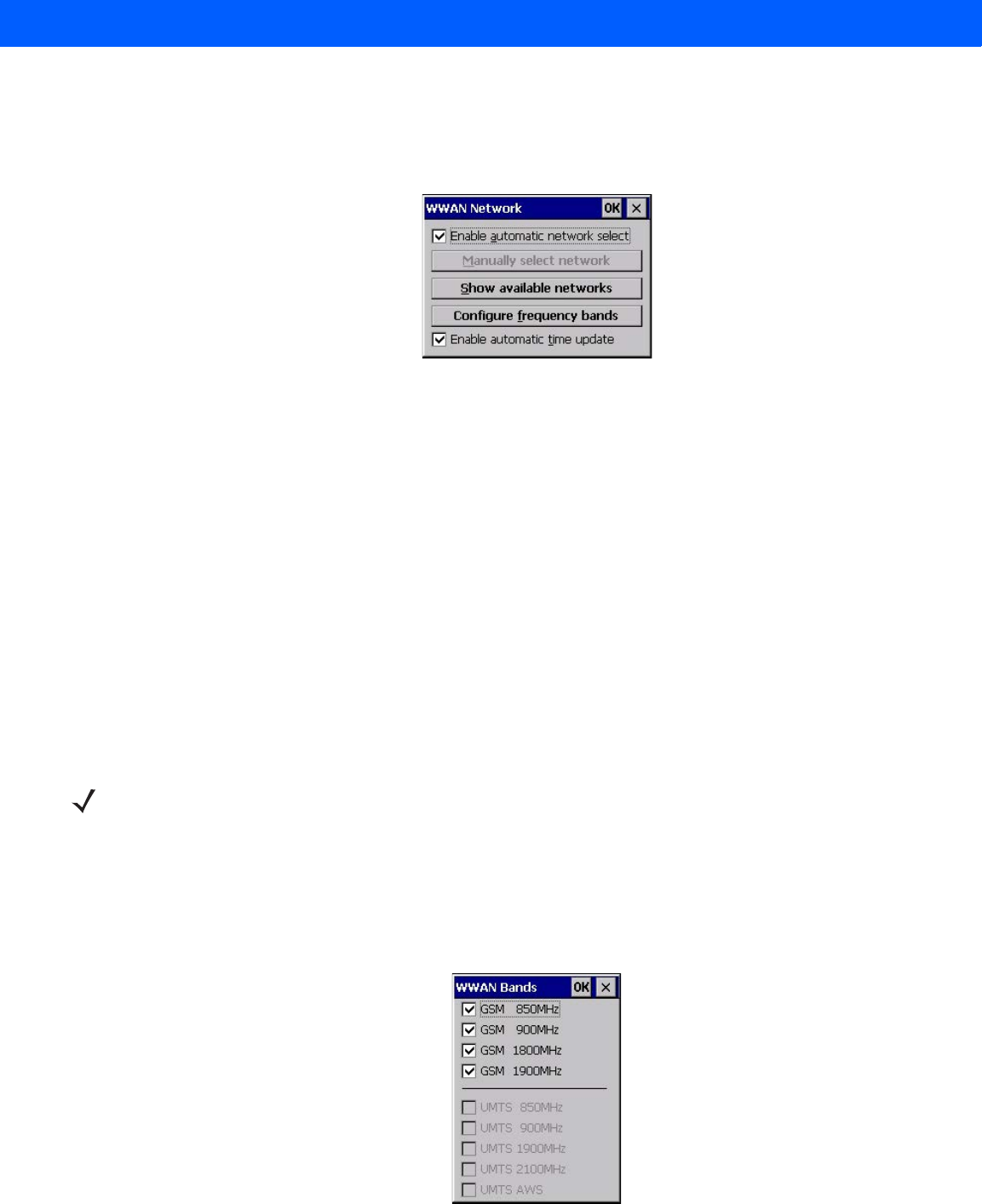
Wireless Wide Area Network (WWAN) Settings G - 9
Network Configuration
In the main Wireless WAN window:
• Tap on the Tools menu, and choose Network.
Enable Automatic Network Select
By default the GSM radio modem automatically chooses from the available and allowed networks (allowed
networks are the home network and all other networks with which the home network has a roaming agree-
ment). You may find there are some situations in which you want to override this default behaviour. For
example, you may want to disable roaming if you find yourself in a border area where the home network is not
available but a foreign roaming partner is available. Abroad, you may find that an available network does not
have GPRS roaming agreements. In this case, you’ll need to manually select the network which you know to
support GPRS roaming.
Automatic network selection is enabled or disabled by checking or unchecking Enable automatic network
select in the Network dialog box. When automatic network selection is disabled, you must select a
network manually.
Show Available Networks
Available networks can also be viewed without changing any settings. Scanning for available networks is a
lengthy operation — a progress bar is shown while the scan is active. For every network that is found, the
network name, country, status and numeric network identifier (MCC/MNC, Mobile Country Code followed by
the Mobile Network Code) is displayed.
Configure Frequency Bands
NOTE Your home network operator will need to let you know which other networks have roaming agree-
ments. Even when a network is listed with an Available status, it does not necessarily follow that it
can be used or that the roaming agreement covers GPRS.
A status of Forbidden indicates that the network cannot be used. If you choose a network that is
not covered by a roaming agreement, the status in the main WWAN dialog box changes to Emer-
gency calls only, No network found, GPRS not available or GPRS not allowed.
Draft #4 for review
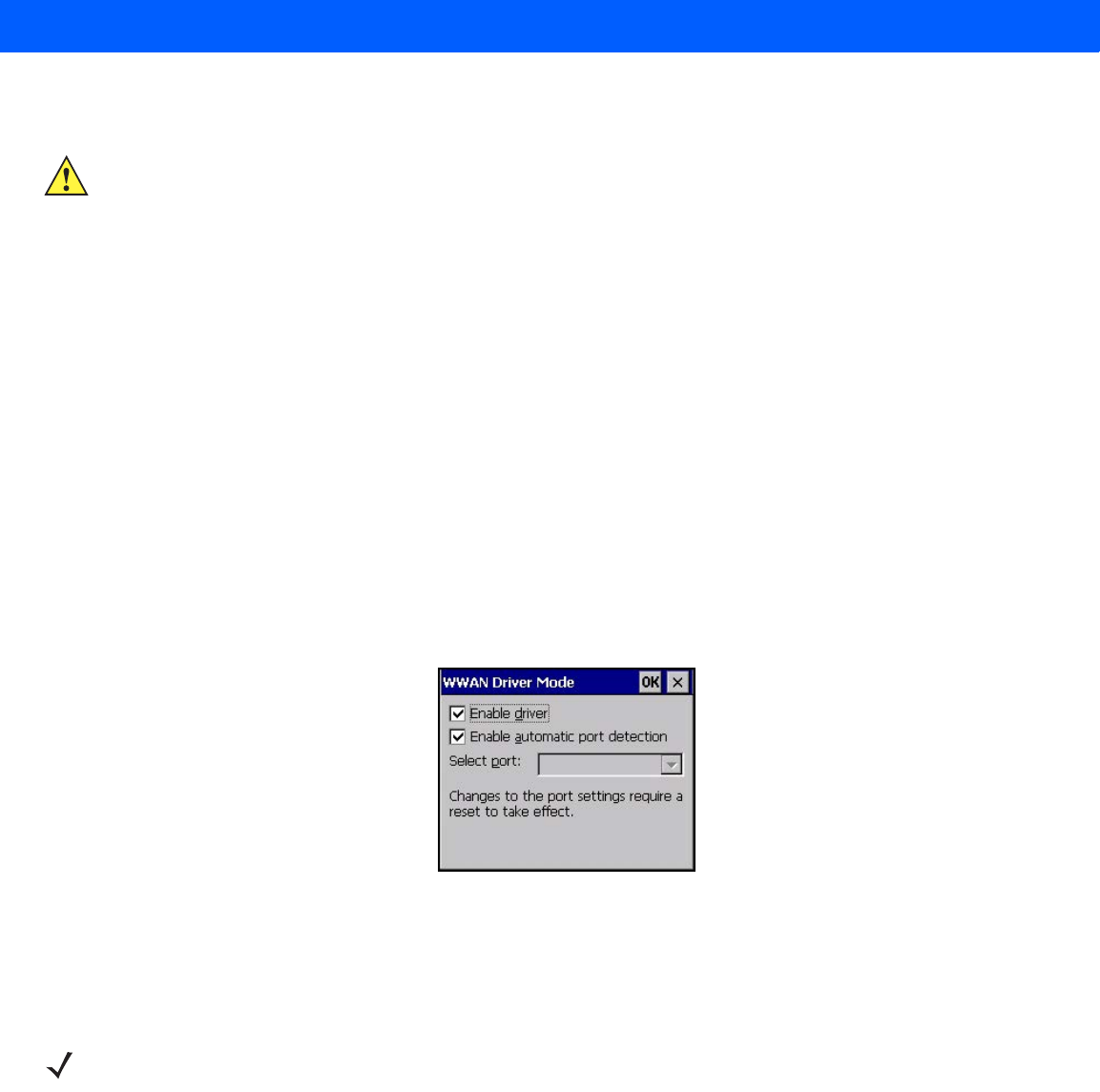
G - 10 Omnii Hand-Held Computer with Windows CE 6.0 User Guide
The network selection can be modified by enabling or disabling GSM and UMTS frequency bands.
By default all bands supported by the installed WWAN modem are enabled. All bands that are not supported
by the installed modem are greyed-out. While some modems (e.g. Cinterion PH8-P) allow all possible combi-
nations of supported bands to be selected, others do not (e.g. Cinterion MC75i). A warning is displayed if an
unsupported band combination is chosen.
By enabling only bands in use on a given network, the network search time (e.g. after losing the network due to
a coverage gap) is improved. Through the band configuration it is possible to force the modem into GSM-only
or UMTS-only mode. As an example, this is useful if a legacy application needs to use a dial-up connection
and the network supports dial-up connections only on GSM but not on UMTS (as is the case with many Euro-
pean networks).
Enable Automatic Time Update
If this feature is enabled, it allows the system time and time zone to be updated with information received from
the WWAN network. This feature is network-dependent. If the WWAN network supports NITZ (“Network Infor-
mation and Time Zone”), then it can send the current time, time zone, or both to the terminal.
Driver Mode Configuration
By default, the Wireless WAN driver is enabled (the Enable driver check box is checked). If the Enable driver
check box is not checked, the driver is shut down as soon as the OK button in the Driver Mode dialog box
is chosen.
If, on the other hand, the Wireless WAN driver is not running and the Enable driver check box is checked, the
Wireless WAN driver is started as soon the Driver Mode dialog box is closed using the OK button.
Since all currently supported GSM modems are automatically detected, the Enable automatic port detection
check box should always be checked. If this check box is not checked, a serial port can be selected manually.
This experimental feature allows the driver to be used with an internal GSM modem that was not recognized by
the automatic detection or an external GSM modem connected to a serial port of the computer through USB or
through Bluetooth. An external modem connected to a serial port must support 115.2 kbit/s, 8bit, no parity and
hardware flow control.
IMPORTANT Care must be taken when disabling bands — the wrong band will prevent the modem
from registering with the network (that is, not even emergency calls are possible if a
mistake is made).
NOTE When the driver is not running, no network status or signal strength can be displayed.
Draft #4 for review
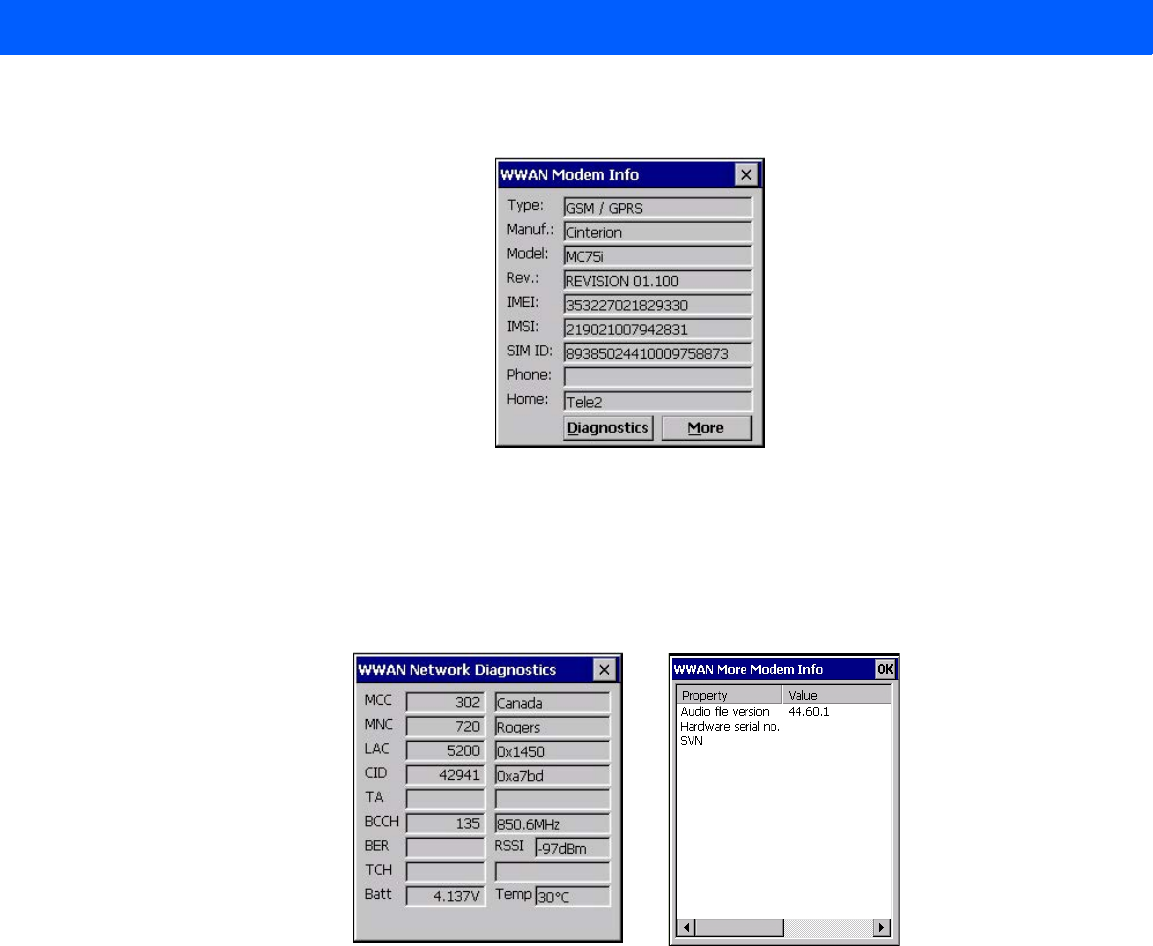
Wireless Wide Area Network (WWAN) Settings G - 11
Modem Information
The fields in this dialog box cannot be edited, they only display information about the computer’s modem. If the
network operator has not programmed a user’s phone number into his SIM, the Phone: field remains empty. If
the main menu shows an error status, at least partial modem information may be available.
Diagnostics and More
The Diagnostics screen may be useful when diagnosing network problems. The information presented here is
not needed for normal operation. The More button shows you some additional detail about your modem.
The following Diagnostics values are displayed:
• MCC Mobile Country Code (decimal value and, if available, decoded country name)
• MNC Mobile Network Code (decimal value and, if available, decoded network name)
• LAC Location Area Code (decimal and hexadecimal value)
• CID Cell Identifier (decimal and hexadecimal value)
• TA Timing Advance (decimal value and converted distance to base station in meters)
• BCCH Broadcast Control Channel (ARFCN or UARFCN value and converted frequency in MHz)
• BER Bit Error Rate
• RSSI Received Signal Strength Indication
• TCH Traffic Channel (ARFCN value and converted frequency in MHz)
• Batt Battery voltage as measured by the WWAN modem
• Temp WWAN modem Temperature
Draft #4 for review
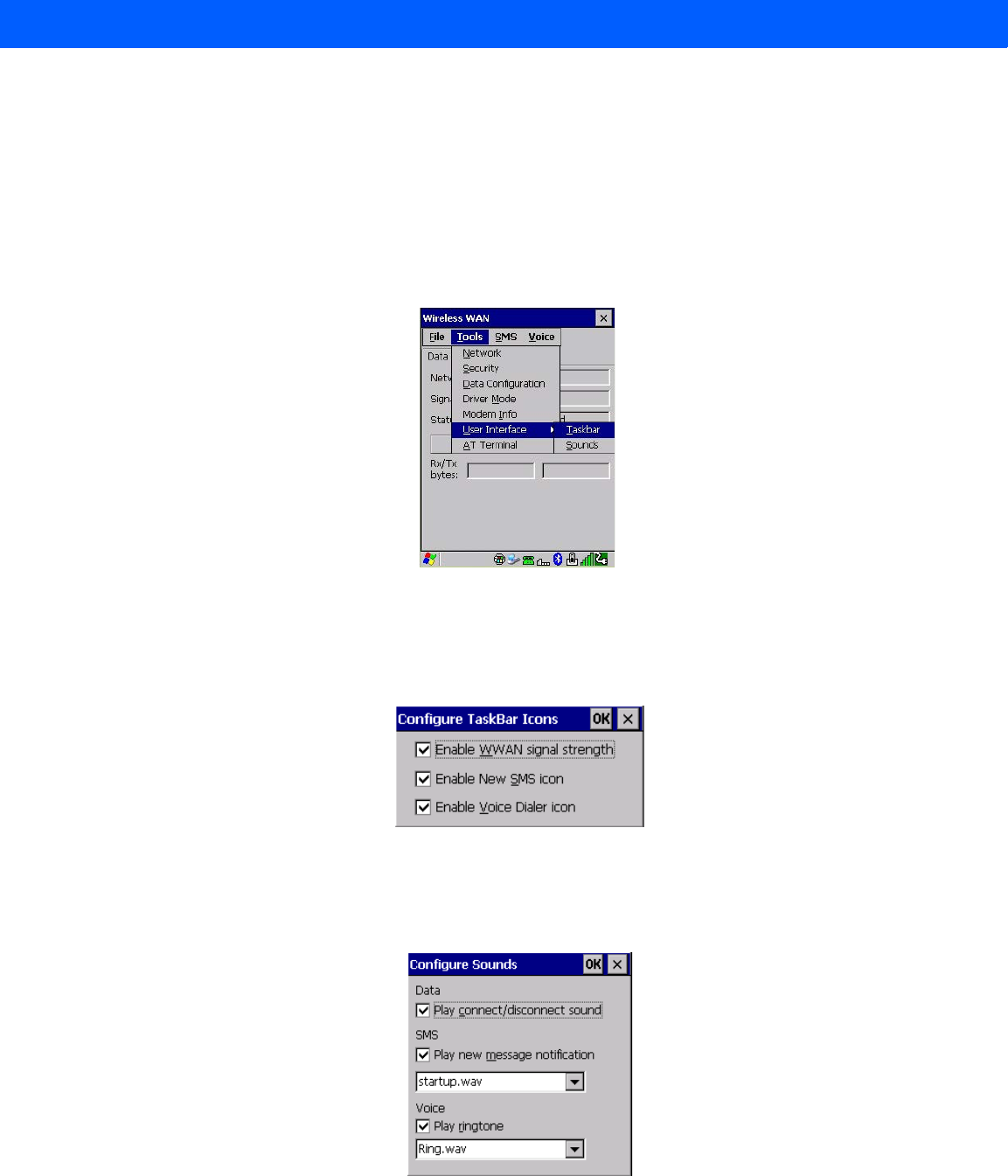
G - 12 Omnii Hand-Held Computer with Windows CE 6.0 User Guide
Note that TA, BER, and TCH are available only in GSM mode and only while there is an active connection (e.g.
a voice call). If the status in the main window shows No network found or Searching for network, then typically
only Batt and Temp are available. For the status Emergency calls only, MCC, MNC, LAC, CID, and BCCH may
be available. For the GSM 1800 MHz and GSM 1900 MHz bands it may not be possible to convert the ARFCN
for BCCH and TCH to a frequency because the channel numbers overlap. This can be overcome by enabling
only the GSM bands used by a particular network (i.e. either GSM 1800MHz or GSM 1900 MHz is disabled). If
the network uses frequency hopping during GSM voice calls, then hopping is displayed in the TCH field.
User Interface
Taskbar
Choosing Taskbar displays a dialog box in which you can determine which Wireless WAN icons will be
displayed in the taskbar.
Sounds
Tapping on the Sounds option displays a dialog box in which you can customize which sounds your Omnii will
emit and when these sounds will be played.
Draft #4 for review
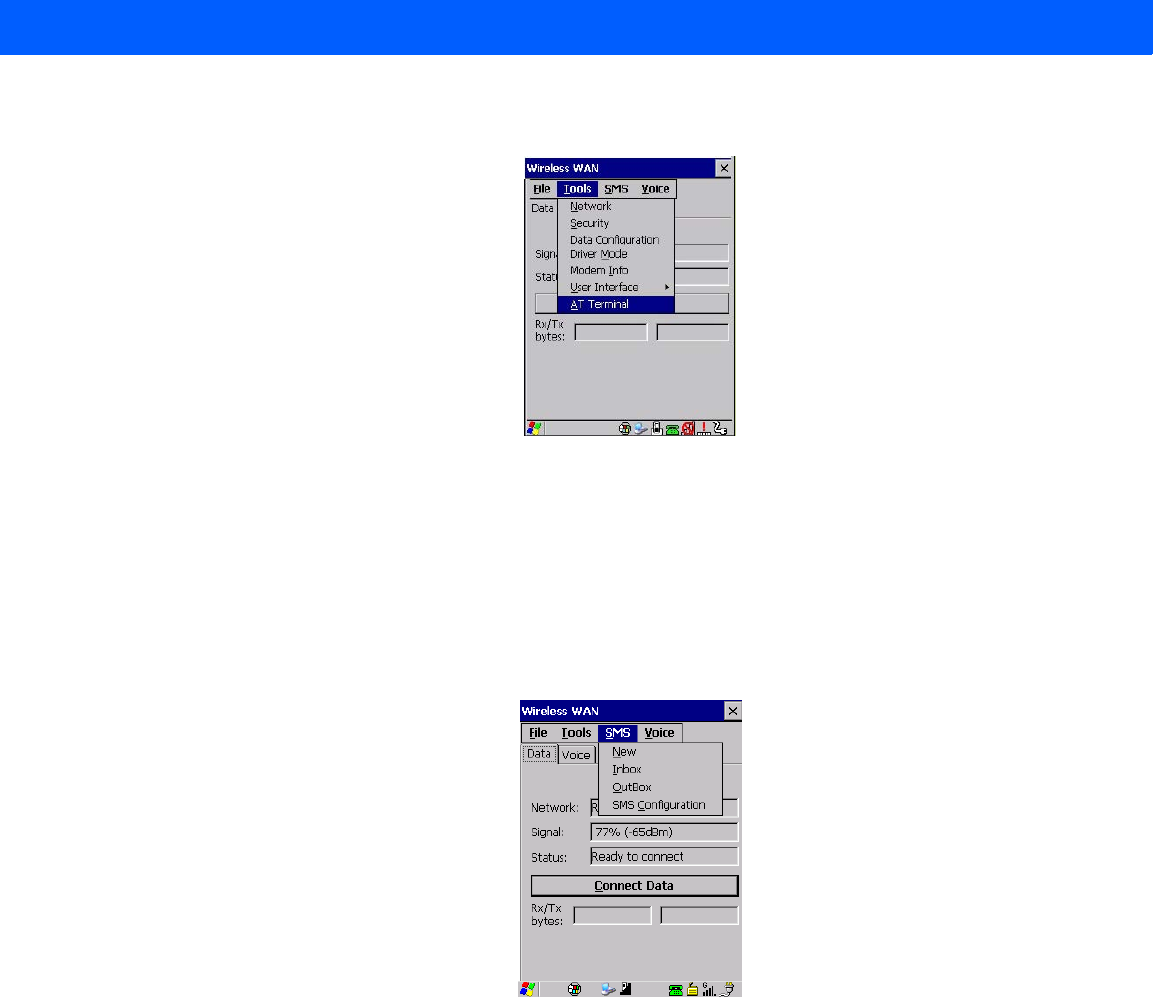
Wireless Wide Area Network (WWAN) Settings G - 13
AT Terminal
The AT Terminal window allows AT commands to be entered and sent to the modem. In some situations (e.g.
during approval testing) it may be required to enter AT commands. This feature should only be used if one has
a good understanding of the AT command set of the installed WWAN modem.
SMS Menu
SMS (Short Message Service) functions are accessed through the SMS menu. For modems that support a
SIM card, the SIM initialization typically takes longer than the network initialization, resulting in a noticeable
delay before the SMS functions become available.
New
Tapping on the New button opens a dialog for sending a new SMS message. The recipient's phone number (to
be entered in the To: field) can consist of the digits 0 through 9, as well as the * and # characters, optionally
preceded by one + character, indicating an international number (i.e. the country code follows immediately
after the + character).
By checking the Store message in Outbox field a new message can be stored in the Outbox before being sent.
If no storage space is available, or the modem does not support the storage of outgoing messages, then this
check box is disabled.
Inbox
Tapping on the Inbox button opens the list of received messages. Reading 50 messages, for example, from the
SIM can take about 30 seconds. By default the list of messages is sorted with the most recently received
message first. The list can be sorted by any other column by clicking on the corresponding column heading.
Clicking the same column heading twice reverses the sort order. Tapping on any letter or digit moves the high-
light to the next message whose address begins with that letter or number.
Draft #4 for review

G - 14 Omnii Hand-Held Computer with Windows CE 6.0 User Guide
The Open button opens the selected message in a new window such that the entire message can be read
including the original formatting (line breaks are replaced by spaces in the Inbox message list). Pressing the
Reply button opens the new message dialog as described above, except the destination phone number is
filled in already.
Outbox
Tapping on the Outbox button opens the list of sent messages. Otherwise the Outbox behaves exactly as the
Inbox described above. The date and time when a message was sent is not available for GSM modems.
SMS Configuration
Tapping on the SMS Configuration button opens the SMS configuration dialog. The SMS Centre address
follows the same rules as the recipient's phone number in the New message dialog. The message validity
period parameter is sent to the SMS Centre with each message sent subsequently and instructs the SMS
Centre on how long it should attempt to deliver the message to the recipient (the SMS Centre may impose an
upper limit on the validity period regardless of the setting).
The user interface tries to keep the SMS storage location available for a new incoming message if the Delete
oldest message when full check box is checked. In this case, when a new message arrives and the SMS
storage becomes full, the oldest received message is deleted. If any string is entered as the Message
Suppression Prefix, then messages beginning with that string will not be shown in either the Inbox or Outbox.
In this way messages intended for another application running on the same device can be hidden from the
user, as long as those messages begin with the string configured here.
Voice
The Voice tab is described in detail under Voice – Using the WWAN Phone Dialer on page 3-70.
Power Mode
The power mode of the modem is controlled through the Power menu in the Control Panel (not through the
Wireless WAN user interface). See WWAN Power Mode on page 3-43.
NOTE The date and time formats can be changed through the Region and Language menu in Control
Panel. For a new date or time format to take effect the Inbox has to be closed and re-opened.
NOTE Only certain discrete validity period values can be sent and thus the validity period is rounded to
the nearest allowed value. The next time the SMS configuration dialog is opened the rounded
value is shown.
Draft #4 for review
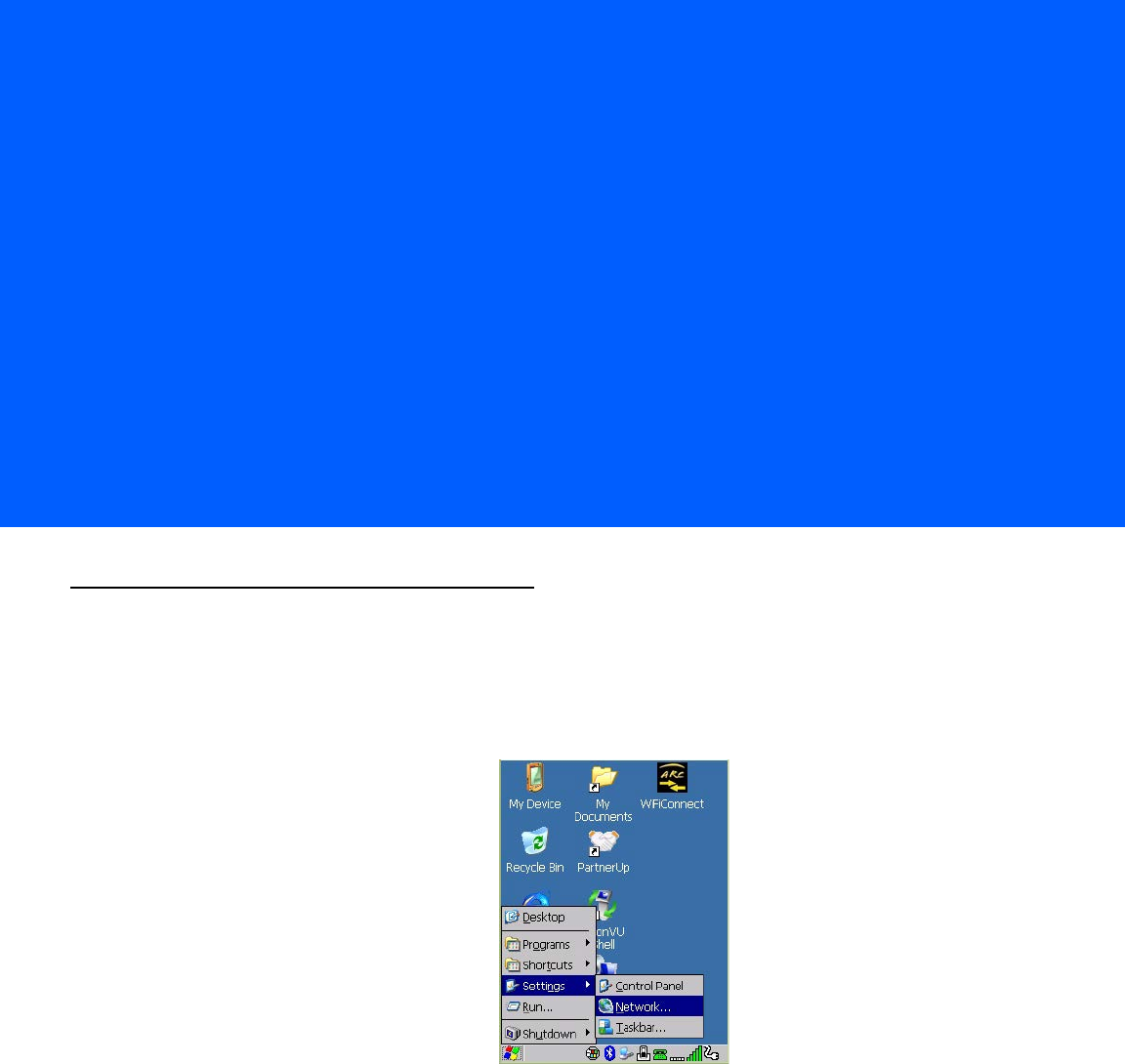
APPENDIX H WIRELESS ZERO CONFIG
SETTINGS
HWireless Zero Config Settings
Wireless Information
Wireless Zero Config, the Windows native supplicant, can be used to configure the radio. To ensure that Wire-
less Zero Config is activated, refer to Wi-Fi Config: Advanced on page 3-84.
•Tap on Start>Settings>Network and Dial-up Connections.
• Choose the radio icon representing the radio you want to set up — in the sample screen in Figure
H-1 802.11 Wireless LAN Settings Window on page H-2, this is labelled as SDIO86861
Draft #4 for review
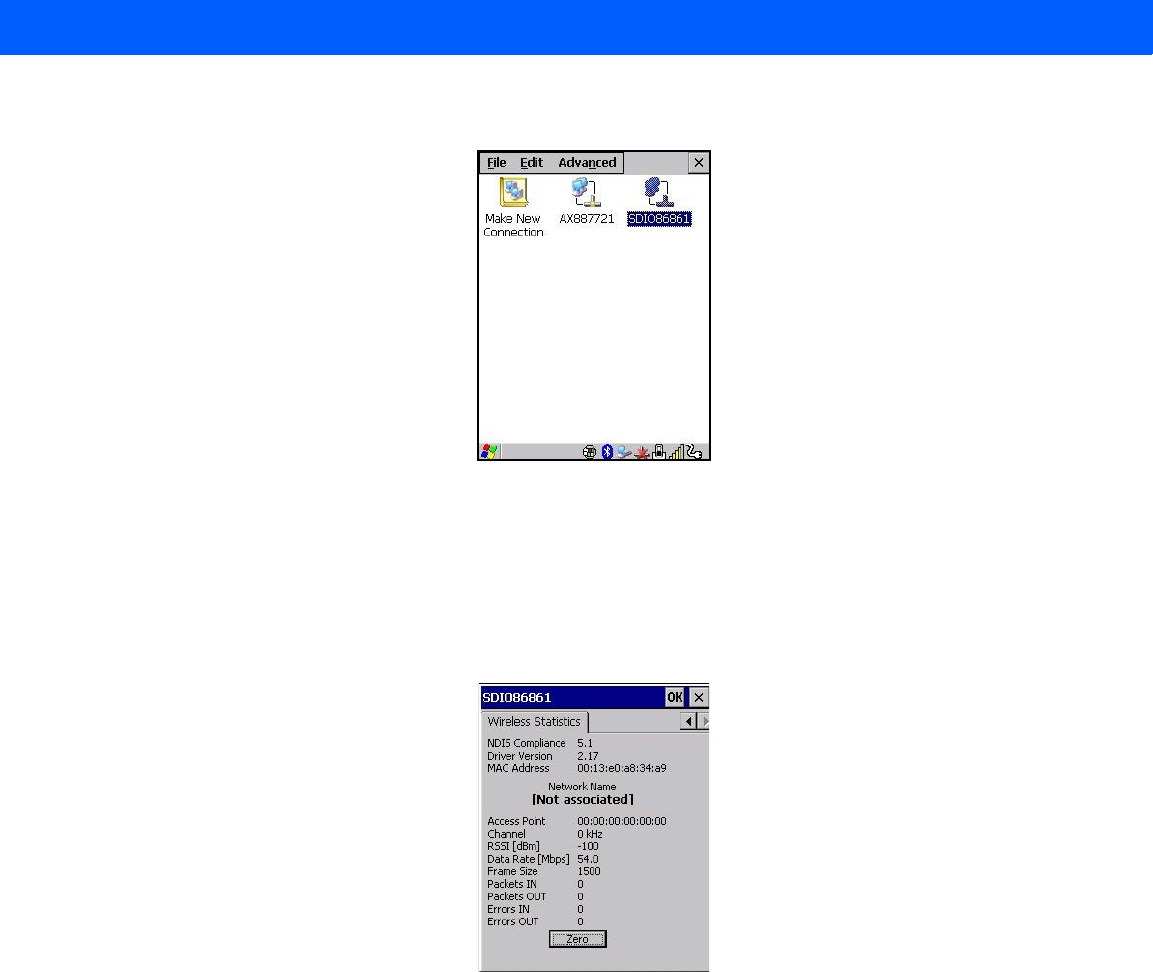
H - 2 Omnii Hand-Held Computer with Windows CE 6.0 User Guide
Figure H-1
802.11 Wireless LAN Settings Window
Wireless Statistics
When you choose the Wireless LAN icon, an 802.11 Wireless LAN Settings window is displayed. This tab
lists your radio statistics. Choosing the Zero button resets the statistics of the last four items — Packets IN,
Packets OUT, IN errors and OUT errors.
Figure H-2
Wireless Statistics
Wireless Information
This tab displays existing networks to which you can connect, and it allows you to add a new network or modify
the settings for an existing network.
•Configure button: To change the settings in an existing network, highlight the network you want to modify,
and tap on the Configure button to display the Wireless Properties dialog box.
•Connect button: To force connection to a specific, existing network, highlight the network to which you
want the Omnii to connect, and tap on the Connect button.
Draft #4 for review
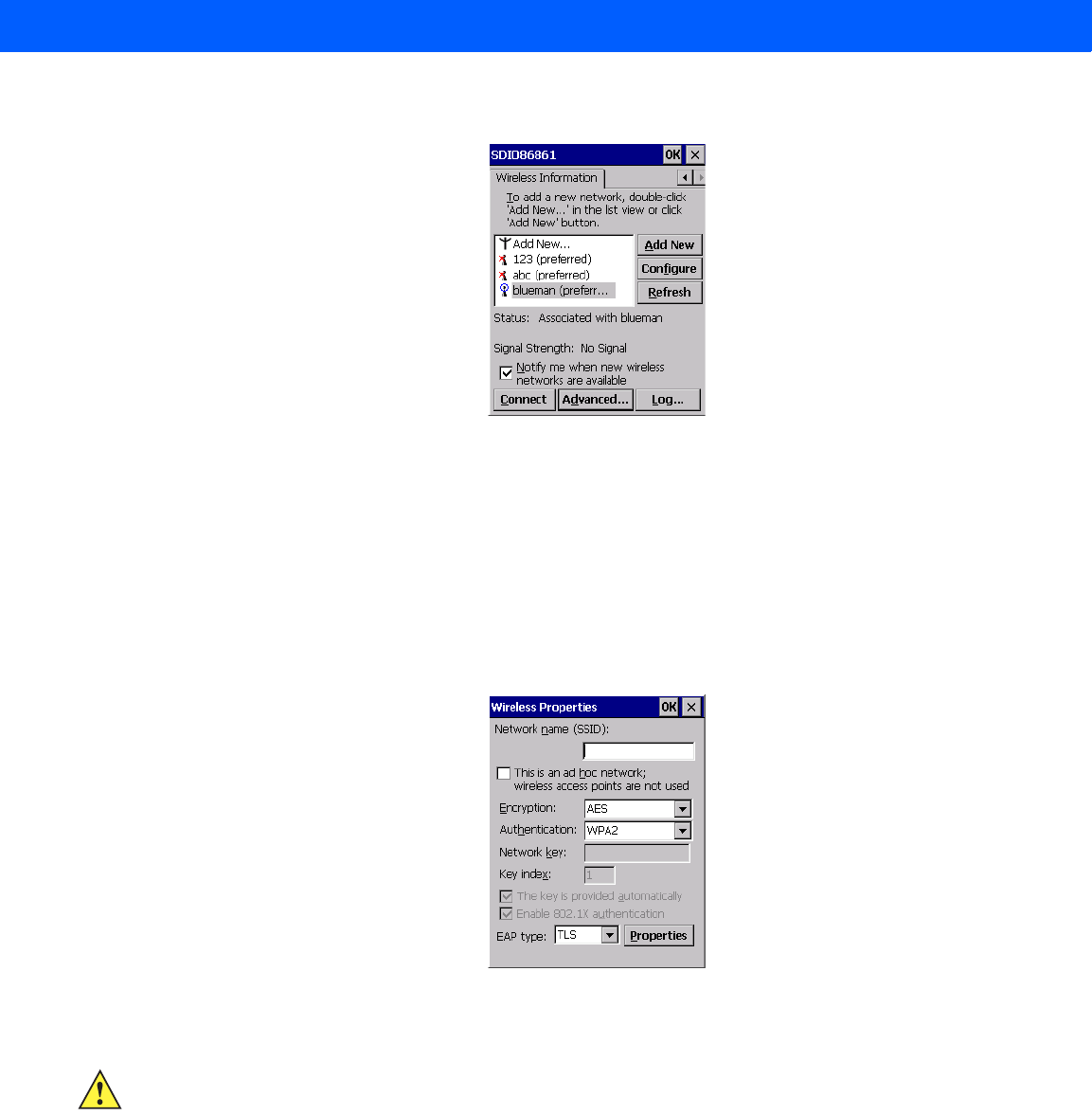
Wireless Zero Config Settings H - 3
Figure H-3
Wireless Information
This tab lists available networks — any access points that are broadcasting an SSID, and it lists preferred
networks — networks that you have configured. Since access points are generally secure, they will most likely
not be listed here. By default, the Omnii attempts to connect to preferred networks. This behaviour can be
changed by enabling Automatically connect to non-preferred networks in the Advanced dialog box (see Figure
H-6 Advanced Wireless Settings on page H-5).
• To add a new configuration, tap on the Add New button. A blank Wireless Properties dialog box
is displayed.
Wireless Properties
Figure H-4
Wireless Properties
• Type the appropriate SSID (Service Set Identifier) in the Network name (SSID): dialog box. The
Network name field can contain a maximum of 32 characters. The name assigned here is listed as
a preferred network.
•Ad Hoc And Infrastructure: If you are using an Infrastructure network — one in which the hand-helds
must pass data through an access point — leave the check box next to This is an ad hoc network blank.
If you are using an Ad Hoc network — a network in which the hand-helds pass data directly to other Ad
Hoc devices without an access point — add a checkmark in the check box next to This is an ad hoc
network to enable Ad Hoc.
•Encryption: WEP (Wired-Equivalent Privacy) encryption prevents others from accidentally accessing your
network. If you are not using encryption, you can choose Disabled from the drop-down encryption menu.
Otherwise, leave this field as is.
IMPORTANT Keep in mind that the Omnii will only communicate with access points that are configured
with the same SSID.
Draft #4 for review
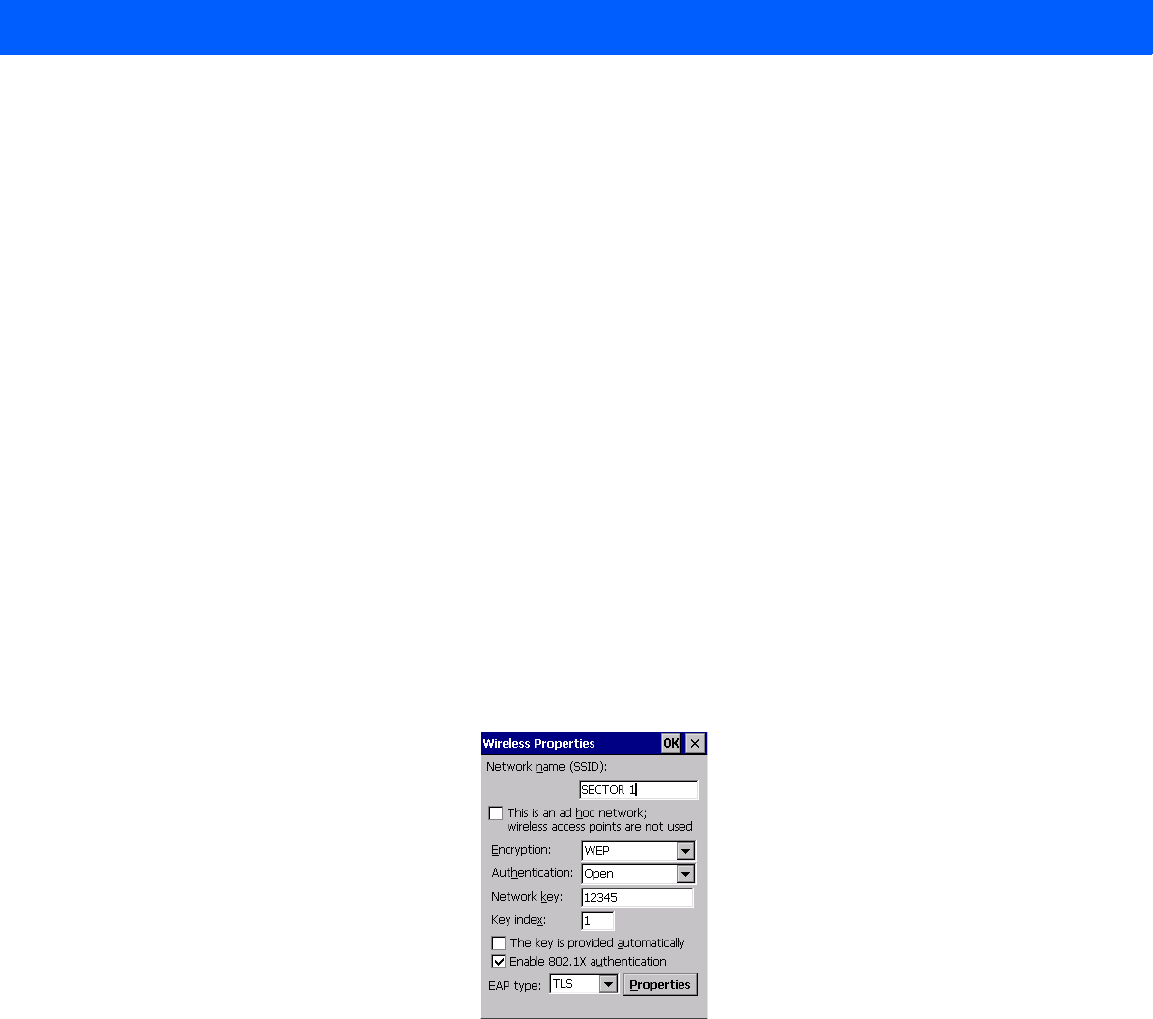
H - 4 Omnii Hand-Held Computer with Windows CE 6.0 User Guide
AES (Advanced Encryption Standard) is a standard for protecting data through encryption. AES
supports key sizes of 128 bits, 192 bits and 256 bits and will serve as a replacement for the Data
Encryption Standard (DES), which has a key size of 56 bits. In addition to the increased security that
comes with larger key sizes, the AES algorithm is a symmetrical block cipher that can encrypt (encipher)
and decrypt (decipher) information.
•Authentication: 802.11 supports several subtypes of network authentication services: Open, Shared,
WPA, and WPA-PSK. Under Open authentication, any wireless station can request authentication. The
station that needs to authenticate with another wireless station sends an authentication management
frame that contains the identity of the sending station. The receiving station then sends back a frame that
indicates whether it recognizes the identity of the sending station.
Under Shared authentication, each wireless station is assumed to have received a secret shared key over
a secure channel that is independent from the 802.11 wireless network communications channel.
Under WPA and WPA-PSK authentication, the use of 802.1x authentication is required. For wireless net-
works without a Remote Authentication Dial-In User Service (RADIUS) infrastructure, WPA supports the
use of a preshared key. For wireless networks with a RADIUS infrastructure, Extensible Authentication
Protocol (EAP) and RADIUS is supported.
•Network Key: This text box is used to specify a 5 or 13 ASCII character sequence or an equivalent 10 or
26 Hexadecimal digit sequence that matches the active WEP key on the access point.
To assign a Network key, highlight The key is provided automatically, and uncheck the check box to
disable this option.
Figure H-5
Network Key and Key Index
•Key Index: This field is used to identify the WEP key.
Enter a value from 1 to 4.
•Enable 802.1x authentication: 802.1X is the IEEE standard that offers additional security for local area
networks. It provides authentication for user devices attached to an Ethernet network, whether wired or
wireless. A security protocol packet such as TLS or MD5 encapsulated in an EAP is used in conjunction
with the 802.1X standard to authenticate users at the MAC layer. Available EAPs are listed in the
drop-down menu next to the EAP option.
To activate 802.1X, highlight 802.1x authentication, and check the check box.
•EAP Type (Extensible Authentication Protocol): This drop-down menu lists the EAP types available on
your system. The items in this drop-down menu will vary depending on your network setup. Keep in mind
also that some authentication protocols require that you select a Certificate. By selecting the Properties
button, you will be able to select a Certificate. Compass on page 3-17 provides a website that outlines how
to create certificates for your network.
Draft #4 for review
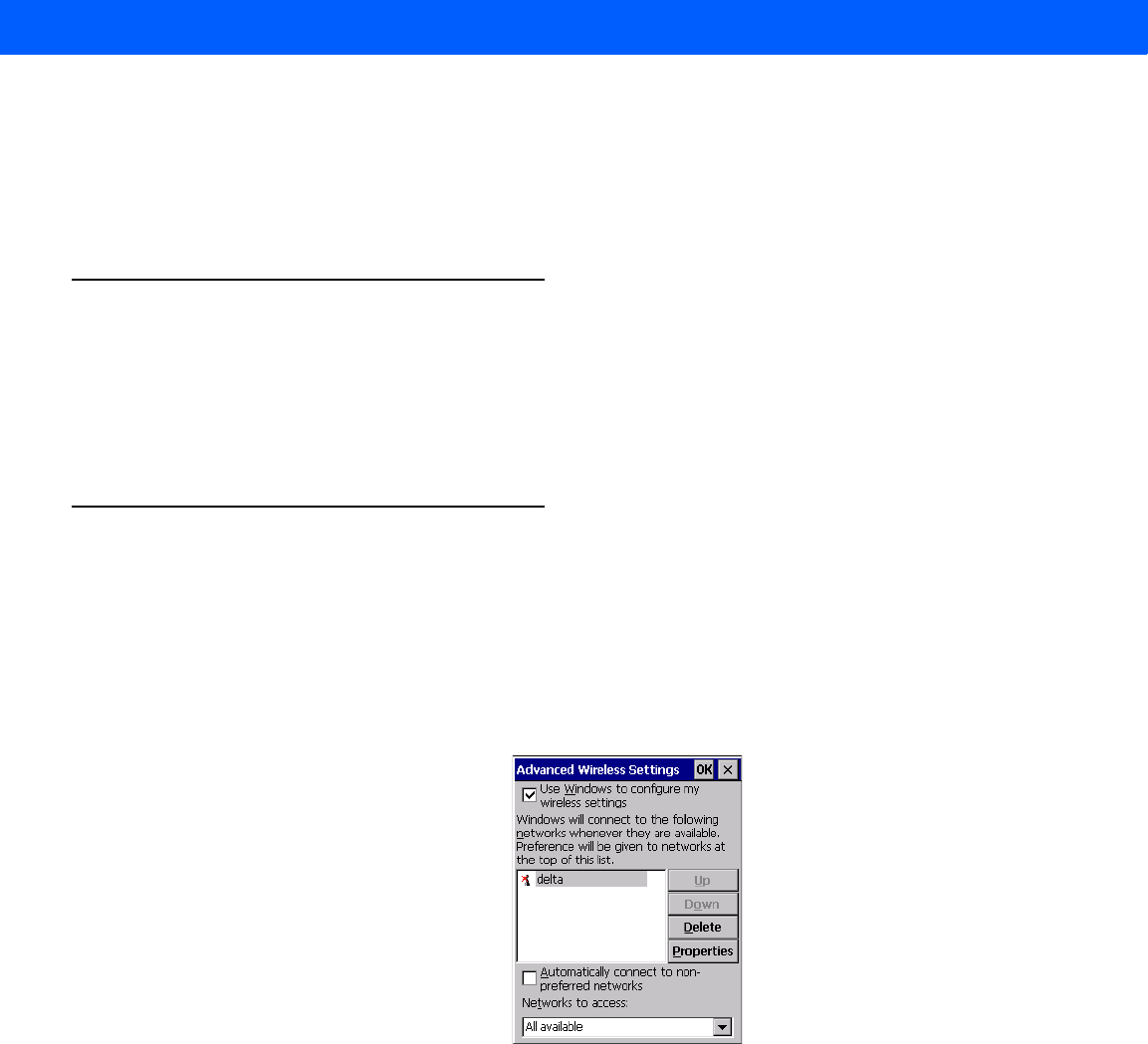
Wireless Zero Config Settings H - 5
•Saving and exiting the radio setup: Once you’ve completed the configuration, press [Enter], or tap
on OK.
The connection you created will be listed in the Wireless Information tab as a preferred network. The radio
will search for the SSID and compare the WEP and authentication information you specified. If there is a
match between the hand-held settings and the access point settings, the hand-held will communicate on
the network through the access point.
Assigning An IP Address
If your network is not using a DHCP server, you will need to assign an IP address. Refer to IP Address on
page 3-82 for details about assigning an IP address.
Name Server
Refer to Name Server on page 3-83 for details about this option.
Advanced Features
To display the Advanced Wireless Settings dialog box:
• Tap on the Advanced button in the Wireless Information tab. (Refer to Figure H-3 Wireless Information.)
This window lists the available preferred networks.
Figure H-6
Advanced Wireless Settings
Rearranging Preferred Networks
The Omnii attempts to connect with the networks listed in this dialog box in sequence, beginning at the top of
the list. If you need to rearrange this list of networks — move networks up and down in the list:
•Tap in the Networks List, and highlight the network that you want to move up or down in the list.
• To move the highlighted item in the list upward or downward, tap on the Up or Down button.
Deleting A Preferred Network
To delete a network from this list:
• In the preferred networks list, highlight the network you want to remove.
• Tap on the Delete button.
Draft #4 for review

H - 6 Omnii Hand-Held Computer with Windows CE 6.0 User Guide
Changing Network Properties
To change the properties of an existing preferred network:
• Highlight the network that you want to modify.
• Tap on the Properties button.
• Make any necessary changes in the Wireless Properties dialog box, and press [Enter] to save
the changes.
Draft #4 for review
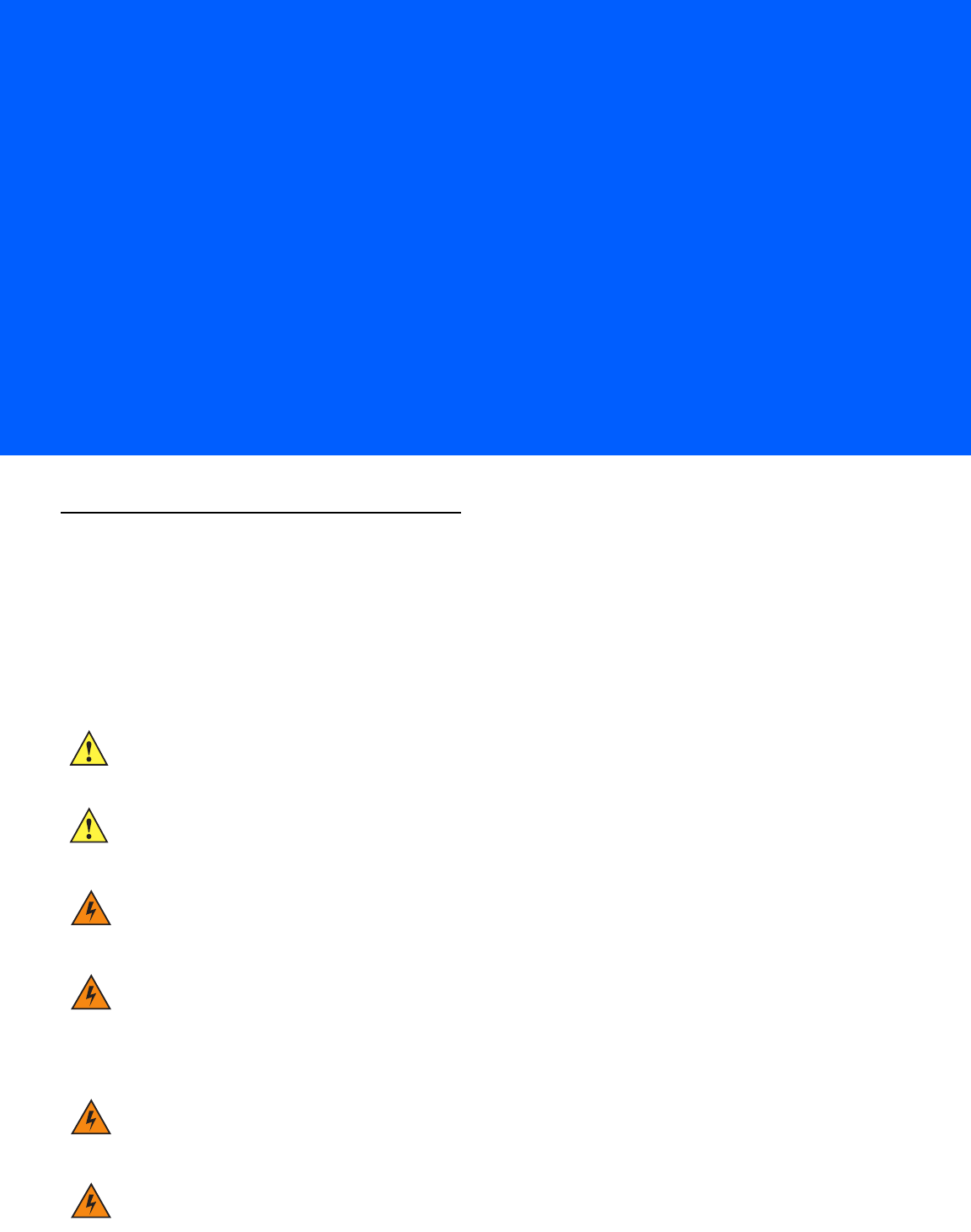
APPENDIX I OMNII XT15NI NON-INCENDIVE
SAFETY GUIDELINES
IOmnii XT15ni Non-Incendive Safety Guidelines
Omnii XT15ni (non-incendive) Important Safety & Regulatory Information
The Omnii XT15ni (non-incendive) Hand-Held Computer has been qualified by UL LLC to the requirements of
the USA and Canada for use in Class I, Division 2-Groups A, B, C and D T6 environments.
The users of this product are cautioned to use accessories and peripherals approved by Motorola. The use of
accessories other than those recommended, or changes to this product that are not approved by Motorola,
may void the compliance of this product and may result in the loss of the user's authority to operate the equip-
ment.
WARNING! This mark indicates that the user should read all included documentation before use.
WARNING! Ce marquage indique que l'usager doit, avant l'utilisation, lire toute la documentation
incluse.
WARNING! Explosion Hazard-Substitution of components may impair suitability for Class I,
Division 2 locations.
WARNING! This unit has NO OPERATOR REPLACEABLE PARTS other than the battery pack. Dis-
assembly/assembly of the Omnii XT15ni must be performed by trained Motorola
service personnel at a Motorola service depot. No unauthorized substitution of parts
is allowed for the Omnii XT15ni hand-held.
Use ONLY the Motorola Model ST3003-NI battery pack in the Omnii XT15ni. No substitutions are permit-
ted without authorization from Motorola personnel.
DO NOT CHARGE OR CHANGE BATTERIES in an area that is known to be hazardous. Replace batteries
in an area known to be non-hazardous.
Draft #4 for review

I - 2 Omnii Hand-Held Computer with Windows CE 6.0 User Guide
Omnii XT15ni Battery Information
The Omnii XT15ni hand-held operates with a specially adapted battery, model number ST3003-NI.
EXPLOSION HAZARD. DO NOT REMOVE OR REPLACE LAMPS, FUSES OR PLUG-IN MODULES (AS
APPLICABLE) UNLESS POWER HAS BEEN DISCONNECTED OR THE AREA IS KNOWN TO BE
FREE OF IGNITIBLE CONCENTRATIONS OF FLAMMABLE GASES OR VAPORS.
EXPLOSION HAZARD. DO NOT DISCONNECT WHILE THE CIRCUIT IS LIVE UNLESS THE AREA IS
KNOWN TO BE FREE OF IGNITIBLE CONCENTRATIONS.
WARNING! Exposure to some chemicals may degrade the sealing properties of materials used in
the following devices: battery packs, housings, LCDs, touchscreens, keypads.
Replacement of modules, housings, keypads, LCDs or touchscreens, end-caps, pods
or external connectors must only be performed at an authorized Motorola service
centre.
The battery pack used in this device may present a fire or chemical burn hazard if mistreated. Do not dis-
assemble, heat above 100°C (+212°F) or incinerate. Dispose of used battery packs promptly. Keep away
from children.
WARNING! The following additional warnings and cautions must be observed for the safety of
the operator and others in potentially hazardous locations:
The Omnii XT15ni must only be used when the ambient temperature is between
-20°C and +50°C (-4°F and +122°F).
The Omnii XT15ni may NOT be connected to any of its available accessories while in
potentially hazardous locations. This includes anything that uses the communica-
tions docking connector, headset, or microphone jacks. All allowed connections
must be made while outside of the potentially hazardous location.
The use of Compact Flash, Secure Digital, and SIM Cards in the Omnii XT15ni while
in potentially hazardous locations is permitted as long as these cards are not
removed or changed while in the hazardous location.
Any connector cover removed while in ordinary locations must be reinstalled before
entering a potentially hazardous location.
WARNING! The battery pack used in this device may ignite, create a chemical burn hazard,
explode, or release toxic materials if mistreated. Do not incinerate, disassemble, or
heat above 100°C (212°F). Charge ONLY with Motorola Model ST3003-NI. Do not short
circuit; may cause burns. Keep away from children.
Use ONLY Motorola battery pack Model ST3003-NI. Risk of fire or explosion if incor-
rect battery pack is used. Promptly dispose of used battery pack according to the
instructions.
Draft #4 for review

Omnii XT15ni Non-Incendive Safety Guidelines I - 3
WARNING! Le block-plies utilisé dans cet appareil peut prendre feu, constituer un risque de
brûlure chimique, exploser ou dégager des substances toxiques s'il est manipulé de
façon inappropriée. Ne pas jeter au feu, démonter ou chauffer à plus de 100°C (212°F).
Ne charger qu'avec les dispositifs Motorola ST3003-NI. Ne pas court-circuiter; cela
pourrait causer des brûlures. Garder hors de la portée des enfants.
N'utiliser que le modèle de bloc-plies Motorola ST3003-NI. L'utilisation d'un mauvais
bloc-plies pourrait constituer un risque d'incendie ou d'explosion. Mettre rapidement
au rebut tout bloc-plies usé, conformément aux instructions.
Draft #4 for review
Draft #4 for review
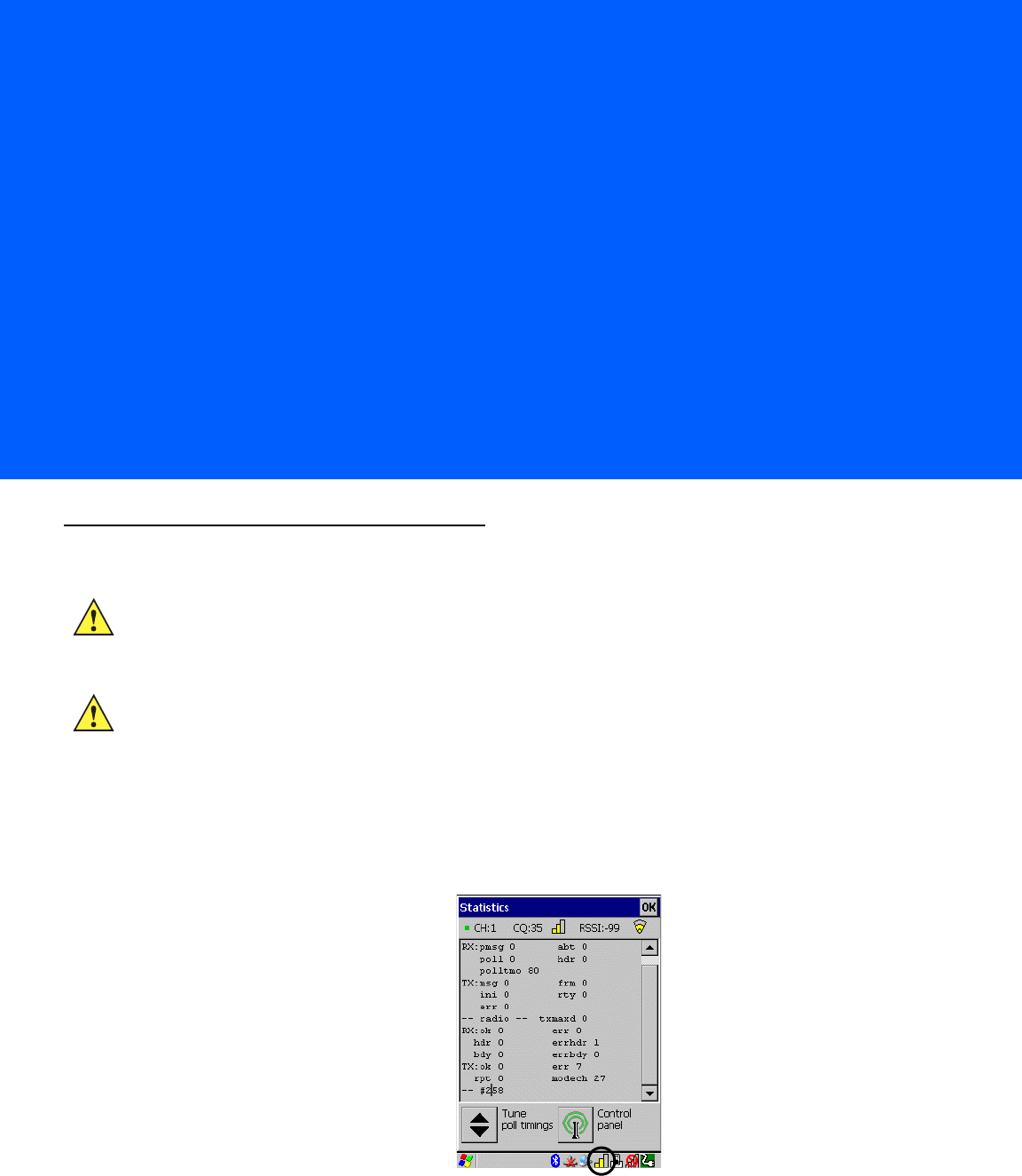
APPENDIX J NARROWBAND RADIO
CONFIGURATION
JNarrowband Radio Configuration
Narrowband Radio Setup
Only when the antenna is installed:
• Remove the battery cover, insert the battery, and replace the battery cover.
To display the Narrowband screens and the Control Panel:
• Click on the Narrowband icon in the taskbar.
Keep in mind that the Narrowband icon is only visible when a Narrowband radio is installed in the unit.
• Click on the Control Panel icon in the bottom-right corner of the Statistics screen to display the additional
Narrowband screens.
IMPORTANT Narrowband configuration has the keyboard microphone and audio receiver disabled to
disable headset mode. Only external Bluetooth audio is enabled with narrowband configu-
ration.
IMPORTANT For Narrowband radios, always attach the antenna, following the instructions on the
package, before inserting the battery.
Draft #4 for review
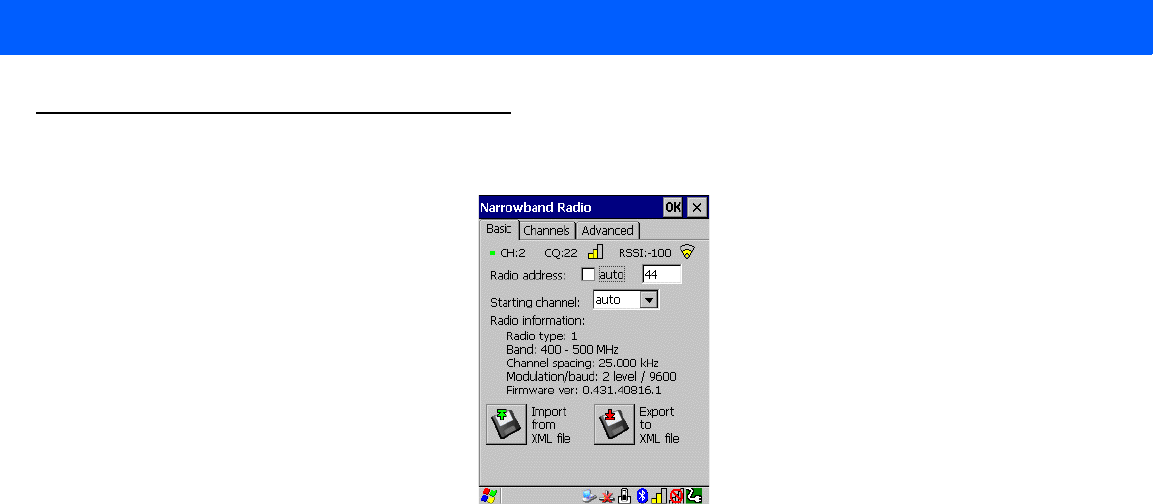
J - 2 Omnii Hand-Held Computer with Windows CE 6.0 User Guide
Basic Tab
CH (Channel)
CH displays the current channel. This value may change when a channel is out of range. Active channels are
assigned in the Channels tab (see Channels Tab on page J-3).
CQ (Channel Quality)
This option displays the channel quality. CQ (Channel Quality) can be affected by the Channel switch speed
set in the Channels tab.
RSSI (Received Signal Strength Indicator)
RSSI is an indication of the power level being received by the antenna. The higher the RSSI number, the
stronger the signal.
Radio Address
If auto radio address is enabled, the hand-held requests an automatically assigned radio address. When auto
is selected, the next field in which a radio address can be entered manually, is not available.
The field to the right of auto is used to assign a radio address manually. Manually assigned radio addresses
must be predetermined by the system administrator before this field is completed. A unique value from 1 to
3840 must be assigned for each unit to identify each hand-held over the radio link. Initially, this field is set to 0
to prevent radio communication.
Starting Channel
This parameter determines the initial operating radio channel of the hand-held. When the unit is first powered
on and channel selection is set to auto (refer to Radio Address on page J-2), a starting channel is automatically
chosen. Otherwise, a channel from one to twenty can be chosen from the drop-down menu. Keep in mind that
only the channels that have been enabled are listed here.
Radio Information
This information is read from the radio installed in the unit and is not editable.
Import from XML File and Export to XML File
Import from XML file allows you to use a configuration that has already been created to set up your unit.
Export to XML can be used to clone a radio setup so that configuration need only be completed once and can
then be copied to an unlimited number of devices.
Draft #4 for review
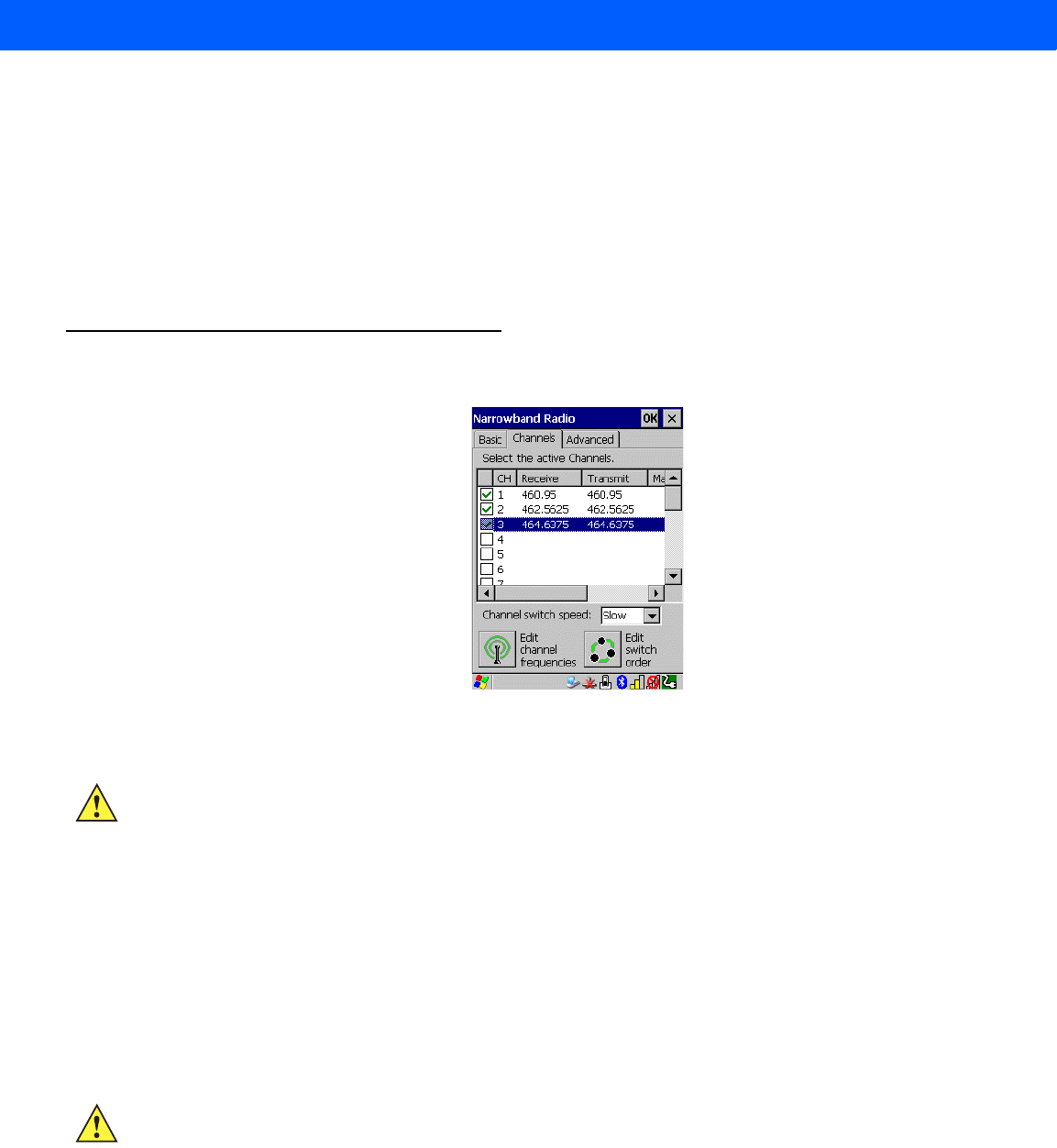
Narrowband Radio Configuration J - 3
• Configure the device once.
• Choose Export to XML file to export the configuration to an XML file – it will be named NBRadio_Set-
tings.xml automatically in the My Device folder.
•Copy the file to your PC or a USB key, and rename it to NBRadio_AutoLoadSettings.xml.
• On a new unit, copy this file to the root directory (the My Device folder).
• Warm reset the unit.
The XML file will be auto-loaded onto the device (and deleted). The device is ready for use.
Channels Tab
This tab lists the channel frequency pairs. Channels can be enabled or disabled here. Refer to Edit Channel
Frequencies on page J-4 to learn how to add or edit frequencies.
Channel Switch Speed
This parameter changes the threshold the hand-held uses to determine when communication quality with a
base station is unacceptable. When this threshold is exceeded, the unit starts channel searching for a new
base station.
Setting this parameter to Slow means a higher threshold – the hand-held is more tolerant of poor communica-
tion quality. When the channel quality of the hand-held radio drops below the percentage assigned in the
Advanced tab under Low CQ (see Low CQ (Channel Quality) on page J-7), the unit monitors the channel
quality for 15 time-out periods before searching for a new channel. If Channel Switch Speed is set to Fast, the
current channel is only monitored for up to 2 time-out periods before channel switching begins.
WARNING! Do not add frequencies that are not applicable to your license.
IMPORTANT Fast switch speed is most effective where coverage areas are largely overlapping. If the
coverage areas barely overlap, have dead spots, or if the hand-held frequently operates
on the fringe of coverage, this parameter should be set to Slow.
Draft #4 for review
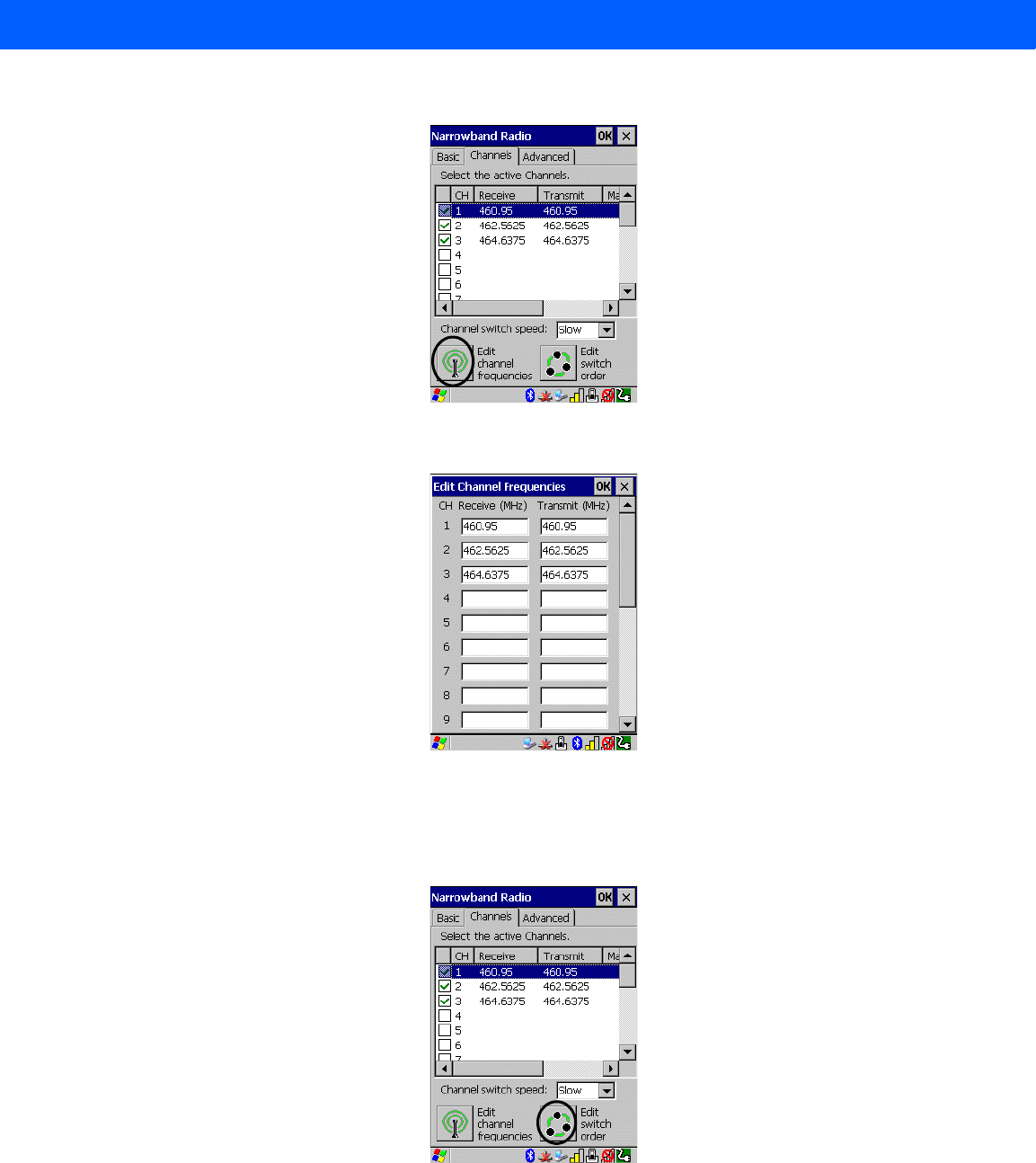
J - 4 Omnii Hand-Held Computer with Windows CE 6.0 User Guide
Edit Channel Frequencies
• Click on the Edit channel frequencies button in the bottom-left corner of the tab to display the Edit
dialog box.
• In the appropriate channel field, type the Receive and Transmit frequency for the channel, and click OK.
You can either edit an existing frequency if required or assign new frequencies for a new channel, keeping
in mind that you can only use frequency pairs assigned to your license.
Edit Switch Order
When a channel is out of range, the Edit switch order screen allows you to indicate the order in which channels
will switch. Edit switch order (the button) is rarely used. It is used when the order of channel switching needs to
be tightly controlled. It is not recommended that Edit switch order be used without a clear understanding of how
to order the channel sequences for optimum performance.
Draft #4 for review
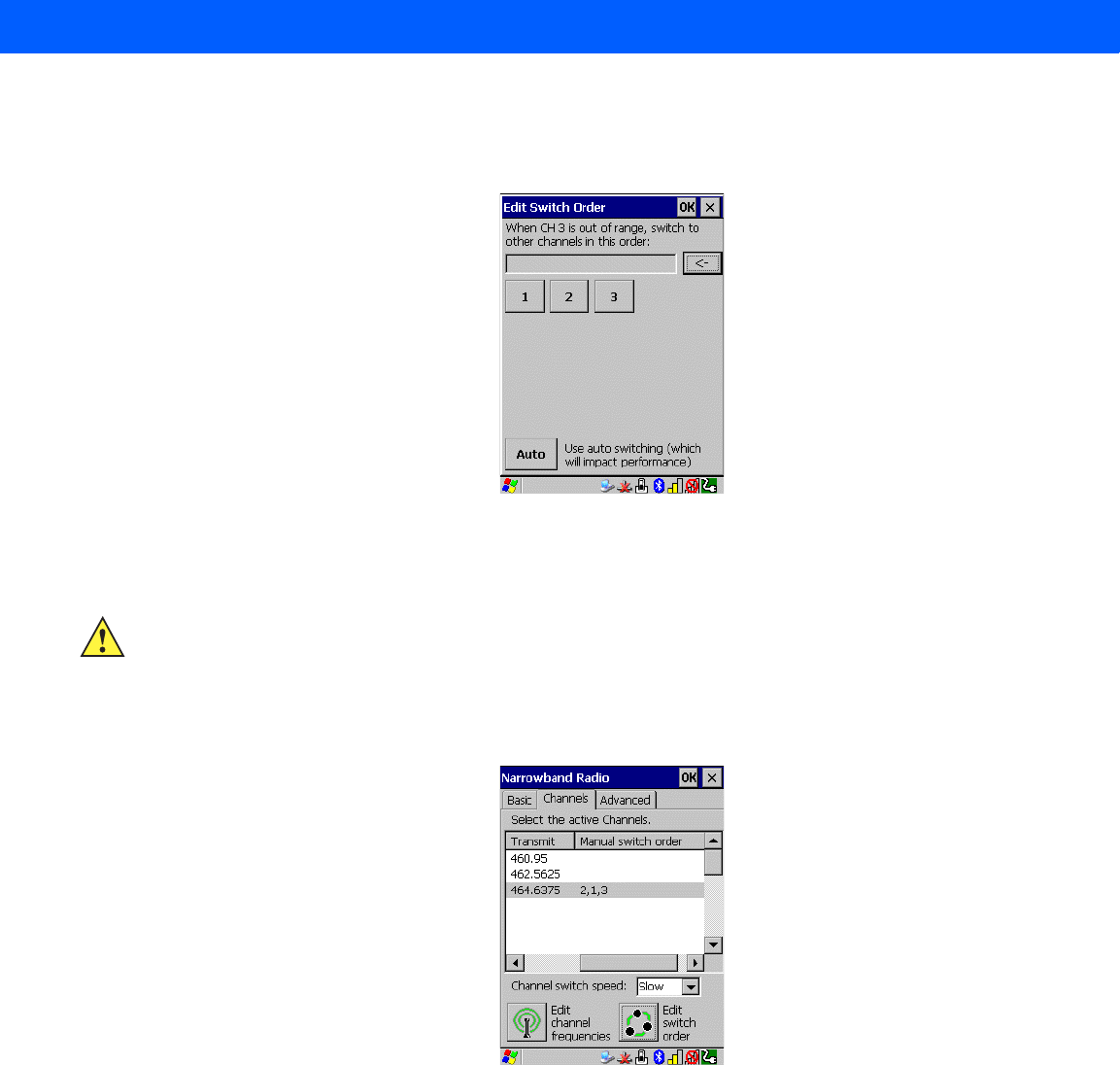
Narrowband Radio Configuration J - 5
• Highlight the channel you want to edit in the Channel tab before clicking on the Edit switch order button.
• Next, tap on the Edit switch order button in the lower-right corner of the Channel tab to configure channel
switching order.
• Tap on the channel numbers in the order you want them to switch – in the sample screen for example, you
can click on channels 1, 2 and 3 in the order you want the channels to switch.
• Click on OK.
The manually ordered channels are listed in the Manual switch order column in the Channels tab.
• Scroll to the right to display the manually ordered channels.
If communication quality falls below the channel quality percentage specified in the Advanced tab under
Low CQ (see Low CQ (Channel Quality) on page J-7), only the channels entered in the Manual switch order
are considered for channel switching. The channel search is carried out in the order in which the channels
were selected.
IMPORTANT Clicking on Auto clears the manually selected channel order.
Draft #4 for review
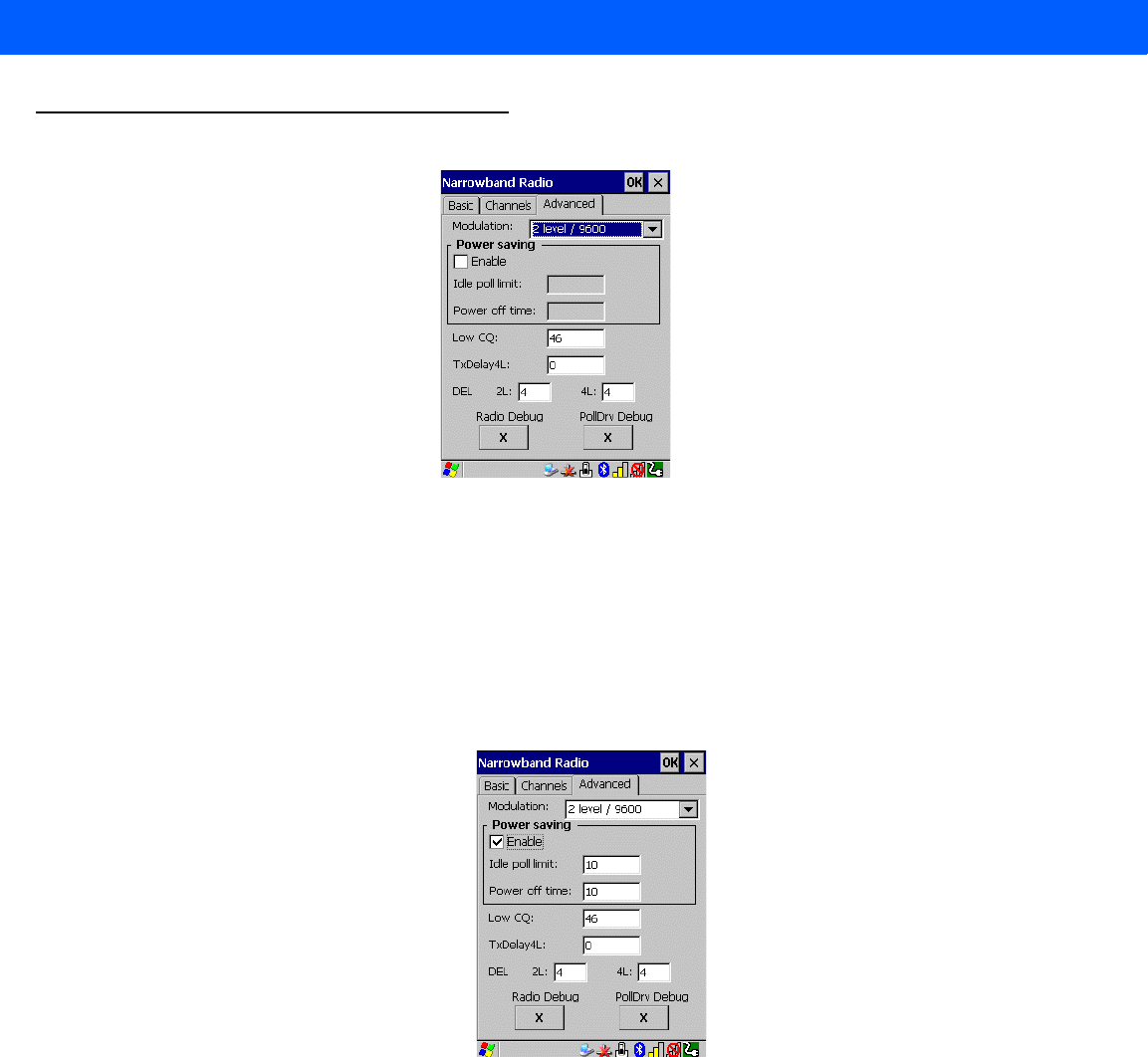
J - 6 Omnii Hand-Held Computer with Windows CE 6.0 User Guide
Advanced Tab
Modulation
The drop-down Modulation menu allows you to choose a modulation/baud rate. The modulation/baud rate
regulates the rate at which data is sent and how the data will be encoded. The value assigned to this param-
eter must be identical to the corresponding parameter in the base station. Modulation is limited by the radio
capabilities and the site license. Refer to Tune Poll Settings on page J-7 for additional details about choosing
an option and assigning poll timing parameters.
Power Saving
When Power Saving is enabled, the Idle poll limit and Power off time parameter values can be adjusted.
Idle Poll Limit
This parameter determines how many transmit opportunities – base station polls with available response
windows – must be consecutively skipped before the Omnii places the radio into power-down mode for power
saving. The allowable range for this parameter is from 1 to 200. The default value is 10. Lower values cause
the vehicle-mount to enter power saving mode quickly, extending battery life but reducing Omnii responsive-
ness. Higher values increase responsiveness but decrease battery life
Power Off Time
This parameter determines the amount of time (in seconds) the hand-held radio stays in power-down mode
when a power down period has been initiated. Power Off Time is only used when the Enable Power Saving
parameter is enabled.
Draft #4 for review
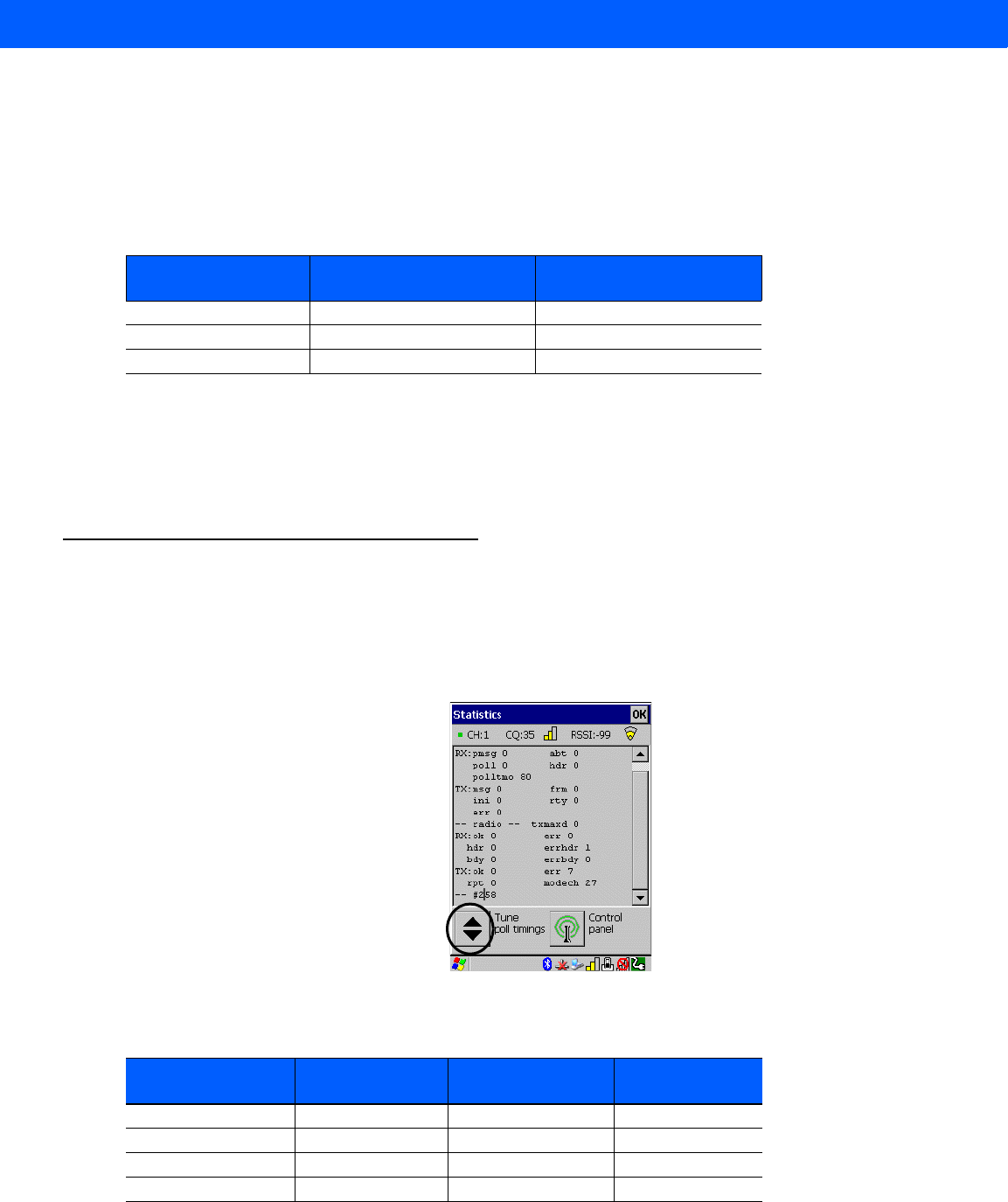
Narrowband Radio Configuration J - 7
Low CQ (Channel Quality)
This parameter is used to set the percent below which channel quality is deemed to be low.
TXDely4L, DEL: 2L and DEL: 4L
The values assigned to these parameter allow for optimized polling. The table below represent the best values
depending on your radio type.
Radio Debug
This parameter should never be tested without direction from authorized personnel.
PollDrv Debug
This parameter should never be tested without direction from authorized personnel.
Tune Poll Settings
The poll timing parameters assigned here are dependent on the value assigned to the Modulation/Baud Rate
parameter (see Modulation on page J-6).
• Tap on the Tune Poll Timings button in the bottom-left corner of the Statistics screen to display
the options.
The table following lists the appropriate values for each parameter.
Digital Radio Settings TRX73xx//RA1001/TRX7370
Legacy System
RA1001/RA1202/TRX7370
Modern System
#: of DELs – 2-level 10 4
#: of DELs – 4-level: 6 4
TXDelay - 4-level 11 0
Modulation/
Baud Rate
Sync Delay Window Delay Poll Timeout
4 Level / 19200 15 23 22
4 Level / 9600 27 27 25
2 Level / 9600 21 20 22
2 Level / 4800 25 28 37
Draft #4 for review
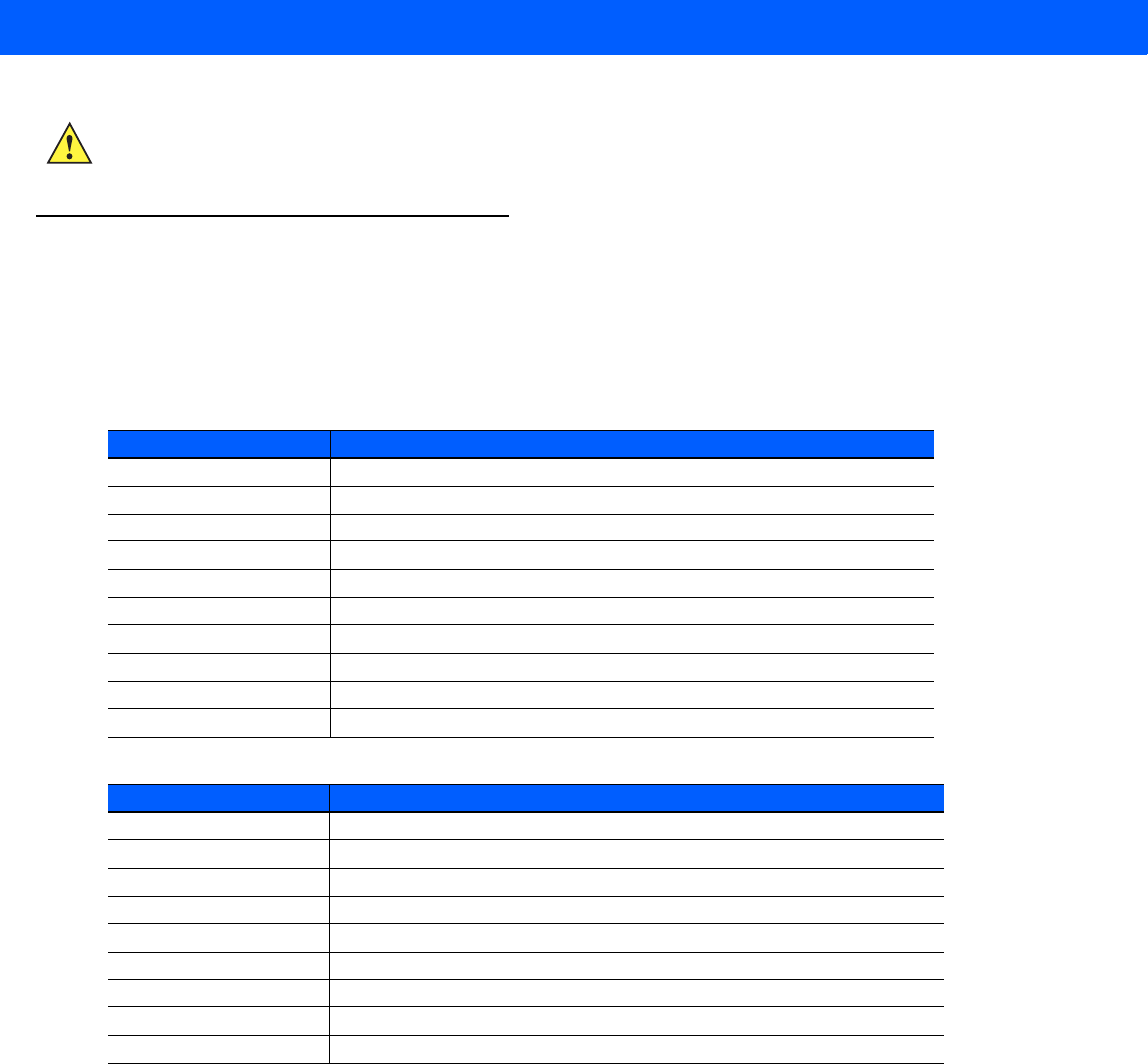
J - 8 Omnii Hand-Held Computer with Windows CE 6.0 User Guide
Statistics Screen
• Tap on the Narrowband radio icon in the taskbar to display the Statistics screen.
These statistics are updated every second while the dialog box is displayed.
The following table provides a brief description of these protocol and radio statistics.
IMPORTANT These parameters should not be changed without a clear understanding of radio protocol
timing.
Protocol Statistics Description
Rx: psmg: Number of received polls with attached message
Rx: abt: Number of received radio link aborts
Rx: poll: Number of received polls
Rx: hdr Number of received headers
Rx: polltmo Number of poll timeouts
Tx: msg: Number of transmitted messages, complete application messages
Tx: frm Number of transmitted frames
Tx: ini Number of transmitted radio link initialization messages
Tx: rty Number of transmitted retries
Tx: err Number of transmitted errors
Radio Statistics Description
Txmaxd Maximum delay in transmitted messages
Tx: err Number of transmit errors
Rx: err Received errors
Tx: ok Messages successfully transmitted
Modtech Number of complete mode changes
Rx: hdr Received poll headers without CRC error
Rx: bdy Received poll body without CRC error
Rx: errhdr Received poll header with CRC error or non-basestation message
Rx: errbdy Received poll body with CRC error
Draft #4 for review

INDEX
Index
Numerics
1D internal scanner . . . . . . . . . . . . . . . . . . . . . . . . . 2-14, 2-15
2D imager. . . . . . . . . . . . . . . . . . . . . . . . . . . . . . . . . . . . . . . 2-16
34-key freezer keyboard. . . . . . . . . . . . . . . . . . . . . . . . . . . . . . F-4
36-key keyboard
alpha keys, accessing . . . . . . . . . . . . . . . . . . . . . . . . . 2-7
uppercase letters, creating . . . . . . . . . . . . . . . . . . . . . 2-7
58-key freezer keyboard. . . . . . . . . . . . . . . . . . . . . . . . . . . . . . F-4
7545 freezer models See Omnii XT15f . . . . . . . . . . . . . . . . F-1
7545 Model See Omnii . . . . . . . . . . . . . . . . . . . . . . . . . . . . . . . . E-1
802.11a/b/g/n radio . . . . . . . . . . . . . . . . . . . . . . . . . . . . . . . . . . . .E-7
configuring . . . . . . . . . . . . . . . . . . . . . . . . . . . . . 3-76–3-85
A
accessories
carrying case . . . . . . . . . . . . . . . . . . . . . . . . . . . . . . . . . 4-4
desktop docking stations . . . . . . . . . . . . . . . . . . . . . . . 4-9
Ethernet cable . . . . . . . . . . . . . . . . . . . . . . . . . . . . . . . 4-15
hand strap. . . . . . . . . . . . . . . . . . . . . . . . . . . . . . . . 4-2, 4-3
holster, hard shell . . . . . . . . . . . . . . . . . . . . . . . . . . . . . 4-4
pistol grip. . . . . . . . . . . . . . . . . . . . . . . . . . . . . . . . . . . . . 4-1
quad docking station. . . . . . . . . . . . . . . . . . . . . . . . . . 4-13
vehicle cradle . . . . . . . . . . . . . . . . . . . . . . . . . . . . . . . . 4-16
Active Remote Configuration (A.R.C.) . . . . . . . . . . . . . . 3-85
AC Wall adaptor . . . . . . . . . . . . . . . . . . . . . . . . . . . . . . . . . . 4-6
Administrator Password (Kiosk settings). . . . . . . . . . . . 3-45
AGPS (Assisted Global Positioning System) . . . . . . . . 3-25
Aim Duration . . . . . . . . . . . . . . . . . . . . . . . . . . . . . . . . . . . . . . . . . C-4
aiming dot, duration of. . . . . . . . . . . . . . . . . . . . . . . . . . . . C-3, C-9
ALT Key. . . . . . . . . . . . . . . . . . . . . . . . . . . . . . . . . . . . . . . . . . 2-4
appearance (display colour scheme) . . . . . . . . . . . . . . . 3-20
appending to barcodes
characters . . . . . . . . . . . . . . . . . . . . . . . . . . . . . . . . . . . 3-53
App Launch Keys . . . . . . . . . . . . . . . . . . . . . . . . . . . . . . . . . 3-6
approvals, Omnii (including scanner) . . . . . . . . . . . . . . . . . .E-3
arrow keys
moving the cursor . . . . . . . . . . . . . . . . . . . . . . . . . . . . . 2-4
AT Terminal, WWAN. . . . . . . . . . . . . . . . . . . . . . . . . . . . . . . . . . G-13
audio indicators
adjusting volume . . . . . . . . . . . . . . . . . . . . . . . . . . . . . 2-12
description of beep conditions . . . . . . . . . . . . . . . . . 2-12
AutoRestore. . . . . . . . . . . . . . . . . . . . . . . . . . . . . . . . . . . . . 3-67
B
background, choosing for Desktop. . . . . . . . . . . . . . . . . 3-48
background image (display scheme) . . . . . . . . . . . . . . . 3-19
backlight
display . . . . . . . . . . . . . . . . . . . . . . . . . . . . . . . . . . . . . . 3-20
intensity . . . . . . . . . . . . . . . . . . . . . . . . . . . . . . . . . . . . . . 2-8
Backspace (DEL Key) . . . . . . . . . . . . . . . . . . . . . . . . . . . . . 2-4
backup Profile (Total Recall)
AutoRestore . . . . . . . . . . . . . . . . . . . . . . . . . . . . . . . . . 3-67
Clone to USB . . . . . . . . . . . . . . . . . . . . . . . . . . . . . . . . 3-67
creating . . . . . . . . . . . . . . . . . . . . . . . . . . . . . . . . . . . . . 3-64
Restore . . . . . . . . . . . . . . . . . . . . . . . . . . . . . . . . . . . . . 3-67
restoring . . . . . . . . . . . . . . . . . . . . . . . . . . . . . . . . . . . . 3-66
Upload to A.R.C. . . . . . . . . . . . . . . . . . . . . . . . . . . . . . 3-67
viewing. . . . . . . . . . . . . . . . . . . . . . . . . . . . . . . . . . . . . . 3-66
backups, managing profiles . . . . . . . . . . . . . . . . . . . . . . . 3-66
Bad Scan Vibrates . . . . . . . . . . . . . . . . . . . . . . . . . . . . . . . 3-54
barcode
appending to. . . . . . . . . . . . . . . . . . . . . . . . . . . . . . . . . 3-53
decodes required. . . . . . . . . . . . . . . . . . . . . . . . . . . . . . . . . C-9
decoding edge-to-edge. . . . . . . . . . . . . . . . . . . . . . . . . . . C-9
Decoding symbology predefined presets . . . . . . . . . .B-2
displaying type of barcode . . . . . . . . . . . . . . . . . . . . 3-53
parameters . . . . . . . . . . . . . . . . . . . . . . . . . . . . . . .3-51, C-1
Security . . . . . . . . . . . . . . . . . . . . . . . . . . . . . . . . . . . . . . . . . . C-9
Translation tab . . . . . . . . . . . . . . . . . . . . . . . . . . . . . . . 3-54
barcode reader
integrated scanner, operation of . . . . . . . . . . . . . . . 2-13
Draft #4 for review

Index - II Omnii Hand-Held Computer with Windows CE 6.0 User Guide
bar code symbologies
color camera . . . . . . . . . . . . . . . . . . . . . . . . . . . . . . . B-17, B-18
imager. . . . . . . . . . . . . . . . . . . . . . . . . . . . . . . . . . . . . . . . . . . .B-17
battery. . . . . . . . . . . . . . . . . . . . . . . . . . . . . . . . . . . . . . . 2-1–2-2
Advanced dialog box . . . . . . . . . . . . . . . . . . . . . . . . . 3-42
Battery Health dialog box . . . . . . . . . . . . . . . . . . . . . 3-43
Built-in Devices dialog box . . . . . . . . . . . . . . . . . . . . 3-42
capacity dialog box. . . . . . . . . . . . . . . . . . . . . . . . . . . 3-40
charger safety instructions . . . . . . . . . . . . . . . . . . . . . 4-7
charging . . . . . . . . . . . . . . . . . . . . . . . . . . . . . .1-4, 2-2, 4-7
charging with desktop docking station . . . . . . . . . . 4-11
contact pinout . . . . . . . . . . . . . . . . . . . . . . . . . . . . . . . . . . . . A-4
estimated battery backup time. . . . . . . . . . . . . . . . . 3-41
installing . . . . . . . . . . . . . . . . . . . . . . . . . . . . . . . . . . . . . 1-5
power saving suspend dialog box. . . . . . . . . . . . . . 3-40
replacing . . . . . . . . . . . . . . . . . . . . . . . . . . . . . . . . . . . . . 1-4
specifications . . . . . . . . . . . . . . . . . . . . . . . . . . . . . . . . . . . . . E-3
specifications, Arctic ST3002 . . . . . . . . . . . . . . . . . . . . . F-6
ST3006 6-slot battery charger. . . . . . . . . . . . 4-23–4-25
Suspend Threshold dialog box . . . . . . . . . . . . . . . . 3-41
swap time . . . . . . . . . . . . . . . . . . . . . . . . . . . . . . . . . . . . 2-1
taskbar icon . . . . . . . . . . . . . . . . . . . . . . . . . . . . . . . . . 2-11
Baud, port replicator . . . . . . . . . . . . . . . . . . . . . . . . . . . . . 3-57
beeper
adjusting volume. . . . . . . . . . . . . . . . . . . . . . . . . . . . . 2-12
description of beep conditions. . . . . . . . . . . . . . . . . 2-12
Bi-Direction Redundancy . . . . . . . . . . . . . . . . . . . . . . . . . . . . . C-5
Bluetooth radio
devices, pairing . . . . . . . . . . . . . . . . . . . . . . . . . . . . . . 3-10
GPRS setup. . . . . . . . . . . . . . . . . . . . . . . . . . . . . . . . . 3-14
ISM band . . . . . . . . . . . . . . . . . . . . . . . . . . . . . . . . . . . . 3-7
radio configuration . . . . . . . . . . . . . . . . . . . . . . . 3-7–3-17
setup . . . . . . . . . . . . . . . . . . . . . . . . . . . . . . . . . . . . . . . . 3-7
specifications . . . . . . . . . . . . . . . . . . . . . . . . . . . . . . . . . . . . . E-8
Boot to BooSt . . . . . . . . . . . . . . . . . . . . . . . . . . . . . . . . . . . . 1-7
Bright For (backlight). . . . . . . . . . . . . . . . . . . . . . . . . . . . . 3-20
C
cable diagrams . . . . . . . . . . . . . . . . . . . . . . . . . . . . . . . . . . . . . . . .A-1
calibrating touchscreen. . . . . . . . . . . . . . . . . . . . . . . 2-8, 3-62
Call Lists. . . . . . . . . . . . . . . . . . . . . . . . . . . . . . . . . . . . . . . . 3-72
Call Management. . . . . . . . . . . . . . . . . . . . . . . . . . . . . . . . 3-72
camera
specifications . . . . . . . . . . . . . . . . . . . . . . . . . . . . . . . . . . . . . E-2
camera settings . . . . . . . . . . . . . . . . . . . . . . . . . . . . . . . . . 3-26
case, carrying . . . . . . . . . . . . . . . . . . . . . . . . . . . . . . . . . . . . 4-4
Certificates. . . . . . . . . . . . . . . . . . . . . . . . . . . . . . . . . . . . . . 3-17
chargers . . . . . . . . . . . . . . . . . . . . . . . . . . . . . . . . . . . . . . . . . 4-7
desktop docking station. . . . . . . . . . . . . . . . . . . . . . . . 4-9
indicators . . . . . . . . . . . . . . . . . . . . . . . . . . . . . . . . . . . 4-11
installing at a site . . . . . . . . . . . . . . . . . . . . . . . . . . . . . 4-8
operation. . . . . . . . . . . . . . . . . . . . . . . . . . . . . . . . . . . . 4-11
operator controls. . . . . . . . . . . . . . . . . . . . . . . . . . . . . . 4-8
safety instructions. . . . . . . . . . . . . . . . . . . . . . . . . . . . . 4-7
Snap Modules . . . . . . . . . . . . . . . . . . . . . . . . . . . . . . . . 4-5
ST4004 operator controls. . . . . . . . . . . . . . . . . . . . . 4-14
ST4004 quad docking station . . . . . . . . . . . . . . . . . 4-13
troubleshooting . . . . . . . . . . . . . . . . . . . . . . . . . . 4-16
Cinterion
MC75i GSM/GPRS/EDGE radio specifications . . . E-4
PH8-P GSM/GPRS/EDGE/UMTS/HSPA+ radio spec-
ifications . . . . . . . . . . . . . . . . . . . . . . . . . . . . . . . . . E-5
clean start . . . . . . . . . . . . . . . . . . . . . . . . . . . . . . . . . . . . . . . 1-6
Click Data (scanner double-click) . . . . . . . . . . . . . . . . . . 3-53
Click Time (scanner double-click). . . . . . . . . . . . . . . . . . 3-53
clone (Total Recall) . . . . . . . . . . . . . . . . . . . . . . . . . . . . . . 3-65
Clone to USB . . . . . . . . . . . . . . . . . . . . . . . . . . . . . . . . . . . 3-67
Codepage . . . . . . . . . . . . . . . . . . . . . . . . . . . . . . . . . . . . . . 3-54
Command Prompt . . . . . . . . . . . . . . . . . . . . . . . . . . . . . . . 2-21
communication
Ethernet connection (quad docking station). . . . . 4-15
Compass . . . . . . . . . . . . . . . . . . . . . . . . . . . . . . . . . . . . . . . 3-17
computer hardware properties . . . . . . . . . . . . . . . . . . . . 3-63
conference calls, creating . . . . . . . . . . . . . . . . . . . . . . . . 3-73
Continuous Scan Mode. . . . . . . . . . . . . . . . . . . . . . . . . . . . . . . C-7
Control Panel
accessing . . . . . . . . . . . . . . . . . . . . . . . . . . . . . . . . . . . . 3-2
App Launch Keys icon. . . . . . . . . . . . . . . . . . . . . . . . . 3-6
applications list . . . . . . . . . . . . . . . . . . . . . . . . . . . . . . . 3-3
Display Properties . . . . . . . . . . . . . . . . . . . . . . . . . . . 3-19
keyboard properties . . . . . . . . . . . . . . . . . . . . . . . . . . 3-28
power management properties . . . . . . . . . . . . . . . . 3-40
Predefined presets . . . . . . . . . . . . . . . . . . . . . . . . . . . . . . . B-2
Quick Defrost. . . . . . . . . . . . . . . . . . . . . . . . . . . . . . . . . . . . . .F-7
stylus properties . . . . . . . . . . . . . . . . . . . . . . . . . . . . . 3-62
Control Panel Settings (Kiosk settings). . . . . . . . . . . . . 3-48
Country Options (Wi-Fi Config). . . . . . . . . . . . . . . . . . . . 3-84
cradle See also vehicle cradle . . . . . . . . . . . . . . . . . . . . . 4-16
CTRL Key . . . . . . . . . . . . . . . . . . . . . . . . . . . . . . . . . . . . . . . 2-4
Custom preset. . . . . . . . . . . . . . . . . . . . . . . . . . . . . . . . . . . . . . . . . B-1
cycle tasks . . . . . . . . . . . . . . . . . . . . . . . . . . . . . . . . . . . . . . 2-22
D
Data Bits, port replicator. . . . . . . . . . . . . . . . . . . . . . . . . . 3-57
decoded (internal) scanner parameters. . . . . . . . . . . . . . . C-3
decoded Intermec (ISCP) parameters . . . . . . . . . . . . . . . . C-6
decoded scanners. . . . . . . . . . . . . . . . . . . . . . . . . . . . . . . . . . . . C-8
decoding barcodes
decodes required. . . . . . . . . . . . . . . . . . . . . . . . . . . . . . . . . C-9
Security . . . . . . . . . . . . . . . . . . . . . . . . . . . . . . . . . . . . . . . . . . C-9
DEL (Backspace) Key. . . . . . . . . . . . . . . . . . . . . . . . . . . . . 2-4
Delete Char Set ECIs. . . . . . . . . . . . . . . . . . . . . . . . . . . . . . . . . C-5
Demo
Scanner. . . . . . . . . . . . . . . . . . . . . . . . . . . . . . . . . . . . . 2-21
Signature . . . . . . . . . . . . . . . . . . . . . . . . . . . . . . . . . . . 2-21
Sound . . . . . . . . . . . . . . . . . . . . . . . . . . . . . . . . . . . . . . 2-21
Draft #4 for review

Index - III
Desktop background, choosing. . . . . . . . . . . . . . . . . . . . 3-48
desktop connection, remote. . . . . . . . . . . . . . . . . . . . . . . 3-50
desktop docking station See docking station, desktop .4-9
desktop shell appearance. . . . . . . . . . . . . . . . . . . . . . . . . 2-25
desktop themes. . . . . . . . . . . . . . . . . . . . . . . . . . . . . . . . . . 3-47
diagnostics, WWAN network. . . . . . . . . . . . . . . . . . . . . . . . . . G-11
dialer (phone), using . . . . . . . . . . . . . . . . . . . . . . . . . 1-8, 3-70
dialing, phone number. . . . . . . . . . . . . . . . . . . 1-8, 3-70, 3-71
Diff Read Timeout . . . . . . . . . . . . . . . . . . . . . . . . . . . . . . . . . . . . C-7
Dim For (backlight). . . . . . . . . . . . . . . . . . . . . . . . . . . . . . . 3-21
dismounting partitions . . . . . . . . . . . . . . . . . . . . . . . . . . . . 3-60
display
appearance (colour scheme) . . . . . . . . . . . . . . . . . . 3-20
background (image) . . . . . . . . . . . . . . . . . . . . . . . . . . 3-19
backlight . . . . . . . . . . . . . . . . . . . . . . . . . . . . . . . . . . . . 3-20
backlight, adjusting . . . . . . . . . . . . . . . . . . . . . . . . . . . . 2-8
Display Properties. . . . . . . . . . . . . . . . . . . . . . . . . . . . 3-19
Display Properties . . . . . . . . . . . . . . . . . . . . . . . . . . . . . . . 3-19
docking device icons . . . . . . . . . . . . . . . . . . . . . . . . . . . . . 2-12
docking station. . . . . . . . . . . . . . . . . . . . . . . . . . . . . . . . 4-7–4-8
desktop . . . . . . . . . . . . . . . . . . . . . . . . . . . . . . . . . 4-9–4-13
cleaning . . . . . . . . . . . . . . . . . . . . . . . . . . . . . . . . . 4-12
indicators . . . . . . . . . . . . . . . . . . . . . . . . . . . . . . . . 4-11
operation . . . . . . . . . . . . . . . . . . . . . . . . . . . . . . . . 4-11
operator controls . . . . . . . . . . . . . . . . . . . . . . . . . . 4-8
troubleshooting. . . . . . . . . . . . . . . . . . . . . . . . . . . 4-12
installation at site. . . . . . . . . . . . . . . . . . . . . . . . . . . . . . 4-8
ST4004, quad
operator controls . . . . . . . . . . . . . . . . . . . . 4-13, 4-14
uploading data using . . . . . . . . . . . . . . . . . . . . . . . . . 3-18
docking stations
quad docking station (ST4004) . . . . . . . . . . . . . . . . 4-13
Dot Time. . . . . . . . . . . . . . . . . . . . . . . . . . . . . . . . . . . . . . . . . . C-3, C-9
double-click
appending characters to a decoded barcode . . . . 3-53
scanner trigger. . . . . . . . . . . . . . . . . . . . . . . . . . . . . . . 3-53
Double-Click, Manage Triggers menu . . . . . . . . . . . . . . 3-37
Double-Tap (stylus settings). . . . . . . . . . . . . . . . . . . . . . . 3-62
Dr. Debug . . . . . . . . . . . . . . . . . . . . . . . . . . . . . . . . . . . . . . . 3-21
heater control log. . . . . . . . . . . . . . . . . . . . . . . . . . . . . 3-22
Driver Mode configuration, WWAN . . . . . . . . . . . . . . . . . . .G-10
E
EA11 2D Imager specifications . . . . . . . . . . . . . . . . . . . . . . . D-7
EA20X scanner specifications . . . . . . . . . . . . . . . . . . . . . . . . D-8
ECI Decoder. . . . . . . . . . . . . . . . . . . . . . . . . . . . . . . . . . . . . . . . . . C-6
Error Reporting . . . . . . . . . . . . . . . . . . . . . . . . . . . . . . . . . . 3-23
ESC Key . . . . . . . . . . . . . . . . . . . . . . . . . . . . . . . . . . . . . . . . . 2-4
Ethernet, connecting with docking station. . . . . . . . . . . 4-15
EV15 1D imager scanner specifications . . . . . . . . . . . . . . D-6
F
formatting
entire memory card. . . . . . . . . . . . . . . . . . . . . . . . . . . 3-59
partitions . . . . . . . . . . . . . . . . . . . . . . . . . . . . . . . . . . . . 3-61
freezer keyboards . . . . . . . . . . . . . . . . . . . . . . . . . . . . . . . . . . . . .F-4
freezer models, Quick Defrost . . . . . . . . . . . . . . . . . . . . . . . . . F-7
FTP Server, Registry Editor . . . . . . . . . . . . . . . . . . . . . . . 3-69
Function Keys
36-key keyboard . . . . . . . . . . . . . . . . . . . . . . . . . . . . . . 2-6
59-key keyboard . . . . . . . . . . . . . . . . . . . . . . . . . . . . . . 2-6
G
gang charger . . . . . . . . . . . . . . . . . . . . . . . . . . . . . . . 4-23–4-25
Glossy surface, Predefined preset. . . . . . . . . . . . . . . . . . . . .B-3
Good Scan Beep . . . . . . . . . . . . . . . . . . . . . . . . . . . . . . . . 3-53
Good Scan Vibrates. . . . . . . . . . . . . . . . . . . . . . . . . . . . . . 3-54
GPRS (Bluetooth). . . . . . . . . . . . . . . . . . . . . . . . . . . . . . . . 3-14
GPS Settings (built-in profiles) . . . . . . . . . . . . . . . . . . . . 3-23
Group, preset. . . . . . . . . . . . . . . . . . . . . . . . . . . . . . . . . . . . . . . . . . B-1
GSM/EDGE . . . . . . . . . . . . . . . . . . . . . . . . . . . . . . . . . . . . . . . . . . . G-1
GSM/GPRS . . . . . . . . . . . . . . . . . . . . . . . . . . . . . . . . . . . . . . G-1–G-14
GSM/GPRS/EDGE radio specifications . . . . . . . . . . . . . . .E-5
H
hand strap . . . . . . . . . . . . . . . . . . . . . . . . . . . . . . . . . . . . . . . 4-2
hand strap, installing . . . . . . . . . . . . . . . . . . . . . . . . . . . . . . 4-3
Hard Reset. . . . . . . . . . . . . . . . . . . . . . . . . . . . . . . . . . . . . . . 1-7
hard reset . . . . . . . . . . . . . . . . . . . . . . . . . . . . . . . . . . . . . . . . 1-6
headsets, pairing (Bluetooth). . . . . . . . . . . . . . . . . . . . . . 3-10
heater components, System Properties . . . . . . . . . . . . . . F-10
heater control
Dr. Debug log . . . . . . . . . . . . . . . . . . . . . . . . . . . . . . . . 3-22
Heater Info (Heater Settings) . . . . . . . . . . . . . . . . . . . . . . . . . .F-8
Heater Settings
Heater Info . . . . . . . . . . . . . . . . . . . . . . . . . . . . . . . . . . . . . . . .F-8
HHP 5080 imager specifications. . . . . . . . . . . . . . . . . . . . . . D-9
holster, hard shell . . . . . . . . . . . . . . . . . . . . . . . . . . . . . . . . . 4-4
I
I 2 of 5 Short Code . . . . . . . . . . . . . . . . . . . . . . . . . . . . . . . . . . . C-9
Identifier, Default preset group (imaging software). . . . .B-2
imager
EV15 specifications . . . . . . . . . . . . . . . . . . . . . . . . . . . . . . D-6
HHP 5080 specifications . . . . . . . . . . . . . . . . . . . . . . . . . D-9
SE4600LR . . . . . . . . . . . . . . . . . . . . . . . . . . . . . . . . . . . . . . . F-12
two dimensional (2D) imager . . . . . . . . . . . . . . . . . . 2-16
Imager & Camera settings . . . . . . . . . . . . . . . . . . . . . . . . 3-26
Imagers applet . . . . . . . . . . . . . . . . . . . . . . . . . . . . . . . . . . . . . . . . B-1
Import/Export to File (Kiosk settings). . . . . . . . . . . . . . . 3-49
indicators
Draft #4 for review

Index - IV Omnii Hand-Held Computer with Windows CE 6.0 User Guide
802.11 radio signal quality . . . . . . . . . . . . . . . . . . . . 2-11
battery . . . . . . . . . . . . . . . . . . . . . . . . . . . . . . . . . . . . . . 2-11
docking devices. . . . . . . . . . . . . . . . . . . . . . . . . . . . . . 2-12
LED functions . . . . . . . . . . . . . . . . . . . . . . . . . . . . . . . . 2-9
modifier keys . . . . . . . . . . . . . . . . . . . . . . . . . . . . . . . . 2-11
onscreen. . . . . . . . . . . . . . . . . . . . . . . . . . . . . . . . . . . . 2-10
scanner message . . . . . . . . . . . . . . . . . . .2-14, 2-15, 2-16
task bar . . . . . . . . . . . . . . . . . . . . . . . . . . . . . . . . . . . . . 2-19
WWAN radio signal quality . . . . . . . . . . . . . . . . . . . . 2-11
Ingenuity (Kiosk Shell), settings . . . . . . . . . . . . . . . . . . . 3-47
input panel (Control Panel) . . . . . . . . . . . . . . . . . . . . . . . . 3-3
installation
hand strap. . . . . . . . . . . . . . . . . . . . . . . . . . . . . . . . . . . . 4-3
pistol grip . . . . . . . . . . . . . . . . . . . . . . . . . . . . . . . . . . . . 4-1
Snap Modules . . . . . . . . . . . . . . . . . . . . . . . . . . . . . . . . 4-5
vehicle cradle. . . . . . . . . . . . . . . . . . . . . . . . . . . . . . . . 4-16
integrated scanner option. . . . . . . . . . . . . . . . . . . . . . . . . 2-13
Intensity (7035 backlighting) . . . . . . . . . . . . . . . . . 3-20, 3-29
Internet Explorer. . . . . . . . . . . . . . . . . . . . . . . . . . . . . . . . . 2-21
IPv6 . . . . . . . . . . . . . . . . . . . . . . . . . . . . . . . . . . . . . . . . . . . . 3-69
ISM band, Bluetooth radio . . . . . . . . . . . . . . . . . . . . . . . . . . 3-7
K
keyboard
36-key keyboard . . . . . . . . . . . . . . . . . . . . . . . . . . . . . . 2-7
alpha keys, 36-key keyboard . . . . . . . . . . . . . . . . . . . 2-7
backlight . . . . . . . . . . . . . . . . . . . . . . . . . . . . . . . . . . . . 3-29
key repeat. . . . . . . . . . . . . . . . . . . . . . . . . . . . . . 3-28, 3-29
One Shot Mode. . . . . . . . . . . . . . . . . . . . . . . . . . . . . . 3-30
onscreen, Microsoft SIP . . . . . . . . . . . . . . . . . . . . . . 3-27
Properties . . . . . . . . . . . . . . . . . . . . . . . . . . . . . . . . . . . 3-28
keyboard keys. . . . . . . . . . . . . . . . . . . . . . . . . . . . . . . . . . . . 2-2
ALT. . . . . . . . . . . . . . . . . . . . . . . . . . . . . . . . . . . . . . . . . . 2-4
arrow keys . . . . . . . . . . . . . . . . . . . . . . . . . . . . . . . . . . . 2-4
Backspace . . . . . . . . . . . . . . . . . . . . . . . . . . . . . . . . . . . 2-4
CTRL . . . . . . . . . . . . . . . . . . . . . . . . . . . . . . . . . . . . . . . . 2-4
DEL . . . . . . . . . . . . . . . . . . . . . . . . . . . . . . . . . . . . . . . . . 2-4
ESC . . . . . . . . . . . . . . . . . . . . . . . . . . . . . . . . . . . . . . . . . 2-4
function keys, accessing. . . . . . . . . . . . . . . . . . . . . . . 2-6
macro keys. . . . . . . . . . . . . . . . . . . . . . . . . . . . . . 2-6, 3-31
modifiers . . . . . . . . . . . . . . . . . . . . . . . . . . . . . . . . . . . . . 2-4
navigating using the keyboard. . . . . . . . . . . . . . . . . 2-17
SCAN. . . . . . . . . . . . . . . . . . . . . . . . . . . . . . . . . . . . . . . . 2-4
SHIFT . . . . . . . . . . . . . . . . . . . . . . . . . . . . . . . . . . . 2-3, 2-4
SPACE . . . . . . . . . . . . . . . . . . . . . . . . . . . . . . . . . . . . . . 2-4
Tab . . . . . . . . . . . . . . . . . . . . . . . . . . . . . . . . . . . . . . . . . . 2-4
keyboard keys, freezer . . . . . . . . . . . . . . . . . . . . . . . . . . . . . . . F-4
Key Repeat tab. . . . . . . . . . . . . . . . . . . . . . . . . . . . . . . . . . 3-29
Kiosk menus . . . . . . . . . . . . . . . . . . . . . . . . . . . . . . . . . . . . 3-44
Kiosk settings
Administrator Password . . . . . . . . . . . . . . . . . . . . . . 3-45
Control Panel Settings. . . . . . . . . . . . . . . . . . . . . . . . 3-48
Import/Export to File. . . . . . . . . . . . . . . . . . . . . . . . . . 3-49
Restrictions . . . . . . . . . . . . . . . . . . . . . . . . . . . . . . . . . 3-48
Shell Settings. . . . . . . . . . . . . . . . . . . . . . . . . . . . . . . . 3-46
Kiosk Shell. . . . . . . . . . . . . . . . . . . . . . . . . . . . . . . . . . . . . . 2-25
L
Laser On Time. . . . . . . . . . . . . . . . . . . . . . . . . . . . . . . . . . . . C-3, C-6
LEDcharge . . . . . . . . . . . . . . . . . . . . . . . . . . . . . . . . . . . . . . . 2-9
functions . . . . . . . . . . . . . . . . . . . . . . . . . . . . . . . . . . . . . 2-9
scan . . . . . . . . . . . . . . . . . . . . . . . . . . . . . . . . . . . . . . . . 2-10
troubleshooting quad dock ST4004 . . . . . . . . . . . . 4-16
Linear
Predefined preset . . . . . . . . . . . . . . . . . . . . . . . . . . . . . . . . B-2
Linear and PDF
Predefined preset . . . . . . . . . . . . . . . . . . . . . . . . . . . . . . . . B-2
Linear Security Level . . . . . . . . . . . . . . . . . . . . . . . . . . . . . . . . . C-4
Lithium-ion batteries
installing . . . . . . . . . . . . . . . . . . . . . . . . . . . . . . . . . . . . . 1-5
removing. . . . . . . . . . . . . . . . . . . . . . . . . . . . . . . . . . . . . 1-5
Lock Sequence. . . . . . . . . . . . . . . . . . . . . . . . . . . . . . . . . . 3-35
Low light
Predefined preset . . . . . . . . . . . . . . . . . . . . . . . . . . . . . . . . B-3
Low light near
Predefined preset . . . . . . . . . . . . . . . . . . . . . . . . . . . . . . . . B-3
Low power
Predefined preset . . . . . . . . . . . . . . . . . . . . . . . . . . . . . . . . B-3
Low Power Timeout . . . . . . . . . . . . . . . . . . . . . . . . . . . . . . C-4, C-7
M
Macro keys
36-key keyboard . . . . . . . . . . . . . . . . . . . . . . . . . . . . . . 2-6
59-key keyboard . . . . . . . . . . . . . . . . . . . . . . . . . . . . . . 2-6
accessing . . . . . . . . . . . . . . . . . . . . . . . . . . . . . . . . . . . . 2-6
executing a macro . . . . . . . . . . . . . . . . . . . . . . . . . . . 3-32
Macros menu, accessing . . . . . . . . . . . . . . . . . . . . . 3-31
recording and saving . . . . . . . . . . . . . . . . . . . . . . . . . 3-31
maintenance . . . . . . . . . . . . . . . . . . . . . . . . . . . . . . . . . . . . 2-27
Manage Triggers . . . . . . . . . . . . . . . . . . . . . . . . . . . . . . . . 3-36
Matrix
Predefined preset . . . . . . . . . . . . . . . . . . . . . . . . . . . . . . . . B-2
MC75i GSM/GPRS/EDGE radio specifications . . . . . . . E-4
memory card
creating partitions . . . . . . . . . . . . . . . . . . . . . . . . . . . . 3-59
formatting entire . . . . . . . . . . . . . . . . . . . . . . . . . . . . . 3-59
formatting partition . . . . . . . . . . . . . . . . . . . . . . . . . . . 3-61
messages
Scan Indicator . . . . . . . . . . . . . . . . . . . . . . . . . . . . . . . 3-53
scanner warning message . . . . . . . . . . . . . . . . . . . . 3-53
Scan Result . . . . . . . . . . . . . . . . . . . . . . . . . . . . . . . . . 3-53
microphone adjustments . . . . . . . . . . . . . . . . . . . . . . . . . 3-75
microphone gain adjustment . . . . . . . . . . . . . . . . . . . . . . 3-38
microSD Card, inserting . . . . . . . . . . . . . . . . . . . . . . . . . . 2-12
Draft #4 for review

Index - V
Microsoft® ActiveSync® . . . . . . . . . . . . . . . . . . . . . . . . . . 3-18
Microsoft Soft Input Panel (SIP) . . . . . . . . . . . . . . . . . . . 3-27
Minimum Cancel Time. . . . . . . . . . . . . . . . . . . . . . . . . . . . C-4, C-7
Mobile Device Center (Windows), setting up . . . . . . . . 3-19
Model RA2070 radio. . . . . . . . . . . . . . . . . . . . . . . . . . . . . . . . . . .E-7
modem information, WWAN . . . . . . . . . . . . . . . . . . . . . . . . . . G-11
modem using VPN clients . . . . . . . . . . . . . . . . . . . . . . . . . . . . G-6
modifier keys . . . . . . . . . . . . . . . . . . . . . . . . . . . . . . . . . . . . . 2-4
locking . . . . . . . . . . . . . . . . . . . . . . . . . . . . . . . . . . . . . . . 2-5
One Shot Mode . . . . . . . . . . . . . . . . . . . . . . . . . . . . . . 3-30
unlocking. . . . . . . . . . . . . . . . . . . . . . . . . . . . . . . . . . . . . 2-5
Motion, Predefined preset . . . . . . . . . . . . . . . . . . . . . . . . . . . . B-3
mounting partitions. . . . . . . . . . . . . . . . . . . . . . . . . . . . . . . 3-61
Multiple Beep Tones. . . . . . . . . . . . . . . . . . . . . . . . . . . . . . 3-53
N
Narrowband
statistics screen. . . . . . . . . . . . . . . . . . . . . . . . . . . . . . . J-8
Narrowband radio setup . . . . . . . . . . . . . . . . . . . . . . . . . . . J-1
network connection, monitoring. . . . . . . . . . . . . . . . . . . . 3-85
non-incendive Omnii XT15ni. . . . . . . . . . . . . . . . . . . . . . . . . . . . I-1
O
Omnii
approvals. . . . . . . . . . . . . . . . . . . . . . . . . . . . . . . . . . . . . . . . . .E-3
model numbers . . . . . . . . . . . . . . . . . . . . . . . . . . . . xiii, F-1
specifications. . . . . . . . . . . . . . . . . . . . . . . . . . . . . . . . . . . . . . E-1
Omnii RT15 specifications. . . . . . . . . . . . . . . . . . . . . . . . . . . . . E-1
Omnii XT15f
specifications. . . . . . . . . . . . . . . . . . . . . . . . . . . . . . . . . . . . . . F-1
Omnii XT15f, freezer model . . . . . . . . . . . . . . . . . . . . . . . . . . .F-7
Omnii XT15ni (non-incendive) hand-held . . . . . . . . . . . . . . . I-1
Omnii XT15 specifications . . . . . . . . . . . . . . . . . . . . . . . . . . . . . E-1
On & Off button . . . . . . . . . . . . . . . . . . . . . . . . . . . . . . . . . . . 1-5
one dimensional internal scanner. . . . . . . . . . . . . 2-14, 2-15
One Shot Mode. . . . . . . . . . . . . . . . . . . . . . . . . . . . . . . . . . 3-30
ON For. . . . . . . . . . . . . . . . . . . . . . . . . . . . . . . . . . . . . . . . . . 3-30
onscreen keyboard, Soft Input Panel (SIP) . . . . . 3-3, 3-27
Open TekTerm application . . . . . . . . . . . . . . . . . . . . . . . . 3-39
operating system properties. . . . . . . . . . . . . . . . . . . . . . . 3-63
orientation, screen . . . . . . . . . . . . . . . . . . . . . . . . . . . . . . . 3-58
P
pairing Bluetooth devices . . . . . . . . . . . . . . . . . . . . . . . . . 3-10
Parameter Scanning. . . . . . . . . . . . . . . . . . . . . . . . . . . . . . C-4, C-7
Parity, port replicator . . . . . . . . . . . . . . . . . . . . . . . . . . . . . 3-57
partitions
creating . . . . . . . . . . . . . . . . . . . . . . . . . . . . . . . . . . . . . 3-59
deleting . . . . . . . . . . . . . . . . . . . . . . . . . . . . . . . . . . . . . 3-61
dismounting . . . . . . . . . . . . . . . . . . . . . . . . . . . . . . . . . 3-60
formatting . . . . . . . . . . . . . . . . . . . . . . . . . . . . . . . . . . . 3-61
management . . . . . . . . . . . . . . . . . . . . . . . . . . . . . . . . 3-60
mounting . . . . . . . . . . . . . . . . . . . . . . . . . . . . . . . . . . . . 3-61
PDF and linear
Predefined preset . . . . . . . . . . . . . . . . . . . . . . . . . . . . . . . . .B-2
PH8-P GSM/GPRS/EDGE/UMTS/HSPA+ radio specifica-
tions. . . . . . . . . . . . . . . . . . . . . . . . . . . . . . . . . . . . . . . . . . . . . . . .E-5
phone
Services, setting up . . . . . . . . . . . . . . . . . . . . . . . . . . 3-74
Voicemail, setting up . . . . . . . . . . . . . . . . . . . . . . . . . 3-74
phone, dialing . . . . . . . . . . . . . . . . . . . . . . . . . . . . . . . 1-8, 3-70
Phonebook. . . . . . . . . . . . . . . . . . . . . . . . . . . . . . . . . . . . . . 3-73
phone number, dialing. . . . . . . . . . . . . . . . . . . 1-8, 3-70, 3-71
picker cradle, installing cable. . . . . . . . . . . . . . . . . . . . . . 4-20
pinouts . . . . . . . . . . . . . . . . . . . . . . . . . . . . . . . . . . . . . . . . . . . . . . . . A-1
pistol grip, installing . . . . . . . . . . . . . . . . . . . . . . . . . . . . . . . 4-1
pocket PC compatibility. . . . . . . . . . . . . . . . . . . . . . . . . . . 3-39
port pinouts. . . . . . . . . . . . . . . . . . . . . . . . . . . . . . . . . . . . . . . . . . . . A-1
Port Replicator settings (COM5 and COM6)
Baud. . . . . . . . . . . . . . . . . . . . . . . . . . . . . . . . . . . . . . . . 3-57
Data Bits . . . . . . . . . . . . . . . . . . . . . . . . . . . . . . . . . . . . 3-57
Parity . . . . . . . . . . . . . . . . . . . . . . . . . . . . . . . . . . . . . . . 3-57
Port B (COM6), Power. . . . . . . . . . . . . . . . . . . . . . . . 3-57
Stop Bits . . . . . . . . . . . . . . . . . . . . . . . . . . . . . . . . . . . . 3-57
Trigger On Sequence. . . . . . . . . . . . . . . . . . . . . . . . . 3-58
ports
parameters . . . . . . . . . . . . . . . . . . . . . . . . . . . . . . . . . . 3-56
Postal
Predefined preset . . . . . . . . . . . . . . . . . . . . . . . . . . . . . . . . .B-3
Power
Button. . . . . . . . . . . . . . . . . . . . . . . . . . . . . . . . . . . . . . . . 2-3
Properties . . . . . . . . . . . . . . . . . . . . . . . . . . . . . . . . . . . 3-40
Source . . . . . . . . . . . . . . . . . . . . . . . . . . . . . . . . . . . . . . 3-40
to Port B (COM6) . . . . . . . . . . . . . . . . . . . . . . . . . . . . 3-57
Power Management Properties
Advanced . . . . . . . . . . . . . . . . . . . . . . . . . . . . . . . . . . . 3-42
battery capacity . . . . . . . . . . . . . . . . . . . . . . . . . . . . . . 3-40
Battery Health . . . . . . . . . . . . . . . . . . . . . . . . . . . . . . . 3-43
Built-in Devices . . . . . . . . . . . . . . . . . . . . . . . . . . . . . . 3-42
suspend, power saving . . . . . . . . . . . . . . . . . . . . . . . 3-40
Suspend Threshold. . . . . . . . . . . . . . . . . . . . . . . . . . . 3-41
Power Mode Decoded (Internal) Scanner . . . . . . . . . . . . . C-4
Predefined preset . . . . . . . . . . . . . . . . . . . . . . . . . . . . . . . . . . . . . B-1
All . . . . . . . . . . . . . . . . . . . . . . . . . . . . . . . . . . . . . . . . . . . . . . . . .B-2
Glossy surface . . . . . . . . . . . . . . . . . . . . . . . . . . . . . . . . . . . .B-3
imaging software . . . . . . . . . . . . . . . . . . . . . . . . . . . . . . . . . .B-2
Linear . . . . . . . . . . . . . . . . . . . . . . . . . . . . . . . . . . . . . . . . . . . . .B-2
Linear and PDF . . . . . . . . . . . . . . . . . . . . . . . . . . . . . . . . . . .B-2
Low light . . . . . . . . . . . . . . . . . . . . . . . . . . . . . . . . . . . . . . . . . .B-3
Low light near . . . . . . . . . . . . . . . . . . . . . . . . . . . . . . . . . . . . .B-3
Low power . . . . . . . . . . . . . . . . . . . . . . . . . . . . . . . . . . . . . . . .B-3
Matrix . . . . . . . . . . . . . . . . . . . . . . . . . . . . . . . . . . . . . . . . . . . . .B-2
Motion. . . . . . . . . . . . . . . . . . . . . . . . . . . . . . . . . . . . . . . . . . . . .B-3
Postal . . . . . . . . . . . . . . . . . . . . . . . . . . . . . . . . . . . . . . . . . . . . .B-3
Prefix. . . . . . . . . . . . . . . . . . . . . . . . . . . . . . . . . . . . . . . . . . . . . . . . . C-5
Draft #4 for review

Index - VI Omnii Hand-Held Computer with Windows CE 6.0 User Guide
Preset (imaging software)
Custom. . . . . . . . . . . . . . . . . . . . . . . . . . . . . . . . . . . . . . . . . . . . B-1
Group . . . . . . . . . . . . . . . . . . . . . . . . . . . . . . . . . . . . . . . . . . . . . B-1
Predefined. . . . . . . . . . . . . . . . . . . . . . . . . . . . . . . . . . . . . . . . . B-1
Preset Group, Default identifier (imaging software) . . . B-2
Profile
restoring backup . . . . . . . . . . . . . . . . . . . . . . . . . . . . . 3-66
viewing backup . . . . . . . . . . . . . . . . . . . . . . . . . . . . . . 3-66
Programs
Command Prompt . . . . . . . . . . . . . . . . . . . . . . . . . . . 2-21
Internet Explorer . . . . . . . . . . . . . . . . . . . . . . . . . . . . . 2-21
Remote Desktop Connection . . . . . . . . . . . . . . . . . . 2-21
Windows Explorer. . . . . . . . . . . . . . . . . . . . . . . . . . . . 2-21
protective case . . . . . . . . . . . . . . . . . . . . . . . . . . . . . . . . . . . 4-4
punctuation marks, accessing (SHIFT Key). . . . . . 2-3, 2-4
Q
Quick Defrost . . . . . . . . . . . . . . . . . . . . . . . . . . . . . . . . . . . . . . . . . F-7
Quick Defrost (heater settings) . . . . . . . . . . . . . . . . . . . . . . . F-7
Quick Defrost Settings
Quick Defrost. . . . . . . . . . . . . . . . . . . . . . . . . . . . . . . . . . . . . F-7
R
radio
802.11 signal quality. . . . . . . . . . . . . . . . . . . . . . . . . . 2-11
Bluetooth . . . . . . . . . . . . . . . . . . . . . . . . . . . . . . . . 3-7–3-17
specifications
802.11a/b/g/n. . . . . . . . . . . . . . . . . . . . . . . . . . . . . . . . . E-7
Bluetooth. . . . . . . . . . . . . . . . . . . . . . . . . . . . . . . . . . . . . . E-8
Cinterion PH8-P GSM/GPRS/EDGE/UMTS/
HSPA+ radio . . . . . . . . . . . . . . . . . . . . . . . . . E-5
MC75i GSM/GPRS/EDGE . . . . . . . . . . . . . . . . . . . E-4
WWAN signal quality . . . . . . . . . . . . . . . . . . . . . . . . . 2-11
recalibrating touchscreen . . . . . . . . . . . . . . . . . . . . . 2-8, 3-62
Registry Editor . . . . . . . . . . . . . . . . . . . . . . . . . . . . . . . . . . 3-68
Advanced Interface and Network . . . . . . . . . . . . . . 3-69
Remote Desktop Connection. . . . . . . . . . . . . . . . . 2-21, 3-50
Repeat
Delay (between key repeats) . . . . . . . . . . . . . . . . . . 3-29
menu (key repeat settings). . . . . . . . . . . . . . . . . . . . 3-29
Rate (of key repeats) . . . . . . . . . . . . . . . . . . . . . . . . . 3-29
resetting Omnii
Boot to BooSt. . . . . . . . . . . . . . . . . . . . . . . . . . . . . . . . . 1-7
clean start. . . . . . . . . . . . . . . . . . . . . . . . . . . . . . . . . . . . 1-6
Hard Reset. . . . . . . . . . . . . . . . . . . . . . . . . . . . . . . . . . . 1-7
hard reset . . . . . . . . . . . . . . . . . . . . . . . . . . . . . . . . . . . . 1-6
warm reset . . . . . . . . . . . . . . . . . . . . . . . . . . . . . . . . . . . 1-6
Restore Now . . . . . . . . . . . . . . . . . . . . . . . . . . . . . . . . . . . . 3-67
Restrictions (Kiosk settings) . . . . . . . . . . . . . . . . . . . . . . 3-48
Run (Start Menu) . . . . . . . . . . . . . . . . . . . . . . . . . . . . . . . . 2-24
S
safety instructions
battery charger . . . . . . . . . . . . . . . . . . . . . . . . . . . . . . . 4-7
scanner . . . . . . . . . . . . . . . . . . . . . . . . . . . . . . . . . . . . . 2-13
safety warning, scanner . . . . . . . . . . . . . . . . . . . . . . . . . . 2-13
Same Read Timeout. . . . . . . . . . . . . . . . . . . . . . . . . . . . . . . . . . C-7
Same Read Validate. . . . . . . . . . . . . . . . . . . . . . . . . . . . . . . . . . C-7
Scan Data Format . . . . . . . . . . . . . . . . . . . . . . . . . . . . . . . . . . . . C-5
Scan Indicator. . . . . . . . . . . . . . . . . . . . . . . . . . . . . . . . . . . 3-53
SCAN Key . . . . . . . . . . . . . . . . . . . . . . . . . . . . . . . . . . . . . . . 2-4
Scan Log File . . . . . . . . . . . . . . . . . . . . . . . . . . . . . . . . . . . 3-54
Scan Mode . . . . . . . . . . . . . . . . . . . . . . . . . . . . . . . . . . . . . . . . . . . C-4
scanner
Aim Duration . . . . . . . . . . . . . . . . . . . . . . . . . . . . . . . . . . . . . C-4
aiming (target) dot duration. . . . . . . . . . . . . . . . . . . C-3, C-9
aiming dot duration . . . . . . . . . . . . . . . . . . . . . . . . . . . . . . . C-4
appending data . . . . . . . . . . . . . . . . . . . . . . . . . . . . . . 3-53
Bad Scan Vibrates . . . . . . . . . . . . . . . . . . . . . . . . . . . 3-54
barcode, appending data to . . . . . . . . . . . . . . . . . . . 3-53
Bi-Direction Redundancy . . . . . . . . . . . . . . . . . . . . . . . . . C-5
Click Data (appending data). . . . . . . . . . . . . . . . . . . 3-53
Click Time (double-click). . . . . . . . . . . . . . . . . . . . . . 3-53
Codepage. . . . . . . . . . . . . . . . . . . . . . . . . . . . . . . . . . . 3-54
Continuous Scan Mode. . . . . . . . . . . . . . . . . . . . . . . . . . . C-7
decoded. . . . . . . . . . . . . . . . . . . . . . . . . . . . . . . . . . . . . . . . . . C-8
decoded (internal) . . . . . . . . . . . . . . . . . . . . . . . . . . . . . . . . C-3
decoded Intermec (ISCP) . . . . . . . . . . . . . . . . . . . . . . . . C-6
Delete Char Set ECIs . . . . . . . . . . . . . . . . . . . . . . . . . . . . C-5
Dot Time . . . . . . . . . . . . . . . . . . . . . . . . . . . . . . . . . . . . . . . . . C-3
double-click . . . . . . . . . . . . . . . . . . . . . . . . . . . . . . . . . 3-53
EA11 2D Imager specifications . . . . . . . . . . . . . . . . . . . D-7
ECI Decoder . . . . . . . . . . . . . . . . . . . . . . . . . . . . . . . . . . . . . C-6
Good Scan Beep . . . . . . . . . . . . . . . . . . . . . . . . . . . . 3-53
Good Scan Vibrates. . . . . . . . . . . . . . . . . . . . . . . . . . 3-54
Laser On Time . . . . . . . . . . . . . . . . . . . . . . . . . . . . . . . C-3, C-6
Linear Security Level . . . . . . . . . . . . . . . . . . . . . . . . . . . . . C-4
Low Power Timeout . . . . . . . . . . . . . . . . . . . . . . . . . . C-4, C-7
Minimum Cancel Time. . . . . . . . . . . . . . . . . . . . . . . . C-4, C-7
Multiple Beep Tones. . . . . . . . . . . . . . . . . . . . . . . . . . 3-53
one dimensional (1D) internal scanner . . . . 2-14, 2-15
Parameter Scanning . . . . . . . . . . . . . . . . . . . . . . . . . C-4, C-7
ports parameters. . . . . . . . . . . . . . . . . . . . . . . . . . . . . 3-56
Prefix. . . . . . . . . . . . . . . . . . . . . . . . . . . . . . . . . . . . . . . . . . . . . C-5
safety warnings . . . . . . . . . . . . . . . . . . . . . . . . . . . . . . 2-13
Scan Data Format. . . . . . . . . . . . . . . . . . . . . . . . . . . . . . . . C-5
scan failure, codepage . . . . . . . . . . . . . . . . . . . . . . . 3-54
Scan Indicator . . . . . . . . . . . . . . . . . . . . . . . . . . . . . . . 3-53
Scan Log File. . . . . . . . . . . . . . . . . . . . . . . . . . . . . . . . 3-54
Scan Mode . . . . . . . . . . . . . . . . . . . . . . . . . . . . . . . . . . . . . . . C-4
Scan Result Time . . . . . . . . . . . . . . . . . . . . . . . . . . . . 3-53
SE 1224HP specifications . . . . . . . . . . . . . . . . . . . . . . . . D-4
SE 1524 ER specifications . . . . . . . . . . . . . . . . . . . . . . . D-5
SE955 specifications . . . . . . . . . . . . . . . . . . . . . . . . . . . . . . D-1
Draft #4 for review

Index - VII
SE965 specifications . . . . . . . . . . . . . . . . . . . . . . . . . . . . . D-2
Security . . . . . . . . . . . . . . . . . . . . . . . . . . . . . . . . . . . . . . . . . . C-9
Short Code . . . . . . . . . . . . . . . . . . . . . . . . . . . . . . . . . . . . . . . C-9
Soft Scan Timeout. . . . . . . . . . . . . . . . . . . . . . . . . . . . 3-54
specifications, internal. . . . . . . . . . . . . . . . . . . . . . . . . . . . . D-1
Suffix . . . . . . . . . . . . . . . . . . . . . . . . . . . . . . . . . . . . . . . . . . . . . C-5
target dot duration. . . . . . . . . . . . . . . . . . . . . . . . . . . . C-3, C-9
techniques (scanning) . . . . . . . . . . . . . . . . . . . . . . . . 2-14
Transmit Code 1D Char . . . . . . . . . . . . . . . . . . . . . . . . . . C-5
troubleshooting tips. . . . . . . . . . . . . . . . . . . . . . . . . . . 2-15
Verify . . . . . . . . . . . . . . . . . . . . . . . . . . . . . . . . . . . . . . . . . . . . . C-9
warning message . . . . . . . . . . . . . . . . . . . . . . . . . . . . 3-53
scanning
1D internal. . . . . . . . . . . . . . . . . . . . . . . . . . . . . . 2-14, 2-15
appending characters. . . . . . . . . . . . . . . . . . . . . . . . . 3-53
safety instructions . . . . . . . . . . . . . . . . . . . . . . . . . . . . 2-13
symbologies . . . . . . . . . . . . . . . . . . . . . . . . . . . . . 3-51, C-1
Translations tab . . . . . . . . . . . . . . . . . . . . . . . . . . . . . . 3-54
Scan Result . . . . . . . . . . . . . . . . . . . . . . . . . . . . . . . . . . . . . 3-53
Scan Result Time . . . . . . . . . . . . . . . . . . . . . . . . . . . . . . . . 3-53
screen
stylus, using to navigate . . . . . . . . . . . . . . . . . . . . . . 2-17
touch pen, using . . . . . . . . . . . . . . . . . . . . . . . . . . . . . 2-17
Windows Embedded CE, navigating . . . . . . . . . . . 2-17
Screen Rotation . . . . . . . . . . . . . . . . . . . . . . . . . . . . . . . . . 3-58
SE 1224HP specifications . . . . . . . . . . . . . . . . . . . . . . . . . . . . D-4
SE 1524 ER specifications . . . . . . . . . . . . . . . . . . . . . . . . . . . D-5
SE955 specifications . . . . . . . . . . . . . . . . . . . . . . . . . . . . . . . . . . D-1
SE965 specifications . . . . . . . . . . . . . . . . . . . . . . . . . . . . . . . . . D-2
Security . . . . . . . . . . . . . . . . . . . . . . . . . . . . . . . . . . . . . . . . . . . . . . C-9
See Symbol . . . . . . . . . . . . . . . . . . . . . . . . . . . . . . . . . . . . . . 2-5
Services . . . . . . . . . . . . . . . . . . . . . . . . . . . . . . . . . . . . . . . . 3-74
Set for AutoRestore . . . . . . . . . . . . . . . . . . . . . . . . . . . . . . 3-67
Settings
Control Panel . . . . . . . . . . . . . . . . . . . . . . . . . . . . . . . . 2-23
Network and Dial-up connections . . . . . . . . . . . . . . 2-23
Run. . . . . . . . . . . . . . . . . . . . . . . . . . . . . . . . . . . . . . . . . 2-23
Taskbar and Start Menu. . . . . . . . . . . . . . . . . . . . . . . 2-23
Shell Settings (Kiosk settings) . . . . . . . . . . . . . . . . . . . . . 3-46
SHIFT Key . . . . . . . . . . . . . . . . . . . . . . . . . . . . . . . . . . . 2-3, 2-4
Short Code . . . . . . . . . . . . . . . . . . . . . . . . . . . . . . . . . . . . . . . . . . . C-9
Shutdown
Suspend . . . . . . . . . . . . . . . . . . . . . . . . . . . . . . . . . . . . 2-24
Shutdown (Start Menu) . . . . . . . . . . . . . . . . . . . . . . . . . . . 2-24
signal quality, 802.11 . . . . . . . . . . . . . . . . . . . . . . . . . . . . . 2-11
signal quality, WWAN. . . . . . . . . . . . . . . . . . . . . . . . . . . . . 2-11
SIM card, inserting . . . . . . . . . . . . . . . . . . . . . . . . . . . . . . . 2-12
SIP (Soft Input Panel) . . . . . . . . . . . . . . . . . . . . . . . . . . . . 3-27
SMS menu, WWAN . . . . . . . . . . . . . . . . . . . . . . . . . . . . . . . . . . G-13
Snap Modules
pinouts . . . . . . . . . . . . . . . . . . . . . . . . . . . . . . . . . . . . . . . . . . . A-2
ST4000 (power only) . . . . . . . . . . . . . . . . . . . . . . . . . . 4-5
ST4001 (USB Host/Client) . . . . . . . . . . . . . . . . . 4-5, A-2
ST4005 (USB DE9M). . . . . . . . . . . . . . . . . . . . . . 4-5, A-2
SNTP, Registry Editor . . . . . . . . . . . . . . . . . . . . . . . . . . . . 3-70
Soft Input Panel
Control Panel . . . . . . . . . . . . . . . . . . . . . . . . . . . . . . . . . 3-3
Microsoft SIP . . . . . . . . . . . . . . . . . . . . . . . . . . . . . . . . 3-27
Soft Scan Timeout . . . . . . . . . . . . . . . . . . . . . . . . . . . . . . . 3-54
sound settings . . . . . . . . . . . . . . . . . . . . . . . . . . . . . . . . . . . 3-75
SPACE Key . . . . . . . . . . . . . . . . . . . . . . . . . . . . . . . . . . . . . . 2-4
specifications
camera. . . . . . . . . . . . . . . . . . . . . . . . . . . . . . . . . . . . . . . . . . . .E-2
EA20X scanner . . . . . . . . . . . . . . . . . . . . . . . . . . . . . . . . . . D-8
EV15 1D imager . . . . . . . . . . . . . . . . . . . . . . . . . . . . . . . . . D-6
HHP 5080 imager . . . . . . . . . . . . . . . . . . . . . . . . . . . . . . . . D-9
Omnii Hand-Held Computer. . . . . . . . . . . . . . . . . . . . . . . E-1
Omnii XT15f specifications . . . . . . . . . . . . . . . . . . . . . . . . F-1
scanner, internal . . . . . . . . . . . . . . . . . . . . . . . . . . . . . . . . . . D-1
Symbol SE4500 imager . . . . . . . . . . . . . . . . . . . . . . . . . . D-10
Symbol SE4600 imager . . . . . . . . . . . . . . . . . . . . . . . . . . F-12
ST3002 Arctic battery specifications. . . . . . . . . . . . . . . . . . .F-6
ST4000 Snap Module . . . . . . . . . . . . . . . . . . . . . . . . . . . . . 4-5
ST4001 Snap Module . . . . . . . . . . . . . . . . . . . . . . . . . 4-5, A-2
ST4004 quad docking station . . . . . . . . . . . . . . . . . . . . . 4-13
cleaning. . . . . . . . . . . . . . . . . . . . . . . . . . . . . . . . . . . . . 4-15
Ethernet. . . . . . . . . . . . . . . . . . . . . . . . . . . . . . . . . . . . . 4-15
troubleshooting . . . . . . . . . . . . . . . . . . . . . . . . . . . . . . 4-16
ST4005 Snap Module . . . . . . . . . . . . . . . . . . . . . . . . . 4-5, A-2
Start Menu . . . . . . . . . . . . . . . . . . . . . . . . . . . . . . . . . . . . . . 2-20
cycle tasks . . . . . . . . . . . . . . . . . . . . . . . . . . . . . . . . . . 2-22
programs. . . . . . . . . . . . . . . . . . . . . . . . . . . . . . . . . . . . 2-21
Run. . . . . . . . . . . . . . . . . . . . . . . . . . . . . . . . . . . . . . . . . 2-24
Settings . . . . . . . . . . . . . . . . . . . . . . . . . . . . . . . . . . . . . 2-23
Shutdown . . . . . . . . . . . . . . . . . . . . . . . . . . . . . . . . . . . 2-24
system tray . . . . . . . . . . . . . . . . . . . . . . . . . . . . . . . . . . 2-22
task manager . . . . . . . . . . . . . . . . . . . . . . . . . . . . . . . . 2-22
Statistics screen . . . . . . . . . . . . . . . . . . . . . . . . . . . . . . . . . . J-8
Stop Bits, port replicator . . . . . . . . . . . . . . . . . . . . . . . . . . 3-57
stylus (touch pen), using. . . . . . . . . . . . . . . . . . . . . . . . . . 2-17
Stylus Properties. . . . . . . . . . . . . . . . . . . . . . . . . . . . . . . . . 3-62
Double-tap (stylus sensitivity). . . . . . . . . . . . . . . . . . 3-62
Suffix . . . . . . . . . . . . . . . . . . . . . . . . . . . . . . . . . . . . . . . . . . . . . . . . . C-5
Surface
Glossy . . . . . . . . . . . . . . . . . . . . . . . . . . . . . . . . . . . . . . . . . . . .B-3
Suspend (Shutdown menu) . . . . . . . . . . . . . . . . . . . . . . . 2-24
Suspend Timeout . . . . . . . . . . . . . . . . . . . . . . . . . . . . . . . . 3-41
swap time (for battery). . . . . . . . . . . . . . . . . . . . . . . . . . . . . 2-1
. . . . . . . . . . . . . . . . . . . . . . . . . . . . . . . . . . . . . . . . . . . . . . . . . 2-5
symbologies, barcode . . . . . . . . . . . . . . . . . . . . . . . . .3-51, C-1
displaying type of barcode . . . . . . . . . . . . . . . . . . . . 3-53
Symbol SE4500 imager specifications. . . . . . . . . . . . . . . . D-10
Symbol SE4600 imager specifications. . . . . . . . . . . . . . . . F-12
Symbol Soft Input Panel (figure) . . . . . . . . . . . . . . . . . . . . 2-5
System Properties . . . . . . . . . . . . . . . . . . . . . . . . . . . . . . . 3-63
System Properties, heater components . . . . . . . . . . . . . . F-10
system tray. . . . . . . . . . . . . . . . . . . . . . . . . . . . . . . . . . . . . . 2-22
Draft #4 for review

Index - VIIIOmnii Hand-Held Computer with Windows CE 6.0 User Guide
T
Tab Key. . . . . . . . . . . . . . . . . . . . . . . . . . . . . . . . . . . . . . . . . . 2-4
target dot, duration of. . . . . . . . . . . . . . . . . . . . . . . . . . . . . C-3, C-9
taskbar
onscreen indicators
802.11 radio signal quality. . . . . . . . . . . . . . . . . 2-11
AC power . . . . . . . . . . . . . . . . . . . . . . . . . . . . . . . 2-11
battery . . . . . . . . . . . . . . . . . . . . . . . . . . . . . . . . . . 2-11
docking devices. . . . . . . . . . . . . . . . . . . . . . . . . . 2-12
modifier keys . . . . . . . . . . . . . . . . . . . . . . . . . . . . 2-11
WWAN radio signal quality . . . . . . . . . . . . . . . . 2-11
using . . . . . . . . . . . . . . . . . . . . . . . . . . . . . . . . . . . . . . . 2-19
task manager. . . . . . . . . . . . . . . . . . . . . . . . . . . . . . . . . . . . 2-22
TCP/IP, configuring . . . . . . . . . . . . . . . . . . . . . . . . . 3-82–3-83
TCP IP, configuring . . . . . . . . . . . . . . . . . . . . . . . . . . .3-82–??
themes, desktop. . . . . . . . . . . . . . . . . . . . . . . . . . . . . . . . . 3-47
Total Recall
AutoRestore Profile . . . . . . . . . . . . . . . . . . . . . . . . . . 3-67
backup, creating . . . . . . . . . . . . . . . . . . . . . . . . . . . . . 3-64
backup Profile, restoring . . . . . . . . . . . . . . . . . . . . . . 3-66
clone, creating. . . . . . . . . . . . . . . . . . . . . . . . . . . . . . . 3-65
Clone to USB. . . . . . . . . . . . . . . . . . . . . . . . . . . . . . . . 3-67
managing profiles . . . . . . . . . . . . . . . . . . . . . . . . . . . . 3-66
Restore Profile. . . . . . . . . . . . . . . . . . . . . . . . . . . . . . . 3-67
Upload to A.R.C.. . . . . . . . . . . . . . . . . . . . . . . . . . . . . 3-67
view Profile. . . . . . . . . . . . . . . . . . . . . . . . . . . . . . . . . . 3-66
touch pen, using. . . . . . . . . . . . . . . . . . . . . . . . . . . . . . . . . 2-17
touchscreen
recalibration . . . . . . . . . . . . . . . . . . . . . . . . . . . . . 2-8, 3-62
stylus, using . . . . . . . . . . . . . . . . . . . . . . . . . . . . . . . . . 2-17
touch pen, using . . . . . . . . . . . . . . . . . . . . . . . . . . . . . 2-17
Translations parameters (barcodes) . . . . . . . . . . . . . . . 3-54
Transmit Code 1D Char. . . . . . . . . . . . . . . . . . . . . . . . . . . . . . . C-5
trigger, double-click . . . . . . . . . . . . . . . . . . . . . . . . . . . . . . 3-53
trigger mappings. . . . . . . . . . . . . . . . . . . . . . . . . . . . . . . . . 3-36
Trigger On Sequence, port replicator . . . . . . . . . . . . . . 3-58
Trigger-Press Type, Manage Triggers menu . . . . . . . . 3-38
triggers, configuring. . . . . . . . . . . . . . . . . . . . . . . . . . . . . . 3-36
troubleshooting
ST40004 . . . . . . . . . . . . . . . . . . . . . . . . . . . . . . . . . . . . 4-16
troubleshooting tips (scanning). . . . . . . . . . . . . . . . . . . . 2-15
U
UMTS/HSPA+ radio specifications. . . . . . . . . . . . . . . . . . . . E-5
Upload to A.R.C. . . . . . . . . . . . . . . . . . . . . . . . . . . . . . . . . 3-67
Use Virtual Serial Port . . . . . . . . . . . . . . . . . . . . . . . . . . . . . . . . G-6
V
vehicle cradle . . . . . . . . . . . . . . . . . . . . . . . . . . . . . . . . . . . 4-16
powered pinouts. . . . . . . . . . . . . . . . . . . . . . . . . . . . . . . . . . A-3
Verify . . . . . . . . . . . . . . . . . . . . . . . . . . . . . . . . . . . . . . . . . . . . . . . . . C-9
Voice
Call Lists . . . . . . . . . . . . . . . . . . . . . . . . . . . . . . . . . . . . 3-72
Call Management . . . . . . . . . . . . . . . . . . . . . . . . . . . . 3-72
conference calls . . . . . . . . . . . . . . . . . . . . . . . . . . . . . 3-73
dialing a number . . . . . . . . . . . . . . . . . . . . . . . . . . . . . 3-71
Phonebook. . . . . . . . . . . . . . . . . . . . . . . . . . . . . . . . . . 3-73
phone dialer. . . . . . . . . . . . . . . . . . . . . . . . . . . . . 1-8, 3-70
phone options . . . . . . . . . . . . . . . . . . . . . . . . . . . 1-8, 3-70
Services . . . . . . . . . . . . . . . . . . . . . . . . . . . . . . . . . . . . 3-74
voicemail, setting up . . . . . . . . . . . . . . . . . . . . . . . . . . . . . 3-74
Volume & Sounds Properties . . . . . . . . . . . . . . . . . . . . . 3-75
W
warm reset. . . . . . . . . . . . . . . . . . . . . . . . . . . . . . . . . . . . . . . 1-6
warnings. . . . . . . . . . . . . . . . . . . . . . . . . . . . . . . . . . . . . . . . 3-53
Wi-Fi Config. . . . . . . . . . . . . . . . . . . . . . . . . . . .3-76, 3-76–3-81
Advanced tab
Country options . . . . . . . . . . . . . . . . . . . . . . . . . . 3-84
Configure tab. . . . . . . . . . . . . . . . . . . . . . . . . . . . . . . . 3-77
Status tab . . . . . . . . . . . . . . . . . . . . . . . . . . . . . . . . . . . 3-77
Wireless Zero Config . . . . . . . . . . . . . . . . . . . . . . . . . 3-84
WiFiConnect A.R.C. . . . . . . . . . . . . . . . . . . . . . . . . . . . . . 3-85
Windows® Start Menu See Start Menu . . . . . . . . . . . . . 2-20
Windows 7. . . . . . . . . . . . . . . . . . . . . . . . . . . . . . . . . . . . . . 3-18
Windows Embedded CE, navigating in. . . . . . . . . . . . . 2-17
Windows Explorer . . . . . . . . . . . . . . . . . . . . . . . . . . . . . . . 2-21
Windows Mobile Device Center, setting up . . . . . . . . . 3-19
Windows Vista® . . . . . . . . . . . . . . . . . . . . . . . . . . . . . . . . . 3-18
Wireless WAN . . . . . . . . . . . . . . . . . . . . . . . . . . . . . . . . . . . .G-1–G-14
AT Terminal . . . . . . . . . . . . . . . . . . . . . . . . . . . . . . . . . . . . . . G-13
Drive Mode configuration. . . . . . . . . . . . . . . . . . . . . . . . G-10
modem information. . . . . . . . . . . . . . . . . . . . . . . . . . . . . . . G-11
network diagnostics . . . . . . . . . . . . . . . . . . . . . . . . . . . . . . G-11
SMS Menu . . . . . . . . . . . . . . . . . . . . . . . . . . . . . . . . . . . . . . .G-13
Use Virtual Serial Port . . . . . . . . . . . . . . . . . . . . . . . . . . . . G-6
Voice . . . . . . . . . . . . . . . . . . . . . . . . . . . . . . . . . . . . . . . . . . . . .G-14
Wireless Zero Config. . . . . . . . . . . . . . . . . . . . . .3-84, H-1–H-6
X
XT15ni (non-incendive) hand-held. . . . . . . . . . . . . . . . . . . . . .I-1
Z
Zero Config, Wireless . . . . . . . . . . . . . . . . . . . . . . . . . . . . 3-84
Draft #4 for review
Draft #4 for review

8000211 Revision H - August 2014
All other trademarks are the property of their respective owners.
© 2014 All Rights Reserved.
Draft #4 for review